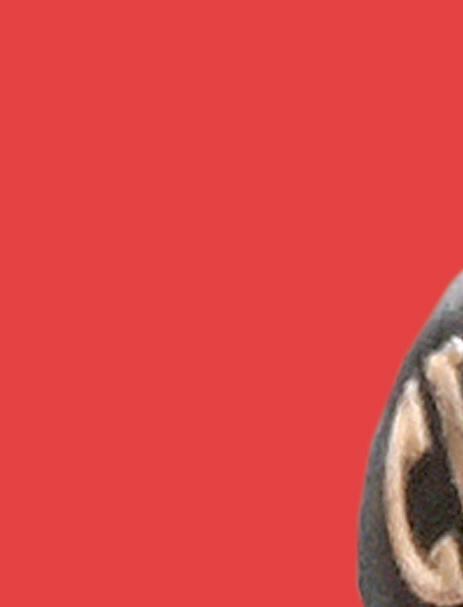
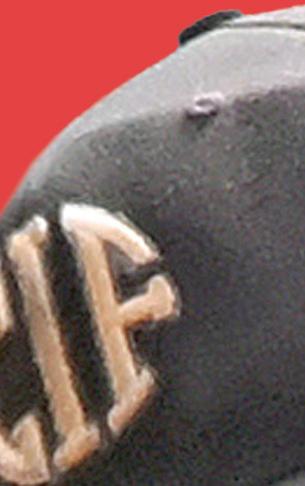


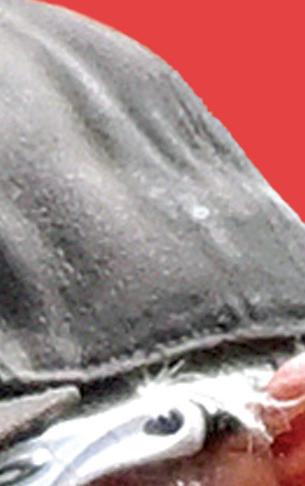
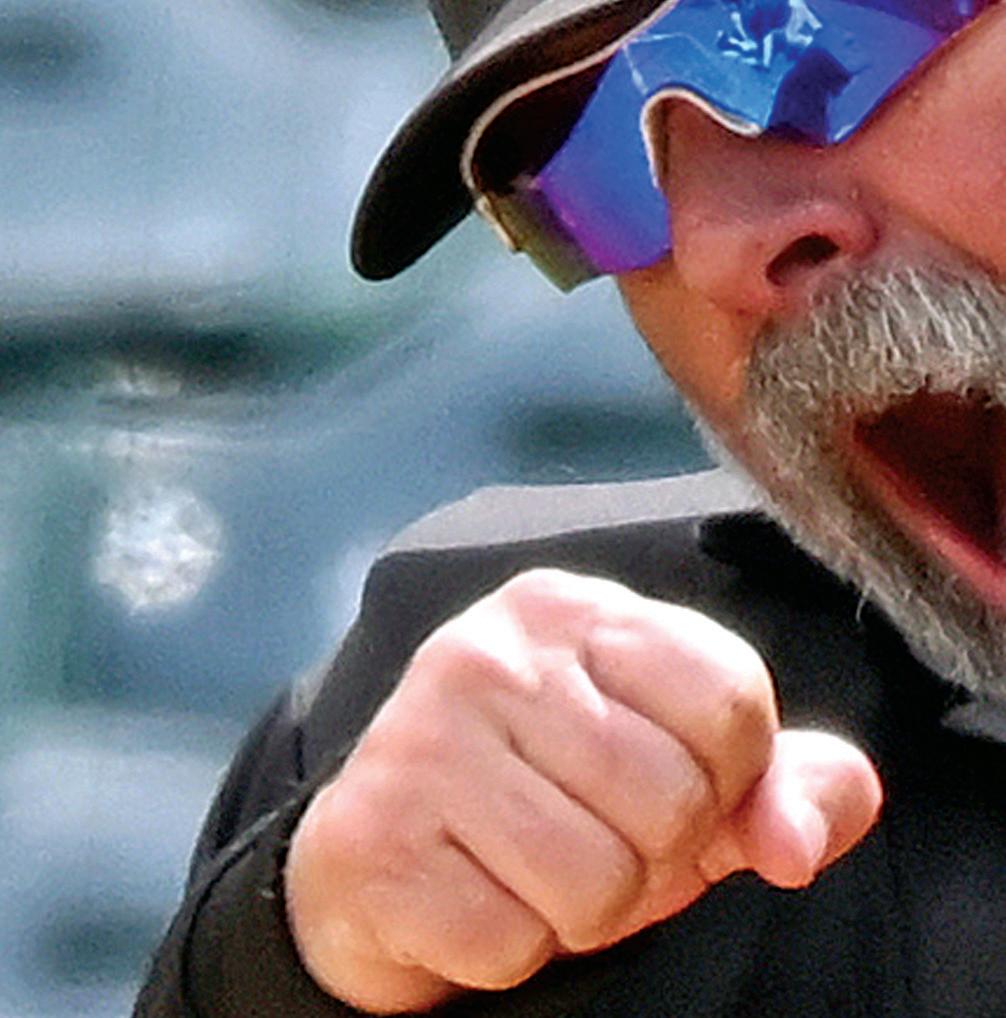
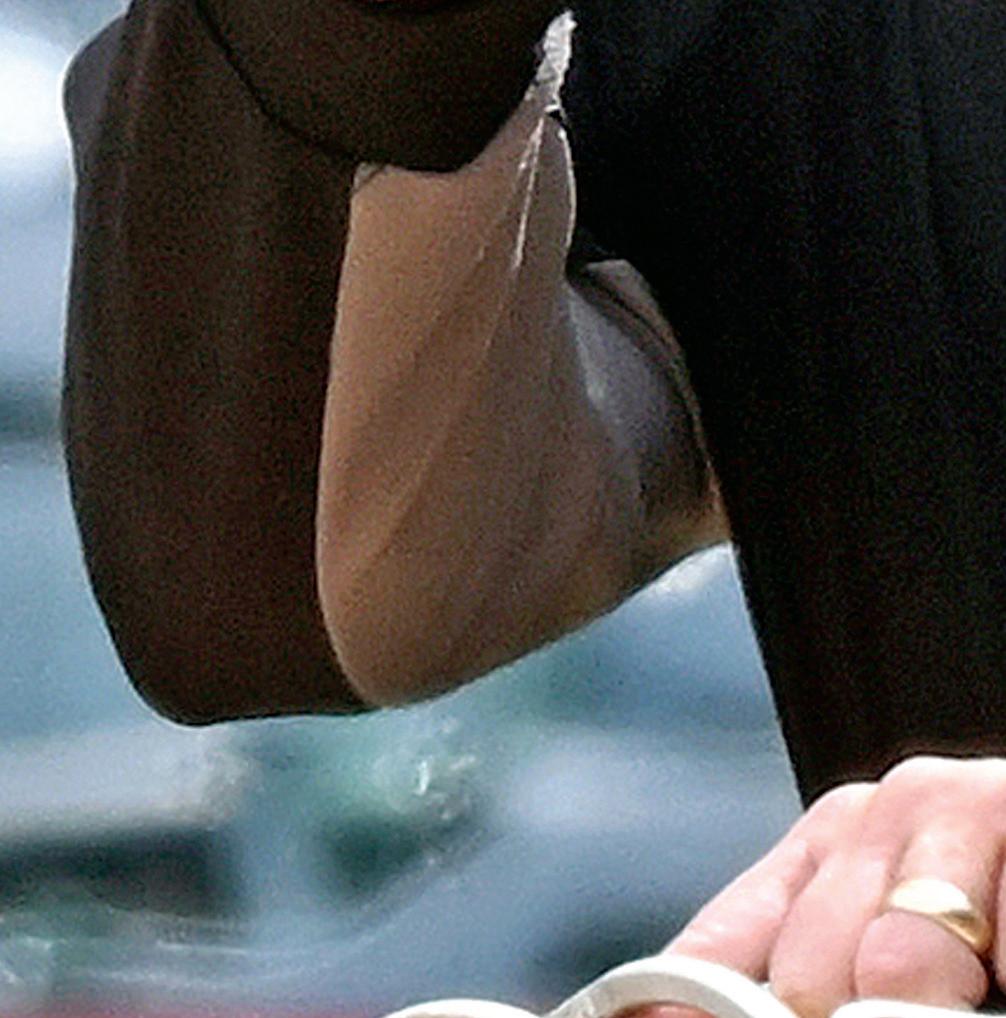



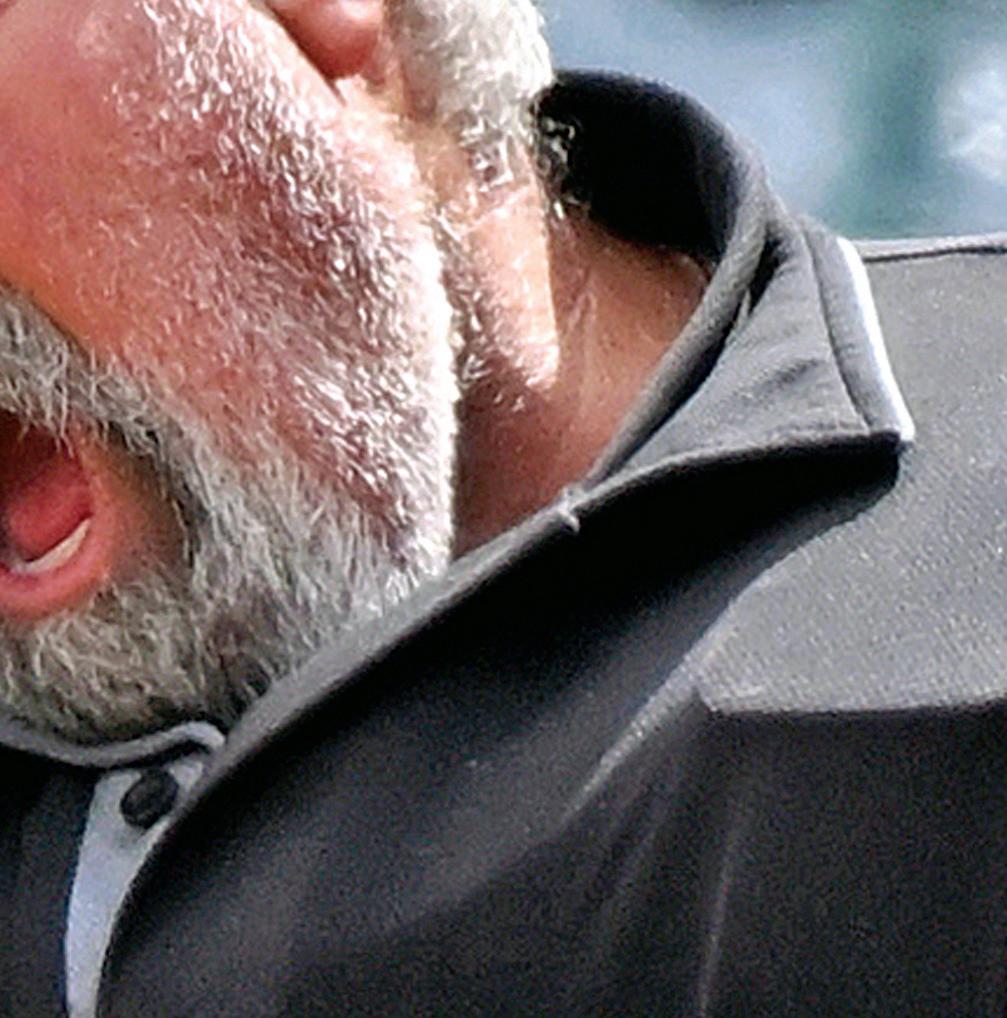



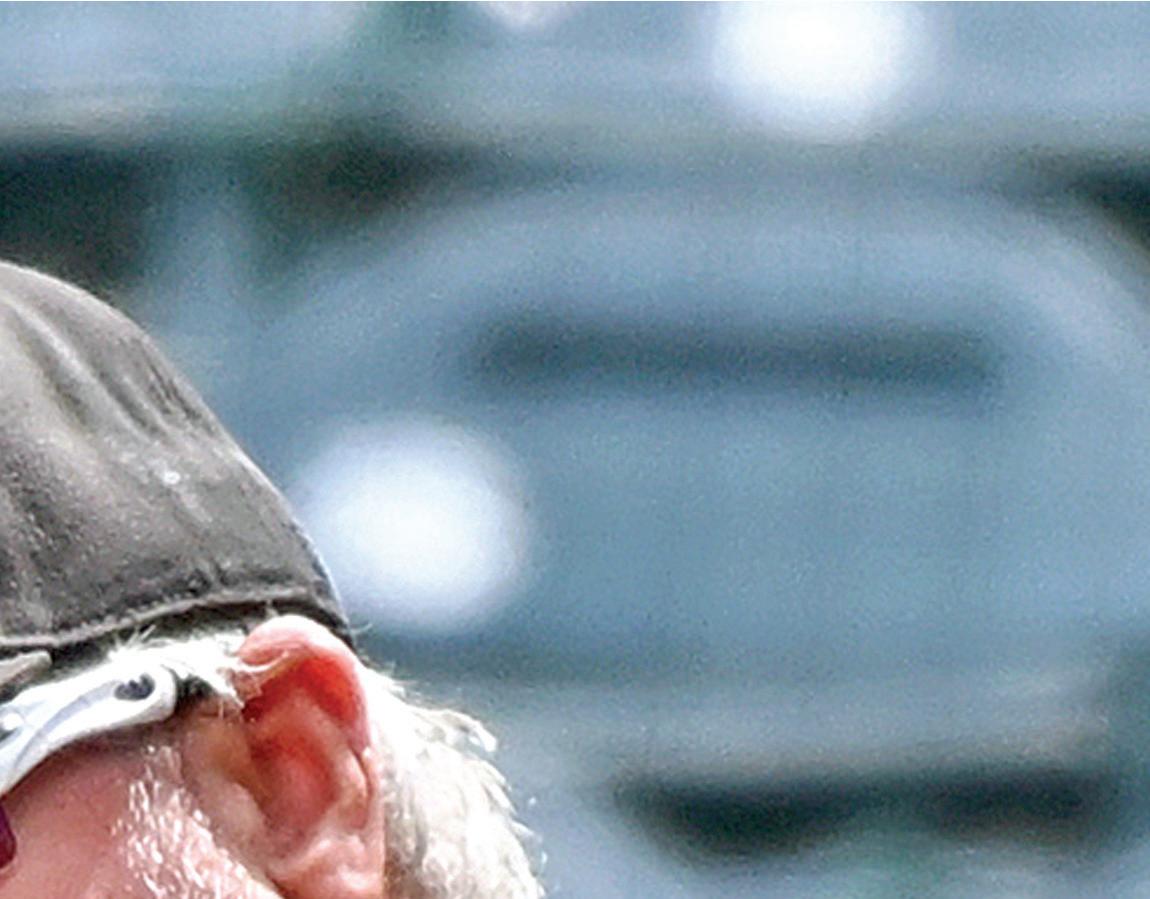


REEL THE VOLUME OFFICIATING TURNED UP your voice since 1976 $6.95 member edition TWO-SHOT BONUS BASKETBALL OFF ON THE RIGHT FOOT ALL SPORTS ROUGH PLAY SOCCER FLYING SOLO SOFTBALL NCAA RULE CHANGES FOOTBALL PREGAME RITUALS VOLLEYBALL WRIGLEY LIGHTS UP MILB-MLB-CWS ANGEL CAMPOS YER OUT! BASEBALL P.52 P.40 P.28 P.80 JULY 2024 // REFEREE.COM

28 ARC ANGEL
A full-time big league umpiring career was not to be. But a love of umpiring would keep Angel Campos on the field.
40 SOUND BITES
Social media hate isn’t what we signed up for.
52 REEL OFFICIATING
Our list of officiating documentaries that are worth your while.
80 YOU ARE THERE: LET THERE BE LIGHT
For years, all Chicago Cubs’ home games were played in daylight. That changed in 1988.
ON THE COVER
Paul Gilmore Huntington Beach, Calif.
Age: 59
Occupation: Retired after 30 years with the Orange County Sheriff’s Department.
Officiating experience: Baseball umpire for 24 years. Works high school, junior college and NCAA Division III.
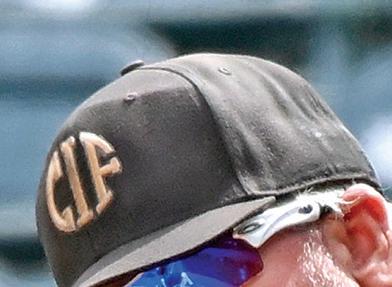

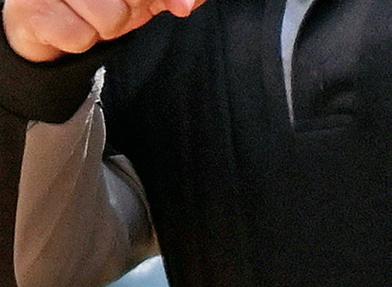


COLUMNS
20 FOOTBALL
If It Looks Like a Foul … Saving Flags for Actions That Deserve Them; Onside Kick Rules Review; NCAA Rule Changes; Eligibility Rule Difference
34 BASEBALL
Tag, You’re It: Understanding the Differences Between Tags and Forces; Stuck on the Struggle Bus?; Move to Improve on Double-Play Turn
46 VOLLEYBALL Courtside to Showtime: Rituals to Ready for Match; Beating Back Boorish Behavior; Surely You Joust
56 SOCCER
Storm Warning: 11 Tactics to Prepare for Violent Behavior; Do’s and Don’ts of Rule 5; You Can’t Relax at This SPA
66 SOFTBALL Flying Solo: Handling Tough Situations When Working Alone; Who’s Got First? And Third?
72 BASKETBALL
Bonus Benefits: How the New NFHS Rule Can Help Your Game; Following a T, Where Should We Be?; Too Little, Too Late
82 ALL SPORTS Tardy to the Party? Get Yourself to the Game on Time — Every Time; Confidence? Yes. Ego? No; When You’re the Stronger Official
14 THE GAG RULE Letters: Another Way of Officiating; Snap Shot: Watch Your Step!
16 THE NEWS Changes to NFL Officiating Staff; Ex-NBA Referee Wins Pension Lawsuit; KBO Fires Umpire After Missed Call
64 GETTING IT RIGHT Supporting Survivors Through Sports; Rooting for the Referees; Little League Legend 78 PROFILES
This Family Went to Court; Age Is Just a Number; Ice Climber
86 FOR THE RECORD NCAA D-I Basketball Tournament Officials; MiLB Umpire Roster
88 LAW
Eight to Replicate; Independent/Rec League Considerations; Roll of Role Models
89 CLASSIFIEDS Camps/Clinics/Schools; Equipment/Apparel; Leadership Resources; Training Resources
100 LAST CALL Light’s Out: “My calculation is I made it possible for over 27,000 student-athletes to play the beautiful game. I will always be proud of that.”
FOOTBALL HIGHLIGHT THIS
MONTH



CONTENTS Find Referee Magazine on Facebook and follow RefereeMag on X Volume 49, No. 7 Issue 573 JULY 2024
SPORTS
FEATURES
4 PUBLISHER’S MEMO The Twist of Fate
COURTESY OF ANGEL CAMPOS, HESTON QUAN (COVER & FOOTBALL)
20 The
playing the ball
a chance he’ll contact the receiver. Letting the action play out before throwing a flag is a learned skill for football officials.
defender isn’t
and there’s
FOR MORE, GO TO PAGE 20
PUBLISHER’S MEMO
The Twist of Fate

I recently read a book titled Fluke, authored by Brian Klaas. It offers perspectives on chance, chaos and why everything we do matters. I easily made connections between the life stories in the book and the “life stories” we experience in officiating. They are connected. A twist of fate, a fluke occurrence, and our officiating career or our life in general gets a boost or a boot. Officiating and life are connected. One story in particular hit me hard. It caused me to slow down and to reflect — maybe you also. What follows is a lengthy excerpt from Fluke. Let it speak to you.
In the autumn of 2001, Elaine Greenberg took a vacation to Tanglewood, Mass. While there, she spotted a necktie she knew her co-worker would love — featuring Monet’s Sunset at Lavacourt. Her colleague, Joe Lott, was known for wearing ties with paintings on them, and Greenberg knew impressionist paintings were his favorite. She bought the tie, figuring it would be a nice gesture for Lott, who was due to fly to New York City the following week for a work conference. Lott got on the plane, but with storms across the country that evening, the flight, which should have taken a few hours, took 14 instead. Lott arrived in Manhattan well past midnight, with the long journey leaving him looking a bit worse for wear. He had been due to have dinner with Greenberg so they could go over their presentation together before the conference, but was forced to reschedule. They agreed to have an early breakfast instead. Before Lott collapsed exhausted onto his hotel bed, he set out his clothes for the next day. As he did so, he realized his crisp white dress shirt that he had been planning to wear for the conference was crumpled and wrinkled.
The next morning, Lott woke up, took one look at his crumpled white shirt, and felt glad he had brought

a spare, a pastel-green one that would do the trick. At 7:20 a.m., he arrived at the hotel breakfast room, where Greenberg helped him go over the presentation. At the end of breakfast, around 8:15 a.m., she handed Lott her gift, the Monet tie, with the shimmering blues of the Seine set against a fiery red-orange sky at sunset. Lott was touched. He thanked her and, to show he meant it, said, “Elaine, I’m going to put this tie on and wear it today for good luck.” She shot back, “Not with that shirt, you’re not.” Lott laughed, but agreed. Even he knew the tie would clash horrendously with pastel green. He decided to return to his hotel room to swap shirts – even if it meant being a few minutes late. “See you shortly,” Lott said. Greenberg waved goodbye, then went up to the conference venue, on the 106th floor of Tower 1 of the World Trade Center. Lott returned to his hotel room and began to iron his wrinkled white shirt. It took him about fifteen minutes, long enough that he was still getting ready when the first plane hit the tower at 8:46 a.m. Lott survived. Greenberg did not. The immediate cause of Lott’s fortune and Greenberg’s misfortune might have been a rainstorm, a delayed flight, and a gift at the right moment.
After reading this heartbreaking piece, I closed the book, put it down on the side table and sat back in my easy chair. So many thoughts came into my mind … thoughts about the chance encounters, the twists of fate that have helped me, have hurt me, have defined the path so far traveled. Thank goodness officiating is normally not a matter of life and death. A story such as this one, though, can enable you to consider how chance has played a role in who you are and what you do as a sports official. The whole deal isn’t necessarily just up to you.



Chief Strategy Officer/Publisher
Barry Mano
Chief Operating Officer/Executive Editor
Bill Topp
Chief Marketing Officer
Jim Arehart
Chief Business Development Officer
Ken Koester
Editor
Brent Killackey
Assistant Managing Editor
Julie Sternberg
Senior Editor
Jeffrey Stern
Associate Editors
Joe Jarosz
Brad Tittrington
Scott Tittrington
Assistant Editor
Brad Star
Copy Editor
Jean Mano
Director of Design, Digital Media and Branding
Ross Bray
Publication Design Manager
Matt Bowen
Creative Designer
Dustin Brown
Creative Designer
Rob VanKammen
Video Coordinator
Mike Dougherty
Comptroller
Marylou Clayton
Data Analyst/Fulfillment Manager
Judy Ball
Director of Administration and Sales Support
Cory Ludwin
Office Administrator
Garrett Randall
Client Services Support Specialists
Lisa Burchell
Trina Cotton
Noelle Vaillancourt
Editorial Contributors
Jon Bible, Mark Bradley, George Demetriou, Alan Goldberger, Judson Howard, Peter Jackel, Dan Ronan, Tim Sloan, Steven L. Tietz, Rick Woelfel
These organizations offer ongoing assistance to Referee: Collegiate Commissioners Association, MLB, MLS, NBA, NCAA, NFHS, NISOA, NFL, NHL, Minor League Baseball Umpire Development and U.S. Soccer. Their input is appreciated.
Contributing Photographers
Ralph Echtinaw, Dale Garvey, Carin Goodall-Gosnell, Bill Greenblatt, Jann Hendry, Keith Johnston, Jack Kapenstein, Ken Kassens, Bob Messina, Bill Nichols, Ted Oppegard, Heston Quan, Dean Reid, VIP
Editorial Board
Mark Baltz, Jeff Cluff, Ben Glass, Mike Graf, Reggie Greenwood, John O’Neill, George Toliver, Ellen Townsend
Advertising 2017 Lathrop Ave., Racine, WI 53405 Phone: 262-632-8855 advertising@referee.com
REFEREE (ISSN 0733+1436) is published monthly, $49.95 per year in U.S., $84.95 in Canada, Mexico and foreign countries, by Referee Enterprises, Inc., 2017 Lathrop Ave., Racine, WI 53405. Periodical postage paid at Racine, WI and at additional mailing offices. Postmaster: Send address changes and undeliverables to REFEREE, PO Box 319 Congers, NY 10920. Direct subscription inquiries, other mail to REFEREE, PO Box 319
referee.com/pubmemo 4 | REFEREE July 2024
Watch the video at
Congers, NY 10920. 1-800-733-6100. © 2024 Referee Enterprises, Inc. All rights reserved. (USPS Publication #107790.) Subscribers: Send address changes to REFEREE, PO Box 319 Congers, NY 10920.








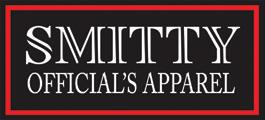






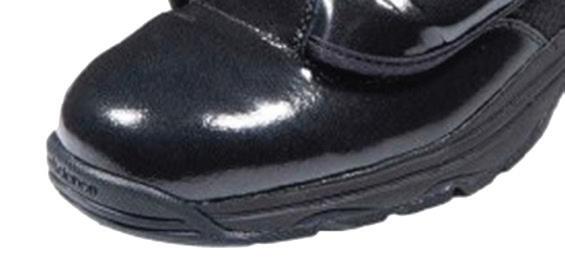




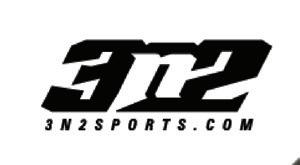

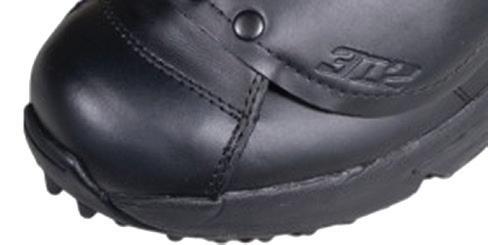




Now with 4 Brands in the Plate Shoe Lineup Find the Largest Selection, Sizes & Stock! Mizuno Pro Wave Mid-Cuts Smitty Mid-Cuts New Balance V3 Mid-Cuts (2 Color Options) 3n2 Reaction Pro Low-Cuts (3 Style Options) Find the Largest Selection, Sizes & Stock Here!

Retired Official Gives Alpena AD New Life with Donated Kidney
“Something I Had to Do”
By Geoff Kimmerly
Jon Studley woke up Feb. 20 with a lot of fond memories on his mind, which turned into a collection of 47 photos posted to Facebook showing how he’d lived a fuller life over the past year with Dan Godwin’s kidney helping power his body.
There was Studley at the beach, taking a sunset shot with wife Shannon and their 5-year-old daughter Maizy. In others Dad and daughter are at the ice rink, making breakfast and hitting pitches in the yard. Studley made it to Ford Field to cheer on the Lions, supported his
Alpena High athletes at MHSAA Finals and traveled to Orlando for a national athletic directors conference. Their faces are beaming, a far cry from much of 2021 and 2022 and the first few months of 2023 as the Studleys and Godwins built up to a weekend in Cleveland that recharged Jon’s body and at least extended his life, if not saved it altogether.
“People that saw me before transplant, they thought I was dying,” Studley recalled Feb. 21 as he and Godwin met to retell their story over a long lunch in Tawas. “That’s how bad I looked.
“(I’m) thankful that Dan was willing to do this. Because if he
didn’t, I don’t know what would’ve happened.”
By his own admission, Studley will never be able to thank Godwin enough for making all of this possible. But more on that later.
Studley and Godwin – a retired probation officer and high school sports official – hope their transplant journey together over the last 23 months inspires someone to consider becoming a donor as well.
For Studley, the motivation is obvious. Amid two years of nightly 10-hour dialysis cycles, and the final six months with his quality of life dipping significantly, Studley knew a kidney transplant would be the only
6 | REFEREE / MHSAA July 2024
Alpena athletic director Jon Studley, left, and retired MHSAA game official Dan Godwin take a photo together on the shore of Lake Huron one year after Godwin donated a kidney to Studley.
way he’d be able to reclaim an active lifestyle. And it’s worked, perhaps better than either he or Godwin imagined was possible.
For Godwin, the reasons are a little different – and admittedly a bit unanticipated. He’d known Studley mostly from refereeing basketball games where Studley had served as an athletic director. He’d always appreciated how Studley took care of him and his crew when they worked at his school. But while that was pretty much the extent of their previous relationship, some details of Studley’s story and similarities to his own really struck Godwin – and led him to make their lifelong connection.
“It’s been rewarding for me. I have told Jon, and I’ve said this to anyone who would listen, that I’m grateful and feel lucky that I’ve been part of this process,” Godwin said. “I don’t feel burdened. I don’t feel anything except a sense of appreciation to Jon that he took me on this journey. I didn’t expect that, but that’s how I feel.”
Making a Connection
As of March, there were 103,223 people nationwide on the national organ transplant waiting list, with 89,101 – or more than 86 percent –hoping for a kidney, according to data from the U.S. Department of Health and Human Services and the Organ Procurement and Transplantation Network (OPTN). More than 46,000 transplants were performed in 2023, including the sharing of more than 27,000 kidneys.
Godwin giving one to Studley was among them.
Studley, 43, has served in school athletics for most of the last two decades since graduating with his bachelor’s degree from Central Michigan University. After previously serving as an assistant at Mount Pleasant Sacred Heart, he became the school’s athletic director at 2009. He
moved to Caro in 2012, then to his alma mater Tawas in 2015 for a year before going to Ogemaw Heights. He then took over the Alpena athletic department at the start of the 2020-21 school year, during perhaps the most complicated time in Michigan school sports history as just months earlier the MHSAA was forced to cancel the 2020 spring season because of COVID-19.
He’s respected and appreciated both locally and statewide and was named his region’s Athletic Director of the Year for 2019-20 by the Michigan Interscholastic Athletic Administrators Association. Concurrently with serving at Sacred Heart and earning his master’s at CMU, Studley served as athletic director of Mid Michigan College as that school brought back athletics in 2010 for the first time in three decades. He also served four years on the Tawas City Council during his time at Tawas High and Ogemaw Heights.
Toward the end of his senior year of high school in 2001, Studley was diagnosed with Type 2 diabetes. For the next two decades, he managed his diabetes primarily with insulin and other medication. But during that first year at Alpena, his health began
to take a turn. Studley had been diagnosed with a heart condition – non-compaction cardiomyopathy – which led him to Cleveland Clinic for testing. A urine test in Cleveland indicated his kidneys might not be working like they should – which led to a trip to a specialist and eventually the diagnosis of kidney failure and the start of dialysis, with a kidney transplant inevitable.
Dialysis long has been a standard treatment for people with kidney issues. But it can take a toll. In Studley’s case, that meant being tired all the time – to the point of falling asleep at his desk or having to pull over while driving. He wasn’t receiving enough nutrients and was unable to lift things because of the port for the dialysis tube. Extra fluid building up that his body wouldn’t flush made him constantly uncomfortable.
The next step was transplant, and in July 2021 he was approved to receive a kidney.
The Studleys thought they had a prospect early on, as an aunt on Shannon’s side was a candidate for a paired match – her blood and tissue types weren’t a match for Studley, but matched another person on the waiting list whose donor would be a
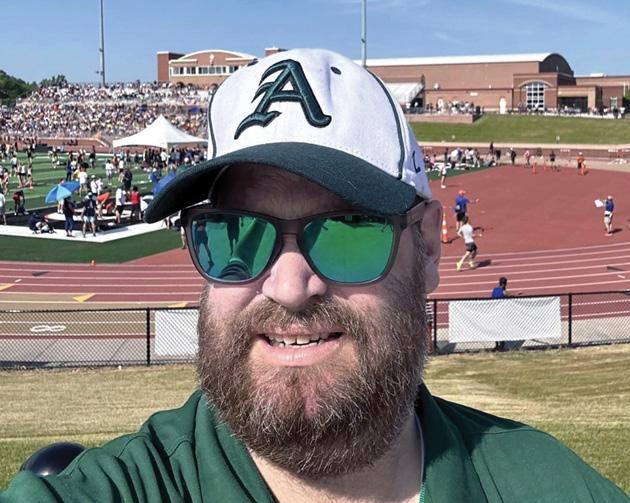
REFEREE / MHSAA July 2024 | 7
Studley cheers on Alpena athletes during last season’s MHSAA Track & Field Finals at Rockford High School.
candidate to give Studley a kidney. But that didn’t work out.
Others showed interest and asked about the process, especially after Studley’s 20-year class reunion in 2021, but nothing concrete came about. Amid the early disappointment, Studley took some time to consider his next move – and then put out a plea over Facebook that fall to his close to 1,000 connections hoping that someone, anyone, might consider.
“I took a week to really think about it – this is what I’m asking for someone to do. I had to get over it in my mind that it was OK to ask,” Studley said. “I’m going to ask someone to make a sacrifice for me, and that’s not me. I always want to help everybody else.”
Godwin is that way too. And immediately after reading Studley’s post, he knew he needed to consider making a call.
Strong Match
Godwin had moved to Tawas City from Midland in 2014, and after a few years off from officiating decided to get back on the court that following winter. He thinks he and Studley may have crossed paths at some point during Studley’s tenures at Sacred Heart and Caro, but it was at Tawas where they got to know each other. Although Studley stayed at Tawas just one school year, Godwin continued officiating for him at Ogemaw Heights – and in fact, Godwin’s final game in 2018 was there, during the District basketball tournament. That night, during the first quarter, Godwin tore the plantar fasciitis in his left foot. He didn’t know if he’d be able to finish the game – the officials from the first game that night stuck around to step in just in case – but thanks in part to Studley connecting Godwin with
the Alpena trainer during halftime, he was able to get through the final two quarters and finish his officiating career on his feet.
They’d become Facebook “friends” at some point, so Godwin had seen Studley’s posts over the years with Shannon and Maizy. And when he saw Studley ask for help, something hit him – “immediately.”
“I have a 5-year-old granddaughter, almost exactly the same age as Jon’s, and I’m the dad of one child, a daughter, so there were those connections,” Godwin said. “It almost didn’t feel like there was a choice. It felt like it was something I had to do.”
Godwin is 66 and always has been in good health. He’s also always been an organ donor on his driver’s license and given blood, things like that. But he had never considered sharing an organ as a living donor until reading Studley’s post.
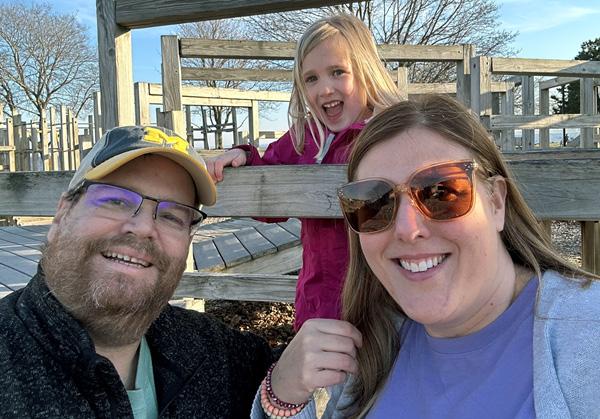
8 | REFEREE / MHSAA July 2024
He read it again to his wife Laurie. They talked it over. He explained why he felt strongly about donating, even to someone he didn’t know that well. After some expected initial fears, Laurie was in. Their daughter had the same fears – What about the slight chance something could go wrong? – but told Laurie she knew neither of them would be able to change her dad’s mind.
“It took me a while to get on board with it, even though I knew in the vast majority of cases somebody who donates an organ is going to be absolutely fine. It’s still major surgery,” Laurie said. “I guess he was just feeling so much like it was something he wanted to do, and he is a very healthy physically fit person. So I felt the odds were really good that he was going to be fine.
“And really, probably, the deciding factor was Maizy. We have a granddaughter the same age, so we were just thinking she needs a dad.”
After a few more days of contemplation, Dan called Cleveland Clinic to find out how to get started.
Then he texted Studley.
“I was nervous saying yes. At first, I didn’t know what to say – I just kept saying, ‘You don’t have to do this, but I appreciate it,’” Studley said. “I never want to have somebody do something for me unless (the situation is dire) … so I told him thank you and I appreciate it, and no pressure.”
Generally, Studley said, the donor and recipient don’t receive information on how the other person is progressing through the process. Godwin, however, kept Studley in the loop, which was a good thing. “But then you’re wondering if it’s going to happen,” Studley said, “if it’s truly a match.”
The initial blood test showed that Godwin wasn’t just a match, but a “strong” match, meaning they share a blood type – the rarest, in fact –and Godwin also didn’t have the worrisome antibodies that could’ve caused his kidney to refuse becoming part of Studley’s body.

That was amazing news. But just the start. “There was so much more we had to go through just to get to surgery day,” Studley said.
Long Road Ahead
Studley relates the transplant process to a job interview. After meeting with a potential boss, the candidate must wait for an answer –and it could come the next day, or the next week, or months later.
There were several more tests for both to take to make sure the transplant had not only a strong enough chance of being successful, but also wouldn’t be harmful for either of them.
“Right up until the time of the donation, (things) can happen. Like they did blood work on me the Friday before the kidney transplant on Monday, and if that had showed something they were going to send me home,” Godwin said. “So I just kept thinking, is this going to work? It seemed that there were more things that could go wrong than the possibility that it could go right. And that sets everybody up for disappointment – me, because I was invested in doing it, and of course Jon and his family because it was important to them.”
Godwin and Studley meet for the first time after the transplant, and again six months later.
Godwin made a trip to Cleveland Clinic in November – about three months before the surgery. It wasn’t a great visit. His electrocardiogram showed a concern, and a few suspicious skin lesions were an issue because donors must be cancer-free. Almost worse, he couldn’t get in for a follow-up appointment for six weeks.
The wait felt longer knowing not only that there was a possibility for disappointment for Studley, but also the potential something could be unwell with Godwin. But then came good news – at his followup, Godwin aced his stress test, alleviating any heart concerns, and the dermatologist said the lesions were basal cell carcinoma and not considered risky to the transplant.
Over the next three months, both Godwin and Studley continued to do whatever they could to keep the transplant on track. To avoid COVID, Godwin and his wife isolated as much as they could, and Studley began wearing a mask frequently at work. Godwin cut out alcohol and coffee and began walking regularly to keep in tip-top shape.
In January 2023, both got the final OK, and the surgery was scheduled for Feb. 20.
But that wasn’t the end of the anxiety.
Studley also had undergone a series of tests and doctor visits, and two days before the transplant he had to get a tooth removed to avoid a possible infection.
Then, on the way from Alpena to Cleveland, Studley’s vehicle hit a deer.
“How is this going to go now?” he recalled thinking. “This is how it started. What’s going to happen now?”
Both arrived in Cleveland safely, eventually. The families stayed apart all weekend, Studley and Godwin communicating briefly by text to check in. There were a few more stopand-go moments. Godwin’s Friday blood work showed something unfamiliar that ended up harmless. On the day of the surgery, Studley was wheeled to just outside the operating room – and then taken back to his hospital room for another 15
REFEREE / MHSAA July 2024 | 9
Studley, his wife Shannon and daughter Maizy enjoy a moment after Jon had returned to good health.
minutes of suspense. Once Studley made it into the operating room, his doctors had to pause during the surgery to tend to an emergency.
But finally, the transplant was complete. And seemingly meant to be. Godwin’s kidney was producing urine for Studley’s body before the surgeons had finished closing him up.
Back on His Feet
Studley said he knew he’d be fine once he could start walking the hallways at the hospital; he started doing so the next morning. Later that same day after transplant, on the way back from one of those walks, he saw Godwin for the first time since they’d both arrived in Cleveland. “It was absolutely emotional,” Godwin said.
Godwin went home four days after the surgery. Studley stayed the next month with appointments and labs twice a week. Shannon remained with him the first week, then friends Mike Baldwin and Josh Renkly and Studley’s father Larry took turns as roommates for a week apiece.
For the first three months, including his first two back in Alpena, Studley couldn’t go anywhere except for the trip to Cleveland every other week – which has now turned into every other month with virtual appointments the months in between. Total he missed about six months of work – and thanked especially assistant athletic director and hockey coach Ben Henry for shouldering the load in his absence.
Studley’s checkups are full of more good news. His body is showing no signs of rejecting the kidney. And as long as he keeps his diabetes under control, that shouldn’t affect his new organ either.
Shannon sees the difference while comparing a pair of family trips. The Studleys went to Disney World while Jon was on dialysis, and she said he made it through but got home just “depleted.” This past spring break, the family went to Gatlinburg, Tenn., and Jon had visibly more energy for hiking and other activities. The last six months of dialysis, Jon was sleeping a lot, but this spring he’s
helping coach Maizy’s T-ball team and overall is able to spend more quality time with her.
“Most of (Maizy’s) life she’s only known him as sick Dad,” said Shannon, a counselor at Alpena’s Thunder Bay Junior High. “He wasn’t able to do a lot of things with her, and I’ve seen a lot more of that, and I think she notices.”
Jon will be taking anti-rejection medicine and a steroid every 12 hours for the rest of his life, but that and some other little life adjustments are more than worth it. All anyone has to do is look at those 47 photos from the Facebook post to understand why.
Godwin said he feels better now than he did even before surgery. He does his checkups with Cleveland Clinic over the phone. He also said that if Studley had been found at some point late in the process to be unable to except the kidney, Godwin still would’ve given it to someone else on the waiting list. “I was so invested at that point,” Godwin remembered. “That kidney was going.”
The two families got together for a reunion in August in Tawas, where they had lunch and walked the pier and the Godwins met Maizy for the first time. She doesn’t really get what’s transpired, but definitely notices Dad doesn’t have a tube coming out of his body at night anymore.
And it’s clear the two men value the connection they’ve made through this unlikely set of circumstances.
“His attitude has been inspiring,” Godwin said. “Because you’ve been through the mill (and) I’ve never heard a negative thing, ‘poor me’ or anything. And I think maybe that’s what helps keep you going.”
“You talk to people who know Dan, and they said, ‘That’s Dan. That’s what Dan does,’” Studley said, speaking of Godwin’s gift and then addressing him directly. “The hardest part for me, the biggest struggle … is there’s no way I’m going to ever be able to thank you for this.
“It’s like the post I posted yesterday on Facebook. I posted pictures of everything I had done in the last year, and a lot of it was stuff that I hadn’t done in a long time. My way to thank Dan is just living my life
the best I can, enjoying my family. … For me, it’s changed my perspective.”
As lunch finished up, Godwin did have one ask in return – not for one of Studley’s organs, but to be part of a special moment that helped drive him to donate 12 months earlier.
“This isn’t the venue, but I’ve thought about this a lot. I’ve never asked for anything and I don’t want anything,” Godwin said, “but I would like to go to Maizy’s wedding.”
“Yeah, you … yes. Yes,” Studley replied. “You can go to anything you want to go to with my family.”
“I’d like to be there.”
“You will definitely be there.”
“I was at my daughter’s wedding,” Godwin said, noting again that connection between the men’s families, and the importance he felt in Studley being there for Maizy like he’d been there for his child.
“You say that, but there were times I didn’t know if I’d make it to Maizy’s wedding. I might not make it to see her graduate. So …” Studley trailed off, ready to take the next step in his life rejuvenated. Studley emphasized the continuing need for kidney donors and refers anyone interested in learning more to the National Kidney Registry.
quick tip
Avoid threatening coaches and players. Giving ultimatums in words or in actions will place officials in corners. Whenever you use, “One more word …” the coach or player has two choices: say something and show the team there is no fear or say nothing and continue to fume until the next situation reignites the flame. Neither is desirable. Even worse, an official who gives ultimatums without following up undermines his or her credibility.
10 | REFEREE / MHSAA July 2024
Great Officiating Seen ... and Heard
See the call. Make the call. That is officiating in a nutshell. But officials know there is a lot more to it than that. What if you are blocked by a player and do not see the play? What if you are trying to see it and you blink? What if you see the play but the horn is about to sound?
Listening. It is a big part of officiating in many ways. There are times when it is important to focus on the game or play, which calls for tuning out a raucous crowd or complaining coaches reaching for any call they can get. But it is also very important to pay attention to sounds and dialogue that can affect a game — sometimes when you least expect it. That can apply to officials whether working a subvarsity contest or the state tournament. Often the better officials are those who combine their rules knowledge, judgment and mechanics with their ability to filter the audible distortion of the game and listen.
It often seems that when an official is locked into a game, he or she not only is visualizing the game well but is dialed in to what needs to be heard.
A baseball plate umpire might not have seen the batter’s bat nick the catcher’s mitt while the batter hit a fly ball to right field, but there is a good chance the umpire heard it, which means that the catcher obstructed the batter. That is just one call in which an umpire must use more than what he or she sees to get a call right. The umpire can also read the reactions of both the batter and the catcher in getting that play correct.
A softball base umpire can rule a runner safe or out on a close play at first by listening for the snap of the ball into the glove and the thud of the batterrunner’s foot on the bag. If the snap beats the thud, the runner is out.
In basketball, be prepared to listen to the bench personnel. It is especially important in the closing seconds of a period, when timeout requests may be frequent and critically timed. Try to identify the head coach’s voice during the game so timeouts can be granted promptly at a key point. Anticipate the game situations when a timeout might be warranted.
Soccer referees should be wary of a player guilty of abusive or insulting language toward an opponent. When that happens, he or she should be sent off. The problem for the officials is a smart player will not commit abusive language or taunting within earshot of the referee — at least not loudly enough for the referee to hear. Some players will complain to you that abusive language was spoken. You should tell them if you hear something yourself, you will react to it. Let them know you will be listening. Listen as you officiate. Find out if you can hear those verbal taunts. Listen for the comments that lead up to the flashpoint and nip them in the bud. It may go without saying that the first requisite of effectively “disarming” a coach is to listen. Try to accomplish direct eye contact, erect posture and a slight lean toward the coach, with arms
at ease and no hand gestures. The face must also be bland and not contorted in a frown.
A football official may be the object of a coach complaining, “You know that punter took a dive! My man barely breathed on him. That’s not a foul.”
Or the basketball coach bellowing, “You know darned well their player knocked that ball out of bounds. What are you looking at? Besides, their number 23 is camped in the lane. Can’t you count to three seconds?”
Try to shuck those verbal slings and arrows by letting a person have a full say without flinching. Then start by acknowledging that a person may have a legitimate point of view (empathy), even if he or she does not have one. Use catchphrases such as, “I appreciate that. I see your point. You are entitled to that view. I hear ya. That may well be. I understand that.” If things are more heated, you may need to immediately take control of the conversation with a flag, a technical or whatever discipline the sport you are working provides.
Seeing the elements in front of you is one thing but adjusting to the key sounds of the game and listening for them will help you become a better official.
By working to maintain the proper position to observe the playing action and play at first base, Todd Willis, Grand Blanc, Mich., demonstrates characteristics great officials possess.
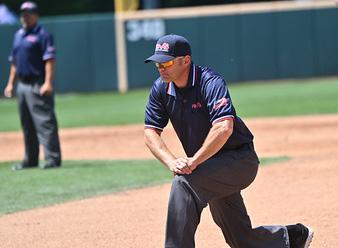
REFEREE / MHSAA July 2024 | 11
Balance Finder
Last night you officiated the worst game of your season. You were irritable on your drive back home and snapped at your spouse as you walked in the door. You then proceed directly to the computer where you begin to fill out online reports for the ejections and problems you encountered. After 40 minutes you emerge, grab a small bite to eat and get to bed. You could not sleep because it was all you were able to think about. You are exhausted as you head out the door to work and have another game that night.
You have done a poor job of separating your officiating from your personal life. When you find it creeping into your home life, work or friends, it is time to reassess and take charge. Keep it on the field or court. Frustration is inevitable in officiating. It could be with a partner, player or coach. But leaving that frustration behind you when you get back home will lead to a better home life. If you need to vent after a bad game, call an officiating buddy on your way home, but do not make your spouse or children pay for the abusive conduct you took from a coach all night. Learn to put it behind you. If you can do that, it will be much easier to have your family and friends share in your successes when those occur. Do not forgot for one second that your family and friends are sacrificing
as well when you are gone so many days and nights on the diamond, field or court.
Keep it in perspective. If you have one bad game, or a couple, it is not the end of the world. It just feels like it is. And only to you. Everyone makes mistakes or has bad games. If you never make mistakes or have bad games, you will never learn and become a better official. File away your bad calls even when the fans in the second row almost have you convinced you might do better from their vantage point.
Schedule time at home for activities. Let us be honest, if you have plans with your spouse and kids, it is impossible to take another game if your supervisor calls the day before, right? Family events or fun time can help those close to you cash in on some of that extra income you have been earning throughout the season.
Officiate in the present. The only thing you are in control of is the present. Right here. Right now. Not yesterday’s game or the call you made one hour ago. No one can go back and change the past. Dwelling on it keeps negative feelings alive and thinking too much about the future creates unnecessary anxiety. Conversely, do not take the stress from a hard day at work onto the field or court with you. Disconnect the wiring leading to those hot buttons.
Look to others that have found a balance. If you find others you officiate with have found a balance to their personal, professional and officiating lives, talk to those people. Find out what has worked for them and how you can apply it to your officiating. Pattern yourself after those that have found success, both on and off the court/field.
quick tip
Reading the rulebook without knowing the definitions is like starting to read a murder mystery from the middle. If you don’t know the suspects — or in the case of the rules, the definitions — the terms used in the rest of the rulebook aren’t going to make sense. When studying the rulebook, go to the definitions first. A thorough understanding of the definitions allows you to figure out who’s who and what’s what.
2024-25 Registration Now Open
The MHSAA is accepting registrations online or by mail for game officials for the 2024-25 school year.
The MHSAA registered approximately 8,700 officials for the 2023-24 school year, an increase of nearly five percent over 2022-23 as the ranks continue to build back toward pre-COVID totals.
All officials who register may sign up for up to two sports as part of their registration. Officials also will receive membership in the National Association
of Sports Officials (NASO), which comes with a variety of educational and training resources and the NASO’s Shield liability insurance that will provide $6 million in coverage for officials while they are working both MHSAA and nonMHSAA events. Coverage becomes binding and applicable as soon as your renewal is processed.
For new and returning officials, a $70 fee covers registration for up to two sports. Officials may register for additional sports at $16 per sport.
To avoid a $30 late fee, all fall sport registration applications must be received by Aug. 19, 2024. Winter sports registrations must be received by Nov. 18 to avoid the late fee, and spring sports registrations must be received by March 24, 2025.
Online registration can be accessed by clicking here. More information about officials registration may be obtained by contacting the MHSAA by phone at (517) 332-5046 or by e-mail at register@mhsaa.com.
12 | REFEREE / MHSAA July 2024
MEMBER BENEFITs & services
Any Game, Any Time, Anywhere — You Are Covered

$6 million General Liability Coverage
Excess coverage for claims for bodily injury, property damage and personal and advertising injury (defined as slander or libel) up to $6 million per occurrence general liability limit with a personal aggregate of $14 million.
Assault-Related $15,500 Coverage
Provides coverage for certain legal fees and medical expenses and game fee losses resulting from injuries suffered when an official is the victim of an assault and/or battery by a spectator, fan or participant while officiating.
$100,000 Game Call and Assigners’ Coverage
Up to $100,000 coverage for claims involving a challenged game call which resulted in a claimed financial loss or a suit against an assigner by a disgruntled official.

Referee Digital Magazine
Allows you access to a digital customized MHSAA-version Referee magazine to read wherever you’re on the go. MHSAA NASO members will receive exclusive MHSAA content through the digital magazine. Referee is the number one source of information for sports officials, written by officials. Each issue includes news columns and journalof-record reports and deep-coverage sport-specific sections complete with rule interpretations and caseplays.
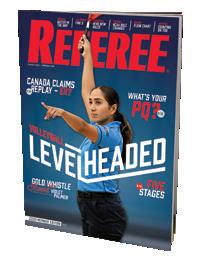
Referee Magazine (NASO Print Edition) MHSAA members have the option to upgrade to the print version of the magazine, delivered to your mailbox every month. 84 pages of in-depth feature stories as only Referee can report them.
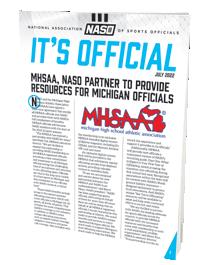
It’s Official Newsletter
Monthly 16-page newsletter providing association news, information, caseplays and educational product discounts.
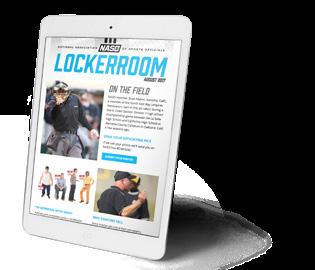
LockerRoom
Online newsletter includes latest news on NASO, officiating techniques and philosophy.
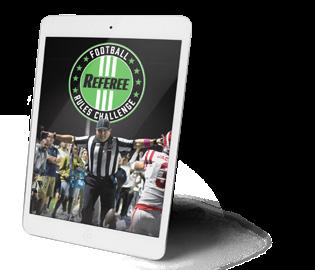
Interactive Sport Quizzes
Online access to sport quizzes that will help you improve your knowledge of the rules.
Officiating Resources
Special Members-only buying discounts on Referee and NASO publications. Savings up to 20%.
Marriott VIP Card
Provides discounted rates at Marriott & Starwoodbranded hotels within the US and Canada, subject to availability.
With the VIP card, NASO members may receive a room rate of up to 25 percent off the regular price at participating hotels where space is available. The Athletic VIP card must be shown at check-in.
Registration Discount to The Sports Officiating Summit Members only registration discounts.
Ump-Attire.com 10% discounts
Member Information & Consultation Program (MICP)
Provides help when you need to sort out an officiating related issue, includes both free information and free consultation with a knowledgeable person.
REFEREE / MHSAA June 2024 | 9
2017 Lathrop Ave Racine, WI 53405 262-632-5448
Address: Phone: Web: Email:
naso.org naso@naso.org
Insurance (Sports Officials Security Program) NASO covers common gaps in other officiating insurances, protecting you when other officiating coverages come up short. Publications Discounts & Savings Information Services Contact NASO
NATIONAL ASSOCIATION OF SPORTS OFFICIALS
THE GAG RULE
LETTERS
Another Way of Officiating
During the televised Rugby World Cup final four last fall, with two teams locked in a scrum of massive bodies, the referee peered into the pile and calmly said, “You’re pulling on his shirt. Please stop that.” The violator apparently complied as no further words were spoken, and the match went on. The referee’s microphone was always live and he used “Please” often.
Mark Stange Shoreview, Minn.
SNAP SHOT
WATCH YOUR STEP!
Multi-use playing surfaces can be frustrating for officials. Here, soccer official Keith Popejoy, Aliso Viejo, Calif., is dealing with a football hashmark that has become detached from the artificial turf surface.
SURVEY SAYS


“Can you imagine trying to work at your job and being berated? Unfortunately, there has been an ongoing belief that lambasting sports officials is acceptable because it’s part of the game.”
–Daily Hampshire Gazette guest columnist Dan Peters, a three-sport official and president of the Western Mass. Soccer Officials Association
“I told you. He went to the Walter Cronkite School of Journalism at Arizona State and I told you he was going to explain it perfectly.”
–Washington Wizards TV announcer Chris Miller after an official replay review announcement by NBA referee Billy Kennedy during an April game against the Los Angeles Lakers
at what level is sportsmanship the worst?
“There is significant global interest in betting on college sports. As long as that betting interest exists, the risks exist. Therefore, all NCAA stakeholders — officials, players, coaches, administrators and personnel — must remain vigilant and do all they can to protect the integrity of their sport.”
–Excerpt from the NCAA’s “SportRadar Referee Education Video” shared with all officials, conference coordinators and conference staff in all sports with an NCAA Central Hub
THEY SAID IT THEY GET IT THEY LIKE US
HESTON QUAN
POWERED BY NATIONAL OFFICIATING SOURCE: 35,813 INDIVIDUALS WHO RESPONDED TO THE NATIONAL OFFICIATING SURVEY POWERED BY REFEREE.COM EXPLORE RESULTS & DATA AT NASO.ORG/SURVEY
WHAT PEOPLE ARE SAYING 14 | REFEREE July 2024 Tell Us What You Think Send email to letters@referee.com Send letters to: Editor, Referee, 2017 Lathrop Ave. Racine, Wis. 53405 Opinions expressed in “The Gag Rule” are not necessarily those of Referee. Unless otherwise stated, letters sent to Referee are intended for publication and become the property of Referee College - 1.9% Professional - 2.4% Adult Recreational 13.9% High School 19.3% Youth Competitive 49.7% Youth Recreational 12.8%

THE NEWS
Multiple Changes to NFL Officiating Staff
NEW YORK — Change is coming to the NFL officiating department, including at the top. Two-time Super Bowl official Walt Anderson is transitioning into a new role with the league as a rules analyst and communications liaison. He leaves his post as senior vice president of officiating after nearly five years in the role.
In a statement from Anderson, he acknowledged his transition is largely due to making room for his son, Derek, on the NFL officiating staff. Derek is one of five new onfield officials hired for the 2024 season and the league has a longstanding antinepotism policy. “We are excited to see (Derek) have the opportunity to contribute as an official at the NFL level,” Anderson communicated in a written statement. “With Derek’s promotion, I expect to begin the process of transitioning to a new role as an NFL rules analyst & club communications liaison, where I will focus on communicating with the clubs during the week and with our broadcast partners on gamedays.”
Derek Anderson will join Jeff Hutcheon, Brian Perry, Robert Richeson and Karina Tovar as new onfield officials for the 2024 season. All five officials have spent time in the NFL’s Mackie Development Program. Derek Anderson was
THE WIRE
NHL’s First Director of Officials Dies
Wally Harris, 88, former NHL referee for 17 seasons and the league’s first director of officials, died April 18 in a Montreal-area hospital following a short illness. Harris officiated on-ice from 1966-83, working 953 regular-season games and 85 games in the Stanley Cup Playoffs. The Montreal native also officiated All-Star Games in 1975 and 1982. After leaving
most recently a referee in the Big 12 Conference and UFL, and will work on the line of scrimmage in the NFL next season. Hutcheon comes to the NFL from the Pac-12 Conference, where he worked as a head linejudge. Perry worked on the line of scrimmage in the ACC and UFL, and will do the same in the NFL. Richeson worked as an umpire in the Big 12 Conference and on the line of scrimmage in the UFL. He will work on the line of scrimmage in the NFL. Tovar formerly worked in the Pac-12 and was scheduled to work in the Big 12 this year prior to getting the call from the NFL. She most recently worked the field judge position in the UFL and will be the first female downfield official in the NFL.
Down judge Jim Mello, line judge Mark Perlman and field judge Tom Hill all retired from the NFL staff following the 2023 season. The three leave the field with a combined nearly 70 years NFL officiating experience. Line judge Maia Chaka is leaving the NFL officiating staff. She was the first black female official in an onfield position in the league’s history and spent three seasons with the NFL.
Several media outlets reported that Ramon George, an NFL umpire since 2016, would be named the new vice president of officiating. But as of press time, the NFL had not announced George’s promotion.
the ice, he was named the NHL’s director of officials. He retired from a supervisory role in 2002.
Former NFL
Official Quinby Dies
Bill Quinby, 92, former NFL official and officiating observer, died April 20 in hospice in Cedar Rapids, Iowa. Quinby was a side judge in the NFL from 197894.After coming off the field, Quinby spent five years scouting
Ex-NBA Referee Wins Pension Lawsuit
WHITE PLAINS, N.Y. — On April 22, the U.S. District Court for the Southern District of New York awarded former NBA referee Ken Mauer his pension of more than $2.9 million plus 8.5% interest after New York federal judge J.Paul Oetken’s ruled in
Mauer’s favor in March. Mauer, 69, who was fired from the league for refusing to receive the COVID-19 vaccine, filed the lawsuit June 13, 2023, against the NBA and the Pension Committee of the NBA Referees’ Pension Plan, claiming he was wrongfully denied his pension after his firing. The NBA Pension Committee argued that a different lawsuit Mauer filed in November 2022 conflicted with the pension request and could result in reinstatement, stating, “Mauer’s particular situation, the level of uncertainty about his potential return militated against immediately disbursing his benefit.” Mauer filed that other lawsuit along with former NBA referees Mark Ayotte and Jason Phillips, seeking back pay and compensatory damages — not reinstatement — after the league denied the referees religious See “Lawsuit” p.18
officials at college games and observing NFL crews.
NHL
Referee Returns After Collision
NHL referee Steve Kozari, who left the ice on a stretcher in April after colliding with Tampa Bay Lightning defenseman Haydn Fleury during a Pittsburgh Penguins win, returned later in the month to work his 137th career Stanley Cup playoff game, a matchup between the
Vancouver Canucks and Nashville Predators. The collision, after which Kozari was transported to a hospital for “precautionary reasons,” caused Kozari to miss the remainder of the regular season.
Fired MiLB Umpire Sues League
A fired minor league umpire sued MLB in April, claiming he was sexually harassed by a female umpire and discriminated against
16 | REFEREE July 2024









































































































SPEAKERS
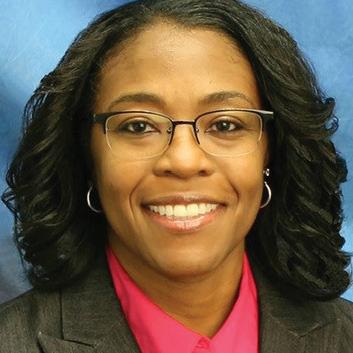

TOPICS
Lisa Jones
NCAAW Basketball Referee karissa niehoff
NFHS Executive
RETENTION: Demands being made on officials have never been greater. How do we meet the demands with meaningful support?
PROGRESSION: What are the significant needs of individuals at each stage of an officiating career? One size does not fit all. Adjust the approach. Craft the message. Position your officials to thrive at each stage of the officiating life cycle.





Recruiting new officials is one thing; keeping them is something else altogether. For anyone who cares about the future of sports officiating, this event is for you – a deep dive into the critical issues involved in retaining, developing and advancing sports officials everywhere.

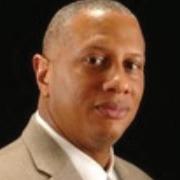
BRAD ALLEN
NFL Referee

adam james
Motivational speaker and national mental health wellbeing expert
marcus woods
College Football Referee
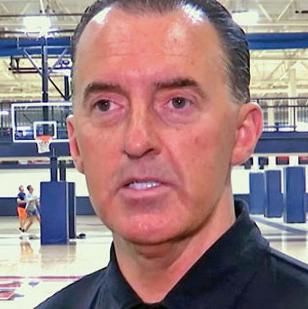
roger ayers
NCAAM Basketball Referee
FAST TRACKING: Officials are advancing faster than ever before. Some acceleration is out of necessity, some out of industry tech advancement. How do we prepare them for that roller coaster ride?
RESILIENCY: Sports officiating is not for everyone, but the pressure of the job can be trained. How do we foster mental toughness and perseverance in new officials?
WOMEN IN OFFICIATING: How are the needs of female officials different than their male counterparts? How do we best sustain this important and growing segment of the officiating industry?
WORKSHOPPING: Prepare to roll up your sleeves for group breakouts on new, mid-career & veteran/retiring officials, assigners, sportsmanship, compensation, mentoring, evaluation, outreach, and respect.
sports officiating summit .com
REGISTER TODAY! 07/28-07/30 2024 ATLANTA GEORGIA
Redding, Former Football Officiating Coordinator and Rules Editor, Dies
BIRMINGHAM, Ala. — Rogers
Redding, who served college football officiating as its national coordinator as well as the secretary-editor of the rules committee, died April 7.He was 81.

Redding was an onfield official for more than 30 years. He began his career in the late 1960s. He was a member of the Dallas chapter of the Texas Association of Sports Officials (TASO) before starting his collegiate career in the Lone Star Conference. He moved up to the now-defunct Southwest Conference from 198893, then worked as a referee in the Southeastern Conference (SEC). Redding officiated three national championship games — the 1991 Orange Bowl, 1993 Sugar Bowl and 1998 Rose Bowl.
Following his retirement from onfield officiating in 2004, he served as a technical advisor, instant replay official and SEC coordinator of officials. In 2008, Redding succeeded John Adams as rules editor, a position he held until 2017. From 2011-20, he was the second CFO national coordinator.
The National Football Foundation honored Redding with its Outstanding Football Official Award in 2010 and its Legacy Award in 2019.
Redding was the author and
because he is male and bisexual. Brandon Cooper, an umpire who worked in the Arizona Complex League (ACL) last year, claimed fellow umpire Gina Quartararo derided him with homophobic slurs upon learning he was bisexual. After Cooper reported her behavior, Quartararo claimed she was being victimized as the only female umpire in the ACL, and Cooper was skipped for the playoffs and subsequently fired, according to the lawsuit.
longtime editor of the Redding Study Guide to NCAA Football Rules . It was a go-to resource for officials needing clarification on the rules.
George Demetriou, who took up the role of editing the study guides, called Redding “A gentle soul you didn’t have to meet to like. He had a major impact on college football.”
According to a statement on the TASO website, “No matter how high he moved up the officiating ladder, or how far away his profession led him, Rogers always had time to help us all learn and understand the rules and to become better officials. Rogers often traveled back to Texas to teach at our clinics, present at our annual meeting or to meet with old friends. And if you ever had a rules question, he was as close as an email away.”
“Rogers had a significant impact on college football, particularly within the rules,” said Steve Shaw, who succeeded Redding in his coordinator and rules editor roles. “He was a great secretaryrules editor, and his Redding Study Guide helped many officials get more proficient with the rules. He was well liked by all officiating coordinators and was truly a good friend. He will be deeply missed.”
Redding is survived by his wife, Joan; two siblings; four children and 10 grandchildren.
NBA Assigns Woman Playoff Referee

Lawsuit
continued from p.16
exemptions for not receiving the vaccine and fired them as a result.
Oetken stated in a March 13 ruling Mauer had experienced a “termination of employment” that, according to the pension plan, entitles him to his pension.
“There is no question that Mauer has been completely separated from employment,” Oetken wrote in his opinion. “The only question is whether that separation is ‘permanent’ and ‘irrevocable.’”
According to the judge, that uncertainty shouldn’t prevent Mauer from receiving his pension. Additionally, Oetken wrote that accepting the NBA’s reason for withholding the pension “would discourage employees like Mauer from bringing claims for wrongful termination, as the commencement of such a lawsuit would entitle Defendants to withhold a plaintiff’s pension benefits until the resolution of that lawsuit, which could take years to run its course.”
Mauer joined the NBA as a referee in 1986 and was one of the NBA’s longest-tenured oncourt officials when he was suspended without pay or retirement benefits for the 2021-22 season and was terminated in September 2022.
As of press time, the lawsuit Mauer filed with Ayotte and Phillips is still in the court system.
Tennis Official Gets Lifetime Ban

The NBA announced its officiating roster for the playoffs in April, and for just the second time in NBA history, a woman’s name was on it. Ashley Moyer-Gleich worked the firstround matchup between the



Cleveland Cavaliers and Orlando Magic, becoming the first woman to officiate an NBA playoff game since Violet Palmer in 2012. Moyer-Gleich became the fourth female referee in NBA history when she entered the league in 2018. She has worked over 200 regularseason games in her six years in the NBA and was an alternate for the playoffs last year.






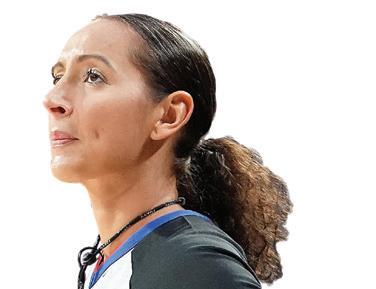




Bulgarian tennis official Pavel Atanasov has been banned from the sport for life due to multiple breaches of the Tennis AntiCorruption Programme (TACP), the International Tennis Integrity Agency (ITIA) announced in April. Atanasov’s offenses, which took place between 2019 and 2023, included manipulating scoring data for betting purposes, facilitating wagering, conspiring
THE NEWS
18 | REFEREE July 2024
THE WIRE
ALTER PHOTOS/SIPA USA/NEWSCOM
Shaw Retires, Setting Off Consortium Shuffle
The conference realignment shuffle has not been contained to college basketball programs finding themselves in new homes for the 2024-25 season.

Several changes are in the works regarding the men and women who will be assigning officials for those games, a chain reaction partly set in place by the retirement of Curtis Shaw, the longtime coordinator of men’s basketball officials for the Big 12 Conference, and also facilitated by the breakup of the Pac-12 Conference.
Shaw — whose officiating consortium also included Conference USA and the Missouri Valley, Ohio Valley and Southland conferences — announced in April his decision to step down after being unable to come to terms on an extension to continue to oversee the consortium, which he came off the floor to oversee in 2010. During his oncourt career Shaw advanced to the NCAA Tournament for 18 consecutive seasons, including six Final Fours and the 2009 national championship game.
In the wake of Shaw’s retirement, the Big 12 and Missouri Valley have agreed to join the Collegiate Officiating Consortium that is now headed by John Higgins, who came off the floor following the 2022-23 season to replace the retired Bobby Dibler. That consortium also now includes the Big Sky, Big West, Western Athletic (WAC) and West Coast (WCC) conferences.
The acquisition of the Big 12 in the
to commit corruption offenses, wagering on tennis matches and failure to report corrupt approaches.
Officials Speak Out Against Claims
of Bias
Members of a local officials association in Albany, N.Y., pushed back after their integrity was called into question by local community leaders. Albany Common Council President
Higgins consortium provides a landing spot for Power Five conference officials in the western half of the country after the dissolution of the Pac-12 that accelerates in 2024-25 with Oregon, UCLA, USC and Washington joining the Big Ten Conference; Arizona, Arizona State, Colorado and Utah joining the Big 12; and California and Stanford joining the Atlantic Coast Conference (ACC).
Conference USA, the Ohio Valley and Southland conferences will now transition into the consortium headed by Mike Eades, which includes the American Athletic, Atlantic Sun, Southeastern, Southern, Sun Belt and
Southwestern Athletic conferences.
Finally, the Mountain West Conference (MWC) — which had previously fallen under the Dibler/ Higgins umbrella — now shifts to the College Officiating Consortium headed by Terry Wymer, which also includes the Big Ten and MAC and the Horizon and Summit leagues.
There has also been a significant change on the women’s side of the game, with the MWC joining the VP12 women’s basketball officiating alliance headed by former NBA official Violet Palmer. The MWC joins the Big Sky, Big West, WAC and WCC under Palmer’s watch.
Korean League Fires Umpire
The Korean baseball league announced April 19 the firing of an umpire for a discussion related to an incorrect call.
The Korea Baseball Organization (KBO) released umpire Min-ho Lee after a game between the NC Dinos and Samsung Lions on April 14. Lee was the crew chief in that game when home plate umpire Seong-hoon Moon missed a “strike” call from the automated ball-strike system (ABS).
Dinos manager In-kwon Kang argued after the strike call popped up on the team’s league-issued tablet. Lee gathered Moon and third-base umpire Pyung-ho Chu to discuss the call, but as several other pitches had been thrown, the call stood.
Part of their conference was caught
Corey Ellis said during an April 4 meeting that referees were unfairly biased against the Green Tech boys’ basketball team, which won the state championship in March. Ellis said something needed to be done because parents and families were upset. Members of IAABO Board 36 called Ellis’ claims unprofessional and inappropriate. “Making those accusations without any form of
on the game’s broadcast and Lee was heard telling his crew, “We should tell people you heard the ‘ball’ call. Understand? That’s the only way we can get out of this.”
The KBO removed all three umpires from assignments April 15.The league then fired Lee and suspended Moon and Chu for three months without pay. Lee’s firing is the most severe punishment for a KBO umpire since the league’s inception in 1982.
The KBO introduced ABS for the first time this season. Following this incident, the league said it will add a dedicated ABS official to each game to prevent future incidents.
SOURCE: THE KOREA TIMES
proof or data to support them is both irresponsible and reckless,” IAABO Board 36 president Jeff Dollar said.
Fan Convicted After Abusing Official
A 22-year-old man has been convicted after abusing a match official during the 2023 Rugby World Cup. Aaron Isaia pleaded guilty to one count of using an online communication platform
to menace or harass. The rugby fan from Australia abused Television Match Official Brian MacNeice and his family during England’s victory over Samoa. Isaia was given a 12-month good-behavior bond of $1,000. Despite Isaia avoiding prison, the case is considered a “landmark outcome” by World Rugby, the sport’s governing body.
SOUCRES: DAILY MAIL, ESPN, THE WASHINGTON POST, WNYT.COM
REFEREE July 2024 | 19
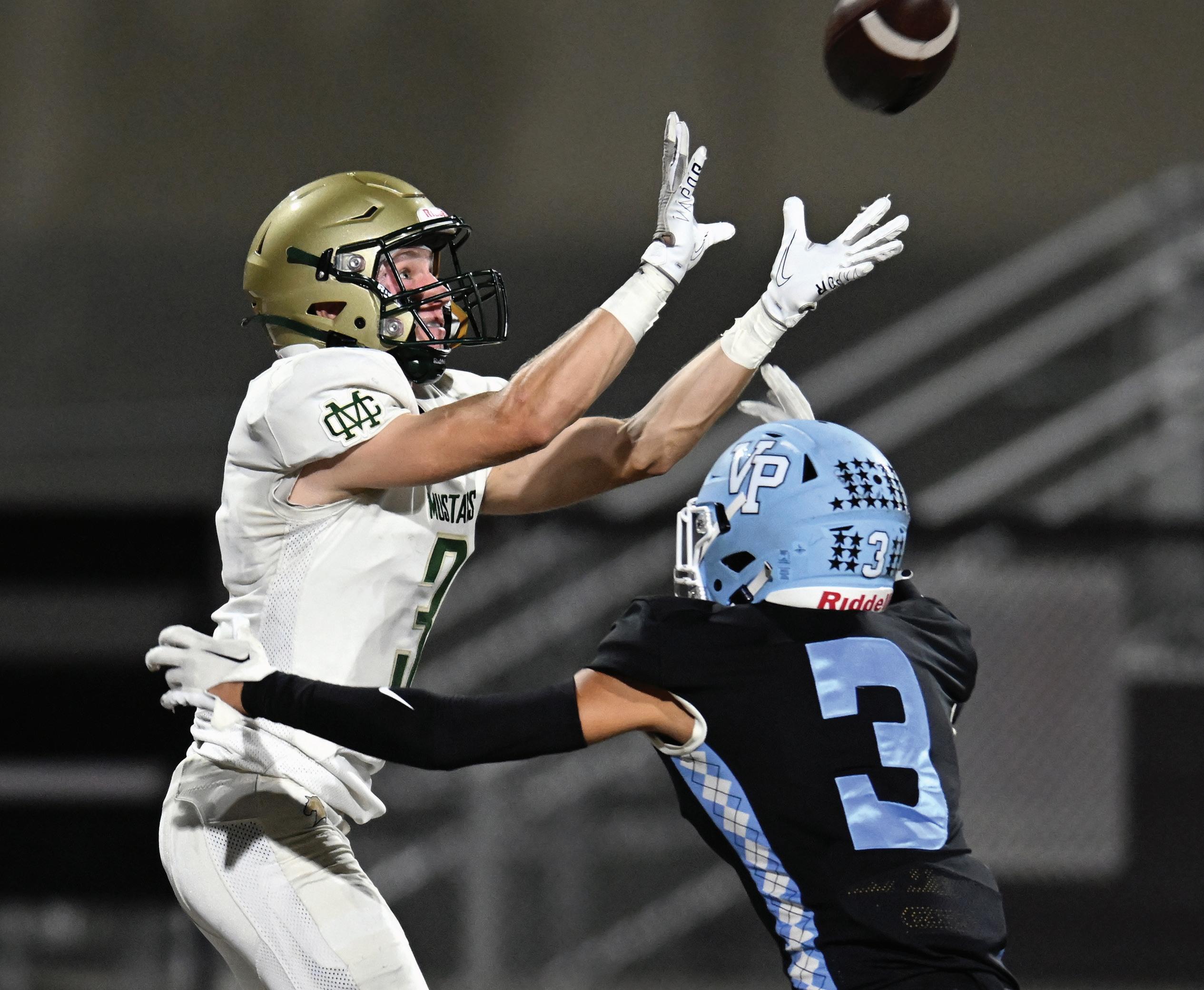
IF IT LOOKS LIKE A FOUL …
Saving Flags for Actions That Deserve Them
By Jon Bible
I ’ve been involved in evaluating and training college officials for several years. One thing we spend a lot of time on is carefully evaluating potentially foul-worthy action to see if it put a team at enough of a disadvantage to warrant a flag. If
officials at this level still fail to do this sometimes, and they do, it’s a sure bet they do at the sub-college level.
In my experience, newer officials are especially guilty of this, and one can’t really blame them. If their experience is like mine was when I started out — and I’ve been
to enough association meetings to believe things haven’t changed much, if at all — they learn what the rules say, but not always how they should be applied; that wisdom comes later (maybe), after a lot of snaps and working with experienced officials. If they exist, evaluation systems often stress
FOOTBALL RULES, MECHANICS, PHILOSOPHY EDITOR:
STERN jstern@referee.com 20 | REFEREE July 2024
JEFFREY
The defender isn’t playing the ball and there’s a chance he’ll contact the receiver. Would contact automatically be a foul? How much contact would put the receiver at a disadvantage? Letting the action play out before throwing a flag is a learned skill for football officials.
HESTON QUAN
technical rule applications, so we end up with a lot of Rulebook Charlies. In my local chapter, the joke was we could tell what rule had been stressed in the new-officials training session, because so many violations of it would be called in sub-varsity games that week, you’d think Flag Day had been declared.
In the NFL and in college, the focus is on advantage-disadvantage. Myriad infractions occur in a game; the ones deemed foul-worthy are those that put a team at an unfair disadvantage. The evaluation process has three steps: (1) Did the action we saw potentially violate a rule? (2) If so, did it, in fact, violate a rule? (3) If so, did it put the other team at enough of a disadvantage to warrant a flag? We should pull our marker only if we answer yes in all three instances. I think we should follow this process at every level from the NFL to Pop Warner. Take offensive holding. We’ve all heard the saying we could call it on every play. An exaggeration, yes, but there’s truth to it. What we ought to call is action that materially restricts the defender, placing him at an unfair disadvantage. The modifier is important. Restriction is not enough; it needs to be material , or significant. Say a defensive end is trying to close in on the quarterback and he beats the tackle, who sticks his arm out and grabs the defender. It’s easy to process this as a foul without assessing how, if at all, this affected the defender. Did he lose his footing, even a half-step, or did he blow right through the grab as if it hadn’t happened? If it’s the latter and we take our time and process everything, not just the fact the defender was grabbed, we’ll keep our flag in our pocket.
Side note: The closer to the point of attack grabs like this occur, the less it takes for it to be foul-worthy. It’s one thing for a defender to lose a half-step when he’s 10 yards from the quarterback and another thing when he’s within reaching distance. What if the defender lost a half-step but immediately made the tackle? It’s hard to say the grab materially affected him, so no flag.
What if he lost a half-step but by this time the quarterback had rolled out to the other side and vacated the area? Again, no unfair disadvantage. The key is to take enough time to go through step three of the analytical process instead of stopping after step two.
Moving to the scrimmage line, team A can’t have more than four players in the backfield. Occasionally there will be receivers on one side and the question is whether their alignment is such that one is technically a fifth back. Or, maybe it’s whether the slot receiver is enough on the line to say the wideout “covers him” so he’s ineligible to go downfield on a pass that crosses the neutral zone. If there’s an obvious violation, call it; we’ll get all kinds of flak if we don’t. But if it’s tight, we can likely conclude the defense wasn’t fooled so the alignment isn’t foulworthy. Then it’s best to let it go and tell the head coach there’s a problem that needs to be addressed.
Same with a tackle who consistently creeps back so he ends up being off the line. If it’s blatant, call it, because he has a blocking advantage; if not, warn him and the coach he needs to get up. When we call technical infractions that have no bearing on anything, we unnecessarily intrude ourselves into the game and can make it a farce. Watch TV games and you’ll see crews are criticized more often for calling ticky-tack fouls than for keeping their flags in their pocket.
Downfield, I’ll cite two examples. First, take a defender who puts an arm around a receiver’s waist before the ball arrives. It’s easy to conclude that arm equals foul, but what if this doesn’t affect the receiver’s ability to make the catch and, instead, the defender reaches around the receiver and bats the pass down? Tossing a flag penalizes the defense when the action didn’t materially affect the receiver; in fact, the defender made a good play. Different story if the defender spins the receiver around before the ball arrives. That’s material effect.
DID YOU KNOW?
Three-official crews (referee, umpire and linesman) worked NFL games in the early days of the league. The field judge was added in 1929. In 1947, crews were expanded to five with the advent of the back judge. It wasn’t until 1965, when the line judge was added, that crews of six were used. The current crew of seven became the standard in 1978 when the position of side judge




THEY SAID IT
“Working a Super Bowl with my brother was the height of my officiating career. It was really something special, and we’re grateful to the NFL for the opportunity. I know it was special for my dad to see two of his sons work the biggest game at the highest level.”
NFL

–NFL umpire



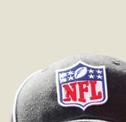










Carl Paganelli, referring to Super Bowl XLI, which he worked with his brother, back judge Perry. It was the first time brothers worked a Super Bowl.




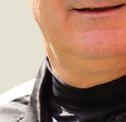




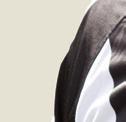



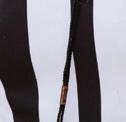

SURVEY SAYS …
According to the 2023 National Officiating Survey powered by Referee.com, football officials overwhelmingly believe the biggest sportsmanship issues are taking place at the competitive youth level, with 50.40% of respondents indicating that level of play. High school football is next on the list at 18.81%, followed by adult recreational (13.89%), youth recreational (12.53%), professional (2.42%) and college (1.96%).
REFEREE July 2024 | 21
NATIONAL OFFICIATING –
TEST YOURSELF
In each of the following you are given a situation and at least two possible answers. You are to decide which answer or answers are correct for NFHS and NCAA rules, which might vary. Note: In kicking situations, K is the kicking team, R the receiving team. Solutions: p. 81.
1. Team K is in scrimmage-kick formation. Slowly and without simulating action at the snap, punter K1 moves forward to receive a handto-hand snap. B2 enters the neutral zone and contacts guard A3.
a. The only foul is false start on team K.
b. The only foul is illegal shift on team K.
c. The only foul is encroachment/ offside on team R.
d. Both teams have fouled; the penalties cancel.
2. Fourth and nine from team R’s 27 yardline. K1’s field-goal attempt is blocked behind the line. The ball is untouched beyond the line and rolls out of bounds at team R’s 15 yardline.
a. It will be team R’s ball at its own 27 yardline.
b. It will be team R’s ball at its own 20 yardline.
c. It will be team R’s ball at its own 15 yardline.
3. Fourth and 10 from team K’s 20 yardline. Team K has 10 players in the game with only six players, including five numbered 50-79, on the line of scrimmage. R1 catches K2’s punt at the 50 yardline and advances to team R’s 40 yardline.
a. No problem.
b. Illegal formation. If team R accepts the penalty, it is enforced from the end of R1’s run.
c. Illegal formation. If team R accepts the penalty, it is enforced from the 50 yardline.
d. Illegal formation. If team R accepts the penalty, it is enforced from the previous spot.
4. As A1 is calling signals, B2 makes sounds simulating the cadence. The ball is snapped a split-second after B2 begins yelling.
a. No foul unless a team A player reacts.
b. Unsportsmanlike foul on B2.
c. B2 is charged with a foul for delay.
d. B2 is charged with a foul for disconcerting.
Suppose a receiver on a long pass route beats the defender, who quits looking for the ball and starts to get into the receiver’s body as he tries to catch up with him. It’s easy to say this is a foul, when the question should be whether there was contact (faceguarding isn’t a foul) and, if so, whether it materially affected the receiver’s ability to try to make a two-handed catch. If the answer is no, no flag. Different story, again, if the defender truly gets into the receiver’s body, thus materially
Onside Kick Rules Review
By AJ Haduch
Onside
kicks are one of the toughest plays to officiate, partly because we rarely have opportunities to experience the play. It isn’t often we see nearly all 22 players in a 10-15 yard span of the field. Given the condensed nature of the play, angles can close quickly and we rarely have time to adjust our distance to improve our vantage point.
Some of the most significant officiating errors come as a result of ball watching. With rules regarding formations, offside/encroachment, blocking and eligibility to touch and recover the kick, there is plenty for the crew to watch.
Before the Kick
A key to starting any play is making sure each team has 11 players on the field. The back judge and line judge count team K and the referee, umpire and linesman count team R (NFHS), or the umpire, center judge and deep three count team K and the referee and line of scrimmage officials count team R (NCAA). For both codes, at least four team K players must be on each side of the kicker at the time the ball is kicked (NFHS 6-14; NCAA 6-1-2c-3). The referee is best suited to make that determination.
restricting his ability to get to the ball. What this boils down to is in close cases, err on the side of not throwing. Look for a distinct disadvantage. The exception involves safety fouls — roughing the passer, late hit, etc. — when it’s the other way around: Err on the side of calling it.
Jon Bible is a replay official in the Southeastern Conference. A resident of Austin, Texas, he formerly officiated collegiate and pro football.
Only one team K player may be more than five yards behind the restraining line and that individual must be the one to execute the kick (NFHS 6-1-3b; NCAA 6-1-2b).
A player satisfies this rule when no foot is on or beyond the line five yards behind K’s free-kick line (NFHS) or when one foot is on or beyond the line five yards behind the restraining line (NCAA). Violation of this rule results in a dead-ball free-kick infraction (NFHS) or live-ball illegal formation foul (NCAA).
During the Kick
The respective free-kick lines are the chief responsibility of the back judge and line judge (NFHS) or the back judge and umpire (NCAA). After the ball is ready for play and until the moment the ball is kicked, no team K player other than the kicker or holder may be beyond the free-kick line (NFHS 6-1-3a; NCAA 6-1-2c-1).
Be alert for a kick driven into the ground, a strategy often employed by kickers to cause the ball to move erratically. In NFHS only, a pop-up kick, defined as the kicker driving the ball immediately into the ground so that the ball strikes the ground once and goes into the air in the
22 | REFEREE July 2024
FOOTBALL
1.KICK HITS GROUND BEYOND R’S FREE-KICK LINE
2.K RECOVERS
manner of a ball kicked directly off the tee, is a dead-ball foul (2-24-10).
Once the ball has been kicked, attention of many crew members can turn toward the “mesh point” when contact between opponents is imminent — usually five to 10 yards from the spot of the kick. The location and nature of those blocks is critical.
No member of team K shall block an opponent until the legal kick has traveled 10 yards. Blocks below the waist are illegal.
If team K touches the ball before it travels 10 yards or is touched by a team R player, it has committed first (NFHS) or illegal (NCAA) touching. In that case, team R may elect to take the ball at the spot of the touching or may put the ball in play as determined by the action that follows the touching.
Officials, especially those located at team R’s restraining line, should be alert to signal the game clock to start when legal touching occurs. If the ball
is recovered cleanly by a grounded player, the clock shall not start.
After the Kick
Once the ball is dead, you have to piece together what occurred. The play often requires post-play discussion. Things to consider: Did the clock start and stop properly if needed? Is the dead-ball spot accurate? Which team has possession of the ball at the conclusion of the play and was the possession legal? Did any illegal kicking techniques, blocking, touching or batting occur? What are possible enforcement spots or decisions by the offended teams if illegal actions occurred during the down?
Because of the myriad possibilities on such a rare play, periodic review of the rules and mechanics will help you officiate onside kicks correctly.
AJ Haduch, Ypsilanti, Mich., is a line of scrimmage official in the Mid-American Conference.

PRESS
Team K has successfully executed an onside kick because the ball has both touched the ground and gone beyond the plane of team R’s free-kick line (the order doesn’t matter). In NCAA, the ball would only need to break the plane of and remain beyond team R’s restraining line in order for team K to recover.
BOX
NCAA Changes Include New Timeout
By George Demetriou
The addition of a timeout at the two-minute mark of each half highlighted changes approved by the NCAA Football Rules Committee at its March meeting in Indianapolis. The Playing Rules Oversight Panel, charged with evaluating how rule changes affect player safety, financial impact or image of the game, approved the changes in April.
The material has been reviewed by Steve Shaw, NCAA secretary-rules editor. The changes are presented in perceived order of importance. For official rule language and interpretations, always consult NCAA publications.
Two-Minute Timeout (3-3-5)
When the game clock is running and the ball is not live, the clock will be stopped with exactly two minutes remaining in the second and fourth quarters for a timeout. If the ball is live when the game clock reaches two minutes in the second and fourth quarters, play will continue, and the clock will be stopped when the ball is subsequently declared dead for a twominute timeout.
All in-game timing rule changes become effective following the two-minute timeout, including first downs, runs, fumbles and backward passes out of bounds, the option to start the clock on the snap per 3-43b, replay clock adjustment and all 10-second runoff situations.
The game clock starts on the snap and the play clock is set at 25 seconds even if there is a defensive injury or a defensive helmet off.
HorseCollar Tackle (9-1-15)
Horse collar tackles that occur within the tackle box are now illegal and will be penalized as a 15-yard personal foul.
Coach-to-PlayerCommunication (1-4-11b Exc.)
Coach-to-player communication through the helmet will be allowed for the Football Bowl Subdivision only based on the following guidelines:
•Only one player per team may be on the field at a time with radio receiving capability and the player must be identified by an unbranded green dot on the back midline of the helmet.

•Coach-to-player communications will be cut off when the play clock reaches 15 seconds or at the snap, whichever comes first, and will remain off throughout the down. When the play clock is reset to 25 or 40 seconds, the communications will be turned back on.
•If the game officials detect more than one green dot helmet on the field, the result is a live-ball foul for an equipment violation. That carries a five-yard penalty. The penalty initiates a conference review.
Tablets (1-4-11a Exc. 3)
Standard tablets for in-game video only will be allowed for all subdivisions and are subject to the following guidelines:
•Tablets shall be restricted to “in-game video” (current game) and may not include analytics, data or data-access capability or any other communications access. No other video is allowed (e.g., scouting video, practice video, etc.).
•Tablets may be used in the coach’s box, sideline and locker room and may not be interconnected to other devices to project larger/ additional images.
•Video may include a coach’s sideline, a coach’s end zone and a program feed per play from the current game only and may also display “game circumstances” including down/distance/time/ quarter/play number/score.
•A team may have up to 18 standard tablets active, and all team personnel may view the tablets.
If any team personnel engage an official with a tablet to show or review video, an automatic unsportsmanlike conduct foul will result.
Smart Watches (1-4-11i).
Institutional ball personnel are prohibited from wearing smart watches or any communications technology while on the opponent’s sideline.
FOOTBALL 24 | REFEREE July 2024
























The best-selling penalty manual is fully updated for 2024 with all the new NFHS rule changes. Explore multiple play scenarios with a direct visual representation with Referee’s exclusive MechaniGrams® and flow charts. Handy penalty summary and signal chart also included.
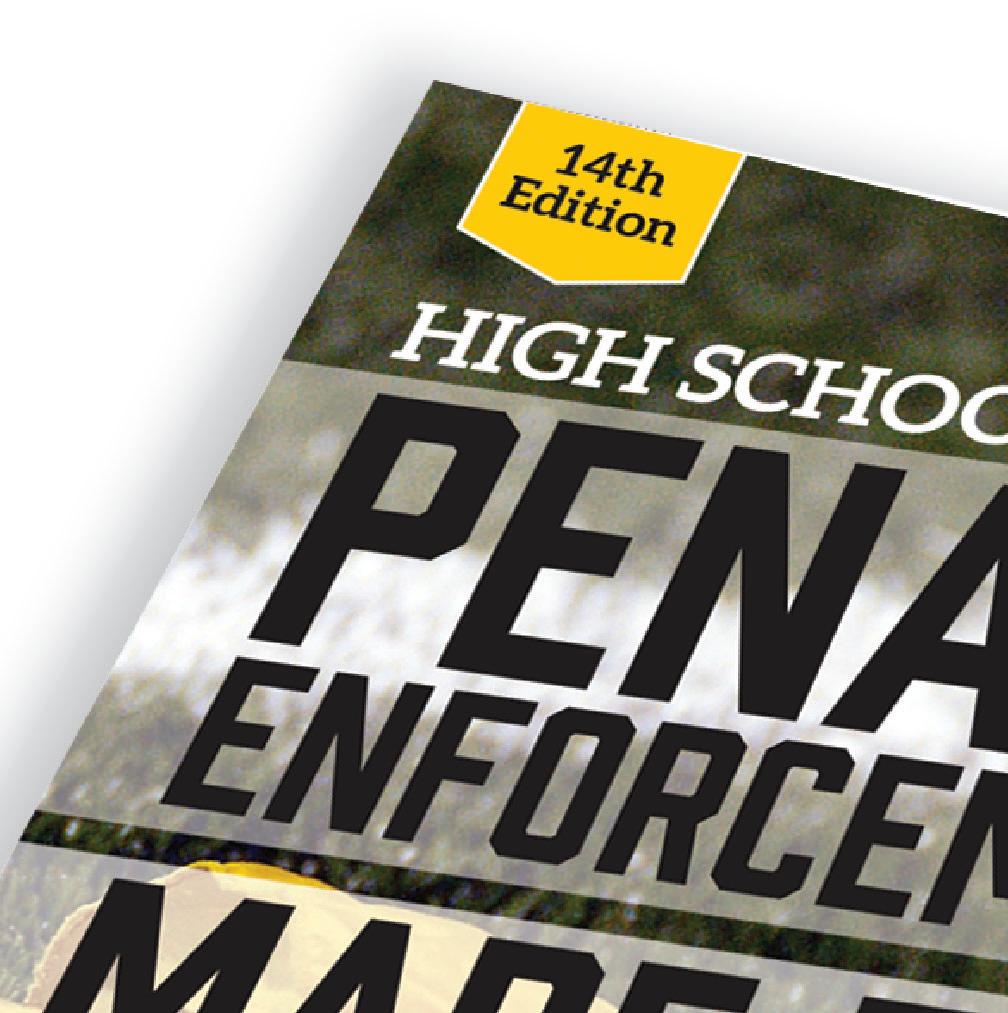


all 2024 rule changes included

THE BEST-SELLER IS BACK WITH AN ALL-NEW EDITION! THE EVOLUTION OF ENFORCEMENTS
Size: 8”x9” Pages: 160 ORDER YOURS TODAY! STORE. /FOOTBALL *NASO Member Discount Available. $2095 * DIGITAL $2195 * PRINT $2695 COMBO
CASEPLAYS
Kicking Tee
Play: As K1 is approaching the ball for a free kick, it falls or is blown off the tee. If K1 kicks the ball, is it an illegal kick? Ruling: No. If the ball does not remain on the tee, the officials should blow their whistles to keep the ball dead. Once the kicker replaces the ball on the tee, the referee should again blow the ready. Although it is not a rule, it is accepted practice for the kicking team to get two chances to kick the ball off the tee without benefit of a holder. If the ball does not remain on the tee a second time, team K should provide a holder.
Downed Punt
Play: Fourth and 10 for team K from team R’s 40 yardline. K1’s punt comes to rest a foot from the goalline. K2 downs the ball with his feet and legs in the end zone but the ball is in his arms in the field of play. Ruling: The ball is dead at team R’s one-foot line when K2 downs it. Team R will begin a new series there. The position of the ball — not K2’s body parts — are the determining factor. Because the ball never broke the plane of team R’s goalline, it is team R’s ball at that spot (NFHS 6-3-1a, 8-5-3a-1; NCAA 8-6-1a).
Illegal Kick
Play: Fourth and 10 from team K’s five yardline. K1, in his own end zone to punt, muffs the snap and kicks it while the ball is rolling on the ground. The ball rolls out of bounds at team K’s 10 yardline. Ruling: That’s an illegal kick.If team R accepts the penalty, it scores a safety. In NFHS, the penalty is enforced from the basic spot which is the spot of the foul. In NCAA, the basic spot is the previous spot. Since the foul occurred behind the basic spot, the spot of the foul is the enforcement spot. Because that spot is in team K’s end zone, the result is a safety. If team R declines the penalty, it would take possession at the out-of-bounds spot. In NCAA, the inclusion of loss of down in the penalty is not a factor because the play ended short of the line to gain. In NFHS rules, when the ball is loose following an illegal kick, itretains the same status as before the kick (2-24-9). Therefore, it would be considered a muffed snap out of bounds. In NCAA play, the illegal kick retains its status as a loose ball (9-4-4).
Player Numbering (1-4-2d)
If a player enters the game with a number different than what is on the game day roster, that player must report to the referee. A player who enters the game after changing his number or with a different number than is on the game day roster and does not report it commits a foul for unsportsmanlike conduct.
Replay
– Halftime Intermission (3-2-1b)
At the end of the first half, after the teams have left the field and the referee has cleared the final play with the onfield crew and the instant replay official, and there is no coach challenge, the referee will declare the half final. After the half is declared final, there can be no additional replay reviews from the previous play except for games in which instant replay is not used. A halftime targeting video review as outlined in 9-1-3 and 9-1-4 may be completed in those cases.
Replay – Dead Ball and Loose Ball (12-3-3d3)
If a passer is ruled down or out of bounds prior to throwing a pass and the replay official has indisputable video evidence that the ball was released prior to the dead ball ruling, replay can rule on the immediate continuing action. If the pass is caught by either team, they are awarded possession at that spot with no advance. If the pass is incomplete, the down counts.
Replay – Penalty Enforcement after Review (12-3-6i & j)
Penalty enforcement after replay reviews was codified. Fouls which carry five- and 10-yard penalties are not enforced if the ruling is overturned and a dead-ball foul enforcement would be created. Personal fouls and unsportsmanlike conduct fouls are always enforced, regardless of the outcome of a replay review.
George Demetriou has been a football official since 1968. He lives in Colorado Springs, Colo.
Eligibility Rule Difference
The player in the PlayPic started the down as an eligible receiver. Voluntarily stepping out of bounds changes that status and it varies by code.
In NF HS, such a player who voluntarily goes out of bounds and returns inbounds commits a foul for illegal participation (9-6-2a). However, he remains an eligible receiver.
In NCAA, returning inbounds makes him ineligible unless team B or an official is first to touch the pass (7-3-4). As a result, if a team B player were to interfere with the receiver who returned inbounds, it would be a double foul in NFHS (2-16-2b) but no foul in NCAA.


FOOTBALL 26 | REFEREE July 2024







The official NFHS Football Game Officials Manual produced by the editors of Referee! Loaded with dozens of mechanics scenarios and featuring Referee’s exclusive PlayPic® and MechaniGram® graphics, this new resource is a must have for high school football officials. Mechanics are broken down for crews of 4, 5 and 7 as well as providing detailed coverage for all situations.

YOU’VE NEVER SEEN A GAME OFFICIALS MANUAL LIKE THIS ONE!
THE NEW FOOTBALL OFFICIALS MANUAL
E
MOR E INSTRUCTION • MORE • MORE • MORE
MOR E PAGES MOR
MECHANICS
Print - $21.95 // Digital - $20.95 // Combo - $25.95 GET YOURS TODAY! STORE. /footBALL 208 pages 5” x 8.25”
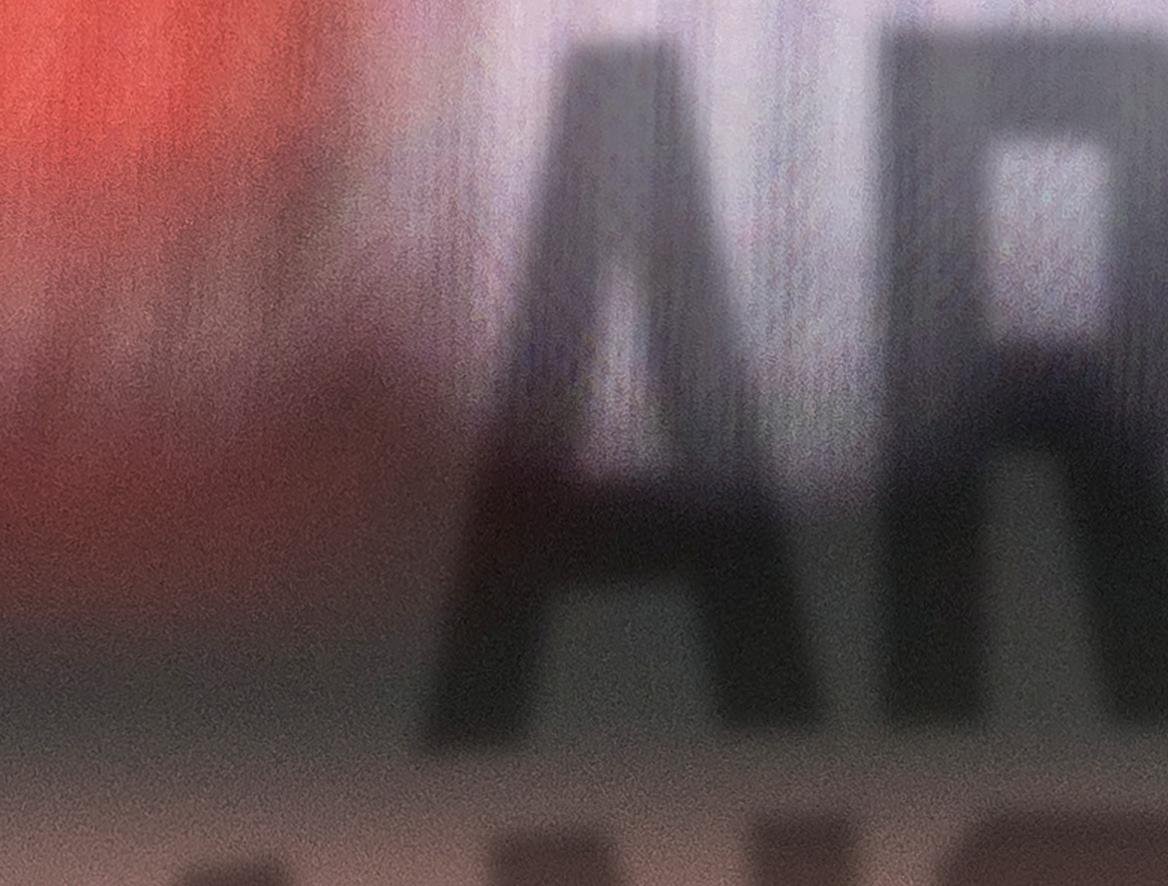


 BY scott tittrington
BY scott tittrington

A full-time big league umpiring career was not to be. But a love of umpiring would keep Angel Campos on the field.
Angel Campos was just five years old when Chico Escuela made his debut on Saturday Night Live in November 1978. So it stands to reason the former, a college baseball umpire raised in a traditional Mexican-American household in Ontario, Calif., is not consciously channeling the latter, a fictional Latin ballplayer for the New York Mets played by Garrett Morris who regularly appeared as the comedy program’s Weekend Update sports correspondent and featured the catchphrase, “Beisbol been berry, berry good to me.”
Yet it’s almost that exact phrase that Campos, 51, chooses to employ just mere moments after discussing the one year in his life that was anything but very, very good to him.
“Baseball has been very good to me. Even as a kid, it’s one of the ways my dad and I communicated. He was an old-school Mexican. It saved my
parents’ marriage. They were ready to divorce, then my brother and I started playing baseball and everything changed.
“Any time I can get on the field, it always helps me.”
Campos shares these thoughts while sitting in a hotel room in Eugene, Ore., having the night before worked a non-conference game between Sacramento State and the University of Oregon. He’s waiting to hitch a ride with a new batch of crewmates to nearby Corvallis, where a weekend Pac-12 series between nationally ranked Oregon State and Stanford awaits.
He is now 10 months removed from reaching the pinnacle of college baseball, having gotten the call in June 2023 as one of eight umpires to work the College World Series in Omaha, Neb. Ten months removed from settling into the slot and being tasked with calling balls and strikes
as LSU phenom Paul Skenes — who would a few weeks later become the No. 1 overall pick in the 2023 MLB Draft — pumped dozens of 100-mph fastballs past Tennessee hitters in front of a sellout crowd at Charles Schwab Field Omaha and millions more watching on ESPN.
And 10 years removed from a series of unfortunate events during which not just baseball, but life, was anything but very, very good for him.
The son of Miguel and Isidra Campos had, like many MexicanAmerican youth growing up in Southern California’s Inland Empire some 50 miles east of downtown Los Angeles, dreams of using baseball to find his way to a better life. Upon graduation from Ontario High School in 1991, he enrolled at Cal-Poly Pomona, an NCAA Division II school not far from home, but quickly found his skill set as a player was not of collegiate caliber.
28 | REFEREE July 2024
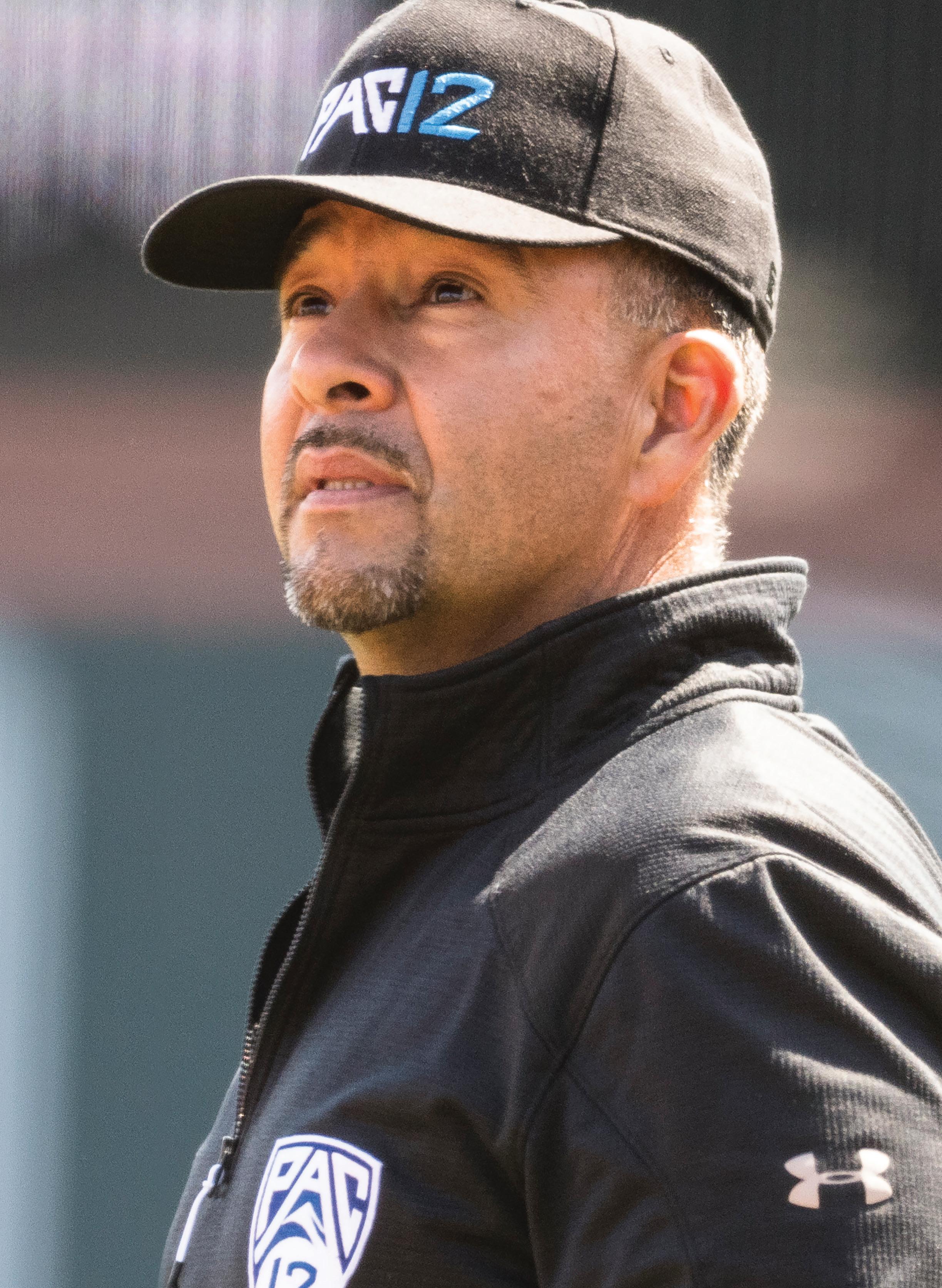
KARL MAASDAM
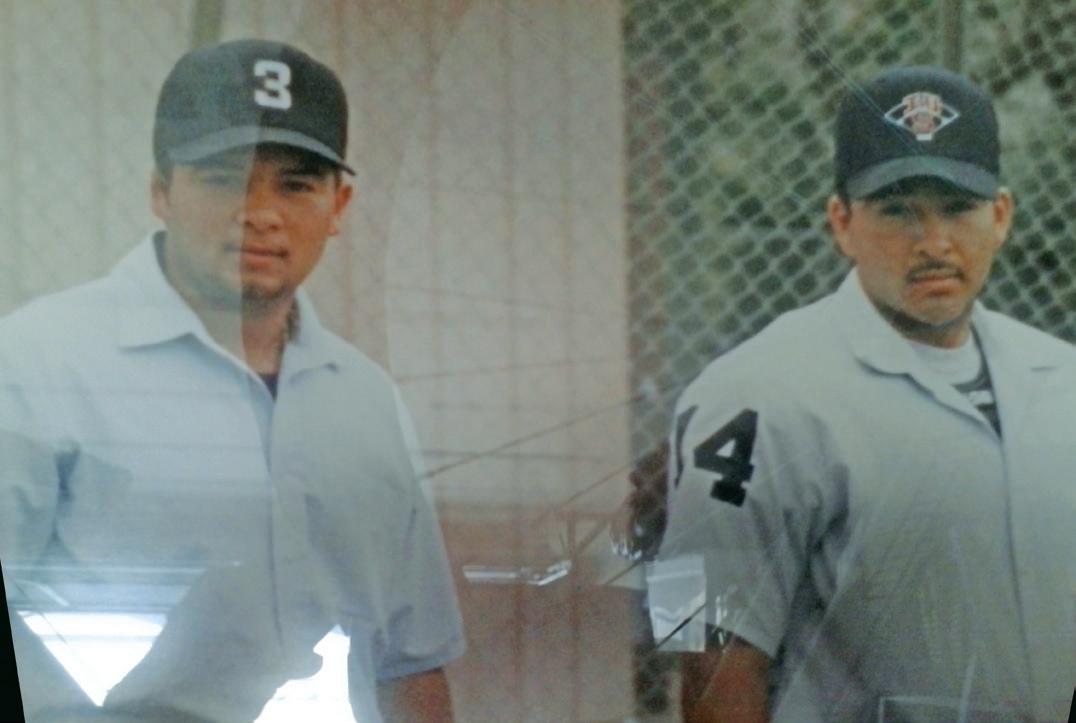
Of course, being a proverbial starving college student meant money was always an issue, and Campos decided if playing baseball wasn’t a meal ticket, perhaps there was a suitable alternative. He decided to give umpiring a try, joining a local association and working lowerlevel high school games. By his own admission, he didn’t have much of a clue what he was doing. Yet it was the beginning of a passionate love affair.
“I remember being a nervous wreck,” Campos said with a laugh. “When I started doing high school games, varsity and freshmen played the same day. The (umpires) from the varsity would come down and watch. I had caught the bug and wanted to learn everything I could about umpiring.
“They told me, you do a pretty good job and it looks like you like it. ‘I love it.’ One of the guys had a Referee magazine and he handed it to me. In the back was information about umpire school. I had no idea there was an umpire school. So I looked into it.”
With his degree in physical education from Cal-Poly in tow and knowing he could always fall back on a teaching career, Campos placed a call to the Wendelstedt Umpire School. On the other end of the line came the chief himself, Harry Wendelstedt.
“He picked up and I talked to Harry,” Campos said. “He said, ‘You’re the perfect
candidate. You don’t have any bad habits.’”
Campos’ parents and younger brother pooled together enough money to pay for school, and in January 2000, he caught a flight to Florida.
“It was interesting. I almost didn’t go. That was the year the world was going to shut down,” said Campos, referring to the Y2K fears that gripped the country. “I was supposed to fly early in the morning on Jan. 1. My mom didn’t want me going.”
The headstrong Campos didn’t listen. Fortunately, not heeding his mother’s advice is not a habit he regularly employs, or this may have been the point where the Angel Campos umpiring story ends. Because as the ensuing few weeks would prove, while Campos the umpiring student did not have any bad habits, he also did not have much of a clue.
“I thought I knew a little bit about umpiring but as soon as I got there, I was doing everything wrong. It was like a boot camp. I didn’t have equipment; I was using the equipment they gave me,” Campos said. “At the two-week mark if you decide you don’t want to be there, you can leave and get some of your money back.
“I couldn’t even properly
straddle the line on a ball hit down the first-base line. I told my mom I was coming home.”
Knowing what her son needed to hear, Isidra Campos didn’t lay down the law or issue any guilt trips about how hard the family had worked to provide the financial backing for an ill-conceived umpiring lark. She opted for a much softer approach.
“As my husband and I talked, we decided that the best thing for him to do was since he was already there, to enjoy the stay and take it as a vacation,” Isidra Campos said. “The only thing we asked was that he try his hardest until the end.”
Armed with his pep talk from mom, Campos started to turn a corner. He recalibrated his focus during drills, turning off his natural inclination to chat up his fellow campers and instead watch and learn at every opportunity when he wasn’t actually taking reps himself.
“It started clicking. It started making sense,” he said. “I didn’t think I was going to make it. But that’s why those guys (the pro school instructional staff) are there. They can see somebody who has potential.”
The next few months would see Campos advance to and complete the second part of the professional umpire education process known as the PBUC course, receive an offer to
Campos attended the Wendelstedt Umpire School. He spent a long career in the minor leagues — with a healthy dose of MLB games as a call-up umpire — before his release in 2014. Two years later, he returned to the field to umpire college baseball.
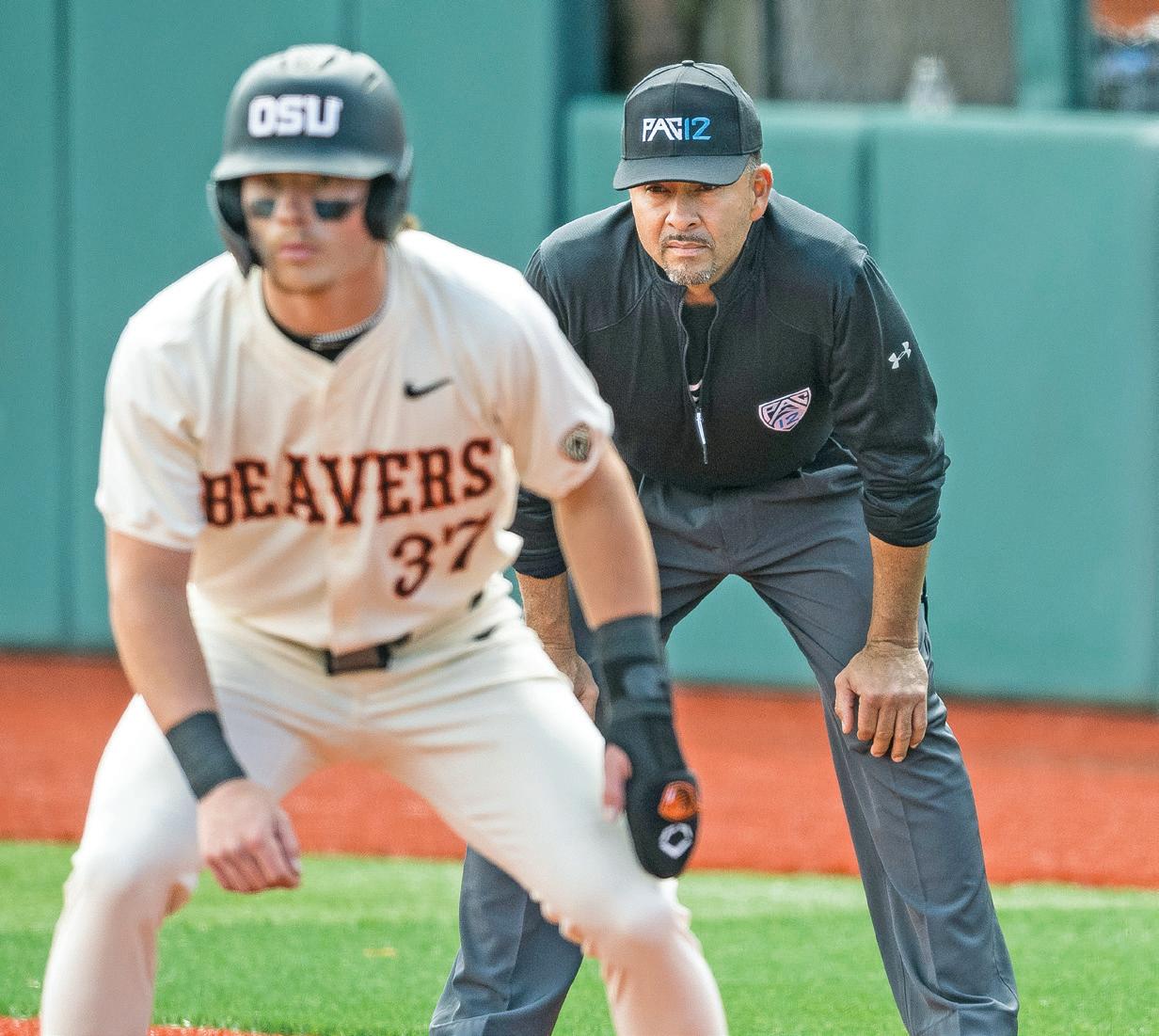
30 | REFEREE July 2024
Early in his umpire career, Angel Campos (right) worked Little League games with his brother, Victor, in Ontario, Calif.
COURTESY OF ANGEL CAMPOS, KARL MAASDAM
become a professional umpire and head to extended spring training in Phoenix, then catch on in the Northwest League, a short-season Single-A league in the Pacific Northwest. His first official game would take place in Salem, Ore., with partner Carl Coles.
“I still remember driving out there and I couldn’t believe it. I was a nervous wreck,” Campos said. “My first game was at Salem-Keizer. I remember losing track of the baseball because I wasn’t used to the fans. But once you start going you get used to it; it’s just a game.”
Just a game became a fast track to just a promising professional umpiring career. In 2001, Campos again began his season in extended spring training before being shipped to the Single-A Midwest League. That was followed by full seasons in the Single-A California League (2002), the Double-A Texas League (2003) and the Triple-A Pacific Coast League (2004). After just five years in professional baseball, he was only one rung on the ladder away from experiencing life as an MLB umpire.
“I think they had to move me fast to find out if I was good or not,” Campos said.
Apparently those calling the shots in the MLB umpiring department had their answer. Following another season in the PCL in 2005, Campos was assigned to the Arizona Fall League.
“The next step is getting a number and getting invited to big-league spring training,” he explained.
A few months later that became reality, the number “84” affixed on his right shoulder as he worked in big-league camp for the first time. However, Campos’ quick ascent to the MLB call-up list also coincided with an era when there was little turnover on the full-time MLB umpiring staff. As such, he would have to wait another 14 months before finally receiving his call to “The Show.”

Continuing to plug away in the PCL, Campos was in Oklahoma City early in the 2007 season when inclement weather necessitated a daynight doubleheader between the New York Yankees and Texas Rangers.
“(Umpire supervisor) Richie Garcia called me. ‘You need to get to Arlington. You’re working your first big-league game.’ We actually had to get someone to go open up the stadium in Oklahoma City so I could get my gear,’” said Campos of his recollections of the May 3 callup. “It was pretty incredible when I got the call. I didn’t know whether to laugh, cry, probably both.
“My drive there I was just, all my training, all my years of work, I was just replaying it over and over all the way down there.”
The only melancholy aspect to the biggest moment of Campos’ umpiring career came with the absence of one key figure on the other end of the phone call home to share the news. Miguel Campos, Angel’s father, died in November 2006, six months before his son received the just reward for the faith his parents had shown in his umpiring dreams.
“When I received the call that Angel was going to be working in an MLB stadium, I was in shock, I didn’t know how to react. All I knew was that I was very proud and very, very happy,” Isidra Campos said. “I thanked God for this accomplishment and the goals
Campos worked as a call-up umpire — working big league games while on the MiLB staff — from 2007 until he was released in 2014.
that Angel met and was proud because he didn’t give up and continued to fight. Miguel would have been so proud as well if he was still living.”
Befitting the life of an “up-and-downer,” Campos worked those two games — one at first base, one at third — and then immediately drove back to Oklahoma City to join his crew. However, the calls did not end, as he would ultimately work 14 games that season.
The next year would see him get his first chance to call balls and strikes in an MLB stadium when he worked a plate job at the then U.S. Cellular Field in Chicago. He also became what is informally known as a “rover,” meaning instead of having a regular Triple-A crew, because of his expected MLB workload, he would stay in constant contact with the PCL president and jump in as part of a four-umpire crew wherever he was needed.
It’s an arrangement that led to Campos working 585 major league games between the 200714 seasons. He had proven he had the chops to work at the highest level whenever the need arose.
“When Richie Garcia was there, he was pretty open with us. He was like, ‘Hey, we’re just waiting on spots to open up,’” about Campos needing to bide his time in his quest to achieve an MLB full-time staff position. “But there’s also a saying that as long as you’re on the dance floor, there’s a chance of something happening. So you tried to stay under the radar.
“I really didn’t know if it was
REFEREE July 2024 | 31
JAMES ALLISON/ZUMAPRESS/NEWSCOM
going to happen. We needed movement and there wasn’t any.”
Instead, the movement that would dictate the next chapter in Campos’ career came at the supervisory level. Before the 2014 season, several big names including Garcia, Steve Palermo and Frank Pulli were released, ushering in a new regime.
“Obviously when new bosses come in, new philosophies come into play,” Campos acknowledged. “There were about five of us that were getting ready to get hired and they skipped all of us. They hired guys with only 100 major league games. And then I got worried.”
Unfortunately, those worries proved to be wellfounded. Per the famous cliché, Campos’ recollection of events during the 2014 season are now crystal clear — being sent to spring training in Florida instead of near his Arizona home; a crew assignment in the International League, also in the eastern half of the country; the loss of his rover position. Add to the mix one particular ruling during that season while he was on a call-up assignment in Milwaukee. The crew misapplied a rule, and the next day at lunch Campos had a message on his phone. What was supposed to be an extended MLB call-up was suddenly cut short: “Back to the minors on Monday.”
A month after the conclusion of the 2014 season, Campos received another call from MLB brass. He was being released. His professional umpiring career was over after 15 seasons. He was 41 years old.
“The first thing that went through my mind is, ‘I’m obviously upset.’ I wasn’t mad,” Campos said. “It wasn’t that I wasn’t going to work at Dodger Stadium or Yankee Stadium, but how am I going to provide for my kids? I’m going to provide this kind of

Campos was among the umpires selected for the 2023 College World Series. The crew included (from left) Brandon Cooper, Louisville, Ky.; Campos; Ramon Armendariz, Inglewood, Calif.; Jeff Head, Hoover, Ala.; Billy Van Raaphorst, San Diego; David Savage, Lawrenceville, Ga.; Casey Moser, Lago Vista, Texas; and Travis Reininger, Brighton, Colo.
lifestyle that I had planned for my kids, and then it’s gone. My world is crumbling.”
A few months later, the news got even worse. Campos’ wife of 15 years informed him she wanted a divorce.
“That year was devastating,” Campos said. “I was just not in a good place.”
“While going through the call of being released and then after, going through the divorce, I could see that Angel was not doing well. Every time I saw him, I could just see the pain and suffering in his eyes,” Isidra Campos said. “This period was one of the hardest for me because there was nothing I could do to make him feel better. It’s something that God would have to heal with time.”
with the quest to provide the best umpiring product available regardless of the training mechanism, and what better proving ground than an in-hisprime arbiter with more than 500 big-league games under his belt?
“I knew the name Angel Campos; I knew he’d been one of the up-and-down guys,” said Dave Yeast, who came off the field in 2015 to become the coordinator of umpires for the Pac-12 Conference. “We had a significant number of ex-professional umpires who worked in our group, so we had plenty of guys who were familiar with him.
“Angel came very highly recommended. That was an easy hire, to be honest with you.”
Campos said his children were foremost on his mind when he was released from pro baseball in 2014. Below, Campos is shown with his sons, Miguel, (left) and Angel Jr. Below right, he is with his sons and daughter, Italia.
After taking the 2015 season off and figuring out what a new normal would look like for himself and his kids, Miguel, Italia and Angel Jr., Campos started reaching out to college umpiring assigners to inquire about the possibility of starting his career anew at the amateur level.
That would have been an inconceivable road map as little as 25 years ago. You were either a professional umpire or college umpire, and never the twain shall meet. However, there has been a sea change in college baseball this century
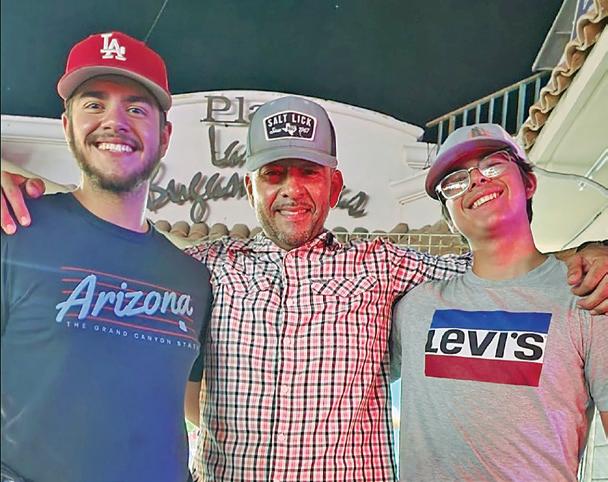
But not without its own concerns. The adjustment to umpiring college baseball after a pro career and all of the particular idiosyncrasies that come with the game at the NCAA level is more daunting than one might first expect.
“I felt like I didn’t have a hard time transitioning as far as off-the-field stuff, but on the field I didn’t know if I was going to be able to handle it,” Campos admitted. “I had some ejections early and had to learn to handle it differently than pro ball.”
With the help of Scott
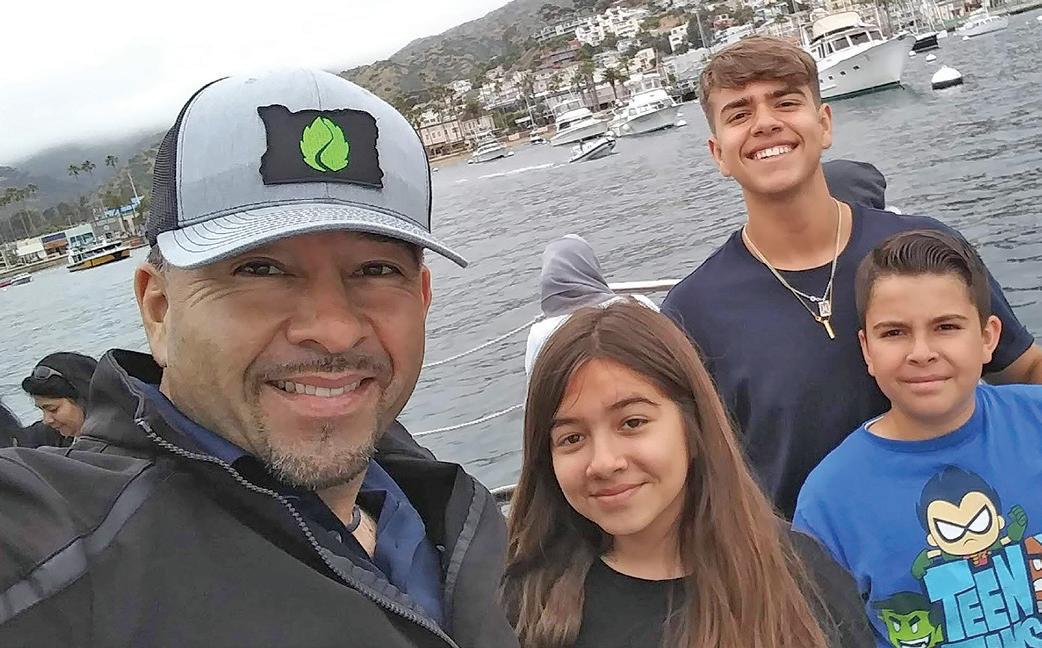
32 | REFEREE July 2024
COURTESY OF ANGEL CAMPOS
Higgins, a former pro umpire whom Yeast describes as the right-hand man he relies on to help assimilate those released by MLB into the college game, Campos quickly established himself as one of the top collegiate umpires on the West Coast.
“I’ve never met anyone that makes it smooth as silk. There’s too many differences,” Yeast said. “The rah-rah college spirit is different than anything in professional baseball, and that’s hard for some guys to handle. Everyone that comes out of pro ball has some of those bumps, some of those frustrations. Overall, Angel made the transitions as seamlessly as anyone else.
“Angel is an umpiring junkie, and I say that with all the love the term ‘junkie’ can have. He’s one of those people that really wants to succeed in college baseball and certainly has. He loves to talk about umpiring and ask questions. Even someone with all his experience, he’s still a student of the game, and I love that about him.”
Being a quick study landed Campos in his first NCAA postseason at the conclusion of the 2019 season, when George Drouches, the NCAA’s national coordinator of umpiring, assigned him to work the Athens Regional hosted by the University of Georgia. The next year saw college baseball shut down by the COVID-19 pandemic, but Campos picked up right where he left off in 2021, when he was awarded his first Super Regional at Vanderbilt.
As the 2023 college season drew to a close, he increasingly heard the locker room chatter about who might be selected to work deep in the postseason and perhaps get the nod to ascend to college baseball’s Mount Olympus — the College World Series.
“I’m not going to lie to you. I didn’t think I was going to get it,” Campos said. “I said,
‘Well, maybe I can go next year.’ One of my wishes was to go to Omaha. Everyone that goes, you can tell the excitement they have.”
While playing golf with several of his closest umpiring buddies just before the start of the 2023 Pac-12 Baseball Tournament, Campos’ phone buzzed. Drouches was on the other end of the line. His time had come.
“We’ve been tracking Angel since 2019. We follow our umpires yearly in conjunction and coordination with our coordinators,” Drouches said. “There’s over a thousand observations in the system. We have a pretty good idea who our umpires are and our plans for them.
“When you select people for our championship, you look for the best umpires, but at the same time the right ones. I believe Angel Campos embodies both. I think any time an umpire gets a chance to work on a crew with Angel they’re in for a special treat.”
Perhaps none of the eight men selected to work the 2023 CWS embraced the opportunity as fully as Campos. Had it not been for the all-access credential draped around his neck, he easily could have been mistaken for a fan, with a wide smile, a chatty disposition and a digital camera in tow everywhere he went to capture every last element of the experience.
But make no mistake, while Omaha is the ultimate reward for a job well done, the job is anything but finished. Drouches placed Campos on a four-man crew with crew chief Jeff Head, fellow first-time Omaha umpire Brandon Cooper and one of Campos’ closest umpiring friends, fellow Pac-12 umpire Ramon Armendariz. That group got the nod to work the first game of the series, with Campos setting up as the U1 for a showdown between Oral Roberts and TCU. Later that night he received word from

Following his pro umpiring career, Campos made the transition into college baseball, getting hired into the Pac-12.
Drouches that he would have the plate for LSU-Tennessee on Day 2, where Skenes and his triple-digit fastball would be waiting.
“I’m not going to lie to you, there’s always a little bit of nerves, a little bit of excitement,” said Campos about his reaction to receiving that plum assignment. “You just want them to throw that first pitch so you can get the nerves out of the way.”
He would work one more plate while in Omaha, a rematch elimination game between Oral Roberts and TCU, and his final Omaha assignment came in Game 2 of the three-game championship series between LSU and Florida, where he was stationed at third base.
Then, true to Yeast’s junkie description, Campos was off to North Carolina to work the American Legion World Series. Because when you’ve almost had your love affair taken away from you once, you will do almost whatever it takes to make sure it never happens again.
“I plan to do it until my body says no more,” Campos said. “I can’t wait for the season to start each year.
“I just love to umpire.”
Scott Tittrington is an associate editor for Referee. He umpires college and high school baseball, and officiates college and high school basketball and high school football.
REFEREE July 2024 | 33
KARL MAASDAM
BASEBALL
RULES, MECHANICS, PHILOSOPHY

TAG, YOU’RE IT
Understanding the Differences Between Tags and Forces
By George Demetriou
There are several ways to record an out, including interference calls and of course, the plentiful strikeouts in most games. For plays on the bases, the vast majority of outs will be either plays that require the runner be tagged, or plays when either the runner or the base may be tagged (NFHS 2-24-4; NCAA 2-78; pro Tag Definition). Except where noted, the material applies equally to NFHS, NCAA and pro rules.
Most of the plays where only the base need be tagged are force plays, but please understand a routine groundout at first is not a force out.
A force out occurs when a runner loses his right to the base he occupies because the batter becomes a batterrunner (NFHS 2-29-3; NCAA 2-33; pro Force Play Definition). While it is true a batter is compelled to touch first base after hitting a grounded fair ball, he is not “forced.” A batter does not “occupy” the plate so he hasn’t lost the right to occupy a base. However, because he is compelled to advance, a fielder need only touch the base with possession of the ball before the batter-runner arrives to gain an out. For practical purposes, all plays on the batter-runner advancing to first are treated the same as a force play. When a runner is compelled to
advance, the base may be tagged without necessarily tagging the runner. Other examples of a runner being compelled to touch a base include returning to a missed base or a base left too soon.
Control/Possession
Unlike the rules of other sports, neither term is defined in any of the baseball codes. The dictionary is of minimal value as the definitions of the two terms are circuitous, so we’ll consider the terms identical and describe them as a firm or secure grip of the ball. For an out to be recorded, the fielder must have possession of the ball. When making a tag in a
34 | REFEREE July 2024 EDITOR: SCOTT TITTRINGTON stittrington@referee.com
HESTON QUAN
When observing this play at the plate, Joe Venegas, Orange, Calif., must ensure all the elements of a successful tag are met, including possession of the ball at the time of the tag and maintaining control through the end of the play.
force situation or if the first baseman is attempting to put out the batterrunner, the ball cannot be pressed against his body; it must be controlled in his hand or glove. If the runner knocks the ball away from the fielder, the tag is still valid.
Time Element
If a fielder is in the process of making a tag and drops the ball, it is not a tag. Simultaneously dropping the ball or dropping it immediately after making the tag is an indication the ball was not securely and firmly possessed. The fielder must hold the ball long enough to prove he has complete control of the ball while in the act of making the tag; there is no set time limit. However, if the fielder has made a tag and drops the ball while in the act of making a throw following the tag, the play should be ruled as a legal tag.
Application
On plays where the base may be tagged, tagging the runner also accomplishes the out, but the converse is not true. When tagging the runner is required, having possession of the ball while touching the base does not get the out.
Tagging the Base
Situations when touching the base with control of the ball before the runner arrives will result in an out include a force play, a play at first as explained above, a continuing action appeal and an announced appeal with a live ball, to include a missed base or home plate. Almost always, the fielder uses his foot to contact the base, but any body part can be used to include the hand or glove even if the ball is held in the opposite limb.
Here are some plays that illustrate getting an out by tagging the base.
Play 1: With runners on first and third and one out, R1 on first takes off with the pitch. B4 hits a line drive into the gap that is caught. R3 tags and trots home. R1 hastily attempts to return to first. The ball is returned to first before R1 arrives, but after R3 touches the plate. Ruling 1: It’s a double play. Although R1 was compelled to return to first, it is not a
force play as B4 had been retired. R3’s run scores on the time play. However, the fact R1 was compelled to return allows the base to be tagged prior to R1’s return; there is no need for R1 to be tagged on the continuing action appeal.
Play 2: B2 singles to apparently score R2 from second. The ball is returned to F1 and before F1 engages the rubber, F2 yells for F1 to make an appeal at third. F1 throws the ball to F5, who touches third and appeals R2 missed third. Ruling 2: That is a legal announced appeal. There is no need for R2 to be tagged. Touching the base with the ball is sufficient and R2 will be declared out.
Play 3: With a runner on second, B2 singles. R2 attempts to score and there is a close play at the plate. F2 misses the tag as R2 misses the plate. F2 jumps up quickly, steps on home plate and yells, “I’m appealing!” as he fires to second to prevent B2’s advance. As F2 appealed, R2 was (a) scrambling back to the plate, or (b) heading for the dugout. Ruling 3: In (a), R2 is not out and the run counts. Because R2 immediately made an effort to touch the plate, he is out only when he is tagged. In (b), R2 is out since he left the plate area heading for his dugout. In such a case, he is out when he is tagged or the base is tagged and appealed.
Tagging the Runner
Situations when it is required to touch the runner with control of the ball before the runner touches the base in order to record an out include steal attempts, pickoff attempts and runners attempting to advance to a base to which they are not forced. The fielder must make the tag with either the glove or hand, but the ball must be firmly gripped in such glove or hand. If the fielder uses his hand, it does not matter if the tag is made with the back of the hand or with the ball. If the glove is used, the ball doesn’t actually have to be in the glove, but may be pressed against the inside or outside of the glove as long as the fielder has control of the ball in his hand. A tag with the dangling strings of a glove is not a legal tag. The tag on the runner does not
SIDELINE
MiLB Umpires
Pay
Tribute With Patch
Minor league baseball umpires are wearing a patch with the initials “JP” on it this season in honor of Jay Pierce, 40, who died last September following a four-year battle with colon cancer.
Pierce umpired for seven seasons in the minor leagues from 2006-12, and in 2010 joined the instructional staff at the Harry Wendelstedt Umpire School. In 2014, he became a part-time umpire development supervisor for Minor League Baseball, was upgraded to a full-time role in 2018 and then joined the MLB staff in 2022.
“He’s deeply missed within our group,” said Dustin Dellinger, senior manager of umpire development for MLB. “He was the life of the group, and he’s just a very jovial guy. The umpires loved him just because his passion for the job and passion for teaching was like none other on our staff.”
SOURCE: MILB.COM
QUICKTIP
Always bring your full umpire equipment bag to every game you work. While you may be scheduled to work the bases for a given assignment and believe you have no need to tote around 30 pounds of gear, life happens, and if your partner either doesn’t show or arrives on site only to find a missing ball bag, mask or more, you will have the opportunity to be a crew saver.
THEY SAID IT
“No, I’m not bitter at Denkinger. He’s a good guy, he knows he made a mistake, and he’s a human being. It happened at an inopportune time, but I do think they ought to have instant replay in the playoffs and World Series.”
–Former St. Louis Cardinals manager Whitey Herzog, about first-base umpire Don Denkinger’s game-changing missed call late in Game 6 of the 1985 World Series, which was ultimately won by the Kansas City Royals in seven games. Herzog died April 15 at age 92.
SOURCE: ASSOCIATED PRESS
REFEREE July 2024 | 35
TEST YOURSELF
In each question, decide which answer is correct for NFHS, NCAA or pro rules. Solutions: p.81.
1. Team A’s starting pitcher walks the first batter in the sixth inning. The pitching coach uses his first charged conference to speak to the pitcher. After the trip, team B’s head coach puts in a pinch hitter. Team A’s head coach comes out to make a second trip and replace the pitcher.
a. Warn the head coach he cannot make a second trip. If he continues, he is ejected and the pitcher will be substituted for after he completes the at-bat.
b. Warn the head coach he cannot make a second trip. If he continues, he is ejected but the pitcher may remain in the game with no penalty.
c. Allow the trip and the substitution is required.
d. Allow the trip, but the substitution is not required if a coach has not been involved in three charged conferences.
2. A player slides into second base and suffers a laceration or wound that is bleeding.
a. A decision whether to substitute for the injured player must be made within a reasonable amount of time from the time play is stopped.
b. A decision whether to substitute for the injured player must be made within 10 minutes from the time play is stopped.
c. No substitution is required even if the wound is still bleeding.
d. The player must immediately be removed from the game.
3. R2 is attempting to steal third base. The home-plate umpire interferes with the catcher’s attempt to throw the ball to retire R2.
a. The umpire’s interference results in an immediate dead ball and R2 is returned to second base.
b. The umpire’s interference results in a delayed dead ball and R2 may be returned to second base.
c. If the catcher’s throw directly retires the runner, the interference is disregarded.
d. B and C.
have to touch the player’s body to be legal; a tag can be made on any proper baseball equipment worn by the player, obviously including the uniform. Batting gloves sticking out of a pocket are considered baseball equipment, as is a helmet. However, if the player’s helmet is dislodged, it is no longer part of his person. A fielder cannot make a legal tag of a dislodged helmet. But if the helmet is still touching the player’s head,
and the helmet is tagged, the runner is out.
Jewelry worn by a player (e.g., necklaces, bracelets, etc.) is not considered proper baseball equipment. While tagging jewelry without also simultaneously tagging part of the body would be unusual, a swipe tag on a dangling necklace would not be considered a legal tag. George Demetriou, Colorado Springs, Colo., is the state’s rules interpreter.
Stuck on the Struggle Bus?
By Jon Bible
I’ve
never known an umpire who didn’t struggle at one time or another. I’m referring to behind the plate. Maybe that umpire is too tight or loose in part(s) of the strike zone or inconsistent. What can/ should we do if our partner is in this
predicament? Before getting there, two preliminary matters.
First, why do we struggle? There are three elements to calling pitches correctly. We must see the pitch from the release point into the catcher’s mitt, be in position to properly assess whether it passed through our mental strike-zone window and then

While umpires should refrain from getting together to chat at the end of every half-inning, part of being a good crewmate is recognizing there is an issue with your partner and bringing it to that partner’s attention so it may be self-corrected. Left, Stu
Mission Viejo, Calif., and Art Augustine, Anaheim, Calif.
36 | REFEREE July 2024 BASEBALL
QUAN
Rains,
HESTON
use enough time and concentration to make that assessment accurately. If we’re struggling, we can take it to the bank there’s a problem in one or more of these areas. Maybe heat, cold, precipitation, darkness, wind, a fight with our mate, catchers who bounce all over the place, etc., cause us to lose our focus. Or maybe we’re doing something unusual mechanically, like setting up too high or low, or our timing is off.
I’ve often told the story of missing the first three pitches in a semifinal College World Series game. The first two were sliders on the corner that I balled because they registered as outside. I missed the third one because I knew I had missed two strikes and was determined not to miss another one, so I was thinking “strike” before the pitcher even released the pitch. That it was about six inches low and outside didn’t deter me a bit.
As panic set in, I ran through a checklist regarding position, height
and timing. Instead of squaring up, I was setting up at a 45-degree angle in the slot, which distorted my perception of the outside part of the zone, and my timing was quick. In terms of the elements above, all three were problems. Once I fixed things, I did fine.
In pro umpire school, there’s a mantra: “On the rubber, get set, call it” — meaning watch the pitcher toe the rubber, assume our stance as he starts his delivery, see the pitch into the mitt, let it register and call it.
A college umpire who knows a lot of pro umpires recently told me he asked about 15 of them what they did when they were struggling, and almost every one said they went through a checklist of the pro-schoolmantra basics. This generally resulted in a sound course correction.
Second, here’s a preemptive way to deal with the struggling partner conundrum. The guys I worked with for years had a routine. About the middle or end of the second
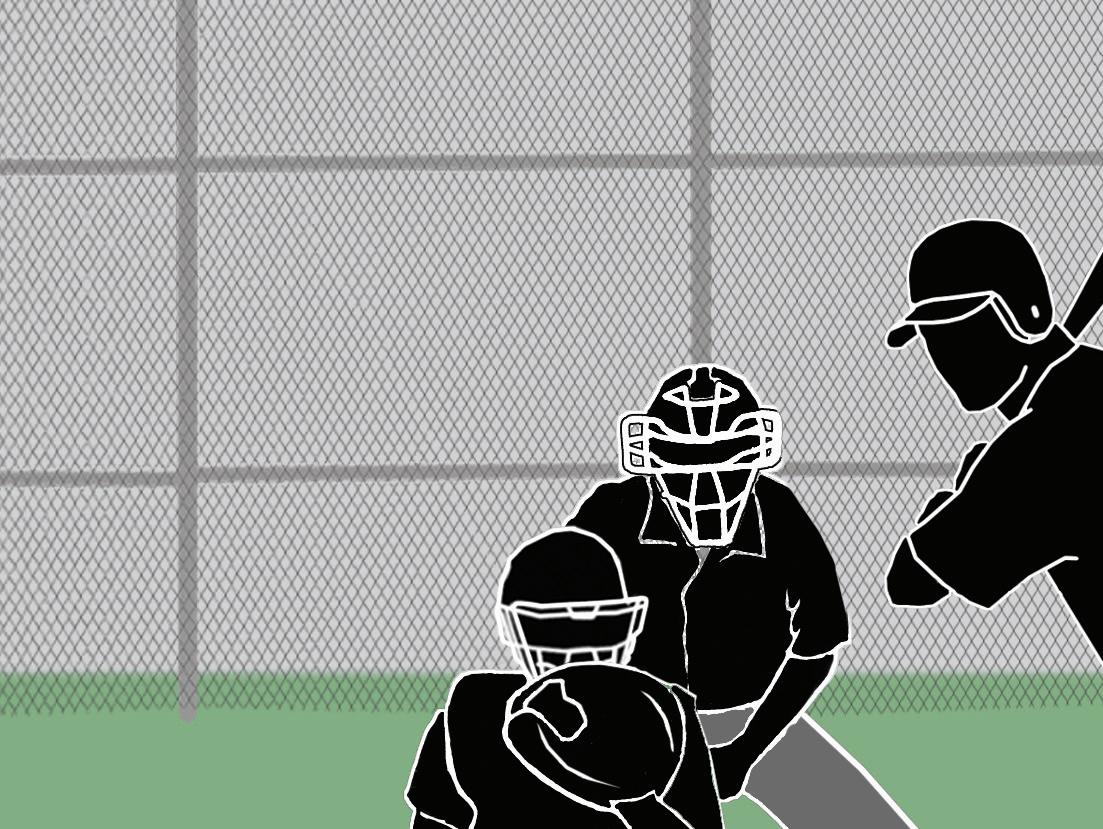
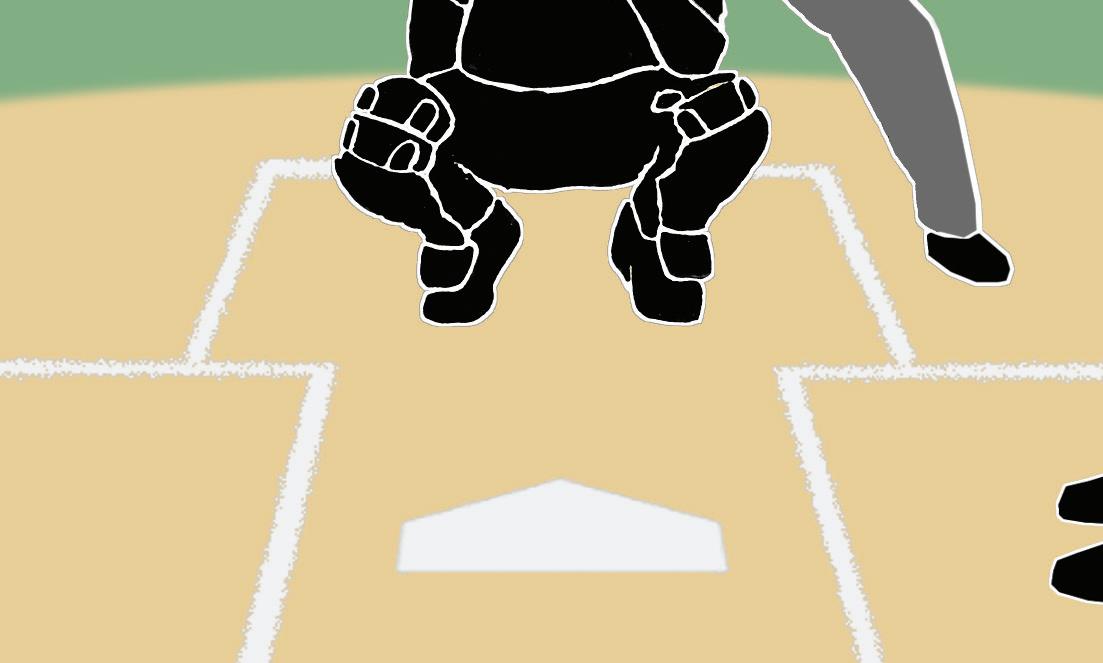
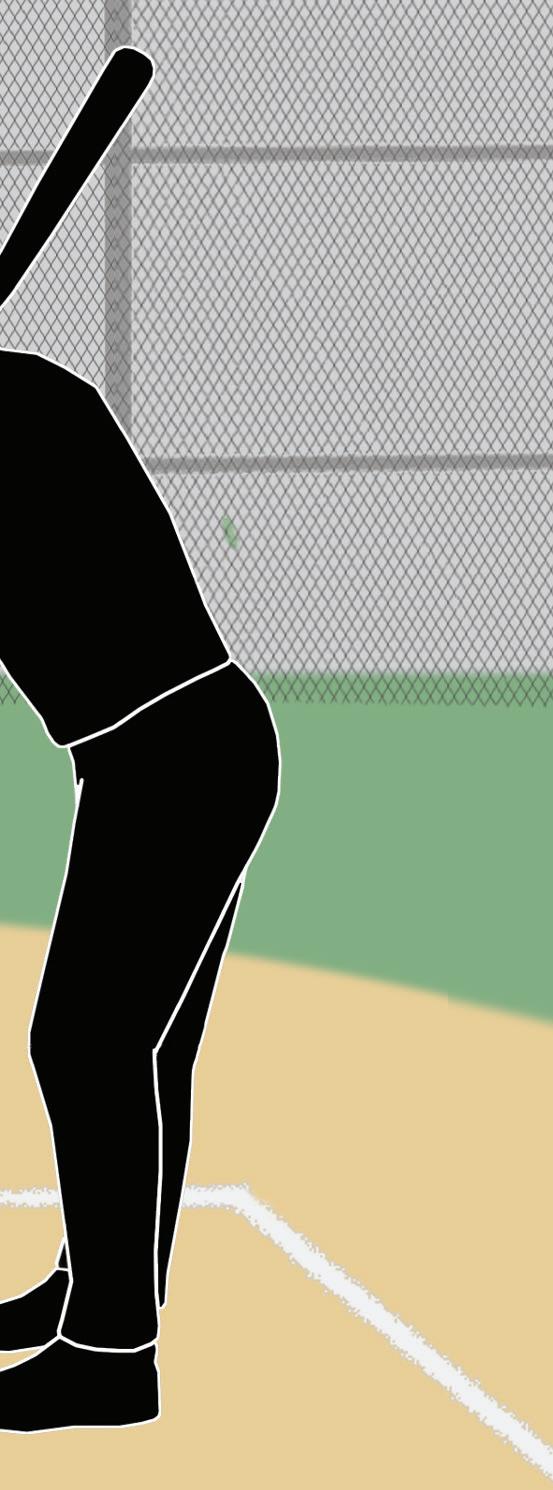
inning we’d call a partner in and ask how things looked. Every game. If everything was OK, great, but because we were brutally frank with each other, I knew I’d hear about it if, in fact, my zone was too low, tight, big, inconsistent, etc. Sometimes we don’t know there’s an issue until someone tells us, and then we can go through our checklist. By doing this, we didn’t put anyone in the position of having to figure out whether and how to approach us if they thought something was amiss. Consider adding this to your repertoire, if not always, at least if you suspect that all is not well.
Now to the issue of approaching our partners. No problem if you regularly work with, and trust, each other; go in and tell them what you think. You can also do this with people you don’t steadily work with but are friends. I once worked an NCAA regional tournament with “Steve,” who was from another area but with whom I had a good relationship. He worked a box stance, but in the first two innings he went to a knee, scissors, back to a box, scissors, etc., which told me he wasn’t comfortable.
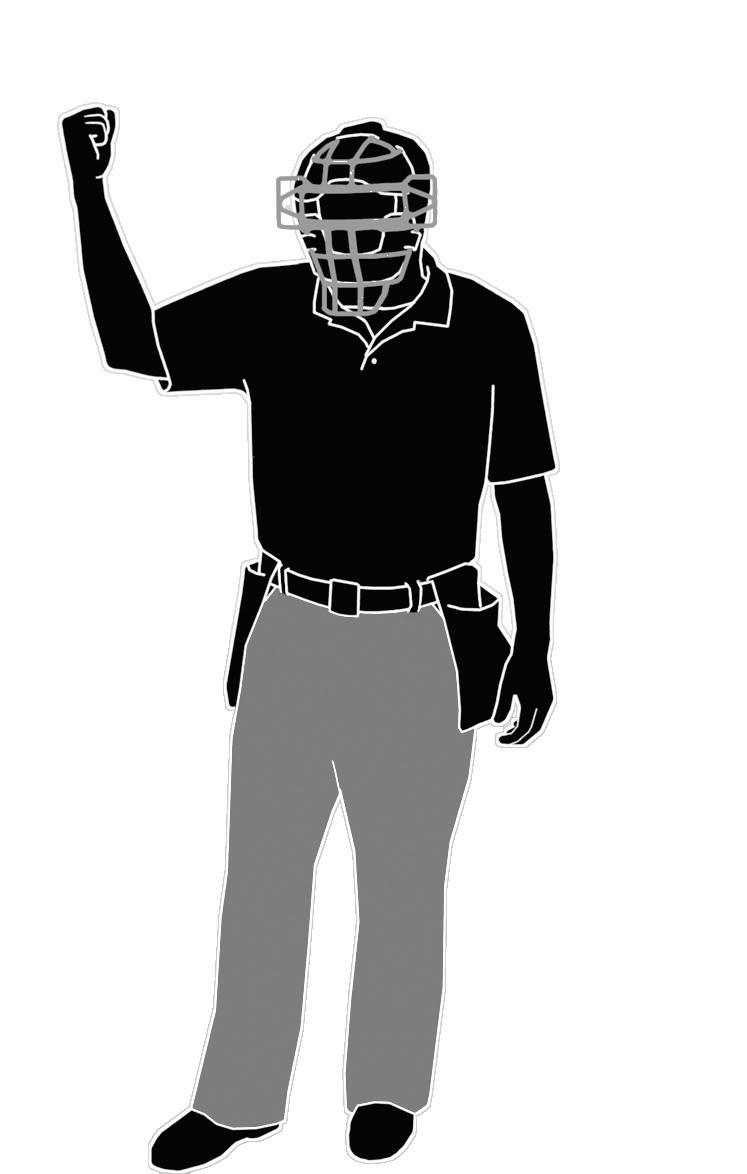
REFEREE July 2024 | 37
Whenever you catch yourself struggling to call pitches accurately, take inventory of your head height and slot positioning when assuming your plate stance (PlayPic A) and remind yourself to have proper timing before signaling what you have on the pitch (PlayPic B).
A
B
CASEPLAYS
Footsie
Play: With R3 on third, R1 on first and one out, B4 hits a foul fly ball near a line delineating deadball territory. F5 straddles that line — with one foot in dead-ball territory and one foot in live-ball territory — as he makes the catch. Then, his momentum causes him to step completely into dead-ball territory. Ruling: In NFHS, F5 is credited with a legal catch. R3 and R1 are awarded one base. In NCAA and pro, the catch is not legal; that is merely a foul ball (NFHS 2-9-1, 2.9.1C Cmt., 5.1.1P; NCAA 6-1d1; pro 5.06b3C, 5.09a1, 5.12b6).
No Catch
Play: With R1 on first, F3 is playing in. B2 hits a line drive that deflects off F3’s glove, hits R1 in the shoulder and is caught in flight by F4. Ruling: No catch. A ball that touches a member of the offensive team can no longer be caught for an out (NFHS 2-9-1; NCAA 2-16b; pro Catch Definition).
Not a Track Meet
Play: R1 on first attempts to steal. F2’s throw is wide toward second. F4 catches the ball on one hop and tries to tag R1 while on his knees. R1 hurdles F4 and avoids the tag. Ruling: In NFHS, interference is called and R1 is out. In NCAA and pro, hurdling is legal and the play stands (NFHS 8-4-2b2 Pen.; NCAA 2-51; pro Interference Definition).
Let’s Wait
Play: The visiting team traveled to the game by car. A starting player’s car broke down and there are only eight players present at game time. An assistant coach has gone to pick them up and should arrive quickly. Ruling: The game may not start until the visiting team has nine players present (NFHS 4-1-3, 4-4-1f; NCAA 5-5a; pro 7.03b).
Phantom Runner
Play: B1 strains his knee sliding into second base on a double. He is not able to continue and the team does not have a substitute available. Ruling: In NFHS, the most recent batter not on base is allowed to run for B1. In NCAA and pro, the game is forfeited to the opposing team (NFHS 4-4-1 Note 1; NCAA 5-5a, 5-12g; pro 7.03b).
In mid-second inning, I went in and, laughing, said I’d never seen so many stances so quickly, and asked what was up. When he told me he couldn’t tell a ball from a strike, I told him about a Texas saying, “Dance with what brung ya,” which in umpiring parlance means stick with your regular stance and go through a mental checklist like I did in the CWS game. Later he told me he realized he wasn’t seeing pitches into the mitt so he worked higher until he could. We may think working lower will solve visualization problems, but the opposite is true.
With a partner we don’t know well, or is more senior, or thinks he’s God’s gift to umpiring, it’s tempting to keep quiet, because unsolicited comments often aren’t appreciated. But I think we do that partner, and the game, a disservice by taking this approach. We don’t have to come on like gangbusters; on the contrary, I found that just going in and calmly saying, “How’s it going?” or “May I offer something?” usually opened the door to a productive dialogue. More than once I got a quizzical look when I said this, which told me that
umpire was unaware there was even an issue.
If partners got all bowed up, I let it go. More often than not, however, they’d ask something like, “What are you seeing that I’m not?” That crack in the doorway let me offer my observations and, if I thought it was appropriate, suggestions for rectifying things. In the end, I’m not God’s gift to umpiring either, so they can take or leave whatever I have to offer.
My attitude is that we’re all in this together. If we think we’re struggling — or even if we think things are fine — we should put our ego aside and ask partners how they think we’re doing. We might be surprised. And if our partner is having a tough time but doesn’t do this, we should gently approach that partner, offer our opinion and let the chips fall where they may. More likely than not, this will put that partner on the road to improvement, and everyone benefits if that happens.
Jon Bible, Austin, Texas, worked seven NCAA Division I College World Series. In 2019, he was inducted into the National College Baseball Hall of Fame in Lubbock, Texas.
Move to Improve on Double-Play Turn
One of the many benefits to having three umpires on the field instead of two is the luxury of obtaining a better look at certain plays due to the need to not shift attention and focus to an immediate second play.
A perfect example is ruling on force plays at second base when U3 is in the middle of the diamond.
With three umpires, this means there is a U1 positioned in foul territory beyond the first-base bag who will have responsibility for the back end on a potential double-play ground ball. As such, U3 does not have to worry about seeing and ruling on both ends of this situation,
potentially diverting attention from the front half of the play too quickly. U3 can maintain complete focus on all aspects of the action at second base and can utilize different movements in order to create maximum credibility for ruling on the play.
Whether U3 chooses to work in the deep B or C positions when there is a runner on first only, or at the normal C depth when there are runners on first and second or the bases are loaded, the first consideration when a ball is hit on the ground is to create the best angle for seeing the throw to second base. For example, if U3 is in deep B and
BASEBALL
38 | REFEREE July 2024
a ground ball is hit to the left side of the infield, the first movement should be toward the ball, and U3 should continue in this direction to open up a view of the second baseman receiving the feed from that side of the diamond (see MechaniGram).
This allows U3 to see, in the event the ball comes loose, whether F4 has completed the catch and lost the ball “on the transfer” to making a throw or never legally caught the ball in the first place. While this is a play that will likely draw protestations either way, U3 will have much greater credibility for the decision if in this position rather than failing to move at the start of the play, forcing a look through the back of F4 and a possible guess as to how the ball ended up on the ground.
The added benefits of this type of movement are having all of the additional elements of the play in perfect view as well. U3 will have a great look at F4’s footwork: Did he
BASEBALL
No matter how many games you’ve worked there’s still STUFF nobody told you. Until now! Referee has collected all the STUFF you need to know to polish your game and present a professional image. Don’t work another game without all this valuable STUFF.
touch the bag (or opt for the once tried-and-true “neighborhood play”) and did he do so before R2? U3 will also be able to see the completion of the action and whether R2 has
completed a legal slide (or legally peeled away), or if there has been a violation of the force-play slide rule that results in an automatic double play.



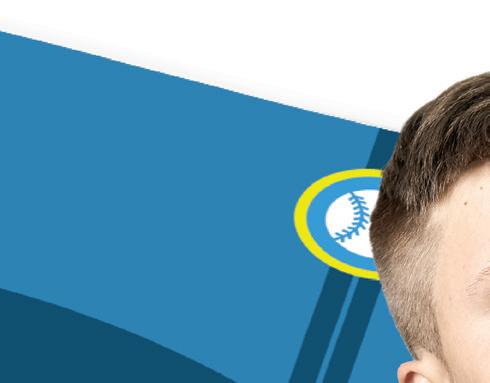

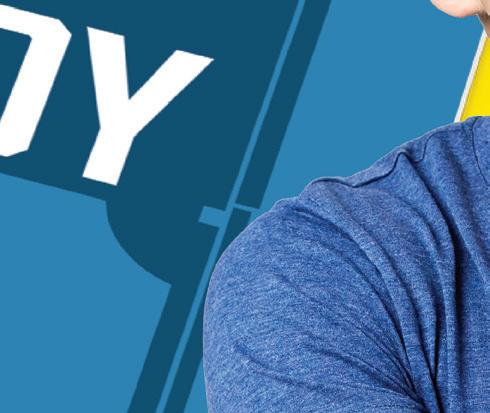









R1 U3 F6 U1 PU F4 Size: 5.5” x 8.5” Pages: 32
learn more at STORE. /Baseball *NASO member discount available. $495* DIGITAL $795 COMBO PRINT $595*




SOUND BITES



Does it ever seem like life and society are getting faster and louder?
And officials from the lowest-level games to the highest are under more scrutiny and subject to more criticism, often from people who have zero knowledge or understanding how difficult it is to be an official?
Of course, you know the answer to that question.
In the high-energy social media environment in which we live and work, it may seem to many in the officiating world the volume at every sporting event is cranked up to the max.

cellphone with a camera; everyone is connected to social media. Every call is magnified, and every decision a spectator disagrees with is reacted to as if it is the end of civilization as we know it.
On July 31, 2023, a session at the 2023 NASO Summit in Riverside, Calif., entitled “Sports Is Life With the Volume Turned Up” tackled the topic. A group of experts discussed the challenging environment officials face from lower-level contests among children to the highest level of sports.












That’s the case even in youth sports, where kids are still learning to play the game. Everyone has a

The panel included Marcia Alterman, coordinator of volleyball officials for the Big Ten, Big East, American Athletic, Conference USA, Horizon League, Mid-American and Missouri

 By Dan Ronan
By Dan Ronan
SOCIAL MEDIA HATE ISN’T WHAT WE SIGNED UP FOR.

Valley conferences; Jeff Cluff, assistant director in charge of officials for the Utah High School Activities Association; women’s college basketball referee and former WNBA official Lisa Jones; John Lozano, former president of the California Basketball Officials Association (CBOA); and Steve Shaw, college football officiating national coordinator and NCAA Football Rules Committee secretary-rules editor.













Alterman, who moderated the panel, said the goal was to try to relate what we do to our entire world and culture, which is changing so fast that we sometimes can’t keep up. She pointed out college volleyball is becoming a much bigger sport as television looks for more content,



40 | REFEREE July 2024


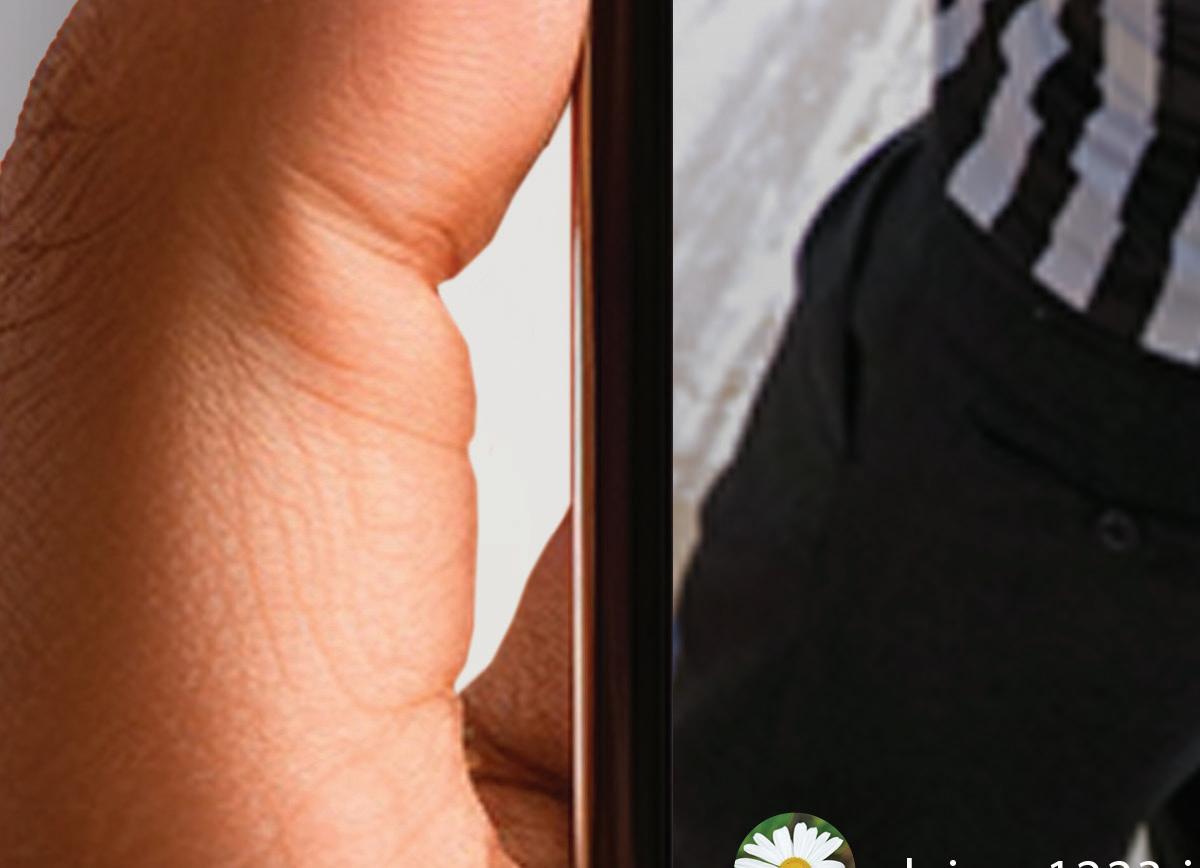
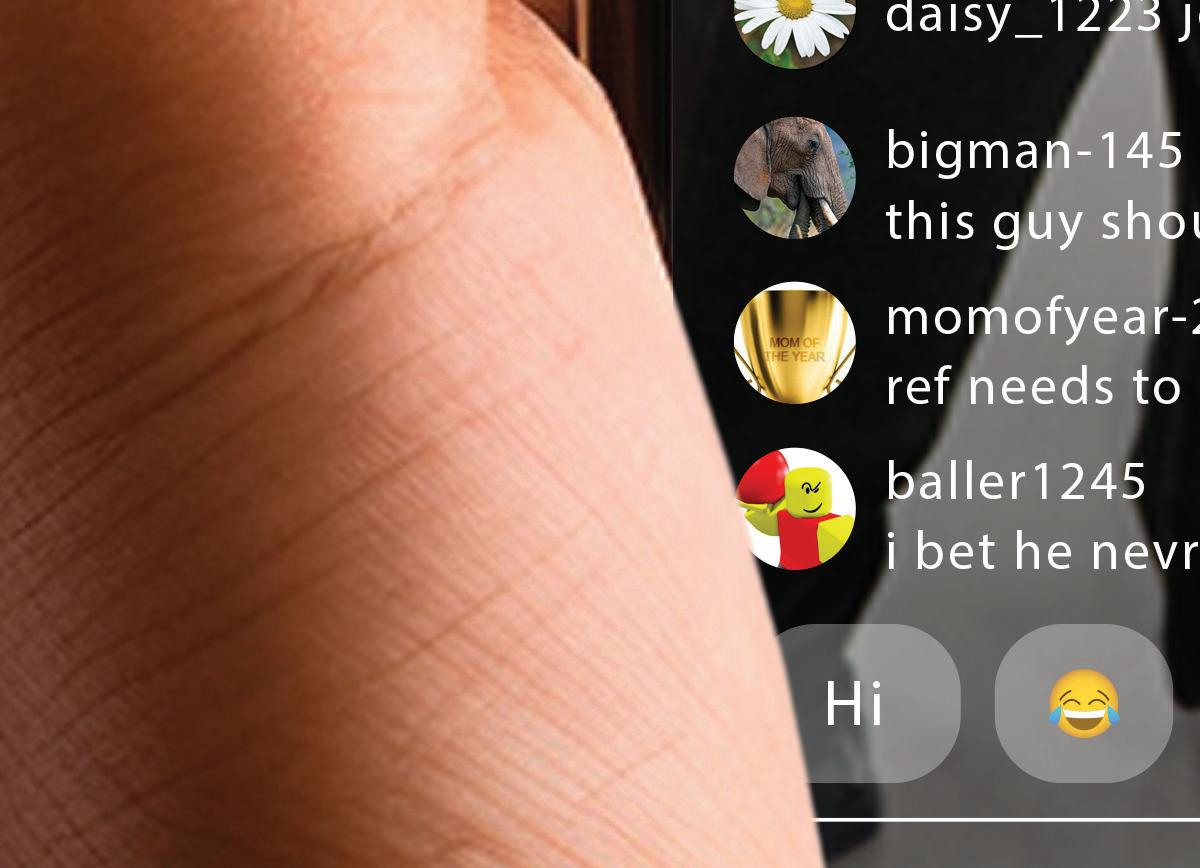
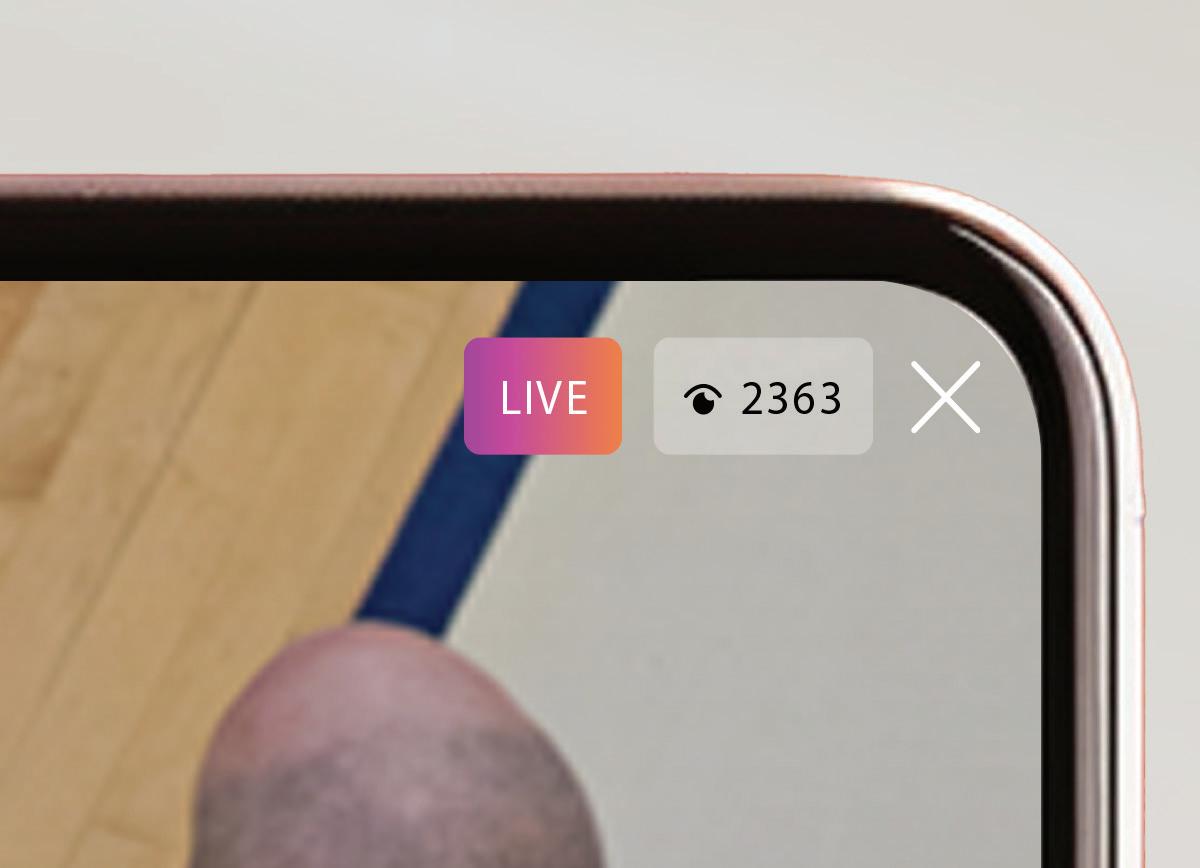

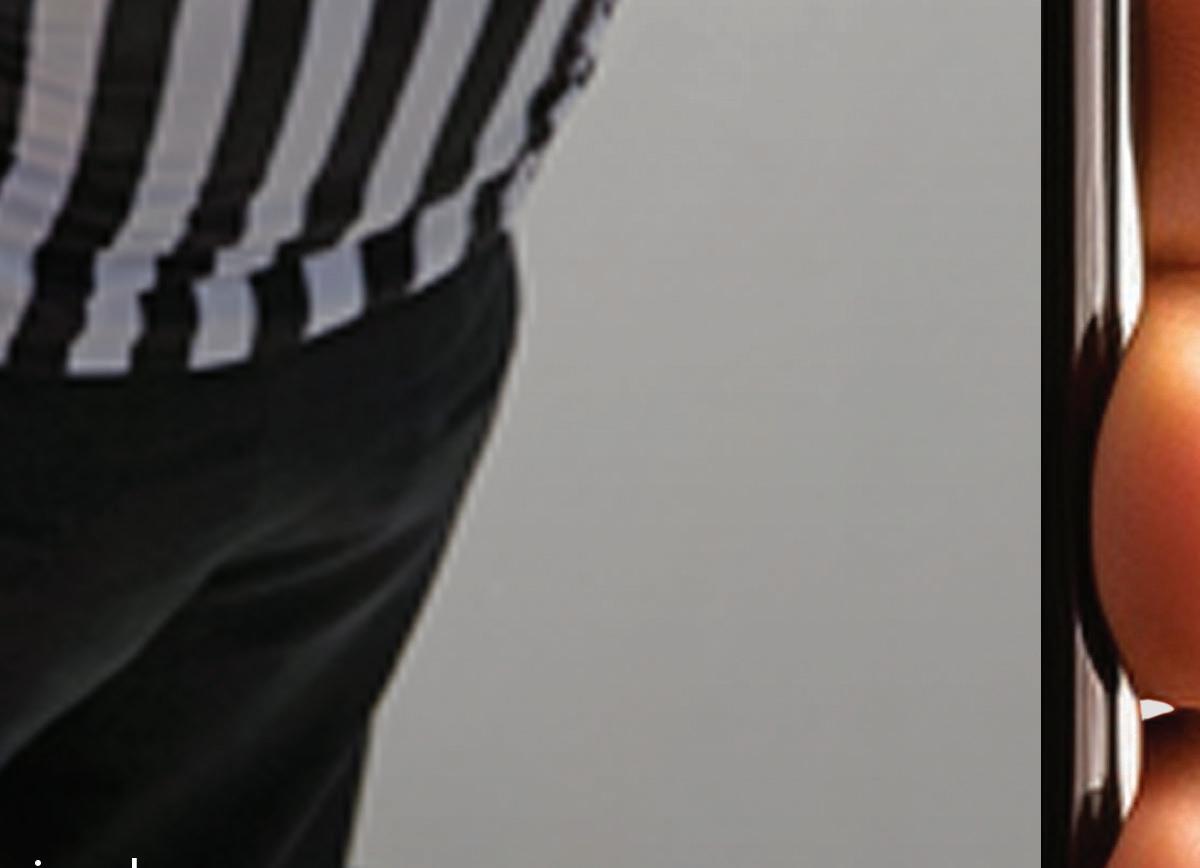
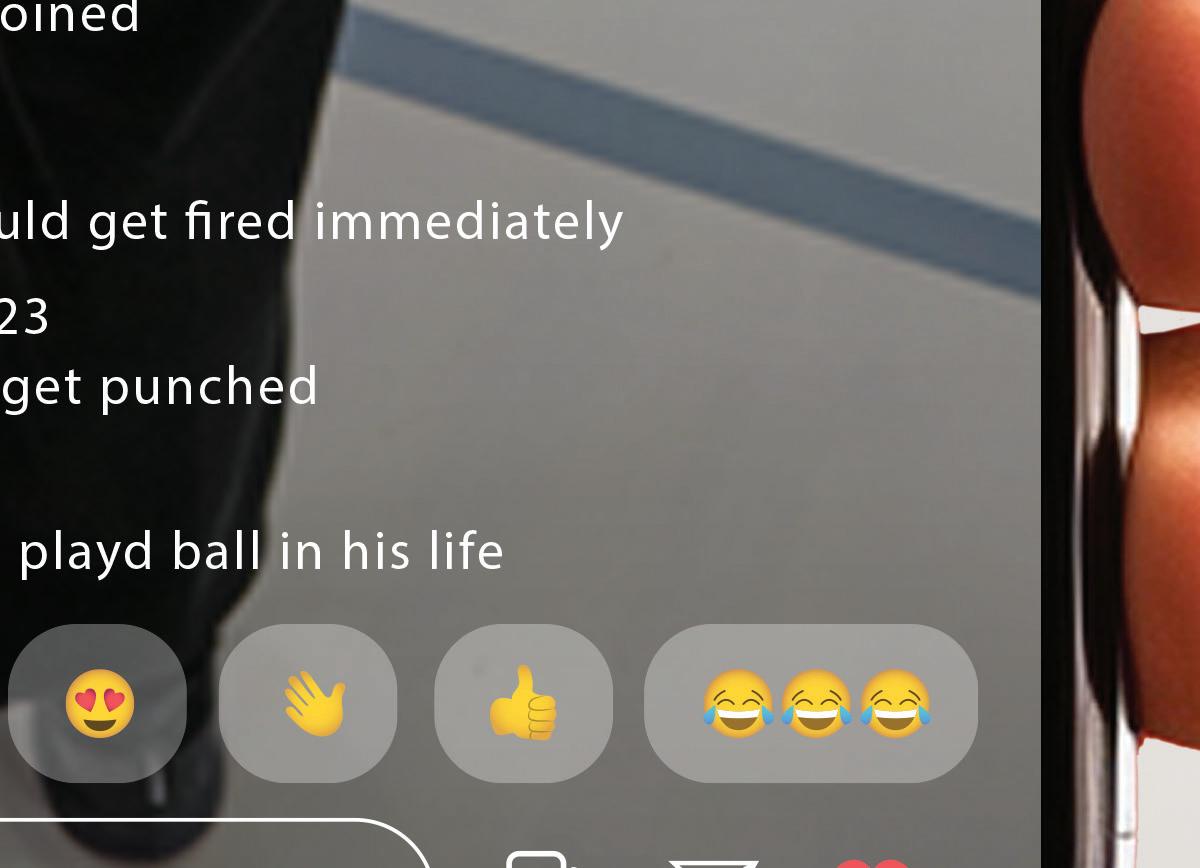






REFEREE July 2024 | 33
resulting in traditional nonrevenue sports receiving more attention.
“They’re moving our national championships (in 2023) to be on a Sunday afternoon,” Alterman said. “It will be televised on a broadcast station as opposed to just a sports station. It’s a big deal.”
Alterman cited the University of Nebraska-Lincoln, which last year blew away the previous world record for attendance at a women’s sporting event. On Aug. 30, 2023, 92,003 fans watched the Cornhuskers defeat their in-state rival, the University of Nebraska-Omaha, 3-0 at Memorial Stadium.
It’s just another example of how almost every sporting event is becoming a big deal.
For officials, the expansion of once lower-tier sports to higher media levels and the revenue that comes with it means referees and umpires will likely receive higher levels of compensation, but that means an increased level of scrutiny.
“I think officials come in and see that as an opportunity and want to make a straight line there where they don’t
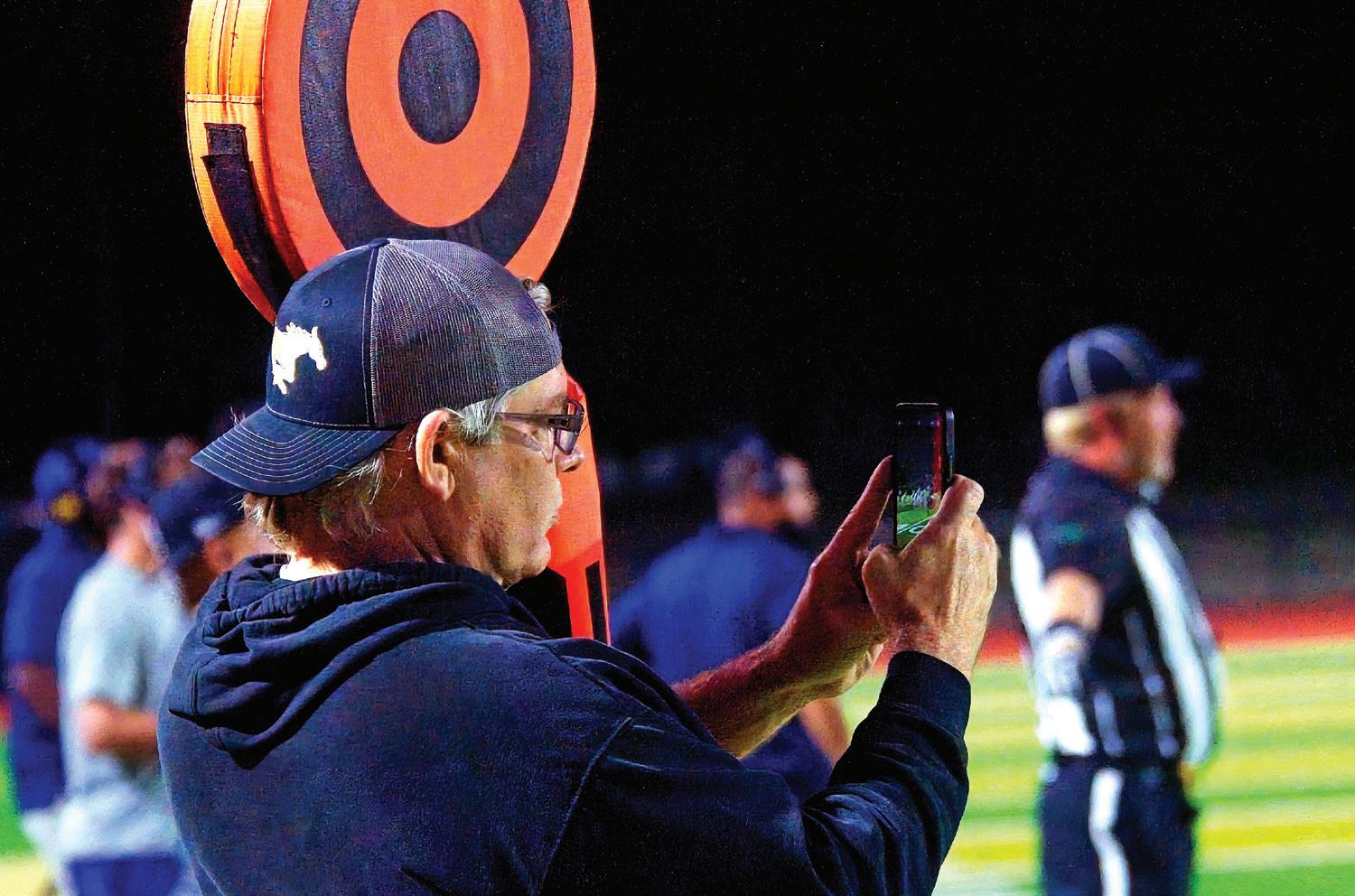
Officials
Social media accounts critical of officials have gained large followings in recent years.

necessarily understand there’s a process that may zig and zag you along the way, on your way, hopefully to achieving that,”
Jones said. “I think social media and just the money that you can make in officiating changed the culture of our game.”
Jones has experienced the highs and lows of officiating at the highest level, sometimes in the same day.
In 2023, she was one of three officials who called the NCAA women’s basketball championship game between LSU and Iowa. It was her 11th trip to the Final Four and she was joined on the court by Michol Murray and Pualani Spurlock-Welsh
Numerous media outlets ripped the officials for certain calls made during the highprofile game. An “independent and anonymous review” of the contest was highly critical of the trio, with media members repeatedly citing the review as an accurate barometer of their performance.

“Obviously, working the 2023 national championship (last) year, in terms of scrutiny and in terms of social media and all of that afterward, you have people that you can count on,” Jones said. “You have your circle that you rely on, the soft place to fall. I think my first call was to (former NBA and NCAA official) Violet Palmer.
“This championship game was a 10 on the Richter scale, and I’ve never experienced a 10,” Jones said. “I’ve had a lot of nines, but the scrutiny, the outside influences, the layers of the game that had nothing to do with the game that impacted that moment was significant. And so that was my 10. I recognize that. I realized that I did my very best. I realize that I would rather have had more positive moments after that game and certainly immediately after.
“But at the end of the day, I put it in perspective. And I know, and I believe that we can better communicate to people, that this game is not easy. It’s hard. It is difficult. It is challenging, and it will get more so. However, the flip side is that almost 10 million people watched that game, so the women’s game is growing. I’m able to look at both sides of the coin and say I didn’t impact that game in terms of who won or lost. It was incredible. I couldn’t even hear myself think. I still
42 | REFEREE July 2024
SOUND BITES
DALE GARVEY; TWITTER
now face increased scrutiny due to the prominence of video. Robert Miller, Redmond, Wash.
have chills, and nobody can take that away from me.”
In part because of the high level of social media and news coverage of the game, the NCAA took the unusual step of having Lynn Holzman, NCAA vice president for women’s basketball, say her team reviewed the accuracy of the officials and found the game was officiated slightly below average.
Self-proclaimed umpiring bloggers, such as UmpAuditor and UmpScorecards, are routinely cited by media members as experts, but these sites use statistical models and raw data from MLB’s publicfacing websites to come up with their individual game scores and in-season rankings for umpires. As was previously reported in Referee, the sites are also owned and operated by people who have never put on a striped shirt or an umpire’s mask.
So how can officials at any level deal with the pressure and sometimes unwanted attention they face anytime they step on a field or a court?
Shaw has also worked at the highest level, still the only official to work the BCS National Championship Game twice as the referee.
“It’s so polarized in our country, and there are so many things that there is no tolerance,” Shaw said. “In social media in college football, you’re still on the field and your play is being circulated in social media. As leaders, we have to govern that process. I remember a coach saying if you worry too much about what they say in the stands, you’ll be in the stands with them. So we’ve got to come up with ways from our standpoint as leaders to handle that for the officials and not leave them hanging out on that.”
Lozano said fan behavior is being influenced by social media and, most of the time,
not in a good way, at all levels of sports.
“The tolerance level is just so much lower than it used to be,” Lozano said. “I’m in the stands a lot, evaluating and observing officials. And the parents, the young siblings, something that is actually called correctly, they have a narrow vision because their player is being penalized. I know we’re making a better effort of trying to educate in our school systems — the administrators, the parents and even the players — on sportsmanship. But I know those kids have been playing since they were four. And by the time they get to be 16 and 17, with all the travel teams, the club teams, they think that it’s OK just to yell and say whatever they want. No tolerance at all.”
“The veteran coaches take some and give some, and they understand that it will be on both sides,” Cluff said. “But you have people nowadays who just kind of lose their minds. I think the NFHS has done a nice job being in the NFHS space with bad behavior and all the media platforms they’ve gone to and tried to market the change and the environment. And in state association offices, it’s one of the top subjects we’re talking about. How do we bench that bad behavior? How do we curb what’s going on? How can we educate people more about the processes of educating them about what an official is and what they’re doing, where they’re coming from, and their growth experience down that road?”
Now more than ever, veteran officials and supervisors say what’s needed are exceptional game management and people skills so officials can recognize potential trouble as it begins festering and then taking steps to stop it, politely and firmly, before it gets out of control.
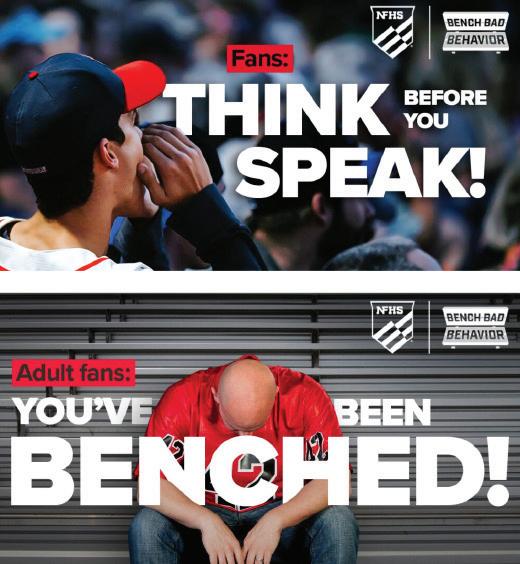
“We always talk about you’ve got to know the rules, and you’ve got to know mechanics, and it’s all about getting the call right,” Shaw said. “But honestly, the biggest thing from an official’s standpoint is game management, and you’re doing that, you’re learning that game management in your day job that will help you on the court or the field. I think game management is so important. We always talk about how you can take an official in any sport; if they’ve got great game management skills, you can move them around.”
Lozano has been known as a “rules specialist” his entire career in California, but he acknowledged exceptional people skills are needed now more than ever in officiating.
“Working with young officials, laying out the landscape of the officiating world — I can remember coming in, and I knew I wanted to referee,” Lozano said. “I knew there were rules, but I didn’t understand what was involved with that. Expectations can be better understood if they understand what it takes to learn to do this and then the path to improve and get better games.”
Cluff says the same technology that fuels social media, the easy access to video, is also being used to
REFEREE July 2024 | 43
The NFHS spearheaded the “Bench Bad Behavior” initiative to crack down on unruly fans.
SOUND BITES
make officials better at all levels. He believes if used properly, video can supercharge a young official’s career, especially if they can use what they see, apply those lessons and improve their on-field performance.
“I deal with a lot of brandnew officials and how do we get them trained, and how do we get them in an environment where they can succeed and develop the traits of communication and game management?” Cluff said. “First, we are ultra-focused and laser-focused on knowing the rules. Mechanically, where are you standing, where do we divide those two, and how can we relate those two subjects to something that’s in our personal life, maybe in your job or your career? How do we find out who the individual is and try to individualize that learning process for them so they can learn and succeed while they’re getting better?”
“At least when working with young officials nowadays, so much video is available just for training. They’ll bring their phone and say, ‘Will you videotape me while I’m working?’” Lozano said. “The opportunity is there. And then to be able to sit with someone who can walk through it with you, I think, is just tremendous in helping develop our officials. So they’re ready and they’re accustomed to that. And I think as an organization, we used to have to budget for cameras and tape and somebody to videotape. Those roadblocks I don’t think are there like before.”
Still, Shaw said he believes the pressure from social media is sometimes driving away young, promising officials.
“Think of a middle school game — that’s the leastexperienced official,” he said. “And now you have people berating them. We need people to work 11 Final Fours to be
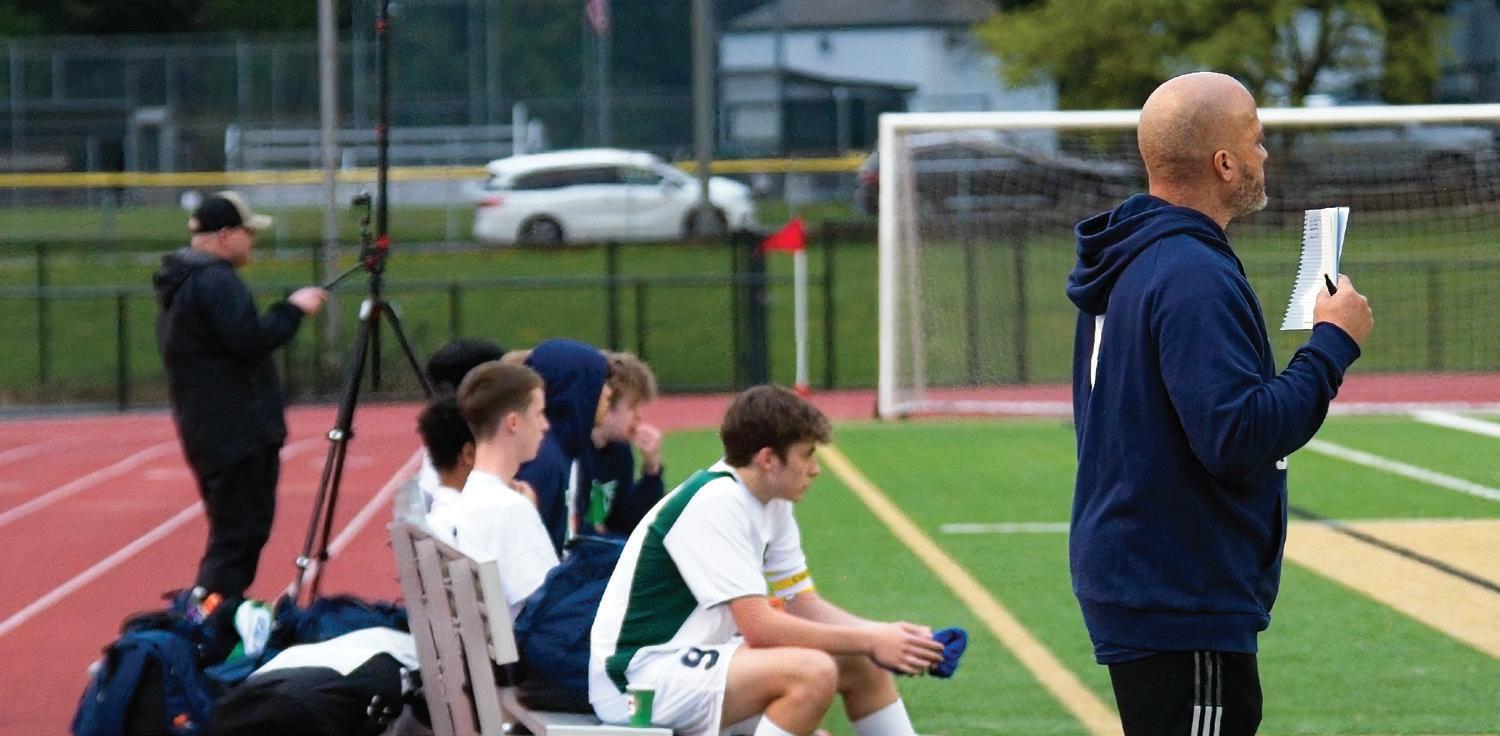
If you’re officiating a game in this day and age, you can count on at least one camera being pointed in your direction.
really working that middle school game to handle that kind of stuff, but it’s our leastexperienced officials. And now we’re wondering why they don’t stay, or leave us. I think that’s something we’ve all got to look at and address. I think there’s such a great focus on recruitment now, but it’s that retention effort that we really must work on.”
With video being so readily available, Cluff said that means an official’s job is harder.
“Being in the state office, I get a lot of video sent to me, and it’s the same message,” he said. “‘The officials missed this, the officials missed that, you need to hold them accountable.’ Whether you’re a first-year official or you’re a 40-year veteran of officiating, we’re getting videos about their performance. And the first place it’s going is social media. And then, if they’re mad enough, they take it to the state office because they want somebody to hold them accountable.
“So how do we navigate that? We address it head on. Talk about the growth experience that the officials have. Talk about the amateur status of officiating. Talk about how many times they went to work all day, they worked their construction job all day, and now they’re coming to work. They’re on their 14th hour of work today, and they’re trying to do the best they can. And how do we navigate that space while still wanting perfection but also addressing the fact that we’re in a learning environment?”
No matter what level you officiate, veteran referees such as Jones say you have to have a plan to deal with the possibility of something happening and
becoming the topic of a conversation on social media platforms.
“We’re no spring chickens up here, so it’s been a process,” Jones said. “And there are things that I do to prepare for a game on game day. I prepare for our pregame with the crew I have my own pregame for myself in preparation for the game, particularly which I’m about to (be the) referee. But I prepare that I’m going to do my very best every time. I know that I’ve put the work in, that I know that I’ve arrived at that moment because of the work that I’ve done. I don’t ever take any games off. So this game is just like every other game. But the scrutiny, the outside noise, is louder. But again, I’ve been through this a few times.”
“One of the things I heard in that, and I think as leaders because there’s always a state championship or a national championship or the Super Bowl or whatever it is and part of what we heard here — stick to routine, OK? Stay with what got you there, right?” Shaw said. “We’re not looking for a super person, superwoman, a superman in that game. Do what you’ve done. And sometimes, you feel that officials want to be a super person in that game, and they need to work the first play and work the second play and do what they’ve done and stick to the routine.”
Dan Ronan is a veteran Washington, D.C. journalist and a retired college baseball umpire and high school and small-college basketball referee.
44 | REFEREE July 2024
DALE GARVEY


A Football Pregame For Every Situation
One pregame does not fit all. Whether you have a rookie crew, seasoned veterans, are working a mismatch or a title game, keep this handy guide in your bag to be game-ready every assignment. Easy outlines and quick discussion starters will guide you to the best pregame choice every time.
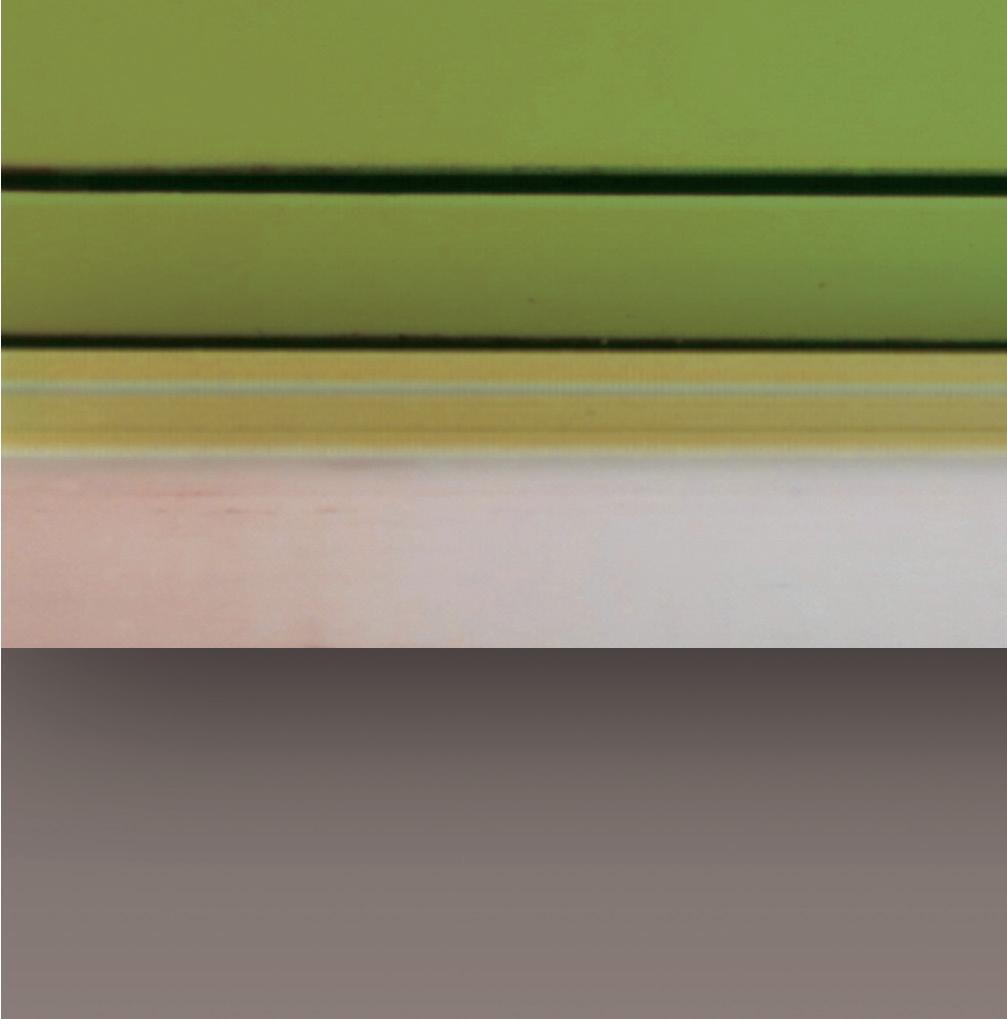

Match Your Pregame To the Game You’ve Got
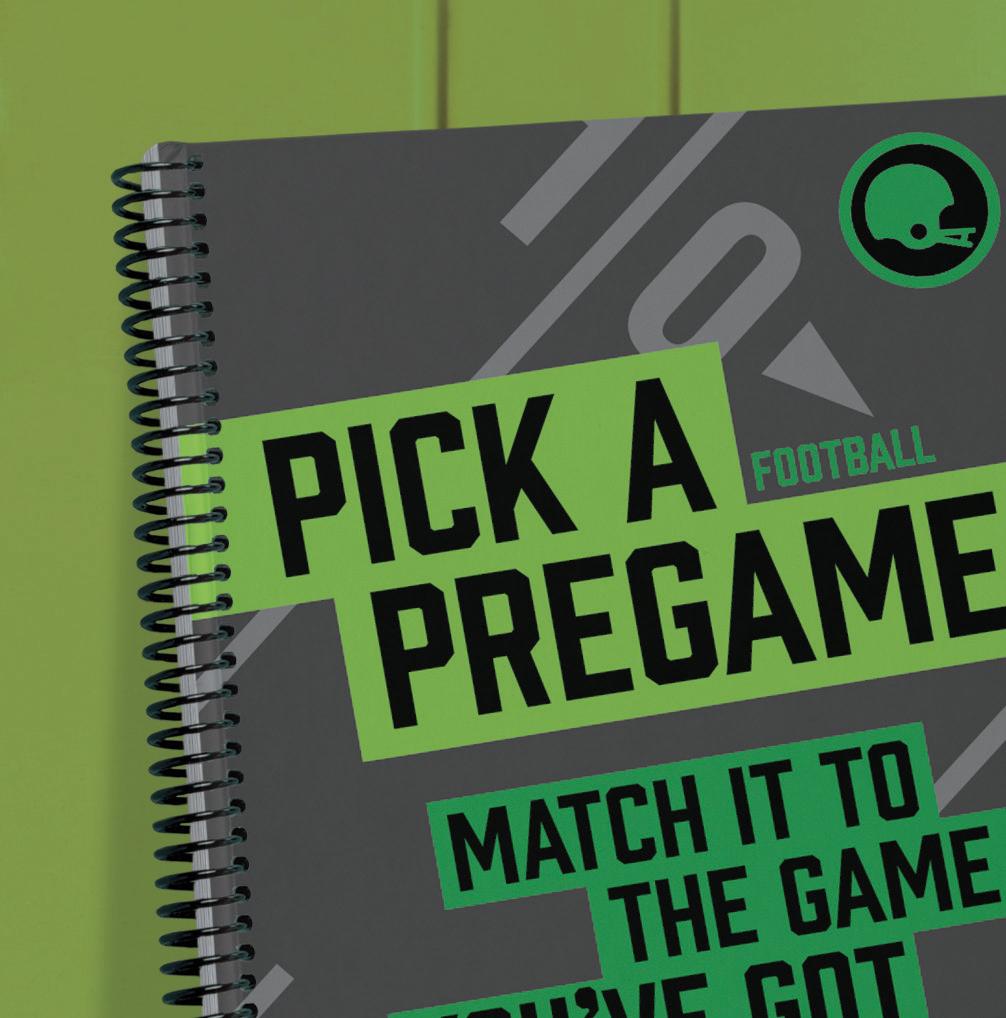
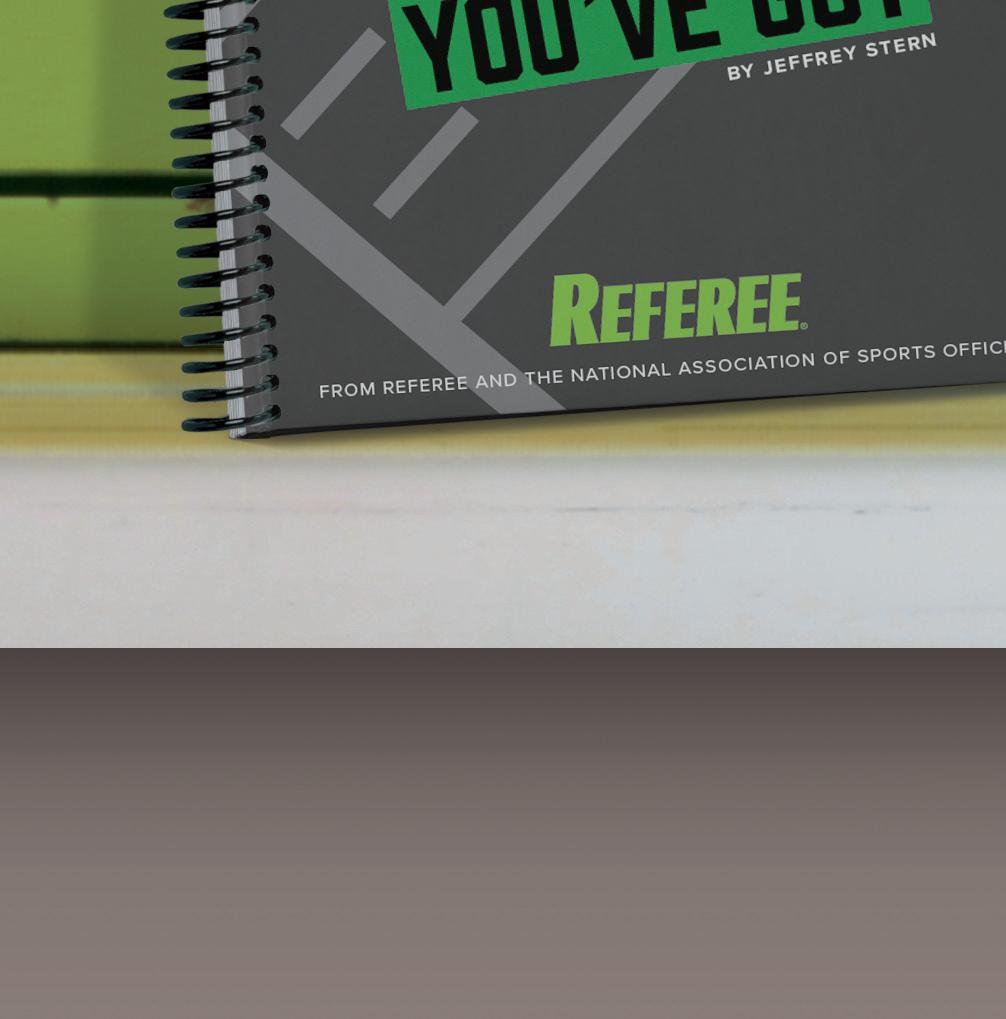



learn more at STORE. /FOOTBALL
forNEW 2024
NASO MEMBER PRICE: $12.76 SIZE: 5.5”X8.5” PAGES: 60
$1595 ONLY
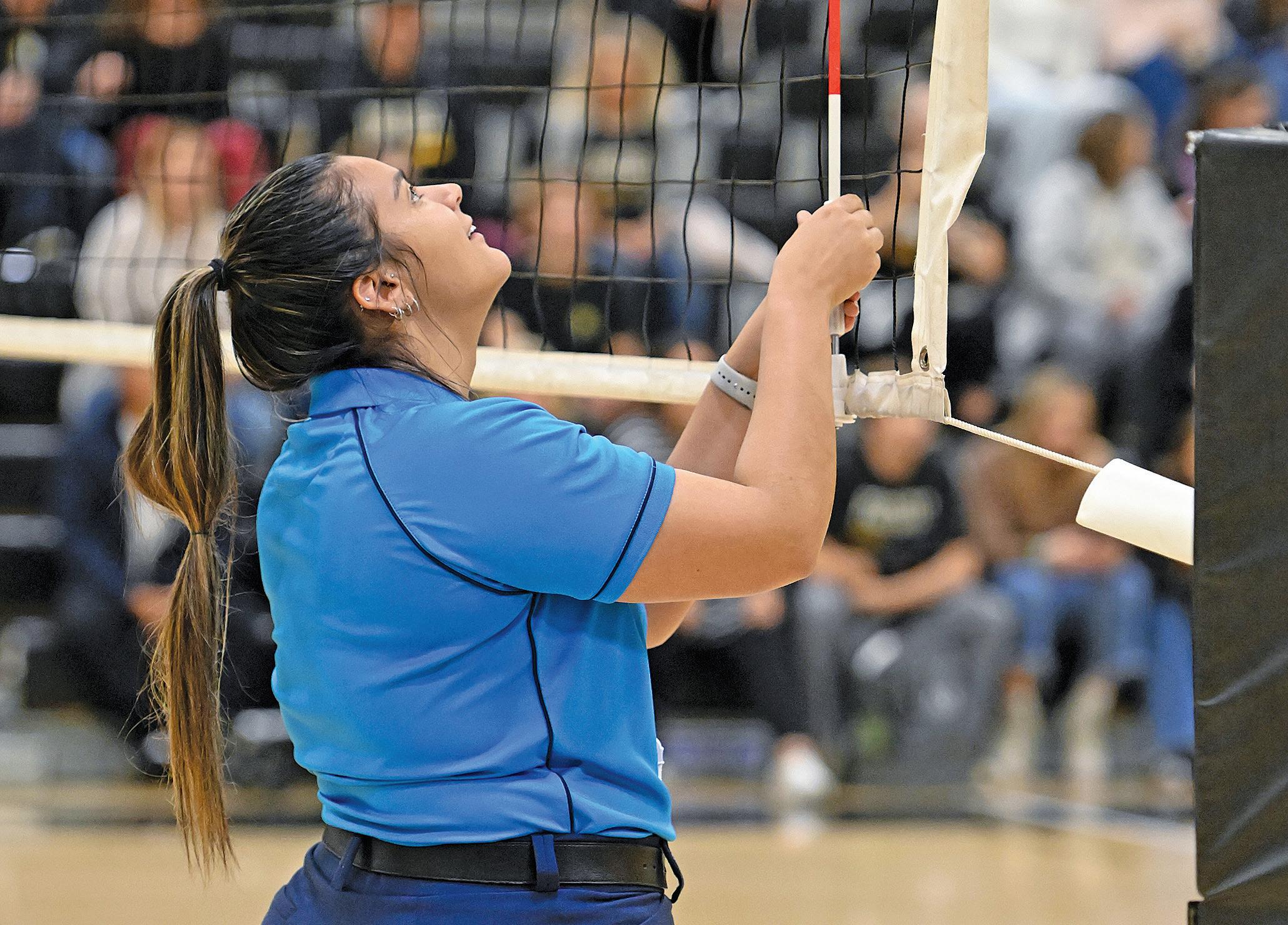
COURTSIDE TO SHOWTIME
Rituals to Ready for a Match
By Bill Thornburgh
Let’s face it, we can be a strange bunch. We all know referees who have rituals as they prepare for the season (e.g., reading the rulebook or buying new white shoes), rituals as they prepare for travel to matches (e.g., ironing everything or cleaning whistles), rituals in the locker room (e.g., stretching or listening to music), and rituals such as they eat before or after a match (e.g., Jimmy Johns or Waffle House).
Referees play a crucial role in ensuring fair play, safety and court management as every match could potentially present a new challenge. This demands not only rules knowledge and technical expertise, but also attention to detail. Once we arrive courtside we should have, or need to develop, a routine. Although our arrival time varies based on conferences or the level we officiate, a checklist needs to be completed from the moment we step onto the court until the first contact of service.
Here’s a list of things you may want to incorporate into your oncourt prematch preparation, which could become a ritual leading up to showtime.
1.Court Inspection:
Upon arrival on court, there are a number of things that need to be done, but the order in which you do them is up to you.
Inspect the court surroundings. •Are there any objects over or near the court that require a ground
VOLLEYBALL RULES, MECHANICS, PHILOSOPHY EDITOR: BRAD TITTRINGTON btittrington@referee.com 46 | REFEREE July 2024
HESTON QUAN
One of the prematch rituals referees should adopt is checking the net and support systems to make sure everything is in order. Amanda Felipe, Huntington Beach, Calif., takes a few moments to tighten and align the antenna prior to the match.
rule (e.g., basketball goals, low ceilings)?
•Does the court have all the necessary lines and are they properly marked?
•Are there any potentially dangerous things noticed (e.g., court drop offs, unusual bleachers)?
Check the equipment.
•Is the net height correct and properly tensioned?
•Are the antennas in the correct position and located on opposite sides of the net?
•Are the game balls inflated to the correct specifications?
•Are there towels?
2.Communication:
Refereeing is a team effort, and effective communication among the officiating team and others is paramount for success.
Before the match (both in the locker room and while courtside), the referees should have the following prematch communication:
•What do you do when …?
•How will you help if …?
•What do you do if you want a sanction?
Meet with the line judges.
•Introductions
•Gain knowledge of experience and skill level
•Discuss interesting scenarios
•Stress the importance of eye contact
•Depending on the level of play, encourage emphasis on being a “touch judge” (meaning stay engaged and focused on touches as opposed to quickly shifting eyes to the lines)
Talk to your scorers.
•Introductions
•Build a cohesive officiating team
•Find out how they communicate when ready
•Ask what they need from us or how we can help them
Interact with the coaches.
•Introductions
•Clarify any rule changes or Challenge Review System (CRS) questions
•Go over any special ground rules of the facility
•Make sure they are aware of any recognitions or special events
Others to meet and things to consider:
•Who is the event manager and where do they sit during the match?
•Who is the CRS tech? How much experience do they have? How many cameras are there?
•Who is in charge of music?
•Who is the announcer and what is the last thing that will be said during introductions?
•Who is in charge of the cheerleaders or band?
•Where is the stats team (in case you need them)?
3.Mental Preparation:
As the countdown to first serve continues, referees must mentally prepare themselves for the match. This could involve:
• Acknowledge your feelings recognizing if you are nervous or have fear;
• Use techniques to control your breathing — this will calm the nerves;
• Develop cue words or phrases — this may contribute to a successful performance;
• Use visualizing techniques (or imagery) — see yourself making the right decisions;
• Relax — gather your thoughts and focus. Remember, your assigner put you there for a reason.
In conclusion, the period leading up to the start of a volleyball match is a critical phase for referees, demanding preparation and clear communication. By completing these prematch rituals and responsibilities, referees can lay the foundation for a more positive experience and successful match for the officiating team, players, coaches and even the fans. Use this time wisely and generate a routine. That routine will help you ease the nerves and keep you busy so you don’t have time to be nervous.
Bill Thornburgh, Shelbyville, Ky., is a National USAV and PAVO referee, as well as a FIVB International referee. He works in the Big Ten, Atlantic Coast, Southeastern and other D-I conferences, works the Pro Volleyball Federation and is an assistant professor at Eastern Kentucky University.
BY THE NUMBERS
69.04%
The percentage of volleyball officials who said they would want their children to become officials, according to the 2023 NASO National Officiating Survey, powered by Referee.com.

QUICKTIP
Use your wristwatch timer to time prematch warmups and timeouts in conjunction with the scoreboard clock. If power to the clock is interrupted or accidentally shut off during the time the teams are warming up, you will have a backup timer to keep everything running on schedule. Cords often become unplugged and failure to have a backup timer could give one team an unfair advantage and cause warmups to last longer than they should.
THEY SAID IT
“If you sit in the bleachers and if you watch how fans react to certain situations throughout the match or the game, whatever game you are sitting and watching, you go, ‘Who in their right mind would sign up for that?’”
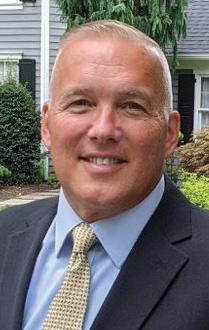
— Wade DuBois, Western New England Board of Volleyball Officials chair, on what has created the shortage of officials after an official in western Massachusetts ended a boys’ JV match early due to the conduct of a member of one of the teams and citing safety concerns.
SOURCE: WESTERN MASS NEWS
REFEREE July 2024 | 47
SHUTTERSTOCK, COURTESY OF WADE DUBOIS
TEST YOURSELF
In each of the following you are given a situation and possible answer(s). You are to decide which answer(s) are correct for NFHS, NCAA or USAV rules, which might vary. Solutions: p. 81.
1. Team A’s libero moves into position to play a second team contact. One foot is in the front zone and the other foot is behind the attack line. Just before contacting the ball, the libero lifts the foot that was in the front zone, and with one foot still in contact with the floor behind the attack line, makes an overhand finger pass (“setting” action) to a teammate. The teammate attacks the ball, which is entirely higher than the top of the net. The ball lands on team B’s court.
a. That is a fault by team A and team B wins the rally.
b. Legal play and no fault has occurred. Team A wins the rally.
2. At the end of a rally, A1 replaces the libero. The scorer immediately notifies the second referee that A2 should have returned to the court to replace the libero instead of A1. What is the correct action for the second referee?
a. Instruct the scorer to record a substitution for the team, A1 for A2.
b. Immediately notify the team of the illegal replacement. If A2 quickly enters to replace A1, no additional sanction or penalty is necessary.
c. Wait until the contact of the serve, and then whistle and signal a position fault by that team.
d. Immediately notify the team of the illegal replacement. Require A2 to enter the court and A1 to return to the bench, then assess an unnecessary delay/delay sanction to the team.
3. Play is stopped for injured A1. At the end of the 30-second evaluation period, which of the following options are available to the coach to address the injury situation?
a. Request a substitution for A1.
b. Request a team timeout to allow A1 additional time to recover.
c. Complete a legal libero replacement for A1.
d. Award a point to team B to allow A1 additional time to recover if team A does not have a timeout remaining.
Beating Back Boorish Behavior
By Joe Alfonse
At the end of the season — when matches become more intense regardless of team records — what is your threshold for fan behavior? Is there a difference in what is acceptable for home team and away team behavior? When do you feel you need to step in and enforce the fan behavior expectations read (hopefully) before each game? In less than one week, I was afforded two great examples of what we dread having to do as referees and then what we hope would happen during play.
Two teams with similar records vying for higher playoff seeding competed in a hard-fought, five-set match. Before the match began, one of the home team’s staff identified themselves and notified the referees their job was to handle any crowd issues. Before the starting players were introduced, a statement was read by the home team outlining student conduct and expectations during the match and the consequences of not complying with the expected behaviors.
As the match progressed, a group of students entered the building waiting to use the gym after the match ended. The students began dribbling basketballs and horsing around just outside the court. At the next whistle, the facility manager was asked to have the students refrain from their shenanigans. The behavior stopped for a short while as the students moved into the stands to wait for the match to end. As the match continued these same students probably became bored and began to try to distract the away team each time they served.
The first referee motioned to the second referee to have the facility manager deal with the students once again at the same time as the away team coach was sending her captain over to the first referee to complain
about the behavior. The match briefly stopped as the facility manager made their way over to the stands to more closely supervise the rowdy students. Once again, the match continued, but only a couple of points later one or two students renewed their efforts of distracting the away team by making random noises and gestures as they attempted to play. At the next whistle, the first referee turned around and addressed both the students and the facility manager to remind them their words and actions should be intended to support their own team and applaud great play all around. The students were warned they would be removed if the behavior continued. This warning was given in all fairness due to the students not being onsite when the original behavior statement was read.
It wouldn’t be much of a story if the behavior had stopped upon hearing the clear warning. Needless to say, near the end of the fourth set during a long rally, a few of the students once again did their best and succeeded in distracting one of the opposing players. Play was stopped, a replay was called and the site manager was directed to remove the students. The site manager hesitated to fulfill the first referee’s directive because the manager wasn’t sure which students were at fault. The first referee stated the match would not continue until the fans were removed. Grudgingly, the site manager complied to the applause of what most likely were the away team’s fans.
To add insult to injury, one of the home team adult spectators, sitting directly behind the referee’s stand, felt it their duty to stand up and loudly protest the decision to remove the unruly students because their behavior wasn’t “that bad.” The adult was asked to leave too and the match continued uninterrupted after the offenders left the gym.

48 | REFEREE July 2024
VOLLEYBALL HESTON QUAN
SURELY YOU JOUST



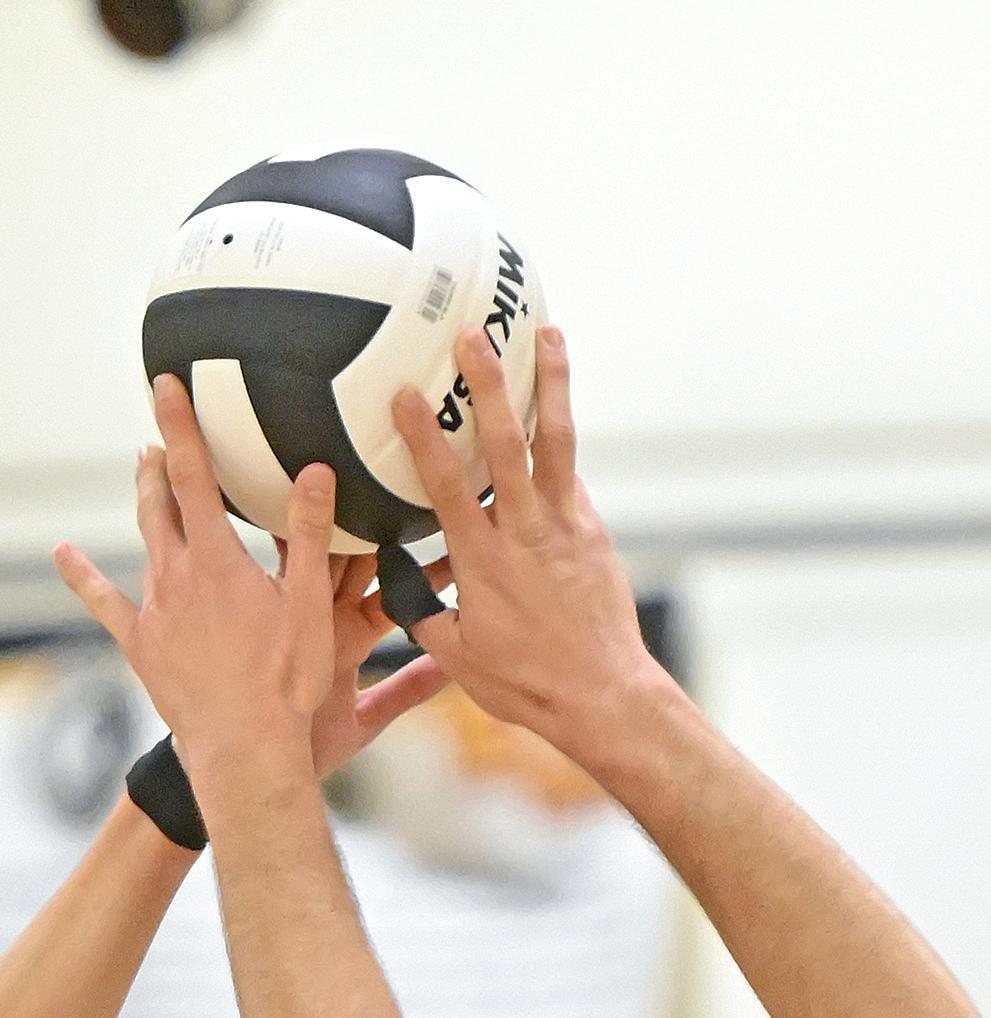
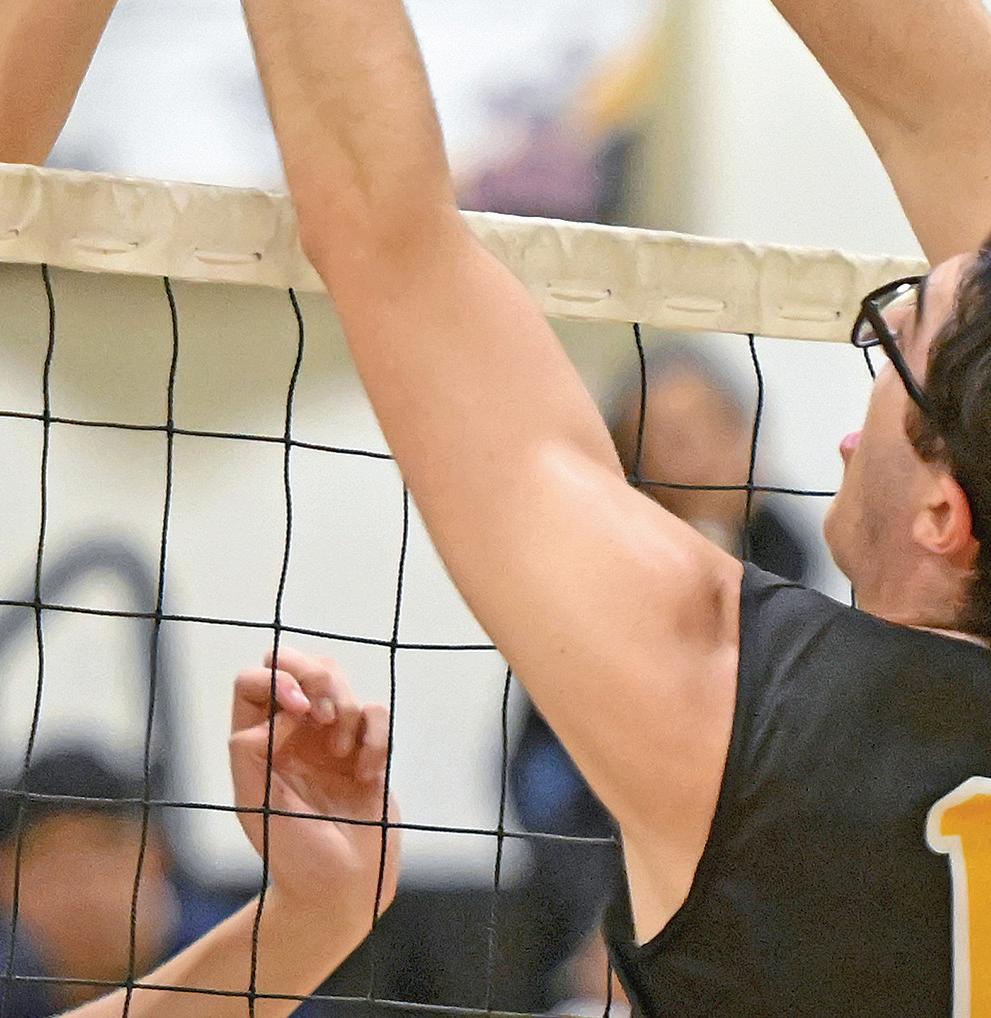
Two players simultaneously contacting the ball and causing it to come to rest, as seen in this photo, doesn’t happen in every match, but often enough, especially at higher levels of play. It’s important for referees to know the rules to properly rule on what happens next after this contact. Let’s first assume the contact by both players in this scenario is legal.
If after this simultaneous contact the ball lands out of bounds, it is considered to have last been contacted by the player on the opposite side of the net from which the ball falls (NFHS 9-4-6d; NCAA 14.3.2.2; USAV 9.1.2.2).
If the ball remains in play, the team receiving the ball is entitled to three more hits and the player involved in the simultaneous contact of the ball is allowed to make the first contact.
1 2 3


If the ball rolls along the net and hits an antenna, it is considered a double fault (meaning both players are equally responsible for the fault) and the rally is replayed.
It is important on these types of plays for the second referee to maintain focus at the net to ensure neither player makes contact with the net. This includes on the way up, during contact and then on the way down. Because of the nature of the contact, this type of play can easily lead to a net fault and it is important to know which player contacted the net.
For first referees, it is important to slow down, read the play and allow the play to continue before inadvertently blowing a whistle. This contact sometimes looks strange as the ball comes to rest and may appear to be prolonged contact. It is important to understand it is legal in this type of playing action and not be quick to inadvertently rule incorrectly on this play.


REFEREE July 2024 | 49
CASEPLAYS
Jewelry
Play: Prior to the first set as the starting players are waiting for the second referee to check the lineups, the second referee notices a team A player wearing (a)small post earrings, or (b) an extremely long necklace with charms attached. Ruling: In all codes, (a) is legal. In all codes, (b) would be illegal and the necklace would need to be removed. NFHS rules allow for small, secured jewelry (stud or post), but does not allow any jewelry below the chin (4-1-7). NCAA rules allow small, snugfitting nose rings and ear cuffs, in addition to studs and posts; however, no jewelry may be worn below the chin (7.2.2). USAV rules allow all jewelry, provided its nature does not present a concern for safety, and the rules specifically disallow extremely long necklaces, necklaces with large medallions and large hoop earrings (4.5.1).
Wrong Team Serves
Play: Team A is leading, 11-8, in the deciding set. A ball is hit near the line by team B. The referee initially signals the ball out and awards a point to team A.The first referee then realizes one of the line judges is giving a touch signal. The first referee blows the whistle, changes the decision and awards a point to team B. However, in the confusion, A1 is back to serve and is holding the ball. The first referee accidentally signals for team A to serve. A1 serves the ball and it lands untouched on team B’s side of the court. Team B’s coach realizes the mistake and asks the second referee to confer with the first referee as team B should have been serving. Ruling: Assuming that at least one official correctly recalls the facts, and realizes that team A should not have been serving, all rules codes would result in the same ruling. The score would revert to 11-9, and team B would rotate and serve next (NFHS 6-4 Pen. 2a; NCAA 13.2.3.2; USAV 7.7.2).
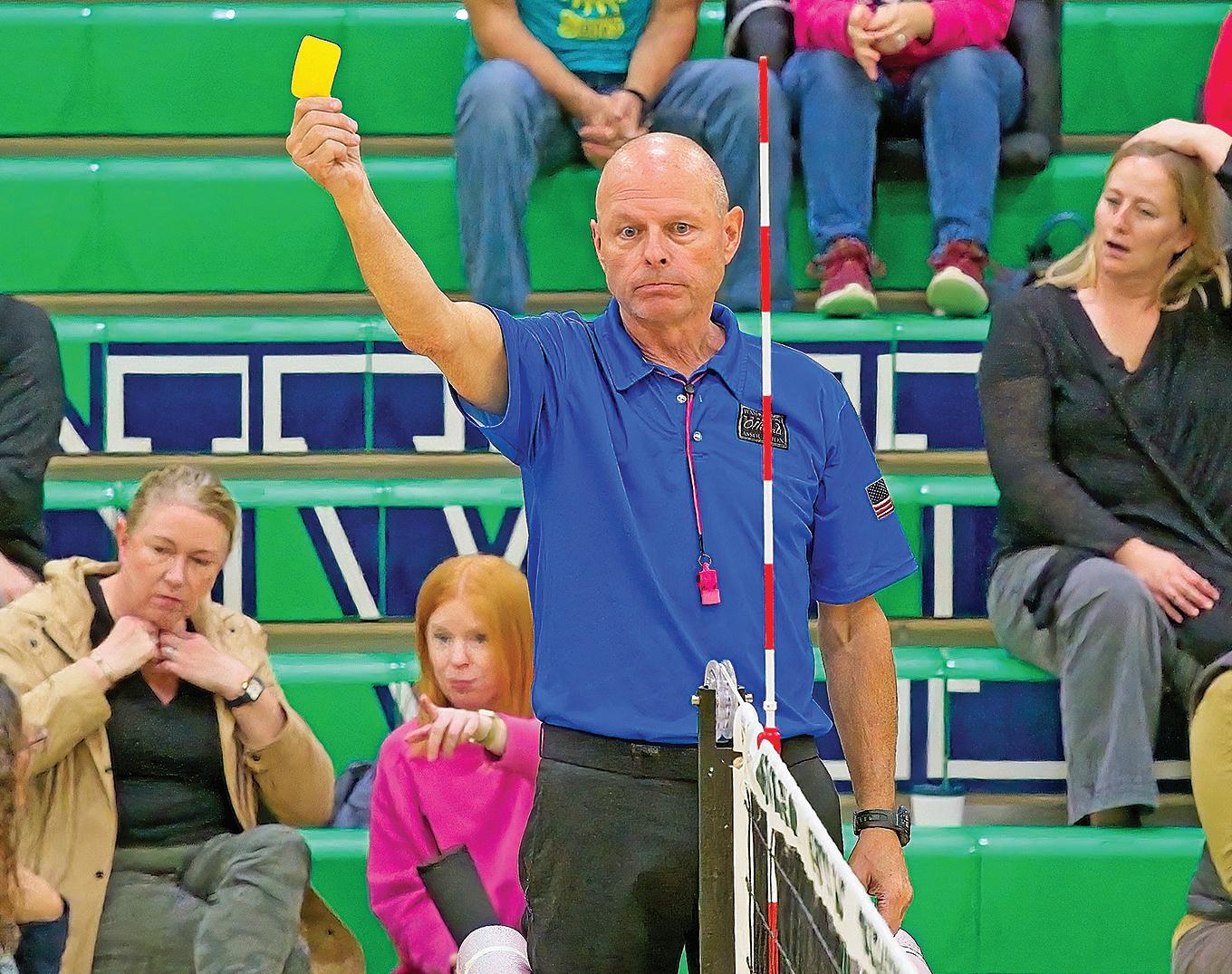
In some matches, it may be necessary to issue warnings and penalties to teams for the behavior of their fans. First referees should notify site administrators to handle unruly behavior, but warnings and penalties may be needed if the behavior doesn’t cease.
Conversely, two days later in a different conference in a match between two teams with only three losses between them, the away team fans acted up in the first set. Just as in the first example, before the match started, the home team’s athletic director introduced themselves to the referees and said based on the crowd expected and the implications of playoff seeding depending on who won, they would be in attendance to handle any crowd issues during the match. As before, spectator expectations were read to the crowd prior to announcing starting lineups.
Not even 10 points into the match, in a loud and raucous gym, some of the away team’s fans started screaming directly at the home team’s server. The first referee whistled a stoppage in play and before the second referee could turn around, the athletic director was already making a beeline for the stands. The athletic director and another staff member quickly and quietly dealt with the students while play resumed. They stayed for the rest of the four-set
match, bracketing the away team fans and making their presence known without having to say another word. Fortunately, the home team’s fans had teaching staff already sitting among them. This provided an atmosphere for the remainder of the match for the entire crowd to loudly cheer every dig, kill and service ace.
In both situations, it’s difficult to know when and how to set limits on fan behavior. Host organizations view conduct decidedly differently when it comes to home and away behaviors. Knowing when to interject yourself as a referee is an unenviable task and can only come with experience and confidence in game management skills. A thought to consider; even with each institution’s staff introducing themselves and their functions before the matches, would you consider issuing warnings or cards to the teams?
Joe Alfonse, Woburn, Mass., is a high school, college and USAV referee, line judge and scorer. He is a former college softball umpire and high school basketball referee.
50 | REFEREE July 2024 VOLLEYBALL
DALE GARVEY
Duane Sanchez, Kenmore, Wash.












VISIONINACTION



Georgia on My Mind



One of the great things about attending the annual Sports Officiating Summit presented by NASO is the chance to experience a different city every year. Recent Summits have been hosted in such places as New Orleans, Denver and Riverside, Calif.


The Heart of the O ciating Industry is in Atlanta This Summer

This year the center of the officiating universe will be in Atlanta July 28-30 at the Renaissance Atlanta Waverly Hotel & Convention Center. Attendees will experience three days filled with educational and inspirational sessions from renowned names in the officiating industry.
The Waverly is located in the Cumberland community of Atlanta, just across the interstate from Truist Park, home of the Atlanta Braves, and is about 10 miles northwest of downtown Atlanta. The area surrounding Truist is booming with dining, entertainment and cultural attractions for you to explore, all within walking distance of the Summit.
When attendees aren’t soaking up the best thinking on the most urgent topics in officiating, there are plenty of things to do in and around Atlanta, such as:
Southern dining and nightlife –There’s no shortage of dining options in Cumberland. The Waverly offers Tosca Blu bar and lounge, while C. Ellet’s Steakhouse and Stoney River Steakhouse are both within walking distance. If you’re looking for a drink after a long day, the Park Bench bar and ASW Distillery are nearby watering holes.
Battery buzz – The Braves aren’t hosting home games during the Summit, but these days Truist Park is a hot spot regardless of whether its team is home or away. Check out Truist Park’s Battery, a dedicated entertainment district surrounding the ballpark, offering dining, shopping, games, live music and more.
Arts and culture – Experience some live theatre or film at a local Atlanta venue. The Cobb Energy Performing Arts Centre, just a 10-minute walk from the Waverly, is home to the Atlanta Opera and Atlanta Ballet.
Outdoor activities – You’ll want to visit the Chattahoochee River National Recreation Area, located just northeast of Waverly. Cochran Shoals is the most popular unit of the park, featuring a three-mile trail perfect for walking, jogging and biking. And for golfers, there are several courses in the immediate area, including Fox Creek Golf Course, City Club Marietta and Cross Creek Golf Club.
Leaders of state high school officiating programs, local association officers, supervisors, coordinators, assigners, conference administrators, and sports officials at all levels from around the country and the world benefit from the Sports Officiating Summit. Every year, nearly 500 leaders and decision-makers attend the summit.
Make plans now to attend the 2024 Sports Officiating Summit in Atlanta. Go to www.sportsofficiatingsummit. com or call the NASO Offices at 1-800733-6100 to register today.



ATTENTION REFEREE MAGAZINE SUBSCRIBERS
It’s time to join the rest of us in the National Association of Sports O cials. Not only will you continue to receive the world’s #1 o ciating publication, you’ll enjoy all of the additional benefits NASO members enjoy.
Go to naso.org/upgrade2024 to join NASO for the special introductory price of $114 and receive these two FREE books!



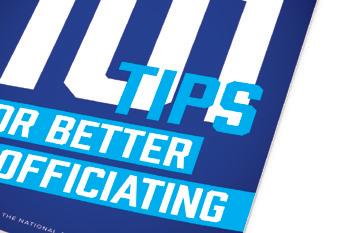


NATIONAL ASSOCIATION OF SPORTS OFFICIALS
WE’RE
TOGETHER!
ALL IN THIS
FOR NASO MEMBERSHIP INFORMATION OR TO SIGN UP, GO TO NASO.ORG, CALL 262-632-5448 OR EMAIL CSERVICE@NASO.ORG
$ 114 JOIN TODAY

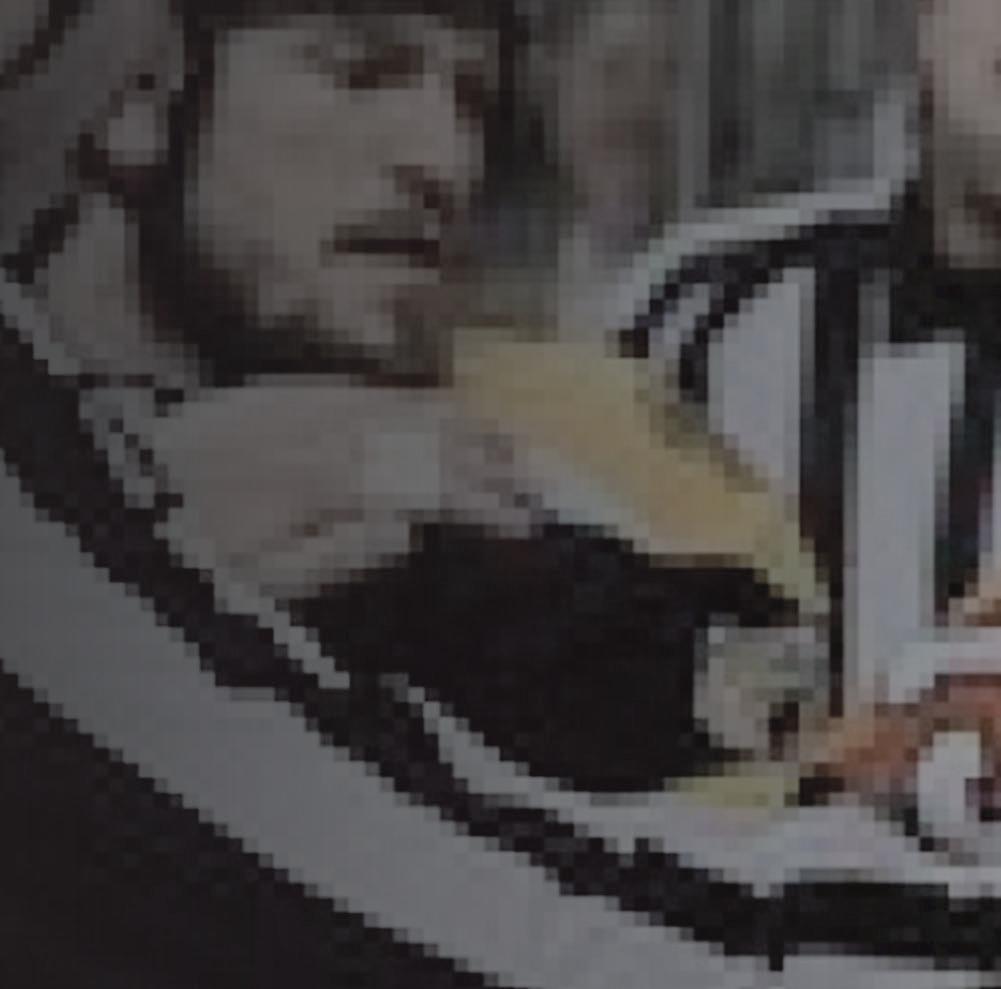
Reel Officiating
By Brad Star
You don’t have to look too far to find documentaries about sports. TV and streaming services are littered with ones that delve into the journeys of championship teams and the personal stories of players and coaches.
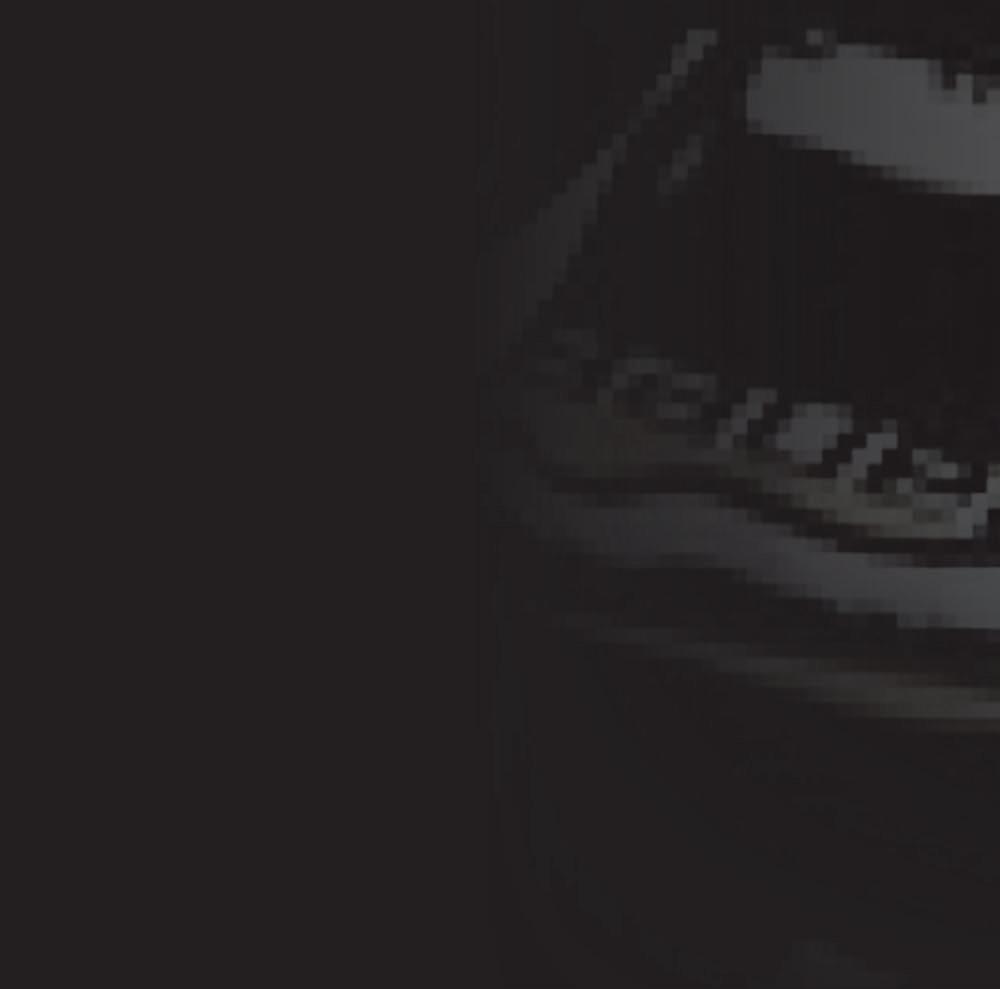
Documentaries honing in on sports officiating, though, aren’t as plentiful. But they’re out there, and Referee has compiled a list of officiating documentaries that are worth your while. From large-scale features that have aired on major networks to lesser-known independent films, the following documentaries take viewers behind the scenes through a day in the life of an official.



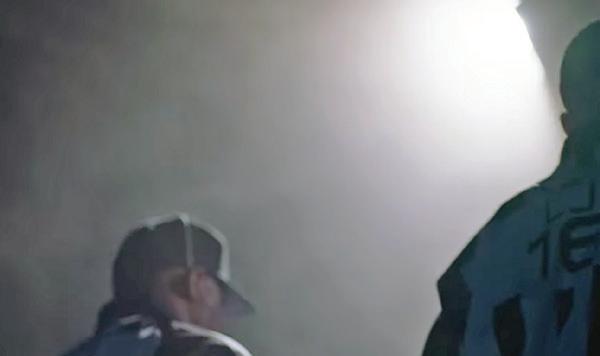


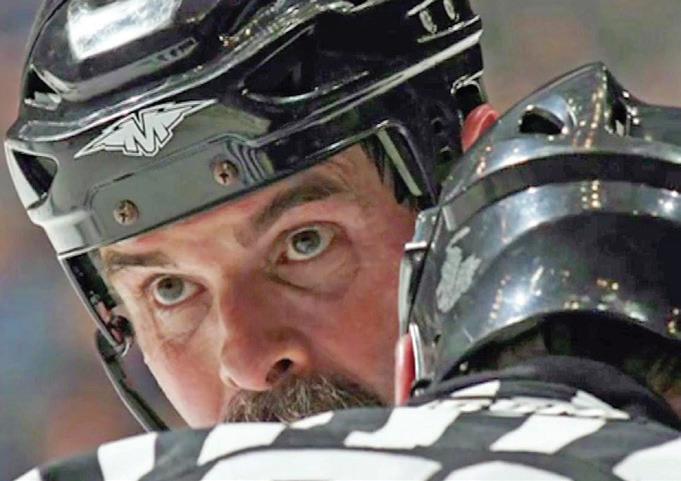
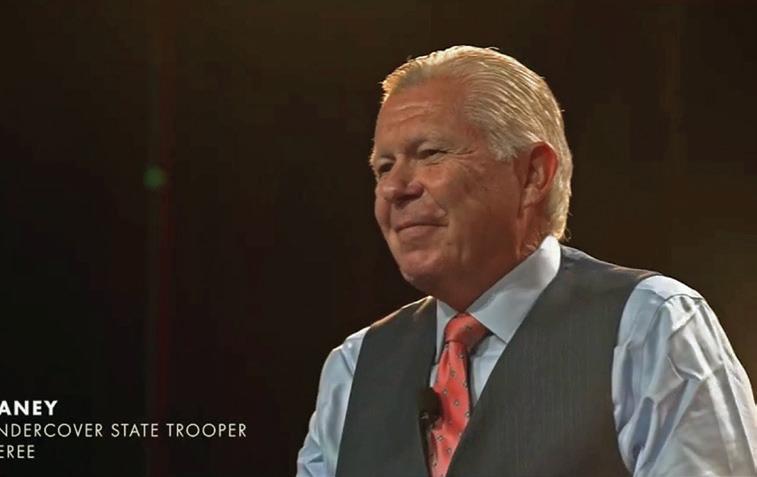

now trending 52 | REFEREE July 2024
2024 | 1 Season 4K Ultra HD 5.1 PLAY NOW
|
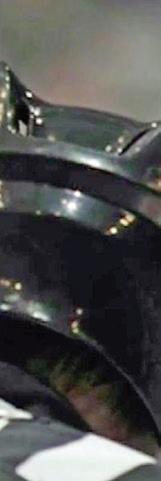
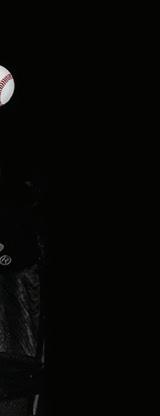
Her Turf (2019)


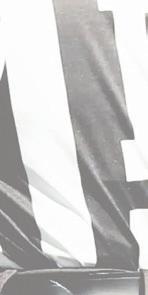
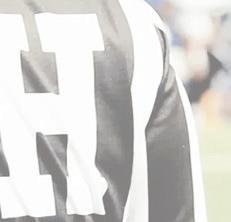

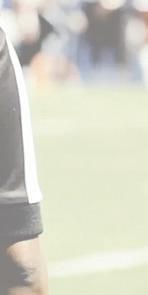
Inspired by her visits to the NASO Sports Officiating Summit in 2015 and 2018, independent filmmaker Shantel Hansen released Her Turf in 2019 in hopes of raising awareness for the officiating shortage, as well as showing women have a place in an industry historically dominated by men.
“(Officials) are such a marginalized community, they’re seen and not heard from,” Hansen said. “There are so many layers here, and people — fans, coaches, players — just don’t know enough. There’s actually a human being behind those stripes.”
Hansen isn’t an official herself, but being from Nebraska — “Football is just part of my DNA,” she said — has caused her to gravitate toward football officials.
The executive producer for Her Turf is a well-known name in the
The Referees (2009)


Alternately titled Kill the Referee, the documentary shows the harrowing experience of several professional soccer referees during the UEFA Euro 2008 tournament. Among them is English referee Howard Webb — one of the film’s key moments is during Webb’s first match of the tournament, a Group B match between Austria and Poland.
With Poland up, 1-0, and under a minute to play, Webb awarded Austria a penalty kick, which is converted, resulting in the match ending in a draw.
The decision, which the UEFA said was correct and “not controversial,” led to death threats for Webb and his family. Polish prime minister Donald Tusk even declared he “wanted to kill” Webb.
The film shows the extra
officiating community — Dean Blandino, rules and officiating analyst for Fox Sports and former NFL vice president of officiating.
The 20-minute film follows Annice Canady, an NFL officiating scout and former official who was the first female football referee to work an NCAA game in 2001; Tangela Mitchell, an NCAA official who has worked in the Southwestern Athletic Conference, USFL and XFL; and 15-year NCAA line judge Mary Podesta, who worked in the Great Northwest Athletic Conference.
“The women referees, they’re not thrown into the fire, they run into the fire,” Hansen said, “and I have to run with them.”
security measures Webb and his assistant referees received throughout the tournament, including when their dressing room is searched during a bomb scare.
UEFA head of refereeing Yvan Cornu wanted to give the involved officials a chance to tell their side of the story and what they went through. Cornu proposed the project to director Yves Hinant and producer Jean Libon, who released the 77-minute documentary a year after the tournament.
“Nobody knows them, nobody likes them,” Hinant told The Guardian. “So it is very interesting to make a movie against the common perception. … For (the officials) it is also a competition.”
REFEREE July 2024 | 53
Run time: 18 minutes
Shantel Hansen Run time: 77 minutes
Yves Hinant, Eric Cardot, Delphine Lehericey
Thibaut Potdevin Watch on Vimeo Watch on YouTube
Director/producer:
Directors:
PRODUCER:
Reel Officiating
5460 (2023)


In 2021, Joe West broke Hall of Fame umpire Bill Klem’s all-time record by umpiring his 5,376th MLB game. West retired after that season — his 43rd in the majors, also a record — finishing his career with 5,460 games under his belt, a mark some believe unbreakable.
While the documentary tells tales from West’s long and storied career, director Charlie Minn also delves into the art of umpiring and looks at how the profession has changed over the years.
“Our first responsibility as an umpire is to the game of baseball,” West said. “And that doesn’t mean the Commissioner’s Office, or the National or American League — it’s to the game itself. Without

baseball, we have nothing.”
5460 features cameos from fellow umpires Bruce Dreckman, Vic Carapazza and Cory Blaser, as well as players, broadcasters and others.
“(West) knew we had to be perfect and get better from there when we walked on the field every day, and that’s what his goal was, to make everyone get better from perfect,” Dreckman said.
“Both of us are super competitive, so sometimes it went nice and smooth for both of us and sometimes there was some clashing going on,” pitcher Madison Bumgarner said. “Which is OK. I don’t mind that, and I don’t think he does either.”

the evolution of nfl referees (2024)




“Elite is something that we see every Sunday. These players are elite athletes. And I want to be an elite referee,” says referee Shawn Hochuli in the NFL’s recent documentary that dives into the history and gives a breakdown of football officiating. The Evolution of NFL Referees goes back to the advent of the NFL in the 1920s, when there were just three officials in a crew — referee, umpire and head linesman — and documents how the modernday crew of seven officials came to be.
Hochuli stars alongside several other officials and NFL officiating staff, including Terry Killens, who served as the umpire on Hochuli’s crew last season, and Walt Anderson,
former NFL senior vice president of officiating.
Viewers get a behind-thescenes look at an NFL crew’s pregame, which involves arriving at the venue three hours early and meeting with security, television production teams, team doctors and more.
“Part of officiating at this level, which is interesting to think about,is if somebody came to your work and videotaped you doing your job throughout the whole day, and watched it back in slow motion while a million people critiqued what you did during that workday, how would that make you feel?” Hochuli said. “That’s kind of the microscope that we feel that we’re under.”
54 | REFEREE July 2024
Run time: 129 minutes Director/producer: Charlie Minn Run time: 61 minutes Director/producer: NFL Watch on Amazon Prime (with subscription) Watch on YouTube

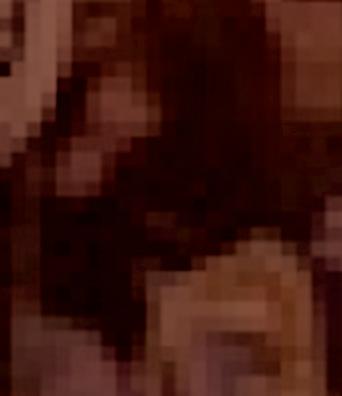
Behind the Stripes: A Ref’s Life (2010)


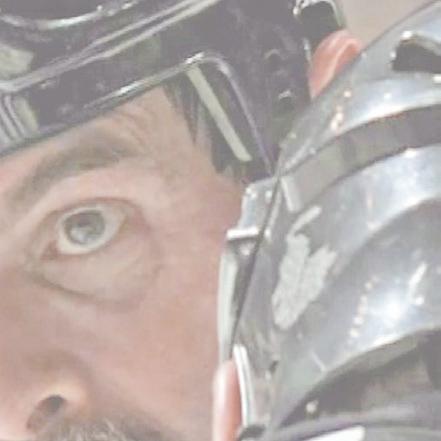

Produced by the NHL,
Behind the Stripes follows the journeys of two NHL referees at opposite ends of their careers. Ghislain Hebert is just entering the league as a rookie official while Bill McCreary is nearing the end of his Hall-ofFame career. Neither felt like he worked a day during his officiating career.
“For me, it’s not a job,” Hebert said. “It’s just something I really want to do.”

officials and players, including an argument between McCreary and Detroit Red Wings defenseman Brad Stuart over whether Stuart punched another player in the head.
“There’s one thing I could never do, is play in this league. I wasn’t good enough,” McCreary told Stuart. “I know one thing for sure is you can’t referee in this league.”

“I’ve always said that to have a job like this, I’ve never considered it a job,” McCreary said. “It’s a pleasure and a privilege to be able to work with these athletes every day. They’re world-class players and I just feel very honored to be part of it.”
Behind the Stripes features several interactions between

An NHL official since 1984, McCreary retired at the end of the 2010-11 season. His storied career, which included officiating 15 Stanley Cup Finals and three Olympic gold medal games, led to his induction into the Hockey Hall of Fame in 2014. Hebert would become a full-time NHL official in 2012 and still works in the league today.
Hiding in Plain Sight (2024)
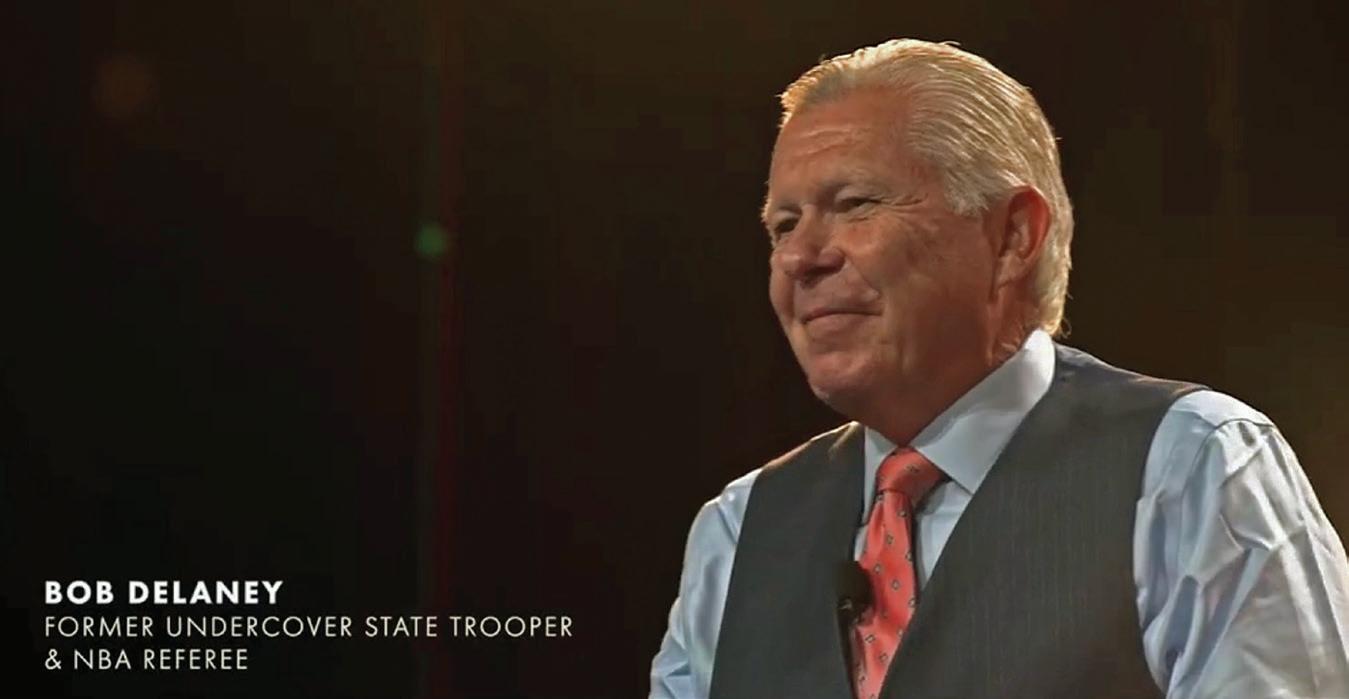

Abit different in that officiating isn’t the primary focus, but this 46-minute dive into the life of former NBA referee Bob Delaney is definitely worth your time. As part of Nick Nanton’s In Case You Didn’t Know docuseries, Delaney delves into the secret life he led before becoming one of basketball’s most well-respected referees: infiltrating the Mafia as an undercover New Jersey state trooper. Delaney opens up about his experience with post-traumatic stress disorder and how basketball officiating helped provide him peace.
REFEREE July 2024 | 55
Run time: 24 minutes Director: Steven Matthew Hoffner producer: NHL Run time: 42 minutes Director/producer: Nick Nanton YOU MAY ALSO LIKE Watch on Vimeo Watch on YouTube
COORDINATOR: JOHN VAN DE VAARST

STORM WARNING
11 Tactics to Prepare for Violent Behavior
By Robert Kauffman
T here are numerous articles and stories about increased violence occurring at athletic events. But this kind of behavior is not really anything new. Still, it is hard to deny these incidents are increasing, and should be of concern to soccer referees.
What can soccer referees do about violent situations? How can they act to minimize the chance of a violent action blowing up? It’s a complex problem, and while there
is no single solution, or any way we can eliminate the chances of a violent confrontation on the field, there are a number of things a referee can do to lessen the chances of fighting and violence. Here is a list of tools a referee can use so chances are reduced:
1.Research the probability of possible problems before the game starts. Find out if a team is prone to violence and if there have been prior incidents. Check to see if the teams playing have a history of problems with each other. Some teams cannot
play without police or security on the premises. If this is the case, make sure the security team is available and talk to them before the game.
2.Talk to the coaches before the game. The coaches can often be your greatest asset in preventing an outbreak of violence. Request their help in keeping the game under control. Talk to them if things seem to be getting out of hand. If necessary, stop play and ask each coach to talk to their team to calm things down. It is in no one’s best interest to see things get out of hand, and have
56 | REFEREE July 2024
jvandevaarst@referee.com SOCCER RULES, MECHANICS, PHILOSOPHY
DALE GARVEY
A serious takedown foul from behind, possibly injuring the player, often raises the temperature in a game. Fouls such as this might result in retaliation from players, coaches and even fans.
players suspended or injured.
3.Keep your eyes open at all times! Often, the most violent incidents occur out of sight of the immediate play, or when play is stopped. Officials should be looking off the ball and, as a referee team, covering the whole field. This includes all dead ball time. When one official is dealing with a situation, the other officials must be watching the rest of the field and the bench to prevent problems from arising.
4.Work as a team with your other officials. Discuss possible situations with your fellow officials a day or two before the game. Provide what you know and let each official share what they know. Discuss strategies for coping with potential problems. Be prepared to ramp up calls to prevent future problems.
5.Major problems don’t always come from the field, but sometimes from the stands. It is important you talk to the field manager and security personnel before the game to discuss potential problems. Spectator issues are the responsibility of the field manager, security personnel and coaches, but the referee may also be involved. If any official sees or hears problems coming from the spectators, or any player reports an issue, the official must let the coach or field manager know and attempt corrective action.
It is not the referee’s job to talk to or confront the offending spectators, but the referee must ensure the spectator problem is corrected to provide a safe and fair environment. If, in the referee’s opinion, a spectator must leave the area for the game to be played safely and fairly, take the time and be sure this takes place before resuming the game.
It is the referee’s prerogative to suspend and/or terminate the game, depending on the league rules. No one likes to see this happen, but our prime responsibility is to the safety and integrity of the game, and if the coaches, field managers and security personnel are unable to control the spectators, there is no choice but to suspend the game. Remember, once the game has started, the head referee has the prerogative to stop
the game if necessary. If an assistant referee observes a problem they cannot solve, report it to the referee for resolution.
6.Help from security personnel, field managers and coaches may also be necessary if a serious fight occurs on the field. The referee cannot and should not touch a player who is engaged in a fight. Officials can do their best to prevent or end a fight by using their voice and physical presence. If it can be done safely without risk of harm, move between players to help prevent player engagement. The referee team can also use this tactic to keep additional players, bench personnel and coaches from heading toward any confrontation and adding fuel to the fire. Physical confrontation can only be handled by team personnel, coaches, field management, security personnel or the police.
It is the referee’s legal responsibility to avoid any physical contact with any player, coach or spectator outside of a necessary action to protect themselves. Get out of the way, and try to make sure not to touch anyone if violence is taking place. At this point, referees can only observe and report what has happened. A referee is not trained, nor does the referee have the authority, to deal with players, coaches or spectators engaged in violent activity.
7.When refereeing a problematic or confrontational game, make calls early, and increase the number and severity of the calls if necessary. Often, the best defense in preventing violence is exerting extra control. If teams are prone to violence, they cannot be allowed the leeway to make more aggressive plays that involve contact that might be tolerated if the game is being played under better conditions of sportsmanship.
8.Be more careful about advantage. A “play on” call that might be appropriate in a normal game may not be a good call to make in a tense game with a chance of violence. A player may overreact and start a fight if you do not immediately stop play for a foul. In
SURVEY SAYS …
is the toughest call for you as a soccer official?
DID YOU KNOW?
You think you’ve had contentious matches? An October 2014 Argentine third-tier match between Ciopolletti and host Deportivo Roca resulted in 12 red cards. Referee Facundo Espinosa first sent off Cipolletti defender Marcos Lamolla and Deportivo Roca’s Fernando Fernandez. Following the sendoffs, Lamolla ran the length of the field to confront Fernandez but was intercepted by another player. The pair exchanged blows and a major brawl between the teams occurred. The game was abandoned and riot police had to intervene.
SOURCE: YAHOO UK EUROSPORT
THEY SAID IT
“Ninety-eight percent of people won’t bat an eyelid when a woman turns up to referee their game, but there’s another two percent who will. In years to come, there won’t be that exposure around it. That sounds negative, but it’s really not. It will just be the norm.”
–Rebecca Welch, the first woman to referee a Premier League match.



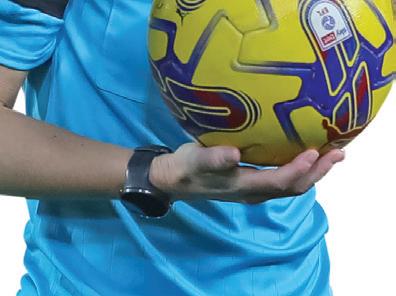

JAMES HEATON/ZUMAPRESS/NEWSCOM
50%
36% . . . . . . . . . . . . . . . . . Offside 14% . . . . . . . . . . . . . . . Handling SOURCE: REFEREE SOCIAL MEDIA POLL
What
Fouls in the penalty area
TEST YOURSELF
In each of the following, decide which answer or answers are correct for NFHS, NCAA or IFAB rules/Laws. Solutions: p.81.
1. During a penalty kick, the goalkeeper has both feet in front of the goalline before the ball is kicked. The goalkeeper makes a save but the ball rebounds from the goalkeeper to an attacking team player (not the kicker) who scores a goal.
a. Re-kick and caution the goalkeeper.
b. Goal.
c. Goal and caution goalkeeper.
2. Prior to a penalty kick, players of both teams are positioned outside the penalty area/penalty arc and in front of the goal, except one attacking team player who stands to the side of the penalty area behind the penalty spot.
a. This is encroachment.
b. The player must move back prior to the referee starting play.
c. Legal.
3. A1 takes a throw-in. The ball strikes the referee and goes to B2, who clears the ball.
a. Drop ball for team A, the last team in possession.
b. Drop ball for team B.
c. Allow play to continue.
4. B1 deliberately kicks the ball toward goalkeeper B2. The ball deflects off A3 but does not change direction and goes to the goalkeeper, who picks up the ball.
a. Pass back and award indirect free kick.
b. No foul, play continues.
c. Caution B1 for trickery and restart with indirect free kick.
5. On a rainy day, portions of the touchline have disappeared and the ball rolls into an unmarked area. The AR deems the ball crossed the line and raises the flag.
a. This is a correct decision.
b. Play should continue until the ball is obviously out.
c. Drop ball for team last in possession.
a game prone to violence, your top priority must be to keep things safe, even at the expense of depriving a team of the advantage.
9.Make strong use of yellow and red cards. Warnings may be helpful in a normal game, but in a game prone to violence, the use of cards sooner rather than later is important. Get the players’ and coach’s attention while getting dangerous players off the field and out of the game. A referee should never feel the game got out of control due to reluctant use of the tools in the toolbox. In some of these games, a player may deserve a card in the first few minutes of play. Make the call. The lack of an early call at the first signs of dangerous play or violence could trigger more problems. Nip the problem in the bud. In a game like this, referee decisions can be the biggest deterrent between order and violence.
10.Suspend the game if necessary. Anyone who has ever experienced or seen a tape of an incident where things got out of control knows the dangers of what can happen if a game leads to a fight or riot. Referees have been injured or even killed in these circumstances. Your first priority is safety with your second being the game. The result of the game will often be forgotten over time. A serious fight with injuries will not. Some people could be left
with permanent injuries or worse. Whenever it is felt the game must be suspended, do so.
11.If you do have an incident, have each member of the crew write down the facts and immediately report the incident. Do not discuss the incident with anyone except the appropriate authorities. Speak factually about what exactly took place. Do not make assumptions. Proceed as if anything you or your fellow referees say or do can be held against you. If someone is seriously injured, there may be legal action. Do not say anything unnecessary.
There are many situations causing a breakdown in order. No one, including the best referees in the world, can ensure that. Even with their best efforts, a game may break down and lead to violence on the field or in the stands. Good preparation and the toolbox tools are the best defense. Prepare for the game. Talk to your fellow referees. Talk to the coaches, team officials, field managers and security personnel before and even during the game so everyone is working together to prevent such an occurrence. We all love the game and want to keep it safe.
Robert Kaufmann, Glen Rock, N.J., is a lawyer who has been a high school, youth and senior amateur referee for over 20 years.
Do’s and Don’ts
By Dr. Joe Manjone
Numerous articles have been written to help soccer officials improve their skills. These articles normally include information any soccer referee must know to have a successful game and officiating career. Rule 5 provides specific guidance explaining what officials must or can do before, during and after a game. Think of Rule 5 as a “do’s and don’ts” checklist for officials and officiating associations to use while preparing for each assignment during the season.
of Rule 5
The Do’s:
•Be aware of rule differences. Know what rules are being used. Adhere to and enforce all the rules including state and local modifications. If possible, review the rulebook prior to every game.
•Always use proper signals.
•Get in shape and stay in shape. Be able to handle the physical requirements of soccer officiating like speed and endurance. Good training and good diet habits are a must.
58 | REFEREE July 2024 SOCCER
•Know and practice good officiating mechanics. Watch other officials, especially those at a higher level and learn from them.
•Only accept games your schedule allows you to arrive early.
•Look sharp. Your uniform should be neat and clean, and your shoes should be clean and shined.
•Have the phone number of the coach and/or game administrator plus the phone number of the other officials in your crew for all games you work. Call and make them aware of any delays on your part.
•Get to the game site at least 30 minutes prior to the start of the game.
•Meet with the game administrator and find out where to contact them if needed during the game.
•Have a pregame conference with the other officials to prepare the team for all occurrences.
•Informally or formally, depending on the type of game, check the equipment of all players, the game balls, team areas, goals and field markings. Let the coach know of any problems. Remember, participant safety is the number one priority.
•Provide instructions to the scorers, timers and ball holders prior to the start of the game. Thank them for the great work and help they provide.
•Make certain each team’s roster has been turned in prior to starting the contest. Do not be concerned with player eligibility; that is up to the schools, league and/or state association.
•During the coin toss meeting with coaches and captains, cover all ground rules, pre-start instructions, and overtime procedures that are in effect. Emphasize good sportsmanship, and for NFHS games, ask if all players are properly and legally equipped.
•Start the game on time and notify team captains when play is about to begin.
•Hustle and be consistent throughout the game.
•Be sure to signal the start and stop of the clock. Instruct the timer

to correct the clock when needed (high school and college).
•Work together as a team with your fellow officials.
•Call out and signal with an under swing one or both arms when calling a foul that would give an advantage to the offending team.
•Know how to handle dissent from players and coaches.
•When carding a player or coach, hold the card above your head. Indicate the player being carded.
•Confirm the score at the end of each half.
•As the referee, confirm or overrule assistant referee signals.
•Terminate or suspend the game if needed as indicated in the rules.
•Report any disqualifications or problems to the proper administrative body immediately or as soon as possible per league or conference rules.
•Make your game report factual.
The Don’ts:
•Do not socialize with players, coaches or spectators before or after the game.
•Do not drink alcoholic beverages before the game or after the game while still in uniform.
•Do not smoke or chew tobacco at the game site.
•Do not lose your temper when officiating; stay calm.
•Do not brag to others about cautions or disqualifications you issued to players, coaches, administrators or parents.
•When attending games as a spectator, do not criticize or talk about other officials. If asked about a call, just say you are not on the field and do not have the same view as the referee.
•Do not blow your whistle until you are absolutely sure it is to be blown. Inadvertently stopping a possible scoring opportunity by blowing the whistle makes for very upset players and coaches.
•Do not complain to coaches and
DALE GARVEY REFEREE July 2024 | 59
Ingrid Yan, Woodinville, Wash., hustles to remain in a good position. Staying physically fit and looking professional commands respect from players, coaches and fans while working a match.
CASEPLAYS
Can’t Touch This Play: Goalkeeper B1 saves the ball and has control with the hands. A2 runs by and heads the ball out of B1’s hands. The ball bounces right back up to B1, who clears it downfield to wide-open streaking B3. Ruling: The referee should allow advantage since the ball was cleared downfield to a teammate. At the next stoppage, A2 should be cautioned for knocking the ball out of the goalkeeper’s hands when there was clear possession (NFHS 5-31d; NCAA 5.4.3; IFAB 5.3).
Deliberate Play on Ball
Play: A1 is in an offside position approximately one yard ahead of B2. The ball is played in the direction of A1 but is clearly headed by B2. The ball goes diagonally toward the goal. A1 runs onto it and takes possession. Ruling: Although A1 was in an offside position at the time the ball was played, there is no offside infringement. B2 made a deliberate play on the ball so offside was negated (NFHS 11-15; NCAA 11.3.3; IFAB 11.2).
Goalkeeper Flop
Play: Goalkeeper B1 saves the ball with the feet. A2 charges toward B1 and comes very close to making contact. Just as A2 arrives, B1 picks up the ball, simulates being fouled and falls to the ground. The fall causes the ball to slip out of B1’s hands. A2 takes possession, shoots and scores. Ruling: This is a goal since A2 did not make contact or delay the restart. When B1 simulated the foul, the possession was cleanly lost (NFHS 12-5-3; NCAA 12.2.12; IFAB 12.2).
Foul, Offside or Advantage
Play: A1 is in an offside position just ahead of B2. A3 is moving forward with the ball and is tripped by B4. As A3 is going down, a pass is made to A1, who is now on a breakaway. The assistant referee raises the flag for offside and the referee sounds the whistle. Ruling: The referee is to award a direct free kick to team A for the tripping foul since the advantage did not materialize (NFHS 12-2-2; NCAA 12.1.4; IFAB 12.1).
players about the differences between high school rules and the rules of other rule-making bodies.
•Do not hesitate to give a caution because it is the second caution that the player has earned and will now be disqualified.
•Do not talk to the media or communicate in social media about a game you worked.
•Do not focus on the ball but concentrate on the area of play.
•Do not officiate to prevent being scratched by a team. Call the game as you see it, not as the coach wants you to see it.
•Do not hesitate to correct and apologize for an error.
•Do not forget to let your assigner know of any problems that may have occurred.
Utilize Rule 5 and create a routine adding other do’s and don’ts that are important to your league or association’s rulebook.
Joe Manjone, Ed.D., Silverhill, Ala., is a former chair of the NFHS Soccer Rules Committee. He was inducted into the NISOA Hall of Fame in 2013 and is an active high school referee and a former collegiate soccer referee.
You Can’t Relax at This SPA
By Dan Rudloff
Agreat majority of the fouls a referee calls during a game have only one level to them. Common direct kick offenses, tripping, holding, handballs and the like obviously result in a direct kick. Impeding and dangerous play would be an indirect free kick. The offended player or a teammate puts the ball down, makes sure the defenders allow for the 10-yard clearance, except for a quick restart, and puts the ball in play. The same occurs for indirect kick offenses with exception of two players having to touch the ball. The game usually moves on rapidly with only a flicker of a stoppage.
However, those same so-called common fouls can have another level to them that the referee must be aware of. Stopping a Promising Attack (SPA) with a foul also requires a second level of punishment, a caution (yellow card) for the offender. SPA can be very similar to Denying an Obvious GoalScoring Opportunity (DOGSO), but the circumstances for each and the punishments are not the same.
The specific criteria for SPA include:
•Distance between the offense and the goal.
•General direction of play.
•Likelihood of keeping or gaining control of the ball.
•Attacking team is moving forward with pace.
•Open space in front of the player with the ball or the presence of other attackers who could receive the ball.
•Player has option to take on defender or pass to a teammate.
•The attacker has assistance from teammates.
Unlike DOGSO, not all of the criteria must be satisfied when making the decision.
Proper handling of SPA is about identifying a play where an attacking opportunity with clear potential is halted by a foul. SPA occurs with solid possession of the ball by an attacker, the positioning of the players on the field, both offensive and defensive, and player being fouled. This foul, tripping for example, has greater implications than a common foul. The context of where on the field the foul occurs, the speed and intent of the offensive player and how the players are configured will determine whether SPA has occurred and must be dealt with by the referee.

60 | REFEREE July 2024 SOCCER








The official NFHS Soccer Officials Manual produced by the editors of Referee! Loaded with dozens of mechanics scenarios and featuring Referee’s exclusive PlayPic® and MechaniGram® graphics, this new resource is a must have for high school soccer officials. YOU’VE NEVER SEEN AN OFFICIALS MANUAL LIKE
THE NEW SOCCER OFFICIALS MANUAL MOR E PAGES MOR E MECHANICS MOR E INSTRUCTION • MORE • MORE • MORE
ONE! Print - $21.95 // Digital - $20.95 // Combo - $25.95 GET YOURS TODAY! STORE. /SOCCER 208 pages 5” x 8.25”
THIS
DOGSO entails recognizing a foul that prevents a nearly guaranteed goal, and it has its own additional punishment, often a mandatory red card. The basic tenets concerning the foul are (1) distance to the goal, (2) direction of the attack, (3) likelihood of maintaining control of the ball and (4) location and number of defenders. All four circumstances must occur for DOGSO to be called.
With SPA the circumstances are similar but not identical. For example, “distance to the goal” and “direction of the attack” must be present. The distance to the goal usually begins somewhere on either side of the halfway line, and the attacking team must be moving forward rapidly. SPA can only occur when the attacking team is on the move and headed to goal, not passing back or laterally and not moving at a pedestrian pace. The presumption of a bona fide attack on goal must be clear.
Maintaining possession of the ball is also critical and mandatory. What is the likelihood that the player being fouled would have retained possession of the ball had the foul not occurred? Has the attacker already lost control when fouled? Has the attacker pushed the ball too far forward to be able to catch up to it? The referee has to determine whether possession would have been maintained regardless of the effect of the foul. If the player would not, in the opinion of the referee, have maintained possession, then the foul is just a foul, and the possibility of SPA has evaporated.
For SPA, the location and number of defenders comes into play as it does with DOGSO, but with a twist. For DOGSO to occur, the player with the ball has to have a clear unimpeded path to the goal with usually only the goalkeeper between the attacker and the goal. But for SPA, not only are the location and the number of defenders important, but the location and numbers of teammates as well. There needs to be open space available to the fouled player had a foul not occurred. Were

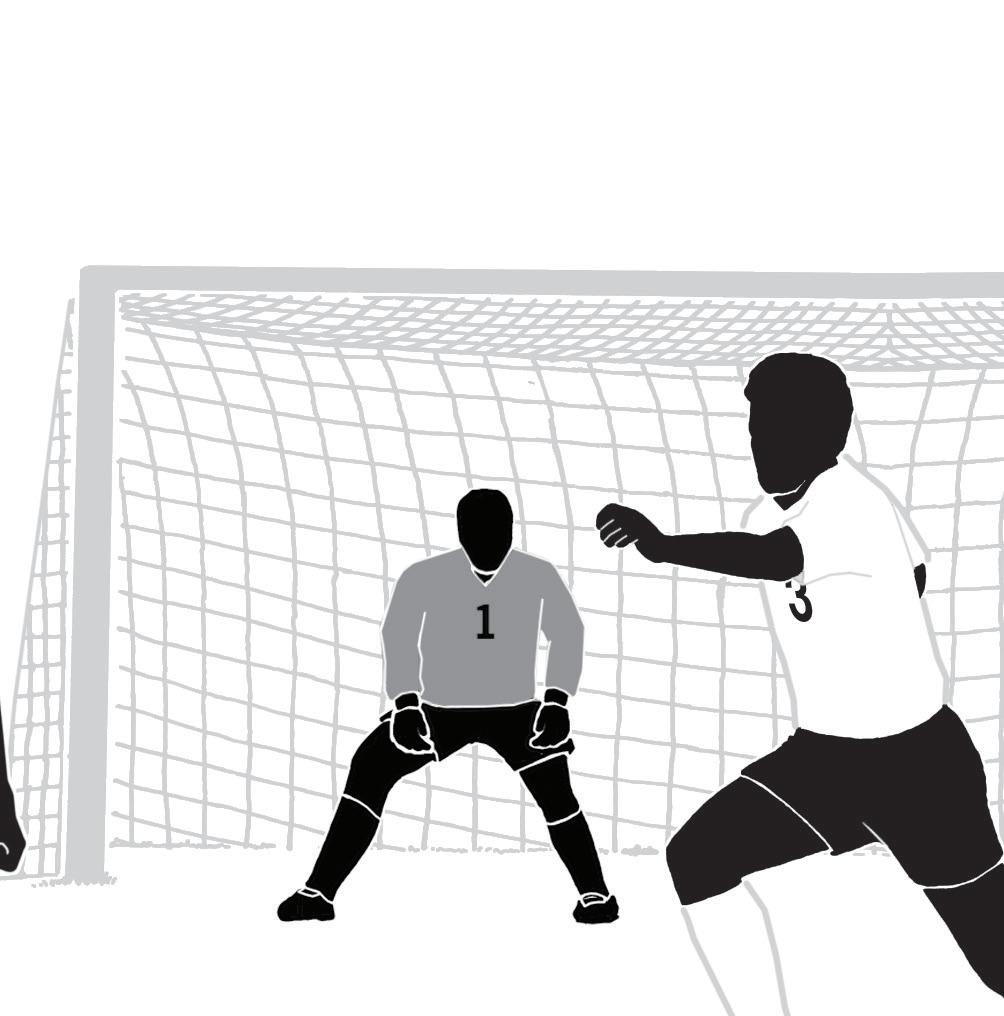

there open teammates to whom the ball could have been passed to continue to press the attack? In other words, did the fouled player have options besides being the only one to carry on the attack? If this was present, that foul will carry a caution (yellow card) with it.
Sometimes called a tactical foul, the intent of this foul is to stop a developing attack. Stopping a Promising Attack carries with it the additional penalty of a caution. A2 is moving rapidly on the attack with space to work with. The defenders between A2 and the goal are at a disadvantage because of their locations giving the attacker options to proceed. Team B defenders may be at a further disadvantage because A2 has teammates available to assist providing even more options. A2 is fouled. The impending attack on goal is at least slowed and perhaps even totally prevented. This would be SPA.
As shown in the PlayPic, for SPA to occur, there needs to be an attacker with the ball clearly in their possession moving rapidly toward the goal. The distance from the goal may even be as far away as the halfway line if the other criteria apply. The player needs open space in front and defenders at a disadvantage because of their

locations. The attacker may also have a teammate or two in good positions to be of assistance to continue the attack. If there is then a foul, the offender is cautioned — the premise being that the offender has committed the foul to stop the promising attack.
Since making the call correctly involves more players than just the one being fouled and the one committing the foul, the referee’s positioning is critical to make the correct call. If the referee does not have a good view of more than just what is in front of them, this important call can be missed. With the increased probability of referees and assistant referees being connected electronically, even not being in the best position can be overcome with a quick word with an assistant referee. Taking an extra beat to determine SPA as opposed to DOGSO or just an ordinary foul is also worthwhile since the difference between red, yellow and nothing is so dramatic. As always, however, good positioning is fundamental to good decision-making.
Dan Rudloff, Chester, Pa., is a NISOA National Referee Emeritus and longtime high school soccer official who has officiated numerous high school state championships and NCAA playoff matches.

62 | REFEREE July 2024 SOCCER

GETTING IT RIGHT
Supporting Survivors Through Sports
By Brad Star
The 90 minutes before a sporting event begins is a busy time for officials. Making sure equipment is in order, getting familiarized with the venue’s ground rules and mentally preparing are just a few tasks on an official’s pregame to-do list.
For the past decade, officials at the highest level have sometimes

universality of sport and how it brings people together in a way that nothing else really does,” Hosford said.
The initiative has also allowed TAPS to partner with officials, starting with NBA referees in 2014. Former NBA referee Bob Delaney, who serves on TAPS’ advisory board, put Hosford in touch with NBA veteran referee Scott Foster, and thus began TAPS’ partnership with NBA officials.
TAPS families often get to go with officials into their locker room, receive a jersey, learn how to inflate balls and take pictures on the court. At one point prior to the COVID-19 pandemic, every active NBA referee had partaken in a TAPS experience, according to Hosford.
“(The families) have this whole experience where they are like the family of the referees and have a whole beautiful, meaningful experience,” she said.
TAPS families have also had experiences with NFL officials and MLB umpires. Most recently, NHL referees became involved through the NHL Zebras Care charity.
Rooting for the Referees
Back in April, a group of fans took part in an unofficial tradition at a Grand Rapids (Mich.)
Griffins game: “Annual Referee Appreciation Night.” Fans headed to Van Andel Arena not to cheer on the Griffins — the minor league affiliate of the NHL’s Detroit Red Wings — nor their opposition, but rather the third team: the referees. Fans wore stripes while sitting in the stands and only cheered when the whistle was blown.
“Really any penalty of any kind — offsides, icing, penalties, even goals — any time the whistle is blown, that’s when we go nuts,” organizer Jason Schemmel told FOX 17. “It’s great because we get to yell, ‘You can’t do that.’ We get a good chant going. We get nice and loud.”
Schemmel organized the first Referee Appreciation Night in 2022 with a turnout of 40 fans. That number grew to 60 in 2023 before exploding to nearly 100 fans dressed in stripes this year. Each year, the event is coordinated in the Annual Referee Appreciation Game Facebook group, which has nearly 200 members.
SOURCE: FOX17ONLINE.COM
Little League Legend
dedicated part of their pregame to a special cause. Through the Tragedy Assistance Program for Survivors (TAPS), families of fallen military service members have been able to meet and learn about officiating from officials in each of the four major professional sports leagues.
In 2013, Diana Hosford, TAPS vice president of sports and entertainment, had a vision that would allow TAPS to create meaningful opportunities for families of the fallen through sports. She spearheaded “Teams4Taps,” which has grown to include 200 professional sports teams across the nation.
“I started thinking about the
“It is such a busy time for them just in those 90 minutes before the game, but they are so generous with that time,” said TAPS sports and entertainment associate Grace Polk, who has led the partnership with NHL officials. “You just have really genuine, authentic conversations between the families and the referees.”
“Everyone at TAPS knows the power of sports is far more than numbers on a scoreboard — it is sharing that game experience with others,” Delaney said. “It becomes part of a healing journey for TAPS families when they attend a game that their hero was a fan of. There is a feeling of connection to their loved one.”
Brad Star is an assistant editor for Referee
Family and friends gathered at Southcrest Field in San Diego in March, when the field was officially renamed “Shelley Curtis White Field” in honor of former area umpire Shelley White.
White, who died in 2021, was a “no-nonsense kind of guy,” according to his son, Deron. His 60-year career as an umpire included calling games in Hawaii, Japan, Korea and at the Little League World Series in Williamsport, Pa. But he was most well known as a Little League umpire at Southcrest.
The field now has a large painted mural of White and his name in big blue lettering on the building housing the refreshment stand and announcer’s booth.
SOURCE: TIMES OF SAN DIEGO
Have you heard an inspirational or motivational officiating story?
Send your ideas to GettingItRight@referee.com
PHOTO PROVIDED BY TAPS
Debbie and Seth Parrish, surviving spouse and son of U.S. Army veteran Harry Parrish, met NHL officials (from left) Trent Knorr, TJ Luxmore, Graham Skilliter and Jesse Marquis before a Washington Capitals game this past season.
INSPIRATION, MOTIVATION, ELEVATION 64 | REFEREE July 2024
PLAY IT FORWARD
You are part of an exclusive community of sports officials. Our nation’s sports cannot be played without you. Make sure you continue to advocate and protect yourself – and the future of our great avocation –by joining NASO today!

$6 million officiating liability insurance coverage ($14 million aggregate) – the most comprehensive protection available. You’re covered for any sport, any level, any time you officiate!
Huge discounts and cost-savings benefits from Ump-Attire.com, Marriott hotels, car rentals, Referee books & videos and more!
$100,000 in Game Call and Assigners insurance coverage with an additional $15,500 in Assault insurance protection.
Exclusive access to the NASO Member Information and Consultation Hotline. If you have problems in officiating, we are a phone call away!
NASO.ORG/JOINRENEW JOIN or RENEW NASO TODAY AT
EDITOR: BRAD TITTRINGTON btittrington@referee.com

FLYING SOLO Handling Tough Situations When Working Alone
By Brad Tittrington
If you work travel ball or subvarsity levels, chances are at one point in your career you’ve had to work a game alone. Especially in today’s climate with the umpire shortage, it is becoming more normal to work alone at those levels. Some of it has to do with the shortage, but some of it also has to do with cost savings. Either way, most of us have been thrown into this situation. Even at the collegiate level, there have been
instances where umpires have had to work alone due to injury or other unforeseen circumstances. It is important for umpires to understand these situations are not ideal and it is why generally two or three umpires are contracted for games. It is simple math. The more umpires, the better the coverage. With one umpire, it is impossible to see everything. But when that situation arises, we must work as hard as we can to get in the best possible position to make the best possible call
on every play. It doesn’t give us an excuse to be lazy and blame having to work alone as a reason for missing calls. Instead, it should force us to focus and realize we will have to move more than usual in order to get in position.
The first thing to realize when working alone is there is a hierarchy to calls. The most important call is balls and strikes. Next, fair and foul calls have the most importance. Third is catch/no-catch. The fourth most important call is safe and out.
SOFTBALL
MECHANICS, PHILOSOPHY 66 | REFEREE July 2024
RULES,
DALE GARVEY

Working alone creates a lot of challenges for umpires. Chad Smith, Lake Stevens, Wash., hustles out from behind the catcher in order to get in the best position possible to make a ruling, since he has to cover the entire field.
Other calls (such as obstruction and interference) are still vitally important, but sometimes those are impossible to see when working solo.
For example, if there are no runners on base and the batter-runner hits a ball down the left-field line, you first must get out from behind the catcher, straddle the third-base line and try to get as far up the line as you can. You must determine if the ball is fair or foul and then determine whether or not there is a catch. While
focusing on that, you may not be able to see a potential obstruction at first base as the batter-runner rounds the bag.
It will also be nearly impossible to judge a runner leaving early on a pitch, except maybe at second base as that will be directly in your line of sight on the release of the pitch. Runners leaving early before the first touch of a fly ball will be incredibly difficult as well, especially if there are multiple runners. In these situations, fair/foul and catch/no-catch again take precedence. Try to line up the lead runner and the catch if you can. This may not be possible, however, if the ball is hit down the line opposite from where the runner is located. With runners on base, things get even more complicated. It is difficult enough to cover everything in the two-umpire system with multiple runners. It becomes nearly impossible when you are by yourself. The key with multiple runners is to keep a wide view of the field. However, that view will significantly narrow when a play at a base or the plate is imminent. When that occurs, you must first remember the old adage, “Angle over distance.” While you want to get as close as possible on a tag play, it is not always possible when working alone to get as close as is desirable. In those instances, get an angle first and then close down to the base or plate. Coaches will be more understanding if you are hustling and trying to get close on every play than if you stay behind home plate and never move. With multiple runners on, remember to keep your head on a swivel. After a play at one base or at the plate, there is the likelihood of another play at another base. It is important to make sure to not get beaned by a potential throw and you must be prepared to pivot out of the way of a thrown ball. Do your best to see every runner touch every base, but remember the lead runner is the most important. Work through your progression and do the best you can to see everything.
When working alone, it is extremely important to pre-pitch prepare. Working solo can be exhausting and taking a moment
QUICKTIP
As a base umpire, wait until your plate partner officially comes to you to rule on a checked swing. Too often, base umpires give a signal when the catcher points or as soon as the plate umpire rises. Wait until you are officially asked before giving your ruling. This will make sure you don’t end up having a different call than the plate umpire who isn’t actually coming to you and will also allow everyone to have eyes on you and avoid confusion when you do make the call.
SIDELINE
Carolina Hosts USA
Softball Camp
USA Softball of the Carolinas is hosting a fastpitch camp Oct. 17-20 in Burlington, N.C.. The camp includes both classroom and field work and is $400 per umpire. To register, visit 20-20officials. com or email Alan Riggs at alanriggs@yahoo.com. The camp is limited to 24 umpires. Umpires will receive video of their plate game with evaluator comments included. For a full list of upcoming National Umpire School dates, go to usasoftball. com/umpires/national-umpireschools.
SURVEY SAYS
…
Has your training volume increased, decreased or stayed the same after the pandemic?
62.7% of respondents said it stayed the same.
25.5% of respondents said it has decreased. 11.8% of respondents said it has increased.
REFEREE July 2024 | 67
SOURCE:
INDIVIDUALS WHO RESPONDED TO THE 2023 NATIONAL OFFICIATING SURVEY POWERED BY REFEREE.COM.
8,694
NATIONAL OFFICIATING
TEST YOURSELF
Each of the following includes a situation and possible answer(s). Decide which are correct for USA, NFHS, NCAA or USSSA rules and which might vary. Solutions: p. 81
1. With runners on first and second and one out, B4 hits a pop up on the infield between third and home. The plate umpire verbalizes and signals “infield fly.” The ball falls to the ground untouched in fair territory and then rolls into foul territory, halfway between home and third, where it is picked up by F5.
a. The infield fly stands, B4 is out and runners may advance at their own risk.
b. The infield fly stands, B4 is out, but the ball is dead when F5 touches it and runners may not advance.
c. The infield fly is canceled since the ball was not caught, the ball is fair and all runners are forced to advance with liability to be put out.
d. The ball is foul, the batter is returned with a strike added to the count and the runners are returned to first and second base.
2. With the bases loaded and two outs, B6 swings and misses at an 0-2 pitch. The ball bounces off the dirt, hits B6’s foot and rolls near the thirdbase dugout.
a. This is a dropped third strike. The batter and all runners may advance.
b. This is a foul ball.
c. The ball is ruled dead, the batter is out and the half-inning is over.
3. With R1 on first, B1 hits a fly ball to short right field. The first baseman, second baseman and right fielder all move toward the ball. The base umpire, who is positioned between first and second, tries to get out of the way, but collides with the second baseman, who had the best opportunity to make a play on the ball. The ball ultimately lands untouched in the outfield.
a. Umpire interference, the batter is ruled out and R1 must return to first base.
b. No umpire interference, the ball remains live and all runners are entitled to advance at their own risk with liability to be put out.
4. R1 tries to steal second. B2 squares to bunt and the pitch is up and away. B2 leaves the bat over the strike zone, but does not move the bat to attempt to bunt the ball. F2 throws the ball to second, but R1 slides in safely.
a. The pitch is ruled a strike.
b. The pitch is ruled a ball.
before each pitch to prepare can help focus and reset. While the list in these situations should be pretty short (you have everything), it is important to know where runners are and where you will go when the ball is put in play. Once the ball is put in play, hustle to get in position to be able to read and react to any play. The two biggest things to remember are always keep your eye on the ball (to avoid getting hit) and know where runners are in order to not interfere with them running or interfere with a play on them.
There is a reason we try not to
work alone if we don’t have to. It makes our job incredibly difficult. Other things to remember are hustle, angle over distance and keep your head on a swivel. Do the best you can and hope you have coaches and fans who understand the difficulty of working alone. Again, it is better to have one umpire than none and the game not getting played.
Brad Tittrington is an associate editor for Referee . He umpires D-I softball and officiates women’s college and high school basketball, college and high school volleyball and high school football.
Who’s Got First? And Third?
Differences in mechanics are expected between codes. Generally, the differences between the codes isn’t drastic, especially when it comes to which umpire covers each base. However, one specific example where the codes
are miles apart occurs in the threeumpire system with a runner on first and U1 chases. The differences in the way NFHS and USA Softball handle this situation compared to NCAA and USSSA is night and day. First, let’s take a look at the
SOFTBALL 68 | REFEREE July 2024
P C B A D
Working alone, the plate umpire has all responsibilities on runners. This MechaniGram is a guide on umpire movement with no runners on for a single (A), double (B), triple (C) and home run (D). The initial movement is to the center of the diamond then read and react.
mechanics when it comes to this situation and the ball is caught. In NFHS and USA Softball (as shown in MechaniGram A), U1 is responsible for ruling on the catch. Once U3 reads U1 chased, U3 hustles into the diamond, button hooks and is responsible for the tagup at first base and any play at first, second or third on R1. The plate umpire initially trails the batterrunner no more than one-third of the way to first base in fair territory and reads the play. If R1 tags and advances toward second base, the plate umpire moves to the holding zone roughly halfway between third base and home plate in foul territory and is responsible for any play on R1 if R1 advances to the plate.
NCAA and USSSA mechanics take a vastly different approach (as shown in MechaniGram B). In these two codes, U1 is still responsible for the catch. However, it is the plate umpire that is responsible for covering first base. The plate umpire is responsible to watch the tag-up of R1 at first base and any plays on R1 at first base. If R1 tags and fully commits to second base, the plate umpire will move to the holding area in foul territory and be prepared to take all calls at third base and home plate on R1. U3 has the option of either staying outside the diamond or moving inside and is responsible for all plays on R1 at second base.
Now let’s break down this situation and coverage when the ball is not caught. In NFHS and USA Softball, U1 is still responsible for the catch/no-catch and U3 hustles into the diamond and button hooks and is responsible for all plays at first and second base and any plays on the batter-runner at third (as shown in MechaniGram C, next page). The plate umpire again trails the batter-runner no more than one-third of the way to first base in fair territory and reads the play. As R1 approaches second base, the plate umpire moves to the holding zone in foul territory, roughly halfway between third base and home. The plate umpire is
REFEREE July 2024 | 69 P P U3 U3 F9 FLY BALL CATCH BR BR R1 U1 U1 P R1 U1 U1 RF FLY BALL CATCH P P U3 U3 U3 U3 P
B
CASEPLAYS
Illegal Pitch?
Play: On the first pitch of the inning, F1 brings her hands together and then steps up onto the pitching plate. She separates her hands to take the signal from the catcher, then brings her hands back together again before separating them one more time to deliver the pitch. Ruling: Illegal pitch in all codes. When stepping on to the pitcher’s plate, the pitcher must have the ball either in her glove or in her pitching hand and the hands must be separated. The plate umpire should immediately declare an illegal pitch and give the delayed dead-ball signal. The pitcher should be allowed to deliver the pitch. The offense will have the option of taking the result of the play or enforcing the penalty for the illegal pitch, unless the batter reaches first base safely. In that case the penalty is ignored. If the pitcher chooses not to throw the pitch, the illegal pitch penalty will be enforced. In all codes in this particular case, the penalty for the illegal pitch is a ball awarded to the batter (NFHS 6-1-1a and Pen.; NCAA 10.2.1.3, 10.8; USA Softball 6A-1A, 6A-11; USSSA 6-1A).
Obstruction and Malicious?
Play: R2 is on second base with one out. B3 hits a ball to left field. R2 rounds third base and heads for the plate. F7 picks up the ball and throws it home. As the ball is coming into the infield, F2 raises her arms and knocks R2 to the ground so she can’t reach the plate. F2 then catches the ball and tags F2, who is lying on the ground hurt and unable to touch the plate. B3 is about 10 feet from second base when the collision occurs and continues to second base. Ruling: In all codes, F2 is guilty of obstruction. The ball becomes dead when F2 tags R2. R2 is awarded home and B3 is awarded second base. Due to the malicious/flagrant contact by F2, she is also ejected (NFHS 2-34, 2-35, 3-618, 8-4-3b; NCAA 1.7, 9.5.6.1 Eff., 13.2.1; USA Softball 8-5b, R/S 36; USSSA 8-13, 11-2W).
responsible for all calls at third base on R1 and any play at the plate.
NCAA and USSSA again treat this situation much differently (as shown in MechaniGram D). In those two codes, U1 is still responsible for the catch/no-catch. However, just like in the situation where the ball is caught, the plate umpire is initially responsible for the batter-runner at first base. If the play develops with no play at first base, the plate umpire moves to a primary position for a tag play at third base on R1 if there is a play there. If there is no play at third base, the plate umpire will move into the holding zone in foul territory between third base and home and read the play and be prepared to make all calls at the plate. U3 in this situation is responsible for all calls at second base on R1 and all calls on the batter-runner at second and third base. U3 must also be prepared to take any subsequent calls on the batter-runner at first base if the plate umpire moves to cover third for a potential play there on R1.
NCAA and USSSA throw an added wrinkle into this situation if there are two outs (as shown in MechaniGram E, next page). In this
scenario, the plate umpire is not responsible for plays at first base. The reasoning is with two outs, there are no tag-up responsibilities at first base and R1 is going to be off on contact. In this scenario, U1 is still responsible for the catch/no-catch. U3 can choose to either work inside or outside and is responsible for all plays at first and second base and is also responsible for any plays at third base on the batter-runner. The plate umpire immediately moves into the holding zone in foul territory between third base and home as R1 approaches second base and reads the play. The plate umpire is then responsible for all calls on R1 at third base and any calls at the plate.
This is why pre-pitch preparation is so important. If you are an umpire working multiple codes, the coverages are vastly different and it is important to understand your coverage areas to make sure all runners are covered. In NCAA and USSSA, those coverage areas even change depending on the number of outs. It is why in those codes it is important for umpires to communicate with each other by
R1 U1 U1 RF FLY BALL NO CATCH P P P P P U3 U3 U3 U3 SOFTBALL 70 | REFEREE July 2024
P U3 P P P P R1 R1 BR BR P F9 FLY BALL NO CATCH U3 U1 U1 C D
showing the two-out timing-play signal to alert everyone to the switch as shown in the PlayPic.
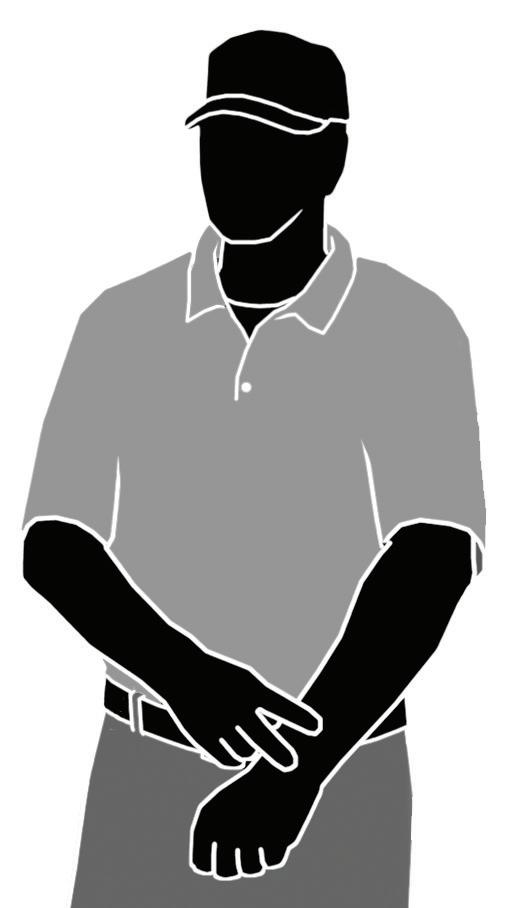



























P U3 U3 R1 R1 BR BR U3 U3 U3 U3 F9 FLY BALL U1 U1 U3 P P P E WEAR YOUR PRIDE WITH SHIRTS ONLY$19 EACH ORDER YOUr SHIRT TODAY! STORE. /CLOTHING SUPPLIES LIMITED
BONUS BENEFITS
How the New NFHS Rule Can Help Your Game
 By Tim Sloan
By Tim Sloan
By the time you’re reading this article, you certainly should know all about the NFHS rule eliminating one-and-one free throws that was instituted prior to the 2023-24 season. The description of the change and the motivation for doing so was stated in the 2023-24 rulebook:
“Eliminating the one-and-one, shooting two free throws after a team’s fifth foul in a quarter and resetting the fouls after each quarter has the potential to provide a better flow by allowing teams that run into early foul trouble the opportunity to self-correct their style of play at the outset of both the second and fourth quarters. Second, by eliminating the one-and-one, the number of opportunities for correctable errors that result from awarding an unmerited free throw or failing to award a merited free throw are significantly reduced. Finally, the guarantee of two free throws eliminates the physical play that has often been associated with rebounding action on the first free throw.”
Let’s examine this information. Correctable errors are a rare event. They involve the incorrect awarding of free throws — to the wrong player, at the wrong basket — but mostly awarding the wrong number of throws. By not keeping track of the team fouls, there is always the possibility of awarding no throws when there should have been a bonus, or awarding throws when there shouldn’t be. The new rule is
When awarding bonus free throws during an NFHS basketball game, Efrain Thomas, Havelock, N.C., knows it will now always be two shots and not the “one-and-one” bonus due to a rule change prior to the 2023-24 season. It’s important for officials not just to know the new rule, but why it can help their games.
RULES, MECHANICS, PHILOSOPHY 72 | REFEREE July 2024 EDITOR: SCOTT TITTRINGTON stittrington@referee.com
BASKETBALL
CARIN GOODALL-GOSNELL
irrelevant to the wrong player or basket part. I would also submit the same potential for confusion on the number of free throws at seven and 10 team fouls would prevail under the new rule, too — twice as often, in each quarter. Has the following happened to you?
Play 1: In the fourth quarter, the referee reports a foul on A1 to the table. The scorer shows five fingers. (a)The referee informs the coach of A1’s disqualification when, in fact, he has only three fouls. Team A, however, has five team fouls in the quarter. Or (b) the referee signals for two free throws when, in fact, this is team A’s third team foul but A1’s fifth. Ruling 1: The scorer’s signal was vague and misunderstood. In (a), the referee corrects the mistake and team B is awarded two free throws. In (b), the free throws aren’t taken and A1 is disqualified. This is an example of poor communication between the table and officials causing unnecessary confusion and ill will. In this case, the scorer should simply hold up two fingers and say, “Bonus,” rather than confusing things. Proper dialogue with the scorer and timer before the game will normally prevent this from happening.
As for the reduction of physical play under the new rule, let’s think about this. In the old system, there were two opportunities after each of the seventh, eighth and ninth fouls for players to jostle in the lane in case of a rebound occurring. From the 10th foul of the half onward, only the second free throw would invite maneuvering for rebounding position. If we consider that most opportunities for injury occur when players actually jump for a rebound, each bonus situation provided, at most, one injury opportunity — after the first missed try if there was one. In the new system, it’s the same deal, no more than one opportunity per trip to the charity stripe.
Suppose a team incurs eight fouls in the first quarter and another three in the second quarter. Under the previous rule, there would be one, and possibly two, throws taken on fouls seven, eight and nine, and definitely two on fouls 10 and 11.
That’s as few as seven free throws and as many as 10, dependent upon the opponents’ acuity from the line. In the new system, that’s a guaranteed eight free throws being taken, whether the opponent’s free-throw percentage is good or not. There are no more than four opportunities to rebound — at the back end of fouls five through eight in the first quarter. So, if we’re keeping score, we’re trading some reduction in rebounding attempts for the possibility of watching a weak team clank the gym into terminal boredom.
No, folks, the big improvement in the new rule is the opportunity for redemption it offers. If games are destined to be rough and officials are going to call fouls accordingly, either system is going to turn the game into a free-throw contest. There are going to be other games, however, where some combination of adrenaline, and the teams and officials adjusting to one another, can generate a lot of fouls early on. Teams that get themselves in foul trouble in the first quarter would wear that shame like the scarlet letter into the second quarter, even if they settled down and reduced their fouls. Complicating this situation is the truth that some officials believe they won’t get paid — or won’t be back next year — unless team fouls are about even at the end of each half. In the old system, that would lead to subtle evening up or smoothing out foul decisions to preserve an imagined status quo.
In the new system, all is forgiven at the beginning of each quarter and there’s a much better opportunity for the intelligent teams to adjust to the officiating and for intelligent officials to maintain consistency. Since nobody really goes to a game to see talented free-throw shooting, the philosophy of resetting fouls makes for better, more competitive basketball.
So while the officials should always be focused on calling the game in front of them and having the players adjust to them, there are things they can do to avoid correctable errors. In addition to clear communication with the scorer, one
BY THE NUMBERS
The number of current NBA officials who had worked 100-plus postseason games entering the 2024 NBA playoffs:
Scott Foster – 241
Marc Davis – 189
Tony Brothers – 187
James Capers – 178
Zach Zarba – 146
Bill Kennedy – 139
Ed Malloy – 136
John Goble – 125
DID YOU KNOW?
The most effective route to becoming a female NBA official appears to be having been a former NCAA Division II athlete. Current NBA officials
Lauren Holtkamp (Drury), Ashley Moyer-Gleich (Millersville), Natalie Sago (Drury) and Jenna Schroeder (Saginaw Valley State) are all former athletes at that level; Holtkamp, MoyerGleich and Schroeder each played basketball in college, while Sago played softball. Also of note, one of the two trailblazing women to first work as an NBA official, Violet Palmer, was also an NCAA D-II athlete, having played basketball at Cal-Poly Pomona.
SOURCE: NCAA.COM
THEY SAID IT
“I’ve coached a lot of what I think were really big baseball games and had been to an NCAA regional, but on the officiating side, there is nothing that I’ve ever experienced in athletics that is as special as March Madness.”
–Current NCAA men’s basketball official and former BYU baseball coach Mike Littlewood, who made his postseason return in 2024 after a 12-year absence caused by his coaching duties
SOURCE: DESERET.COM
REFEREE July 2024 | 73
8
TEST YOURSELF
In each of the following, decide which answer or answers are correct for NFHS, NCAA men’s and NCAA women’s rules, which might vary. Solutions: p. 81.
1. What is the length of the coaching box?
a. 6 feet.
b. 14 feet.
c. 28 feet.
d. 38 feet.
2. All of the following may contain a manufacturer’s logo, except which?
a. Game shorts.
b. Game jersey
c. Arm sleeve.
d. Undershirt.
e. All of these may contain a manufacturer’s logo.
3. Team A does not use any of its timeouts in the first half. How many timeouts shall team A have available to use in the second half? NCAAM: It is a media game with four media timeouts per half. NCAAW: It is a media game.
a. Three 60-second/full and two 30-second timeouts.
b. One 60-second/full and two 30-second timeouts.
c. One 60-second/full and three 30-second timeouts.
d. Two 60-second/full and three 30-second timeouts.
4. All of the following result in a throw-in violation, except which?
a. A2 replaces thrower-in A1 on a designated-spot throw-in.
b. A2 steps out of bounds while thrower-in A1 is still holding the ball on a designated-spot throw-in.
c. A2 replaces thrower-in A1 on a non-designated spot throw-in.
d. Thrower-in A1 hands the ball to A2, who is on the playing court.
5. Who is charged with the technical foul if, while at the table waiting to enter the game, substitute A6 receives a technical for disrespectfully addressing an official?
a. A6 only
b. A6 and indirectly to team A’s head coach.
c. Team A’s head coach only.
d. Administrative technical foul.
6. Which is true of the color of freethrow lane space marks?
a. They must be black.
b. They must be the same color as the lane lines.
c. They must contrast in color to the lane lines.
d. There are no color restrictions.
In the new system, all is forgiven at the beginning of each quarter and there’s a much better opportunity for the intelligent teams to adjust to the officiating and for intelligent officials to maintain consistency.
of the crew (at least) should be vice president of checking the scoreboard as the game progresses. A lot of these devices, for example, have the T.O.L. adjacent to the similarly numbered team fouls for each team: avoid the dyslexia of confusing the two. It’s not a horrible idea for the crew to have a subtle signal to show their agreement the next foul for a team will be its fifth in a quarter. My crew finds it helpful for one of us to say, “Two shots,” as soon as another of us calls the fifth team foul; the official signaling “two shots” to the bench thus reduces the risk of the scorer not providing the correct information. Finally, it should be added the ambition in many NFHS sports in recent years has been to reduce unnecessary physicality. In the case of basketball, the baskets have been 10 feet above the same 50-by-84 foot floor for 100 years. The game is still played by two teams of five
monitored by a growing number of officials in the game — and still the game is too physical. Is that an artifact of dimension or determination — the lack of determination of some officials to enforce freedom of movement the way the rules have long required? I suspect the latter.
There are too many nights when an NFHS game starts, and an NBA game breaks out. Our job is to keep the game about a bunch of developing teenagers. The new bonus rule provides an opportunity, in the ways we’ve examined, for officials to manage the game to a safe standard and give the players a chance to adjust before endless trips to the foul line start to ruin it.
Take advantage of that, for everyone’s benefit.
Tim Sloan, Davenport, Iowa, is a high school football, basketball and volleyball official, and former college football and soccer official.
Following a T, Where Should We Be?
By their very nature, the moments after a technical foul ruling tend to be chaotic for all the individuals involved in the encounter. The official who has made the ruling has obviously experienced some manner of behavior that is not conducive to the spirit of the game and is therefore having to take corrective action. The player or coach who is being penalized is not going to be happy with the sanction. And too often, while trying to get all necessary parties in the proper positions to
resume the game, confusion reigns. We are taught how important it is for us to keep our heads about us when all others are losing theirs. As such, it’s important we understand where we are supposed to be on the court when administering the free throws and throw-in that result from the technical foul ruling. For purposes of this article, we are going to examine this procedure regarding technical fouls administered by a three-official crew that will ultimately result in a throw-in opposite the table
BASKETBALL 74 | REFEREE July 2024
at the division line for the offended team, which is how play is resumed for all technical fouls (except double technical fouls) in NFHS and all player/substitute/bench technical fouls in NCAAW.
The first order of business is when a technical foul is called, the officials should switch just as they would with any foul. Now, this comes with the caveat of using common sense. If the lead official, during the first half of a game, issues a technical foul against a coach for any type of behavior that is disrespectful to an official, it doesn’t make a lot of sense for that official to report the foul at the table and then take a position immediately in front of that team’s bench as the new trail official. That is a potential recipe for disaster and the crew must recognize it and make adjustments to avoid it.
Otherwise, the officials switch and administer the ensuing free throws just as with any other free-throw scenario: the lead official administers
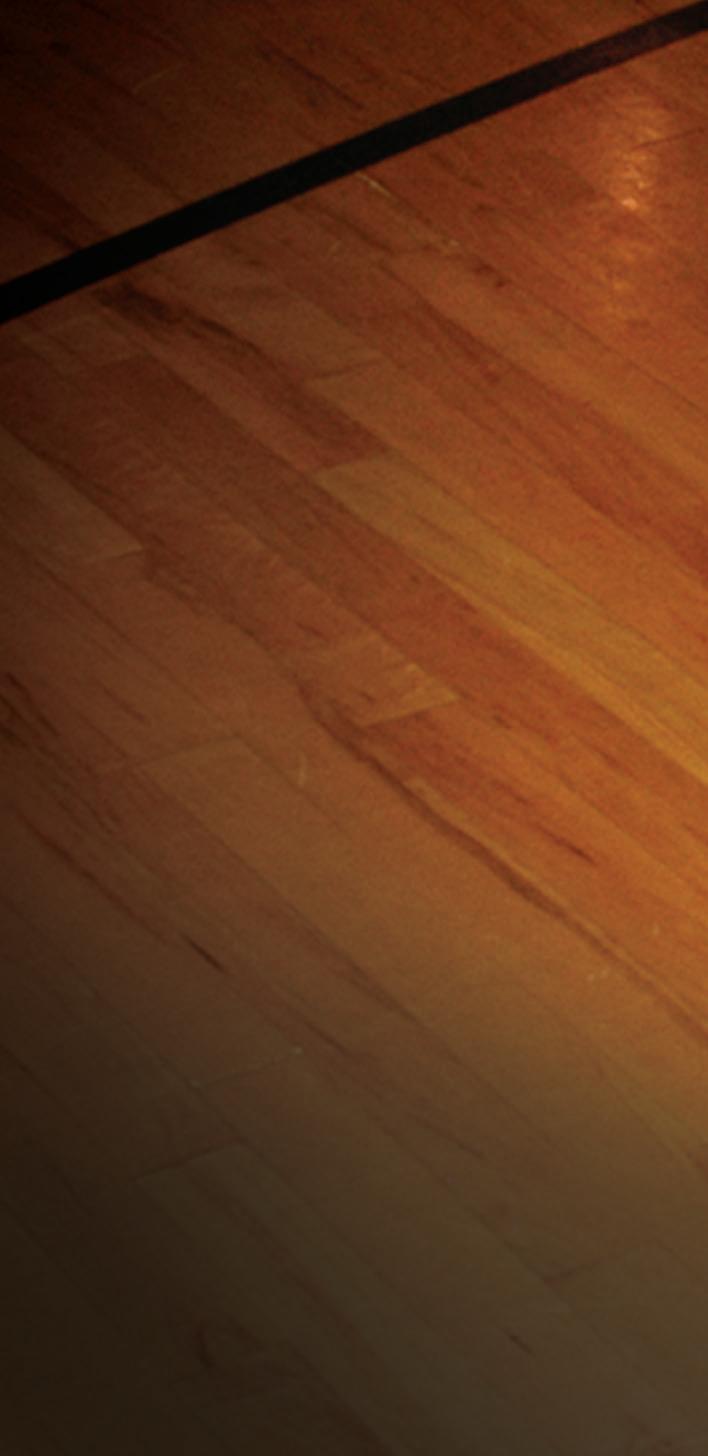


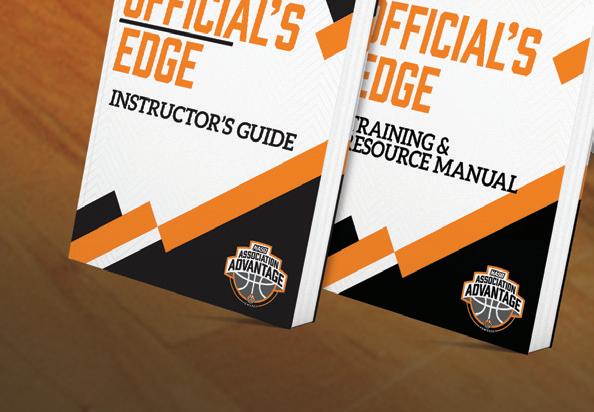








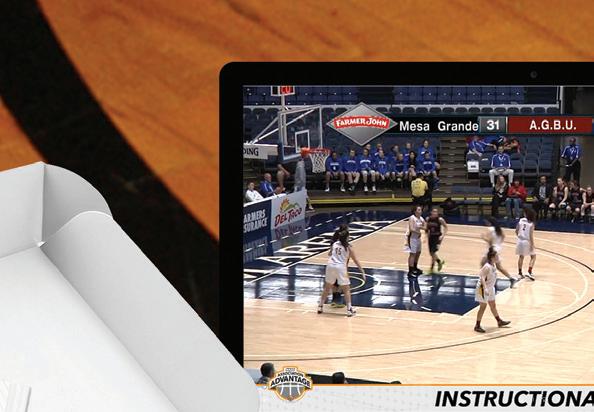
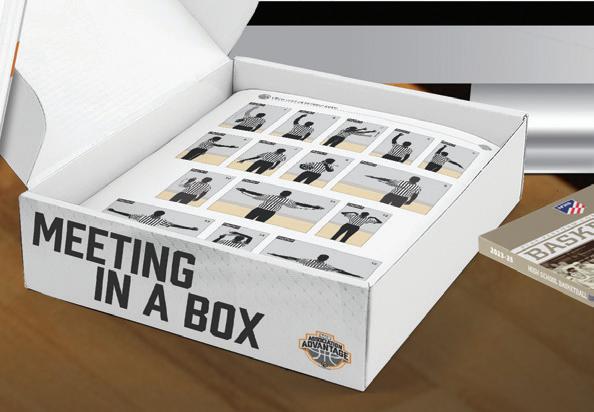
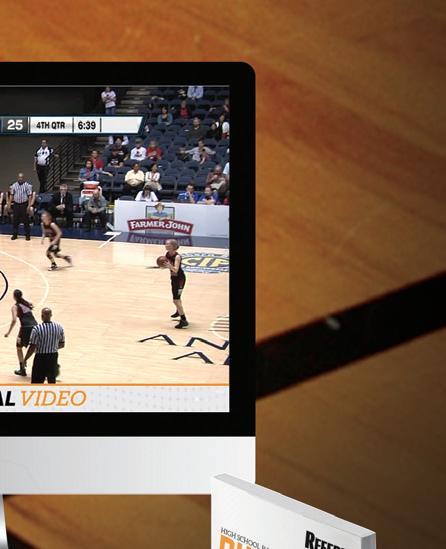


HOME SCORER & TIMER 2 T 5 4 3 5 2 1 1 3 4 L C A ALL IN ONE BOX YOUR ENTIRE TRAINING PROGRAM STORE. /basketball SPECIAL PRICE $ 750 • Pre-Built Meeting Lesson Plans • Industry-leading Mechanics Illustrated Manuals • Online & Traditional Testing For Every Lesson • Rules & Caseplays Together in Rules by Topic • Step-by-Step Instructor Guides • Video Breakdowns With Voice-Over & Graphic Enhancements
CASEPLAYS
Correctable Error
Play : A1 is fouled while dribbling the ball. Team A is not yet in the bonus, but A1 is erroneously awarded bonus free throws. Both free throws are successful. Team B inbounds the ball, B2 dribbles the ball into team B’s frontcourt, and then B2 commits a traveling violation. At this point, the officials discover A1 should have never been awarded free throws. Can this error be corrected?
Ruling : Awarding unmerited free throws is a correctable error. For the error to be corrected, it must be discovered during the first dead ball after the clock properly started following the error. The traveling violation is the first dead ball after the clock started following the unmerited free throws, so this error shall be corrected. A1’s free throws shall be canceled. Play is resumed with a throw-in at the point of interruption, so team A shall receive a throw-in at the spot where B2 committed the traveling violation (NFHS 2-101b, 2-10-2, 2-10-6; NCAAM/W 2-12.1.b, 2-12.2, 2-12.5).
Standing Up With the Ball
Play : A1 is dribbling the ball when defender B2 slaps the ball away. A1 goes after the ball, goes down to the floor and gains control of the ball with one knee on the floor. A1 then stands up while neither of A1’s feet move from the location they were when A1 was kneeling with one knee on the floor. Has A1 violated in standing up with the ball?
Ruling : In NFHS, it is a traveling violation if, after a player gains control of the ball, the player stands up. Therefore, A1 shall be called for a traveling violation (4-44-5b, 4.44.5B, 4.44.5C). In NCAAM/W, it is only a traveling violation when a player rises to their feet while holding the ball and moves the pivot foot in the process. Since A1 stood without moving a foot, A1 has not violated, and play shall continue uninterrupted (NCAAM 9-5.2, 9-5.7, AR 221; NCAAW 9-5.2, 9-5.7, AR 265).
the attempts, the center official observes the shooter and the trail is near the division line observing the remaining players (MechaniGram A on the previous page), keeping in mind the remaining nine players do not have to be on the opposite side of the division line, as many people incorrectly believe.
The next step is the transition from the completion of the free-throw sequence to the administration of the division-line throw-in. Because the ball is going to be put in play opposite the table, the officials must again move on the court (MechaniGram B). A common error is for the trail official to believe he or
she remains the trail, moving across the court to administer the throwin. This is not the correct mechanic. Instead, the official who was the center for the free throws should remain on that side of the court and move to the division line, becoming the new trail. The old trail slides down to the free-throw line extended and becomes the new center. The lead remains so, simply moving to the opposite side of the lane and balancing the floor. By precisely administering these situations, we can create a sense of confidence and credibility in a situation where these attributes can sometimes be in short supply.
By precisely administering these situations, we can create a sense of confidence and credibility in a situation where these attributes can sometimes be in short supply.
BASKETBALL 76 | REFEREE July 2024
HOME VISITOR SCORER & TIMER 1 2 T T 5 4 3 5 2 1 3 4 L L C C B

Too Late Too Little,
This two-shot photo sequence is a great example of why officials need to be able to see the start and finish of a play, and then accurately describe what they have witnessed when questioned by a coach about a ruling.
Let’s actually look at these photos which are shown in inverse order of the playing action to explain.
The coach of the team in white sees his defensive player in the position captured in the top photo and his first reaction if there is a foul ruling is going to be what? “My player is vertical and is doing nothing wrong.”
At this frozen moment in time the coach might be correct. The defensive player does appear to have both feet on the playing court, facing the defender, which would mean he has obtained (NFHS/NCAAW) or established (NCAAM) a legal guarding position. As we know, that is the first requirement in determining whether a player has next achieved the principle of verticality (NFHS 4-45; NCAAM 4-39; NCAAW 10-3).
The issue is, this clever maneuver by the defender to thrust his arms straight up in the air is nothing more than a well-disguised plea of innocence to cover up the misdeed captured in the bottom photo, which again, actually occurs first in the playing sequence. Even had the on-ball defender initially been in a legal guarding position, at this point the ballhandler appears to have his head and shoulders in advance of the defender, which would place the defender at greater responsibility for all contact (NFHS 10-78; NCAAM 10-1.11; NCAAW 10-10.12).
This photo certainly appears to show the defender making illegal contact, both with the hip-to-hip contact on the ballhandler and the swipe of the right arm near the ballhandler’s shoulder.
While “Start, Develop, Finish” is a mantra that’s understandably drilled into our heads when it comes to playcalling, it’s important to remember that a brilliant finish is not a license to ignore an ugly start. Don’t allow a player’s attempt to self-correct eliminate the need to put a whistle on the activity that created a need for correction in the first place.


REFEREE July 2024 | 77 HESTON QUAN
PROFILES
This Family Went to Court
By Leah Berard
Age Is Just a Number
Frank Foster Sheffield, United Kingdom
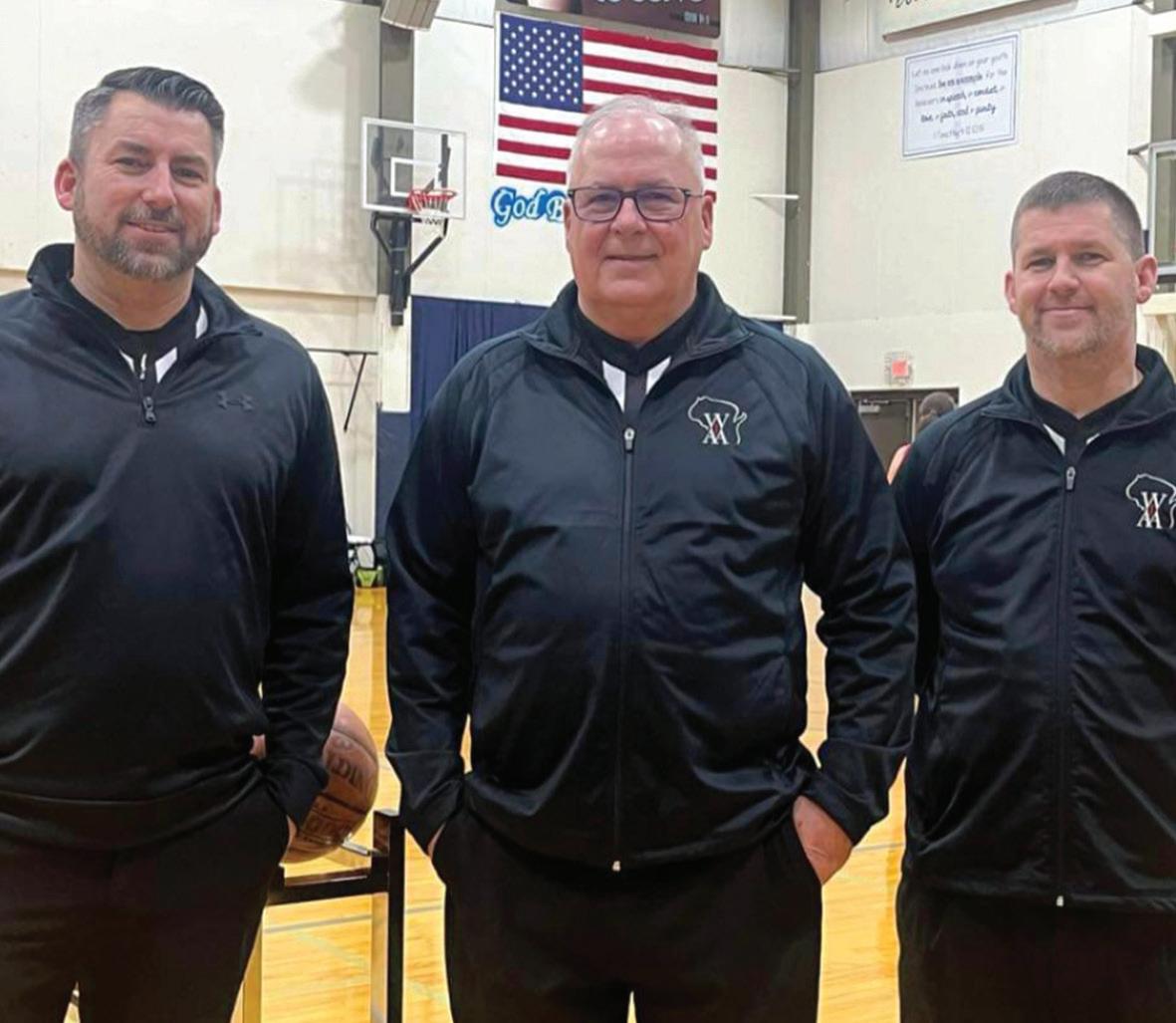
Afamily from the Wisconsin Rapids, Wis., area entered rare officiating company this past February. Dan Mancl and his sons, Adam and Aric, officiated a girls’ varsity basketball matchup between White Lake and Northland Lutheran. It was the first time the trio of family members had worked a game together. It also marked the first varsity assignment for Adam. Aric, Dan’s youngest son, was the force behind all of them ending up on the same court together — Aric persuaded his older brother to answer the call to fill the officiating shortage by becoming a basketball official last year. It was a natural progression for Adam, who had previously officiated youth basketball tournaments when he wasn’t tied up coaching his son’s youth team.
Dan originally started officiating in 1976 but stepped away when Adam and Aric were playing sports as youngsters. He got back into it about 20 years ago, happily doing middle school and JV games. Aric
started doing varsity games a few years ago and loved it so much he coaxed his dad back into working them as well. Aric said he initially got into officiating because of the extra income, but now it means more to him.
“I enjoy being a part of the game in a way that others can keep playing the game I love,” Aric said.
Although Aric was the driving force that led to them officiating together, none of it would have been possible without the supportive matriarch of the family, Carol. And the Mancl men consider the game one of the best moments of their lives.
“It was a special moment for all of us, including Mom,” Adam said.
Just as Aric and Adam have followed in their father’s footsteps by getting involved and giving back to sports through both coaching and officiating, the brothers hope their children will carry on the legacy.
For now, Dan is content officiating at the high school level. While Aric and Adam are also quite happy giving back to the game at their current level, neither ruled out future aspirations to officiate basketball at the collegiate level if it happens either before (in Aric’s case) or after (in Adam’s case) their kids get older.
“I got into officiating for the love of the game,” Dan said. That sentiment is echoed by his sons, and they hope to stay involved in both coaching and officiating for as long as their bodies allow them to keep going.
“I love sports and want to be involved in any way possible,” Adam said. “I am not one to enjoy the view from the stands, as I would rather be directly involved in the sports I truly love.”
Leah Berard, St. Paul, Minn., officiated international rugby and now officiates high school andcollege football.

Frank Foster has been refereeing grassroots soccer for 44 years. At 91, he says he can still keep up with the physical demands of the sport and plans to continue officiating for as long as he can.
“I just love (soccer), being out in the fresh air,” Foster said. “I’m going to continue. I’ve got no reasons or intentions of stopping.”
Foster has four children, nine grandchildren and three greatgrandchildren. His tips for those his age wanting to follow in his footsteps?
“Age is just a number,” he said. “Forget how old you are — do what you can as long as you can.”
SOURCE: BBC
Ice Climber

Ryan Parsons Boston
It has been a quick ascent through the officiating ranks for Ryan Parsons, who referees high school and college ice hockey in the Northeast. He got his start officiating intramural hockey, as well as several other intramural sports, while a student at Boston University (BU). After graduating in 2017 with a master’s in physical education and coaching, he became certified as an official by the NFHS and NCAA and is currently the manager of club and intramural sports at BU.
Parsons has worked his way up to Division I women’s hockey as well as D-II and D-III men’s hockey. Last Thanksgiving, he traveled to Washington, D.C., to referee a D-I women’s ice hockey tournament.
“I just hope to get better every year and continue on the success that started here at BU,” Parsons said.
SOURCE: BU TODAY
Do you know a person or group who should be profiled?
Send info to us at profiles@referee.com
PHOTO PROVIDED BY DAN MANCL
78 | REFEREE July 2024
PERSONALITIES PLUS
Dan Mancl (center) and his sons, Adam (left) and Aric, officiated a high school basketball game together in February.
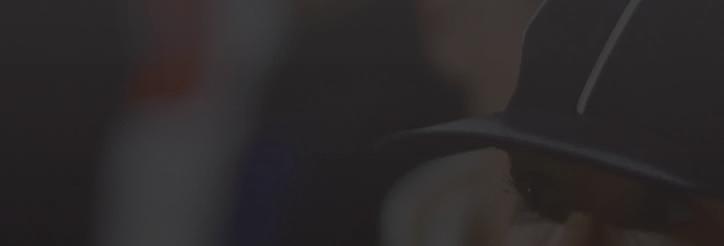






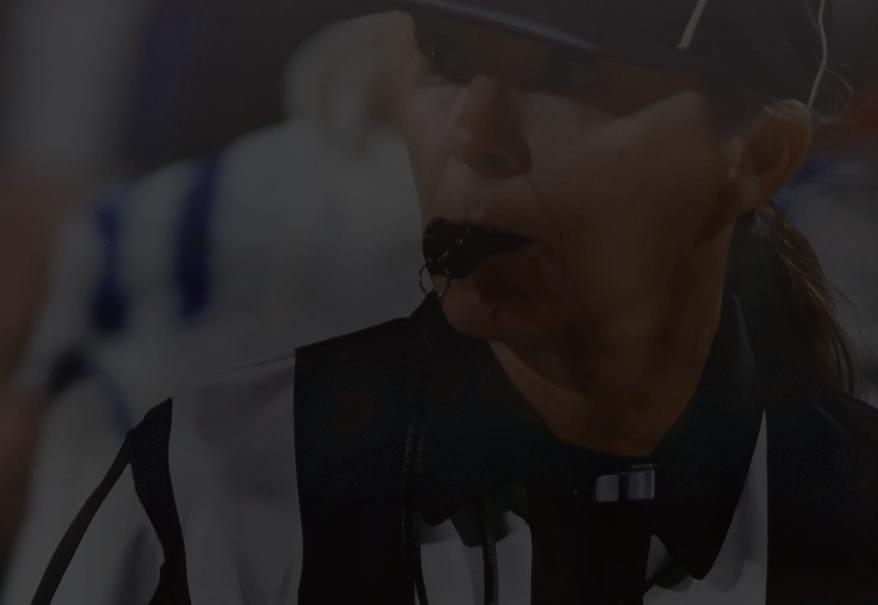







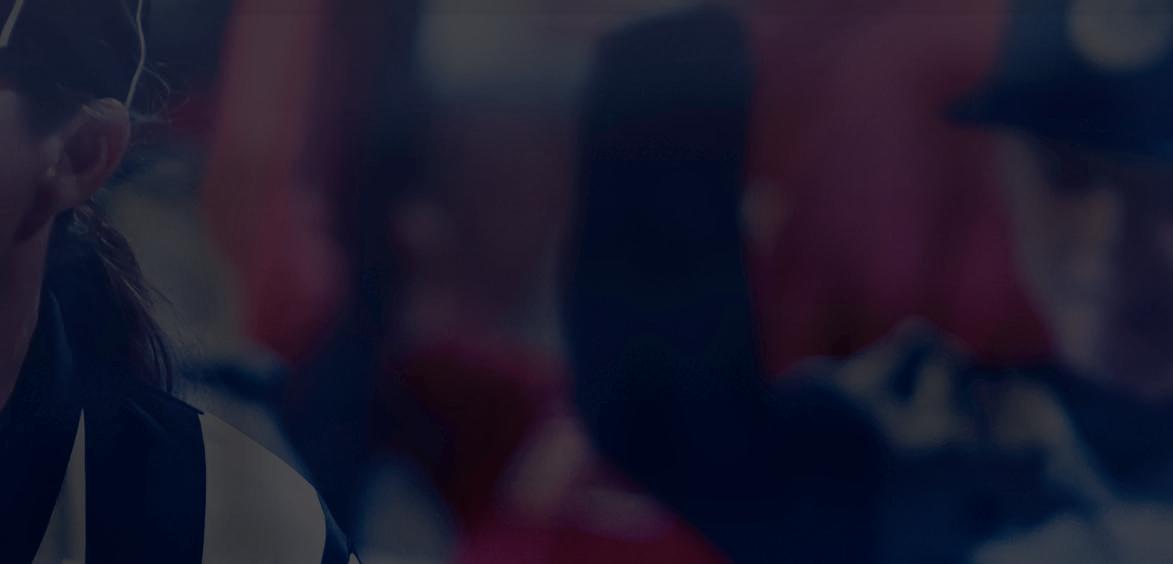







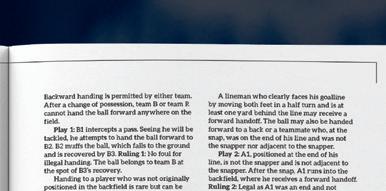


Full Color Photos & Diagrams






HandPicked Articles learn

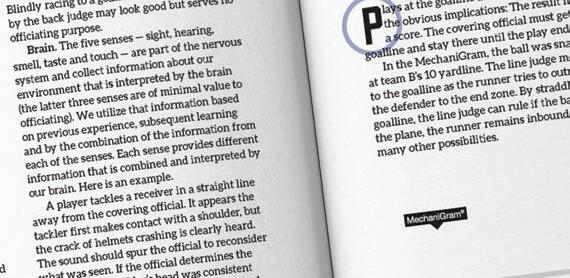
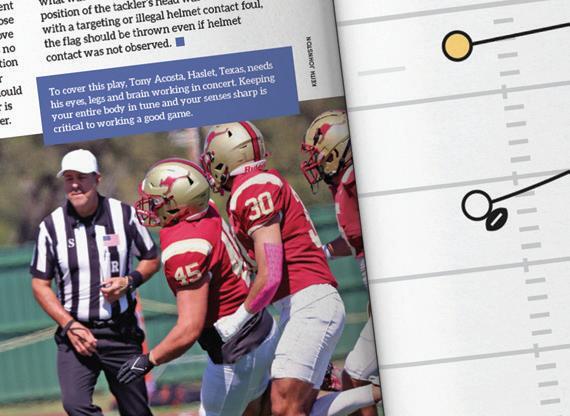







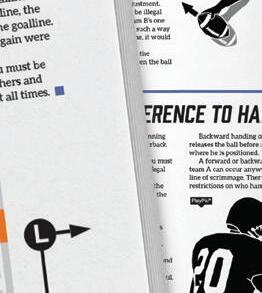
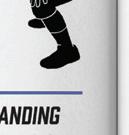

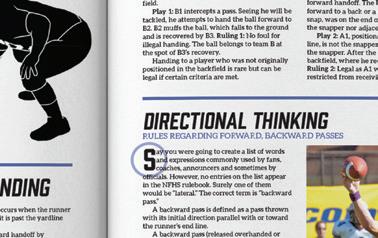









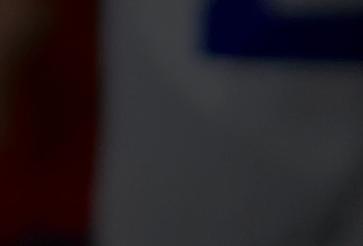

































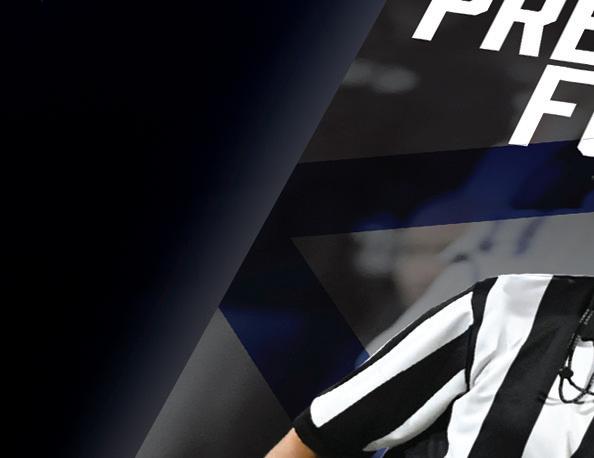













This is the comprehensive guide you need to be ready to work High School football this season. All new and recent rule changes broken down, Points of Emphasis clarified, and tough situations made simple – all in a full-color, magazine-sized annual guide. Includes hundreds of caseplays and quiz questions!

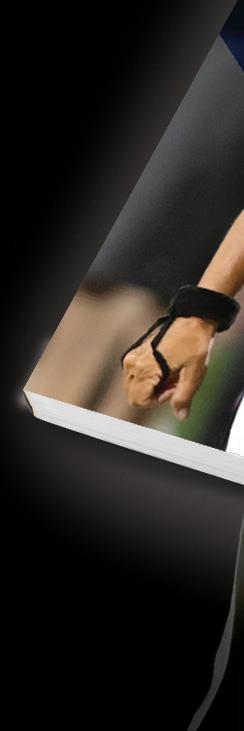




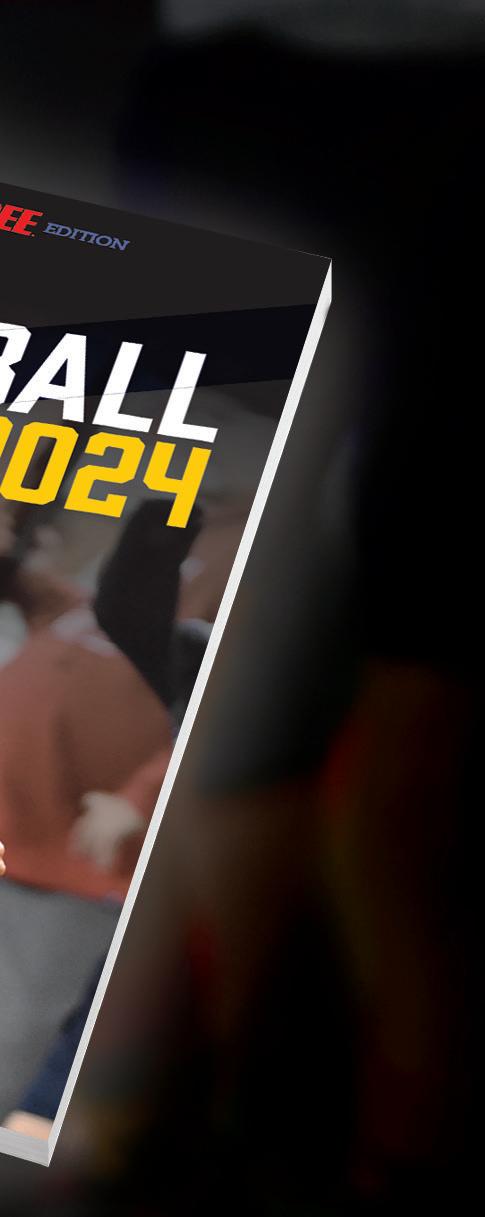


ANNUAL EDITION
Latest NFHS
Rules & Mechanics Changes
more at STORE. /FOOTball *NASO discount available. $1795 * DIGITAL PRINT $2395 COMBO $1895 * SIZE: 8”x11” PAGES: 96 COMPLETE GUIDE
NEW
TO FOOTBALL SEASON
for 2024
YOU ARE THERE
Let There Be Light
For years, all Chicago Cubs’ home games were played in daylight. That changed in the summer of ’88.
The day, Aug. 8, 1988, was one many Chicago Cubs fans had wanted to experience for more than 45 years. But world events, a stubborn owner as well as citizens and elected officials who lived near Wrigley Field fought to keep the oldest park in the NL lights-free.
By Dan Ronan
summer heat and dealing with coast-to-coast travel.
The Cubs were the last holdout for lights after the Detroit Tigers, who added them in 1948.



Along with new ownership came a new general manager, the swashbuckling and outspoken Dallas Green. He said the team’s loveable loser schtick was not to be tolerated.

The story begins in November 1941. Owner P.K. Wrigley planned to have lights installed for the 1942 season. That all changed with Japan’s bombing of Pearl Harbor. Wrigley quickly donated the equipment to the U.S. government to help the nation reindustrialize for World War II.


For the next 40-plus years, the team’s ownership strongly resisted efforts to put lights in Wrigley Field, saying 60-plus night games would severely impact the people who lived in the crowded Chicago neighborhood. Wrigley insisted baseball was meant to be played in the sunshine, even if it meant many of his players often said they were exhausted playing in the







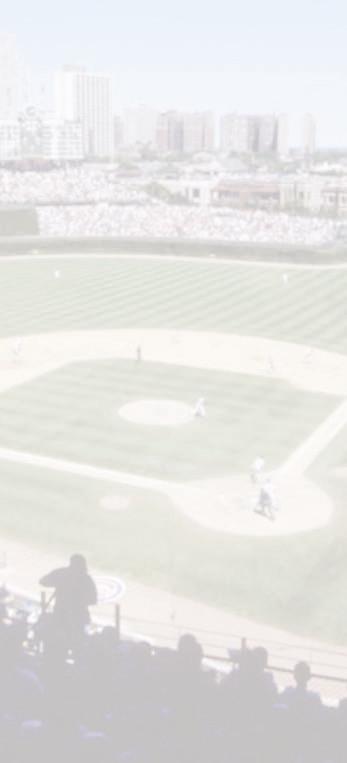
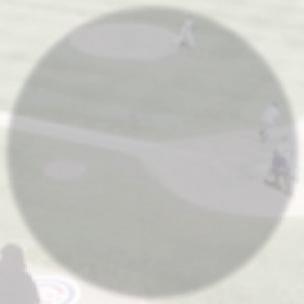


“I played all my home games under one light, God’s light,” Cubs Hall of Famer Ernie Banks told ESPN.com.




But in his 19 years in the big leagues, the much-beloved Banks never played in a playoff or World Series game. All other stadiums had lights and in 1971 MLB decided to start playing World Series games at night. The real impetus for lights may have come in 1981 when the Wrigley family sold the Cubs for $20.5 million to the Tribune Corp., which owned the so-called World’s Greatest Newspaper, cable superstation WGN-TV and WGN radio. Those entities had much of their marketing and overall identity tied to broadcasting the team’s games.











In an interview with ESPN.com, Green said, “The tradition and legacy of Wrigley Field and that area were difficult to overcome. What I tried to do was convince the community and the (county) commissioners that part of the reason the Cubs were not as successful as they should be was because they played allday baseball.”










MLB and the new owners wanted lights, especially if the Cubs made it to the playoffs again.
But like anything in Chicago, especially when politics are involved, change would not come easily.
Neighborhood activists, politicians with an agenda, a powerful media organization that now owned the team and MLB with a deep checkbook promised to make lights at Wrigley Field an epic struggle between the sides. Finally, after two years of negotiations and lawsuits, a compromise was reached for 18 night games each season, starting with eight in 1988. That deal has since been modified to allow more night games.
In spring and summer of 1988 — using helicopters to put the new lights on the roof — carpenters, electricians and other tradesmen spent months installing the towers and then wiring the bulbs to illuminate the historic playing field below.
80 | REFEREE July 2024
much 1981 owned so-called entit Aug. 8, 1988 general admission Wrigley Field Chicago, Illinois vs Philadelphia Phillies Chicago Cubs
On the historic day, umpires Larry Poncino, Eric Gregg, Dave Pallone and crew chief Jim Quick left their downtown hotel earlier than usual.
In 1988, Poncino was a Triple-A call-up, shuffling all summer between the NL and Pacific Coast League. “I was up and down,” Poncino said. “But I eventually made it to the big leagues a few years later.”
“It was a very big event,” said Pallone, who kept a ball from that game and still has it today. “It wasn’t quite on par with the playoffs, an All-Star game or World Series, but there was a real festive atmosphere and a lot of excitement surrounding the game. The park was packed, and even though you’re an umpire, you love the game of baseball
“Peter Ueberroth, the commissioner, and NL president Bart Giamatti came into the (umpires) room before the game
“In Chicago, in all the years I was in the league, we were always done by 4:30 or 5 p.m., and now we were coming to the park at that time and just beginning our day.”
Longtime Chicago Cubs fan, 91-year-old Harry Grossman, had the honor of flipping the switch to turn the lights on.
“The park went crazy,” Poncino said.
Poncino recalled that actor and comedian Bill Murray, a native of Chicago, and other celebrities were milling around the field.
Gregg (who died in 2006) had the plate, the last of a four-game series against the Philadelphia Phillies.
Poncino and Pallone recall that hours before the game started, forecasters were looking at the serious threat of a thunderstorm, yet the game started on time.
Cubs future Hall of Famer Ryne Sandberg hit a home run, but then the thunderstorms came, and the game had to be


stopped in the third inning.
Poncino recalls after Sandberg hit his home run, Morganna, the Kissing Bandit, ran onto the field before being escorted off the field.
“She ran right by me, then security guards stopped her,” Poncino said.
“Wrigley Field, with or without the lights, was my favorite park to work, and I loved working in Chicago.”
But nature was not on the side of the teams or the umpires.
“Then it began raining, and it came down in buckets in the third and fourth inning,” Pallone said. “We couldn’t get it into the fifth inning to make an official game. We went into our room and waited until it was called. They played a night game the next night, but the night before, 8/8/88, is what everyone remembers, even though it wasn’t official.
The rain continued, and after waiting several hours, the game was canceled.

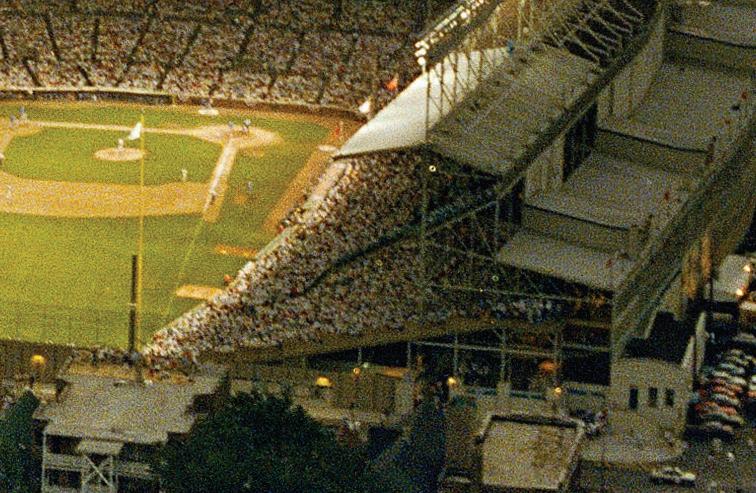
A site unseen before Aug. 8, 1988 — fans taking in a night game at Chicago’s Wrigley Field.
“People ask me what some of the highlights of my career were, and this was one of them. I enjoyed baseball, I enjoyed umpiring baseball, and this was right up there with the All-Star Game or a League Championship in terms of it being a great memory,” Pallone said. “It was a very special day, and I think history shows lights have been good for Wrigley Field.”
The official first night game was played the next day with a new team and a new umpiring crew. The Cubs beat the New York Mets, 6-4, before a full house of 36,399 fans. The game was handled by umpires Paul Runge, Charlie Williams, Joe West and Tom Hallion. But today, if you ask anyone in Chicago what the first night game was in Wrigley Field, without a doubt, they’ll tell you 8/8/88. Dan Ronan is a Washington, D.C.based journalist and retired small college basketball official, and NCAA baseball umpire.
REFEREE July 2024 | 81
ASSOCIATED PRESS
TARDY TO THE PARTY?
Get Yourself to the Game on Time — Every Time
 By the Referee editors
By the Referee editors
“Better late than never, but never better late.”
— Unknown
If you’ve officiated for any length of time in your area, you likely know an official with a reputation for being late.
According to psychologist Eric Endlich, “There are large cultural differences in expectations around punctuality.”
In some social circles, there is a phenomenon called “fashionably late.” In officiating, that fashion is bound to cause problems.
In order to get officials to be on time, one must first understand why they are chronically late. The value of time varies by forum. In the military, time is nearly absolute as it is in most educational institutions. Most professional appointments (doctors, dentists, etc.) allow a little flex, but not much.
Timeliness is more critical for shift work than it is for back-office operations, but employers vary. Some bosses don’t care as long as everything gets done when needed; others watch the clock like a hawk.
Almost every official has been and will be late to a game sometime.
In some cases, the only alternative is to turn back the game. For example, it’s highly unlikely an official who gets off work at 5:15 on Friday night can get to any stadium by 5:30 for a 7 p.m. game. However, 6 p.m. is within the realm of possibility. Such an official should discuss the situation with the crew chief before accepting the game. The choices are to work around the latearriving official or get someone else to work the game.
Those who are perpetually late have a long list of excuses.
“I forgot my (insert uniform part here) and had to go back.”
ALL SPORTS FOR ALL SPORTS, ALL LEVELS 82 | REFEREE July 2024 EDITOR: JEFFREY STERN jstern@referee.com
DALE
GARVEY
A firm, straight toss will help Jack Jones, Las Cruces, N.M., get this game off to a solid beginning. Arriving on time and handling business before the contest is also important for a successful assignment.
“Traffic was bad.” “I went to the wrong field.” “I had to stop for gas.” “The babysitter was late.” One official offered, “My wife was in a car accident.” It turned out she had pulled into the garage too fast and knocked a chunk of plaster out of the wall. Any of those can be true on a given day for just about anyone. That’s just the way it goes sometimes.
The real problem lies in those who are late time after time. The first thing to note is to see if an apology is offered. If one is not voluntarily offered, it is a sign the official either thinks tardiness is not a big deal or simply doesn’t care.
The underlying reasons for tardiness vary. One theory is planning and organizing are managed in the brain’s frontal lobes, which are among the last to develop. That means the ability to be punctual doesn’t peak until development is complete. The latest estimate of that is somewhere around age 25, so it doesn’t apply to most officials.
People with attention deficit hyperactivity disorder are often easily distracted and have difficulty being punctual, even though they may fully intend to be on time. Most often though, it’s simply a matter of priorities — their time is more important than anyone else’s. Rarely will they be confrontational and say pregame discussions are a waste of time — the same stuff every time. Endlich also says tardiness could be part of a rebellious personality or a passive-aggressive streak that makes them feel they shouldn’t have to conform to someone else’s schedule.
The good news is tardiness, like any habit, can be changed. However, no change will occur unless Johnny Come Lately wants to change. Any effort to bring out change should begin with an explanation of the image the tardy official has created and the impact of that official’s delayed arrival. “We enjoy having you on the crew. You do good work in the games, but we always get off to a bad start because you are late.”
You can also appeal to that official’s sense of pride. “When
you’re late it makes people think you are flaky or overwhelmed.”
If those don’t work, you might suggest technological reminders. Most smart phones have appointment calendars. You might go so far as calling the person at about the time that official should be leaving for the game. Scolding said official is not likely to work. Success will be enhanced with a positive tone of encouragement.
If all else fails, you can jack up the arrival time by 15-30 minutes. Of course, that won’t work for in-town games when there is a traditional arrival time, but it can work for road trip s.
Benefits of early arrival. Getting to the venue early or at least on time has multiple benefits. The most obvious is the opportunity to conduct a pregame meeting. It’s a chance to put the workday in the rearview mirror and start focusing on the job at hand.
When it’s time to enter the field or court, do it as a crew. It indicates a united front and professionalism.
If the rules of your sport require a pregame meeting with each head coach, be thorough but be brief. Don’t spend more time with one coach than the other, which gives an impression of favoritism.
Meet with scorers, timers, chain crew members, etc., as appropriate. Make them feel a part of the officiating crew. If the stuff hits the fan, they may be the only ones who can bail you out, so don’t take them for granted.
Observe the players before play begins. If you see a player is missing required equipment or a part of his or her uniform is illegal, bring it to the coach’s attention before it becomes an issue in the game.
Check the field or playing area for irregularities or potential dangers. Are equipment carts too close to the field? Are metal posts properly padded? Are the markings correct?
All of that can be accomplished if you’re on time. Not to mention what you can do if you’re early.
QUICKTIP
It’s not uncommon for officials to offer advice to those with whom they work. It might be what to do; it might be what not to do. But a tip that works for one official — particularly a wily veteran — may not work for you. Don’t let another official embarrass or bully you into mechanics or rule interpretations you know are contrary to the manual or rulebook. Make up your own mind. It may help to ask other officials for input. But ultimately the decision is yours.
THEY SAID IT
“… You could be having a casual conversation with somebody and all they’re trying to do is get some information out of you. We are on alert. I don’t tell people where I’m going, who I’m reffing. I don’t talk about players, the game, I don’t talk about any of that.”
— Chris Rastatter, NCAA national coordinator of men’s basketball officials, on how legalized gambling has made it inadvisable for referees to share information about teams, games and assignments
SOURCE: ESPN.COM
DID YOU KNOW?
If you’re looking to add a sport, how about octopush? More commonly known as underwater hockey, the sport is played in more than 30 countries including the U.S. Two or three referees in full snorkeling gear observe play at the pool bottom. One or more poolside deck referees track playing and penalty times and call fouls such as excessive number of players in play or failure to start a point from the end of the playing area. The deck referee responds to hand signals given by the water referees to start and stop play, including after an interruption such as a foul or timeout, or stops play if they themself see a rule infringement. If interested, check out waunderwaterhockey.com.

REFEREE July 2024 | 83 PHOTO COURTESY OF BUZZWORDSGT
Confidence? Yes; Ego? No
By the Referee editors
Confidence is not a suggestion when it comes to being good in this avocation. It is at the core of what it takes to be a good official in any sport at any level.
Rarely will you see timid officials succeed. Experiences and knowledge help create that confidence. As officials get more comfortable, they often acquire a bit of an edge. It’s a natural progression.
However, that edginess can quickly turn into arrogance, which can be a big turn off to the people you work with and for. So how do you toe the line?
Walk the talk. If you are going to carry yourself as if you know it all, have the knowledge to back it up. There are plenty of people who think they know rules, mechanics and philosophies in their sport.
Know them and how to apply them. Knowledge helps to create legitimate confidence that surpasses the qualities of the arrogant. You can only sweet talk your way through situations for so long without actually knowing before the people around you catch on.
Listen. A really quick way to show you care about anyone other than yourself is to stop talking. Just listen. You may have more experience than anyone in the room but that doesn’t mean you can’t learn something new.
Even if your partners have nothing to offer you, listening goes a long way in establishing crewness with the person or people with whom you are working.
When it comes to building rapport with coaches, sometimes all they want and need is for you to listen. Not every interaction with a coach has to be a give-and-take. Sometimes the message is subtle. If you don’t listen, you’ll miss it. And the next time the coach may not be as helpful.
Know your audience. There are new officials who want to learn everything they possibly can from you. There are officials who are

perfectly content with where they are and don’t particularly care what you have to say. That’s OK! Don’t waste your time and energy forcing your knowledge on people who don’t want to hear it.
You can easily tell if someone is engaged through body language and response to what you are saying. Talking to a partner or coach who doesn’t want to listen is a sure way to make them feel that you think you are better than they are whether you mean to or not.
Learn from mistakes. Perfection is unattainable, yet we continue to pursue it. Knowing when you’re wrong is important, but accepting when you’re wrong is the difference maker. Don’t be a repeat offender! If you can help someone learn from something you did wrong, you are helping the entire officiating community get one step closer to that, albeit unattainable, goal of perfection.
Be yourself. Nobody wants to be known as “that official.” You know
the one, the know-it-all, Mr. or Ms. Perfect, the one whose ego can’t fit in the locker room or the official who can’t stop talking about how great he or she is.
Just as officials can suffer because they don’t have enough belief in themselves, others pay the price for having too much, or worse, the wrong kind of belief in themselves. There’s a huge difference between having a rock-solid ego and being obnoxiously arrogant. Ironically, it’s often the folks who try to come off as know-it-alls who really have the most self-doubt.
The reality is all people have unique sets of qualities they bring to the game and their crew (if applicable). Trying to be someone you’re not will quickly catch up with you.
Use your confidence wisely. It’s important to manage that confidence and use it for the good of the game. Remember, what you do is louder than what you say. Don’t let your confidence turn into cockiness.
ALL SPORTS 84 | REFEREE July 2024
DALE GARVEY
Whether it’s uncertainty about a ruling or seeking help on a play, doing what is right is more important than who got it right. Jordan Truppner, Everett, Wash. (left), and Chris Castro, Puyallup, Wash., discuss a ruling from the previous inning.
When You’re the Stronger Official
The excitement of getting an important assignment can be dampened when you discover your partner is lacking some skills.
Still, the game goes on and the officials must put their best effort forward. Here are a few situations that can occur or apply in games where you are working with someone you perceive to be a weak partner.
Making calls in your partner’s area. Whether you believe your partner did not see a play or just didn’t make a call for whatever reason, you’ve seen an infraction and decide to make the long-distance call.
While that can be technically correct, you’ve damaged your partner’s ability to call the rest of the game and possibly his or her credibility with both coaches.
Concentrate on making the calls that are your responsibility and don’t try to do the job of multiple officials.
Play coverage. As officials move up the ladder, they are usually getting their first exposure to working with more officials on the court or field. The first time most baseball or softball umpires work the three-umpire system is in the state tournament. The same goes for a crew of six or seven football officials.
One pregame topic to cover could be, what happens when a play isn’t covered? All officials need to be aware of what is happening on the field or court and either alert the partner who’s responsible for the play to cover it or fill the gap and deal with the mechanics flaws in a postgame discussion.
Changing rulings. By rule in

most sports, one official cannot substitute his or her judgment for that of another official.
But if you have definite knowledge a ruling is incorrect, you can go to that official, provide information and work with him or her to change the call. But the calling official most often signals and makes the change.
One of the most rewarding things to be a part of in officiating is seeing that weaker official have success in a big game and gain confidence.
Going into the game with confidence and having a detailed pregame discussion can set a tone that will enable that official to focus and not worry about impressing the coaches, players or you. Their actions will do that and hopefully they will gain the confidence necessary to face future challenges.
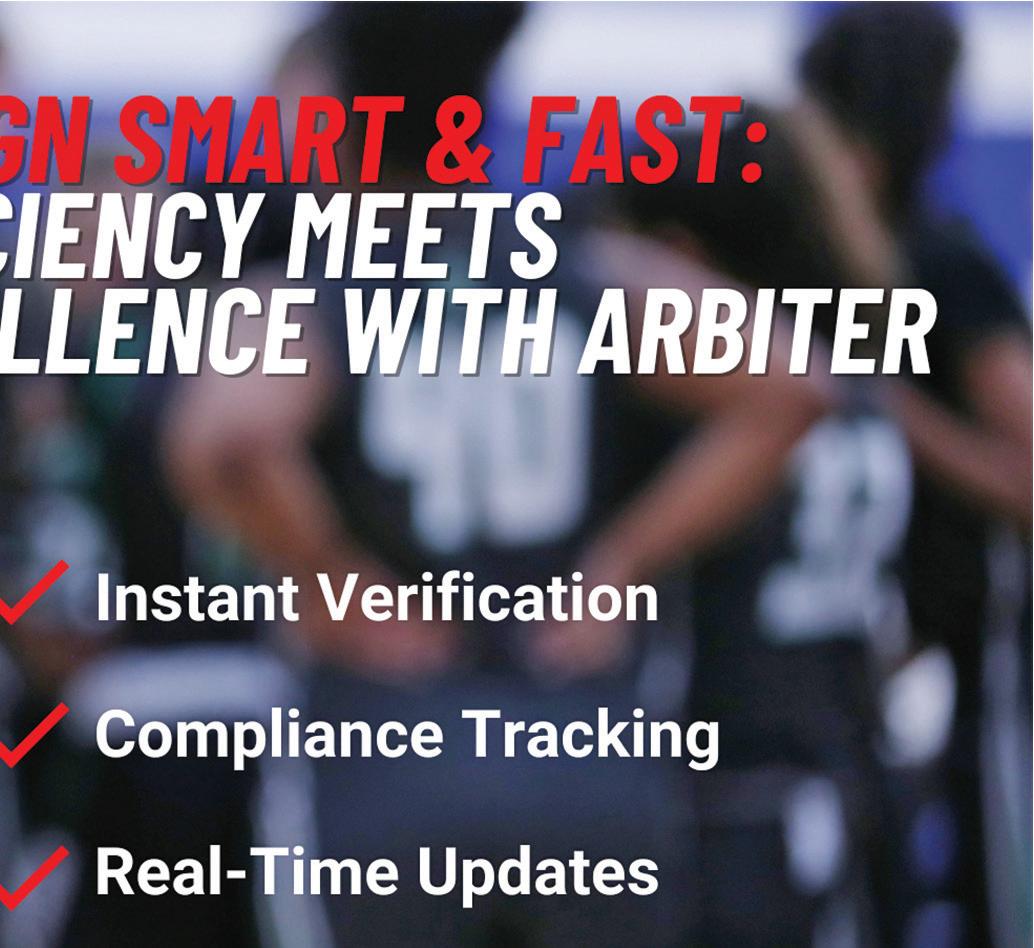

REFEREE July 2024 | 85
FOR THE RECORD
AWARDS, ROSTERS, NOTABLES
POSTSEASON ASSIGNMENTS
COLLEGE
•South Carolina defeated Iowa, 87-75, to win the NCAA Division I women’s basketball championship. Officials were Brenda Pantoja, Joe Vaszily and Angelica Suffren. Final Four officials were Melissa Barlow, Eric Brewton and Tiffany Bird (South Carolina 78, NC St. 59) and Gina Cross, Katie Lukanich and Roy Gulbeyan (Iowa 71, UConn 69). Other tournament assignments: First Four — Presbyterian 49, Sacred Heart 42: Cross, Roy Jackson, Scott Berkins. Holy Cross 72, UT Martin 45: Kevin Pethtel, Adrienne Gilmore-Nichols, Ryan Durham. Arizona 69, Auburn 59: Vaszily, Lukanich, Benny Luna. Vanderbilt 72, Columbia 68: Pualani Spurlock-Welsh, Angel Kent, Sarah Williams. First round — South Carolina 91, Presbyterian 39: Billy Smith, John Capolino, Deanna Jackson. North Carolina 59, Michigan St. 56: Cross, Rod Creech, Mark Berger. Oklahoma 73, FGCU 70: Felicia Grinter, Doug Knight, Marla Gearhart. Indiana 89, Fairfield 56: Gulbeyan, Angie Enlund, David Troyan. Nebraska 61, Texas A&M 59: Maggie Tieman, Tim Daley, Carla Fountain. Oregon St. 73, Eastern Washington 51: Lisa Jones, Darren Krzesnik, Ty Bills. Ole Miss 67, Marquette 55: Fatou Cissoko-Stephens, Teresa Stuck, Meadow Overstreet. Notre Dame 81, Kent St. 67: Bruce Morris, Tim Bryant, Cara Seggie. Texas 82, Drexel 42: Brewton, Kim Hobbs, Nic Cappel. Alabama 82, Florida St. 74:
Maj Forsberg, Toni Patillo, Brandon Enterline. Utah 68, South Dakota St. 54: Pantoja, Felicity Willis, Nick Marshall. Gonzaga 75, UC Irvine 56: Kyle Bacon, Ashley Ellis, Sean Martin. Tennessee 92, Green Bay 63: Suffren, Royce Blevins, Metta Christensen. NC St. 64, Chattanooga 45: Karen Preato, Ed Sidlasky, Suffren. Iowa St. 93, Maryland 86: Jesse Dickerson, In’Fini Robinson, Charles Gonzalez. Stanford 79, Norfolk St. 50: Julie Krommenhoek, Richard Waters, Tashianna Smith. Iowa 91, Holy Cross 65: Pethtel, Natosha Harris, Durham. West Virginia 63, Princeton 53: Cameron Inouye, Nykesha Thompson, Brian Woods. Colorado 86, Drake 72: Bird, Brian Garland, Zac Brost. Kansas St. 78, Portland 65: Michael McConnell, Teresa Turner, Marc Merritt. Middle Tennessee 71, Louisville 69: Dee Kantner, Tyler Trimble, Scott Yarbrough. LSU 70, Rice 60: Talisa Green, Eric Koch, Kristen Bell. Creighton 87, UNLV 73: Barlow, Saif Esho, Nicole Leon. UCLA 84, California Baptist 55: Michol Murray, Scott Osborne, Lorena Ahumada. USC 87, Texas A&M-CC 55: Michael Price, Cheryll Blue, Travis Jones. Kansas 81, Michigan 72: Brian Hall, Ify Seales, Alecia Ann Murray. Baylor 80, Vanderbilt 63: Spurlock-Welsh, Bill Larance, Ashley Olsen. Virginia Tech 92, Marshall 49: Tiara Cruse, Kylie Galloway, Kelsey Reynolds. Syracuse 74, Arizona 69: Lukanich, Kenneth Nash, Kevin Sparrock. UConn 86, Jackson St. 64: Vaszily, Tom Danaher, Chastity Taylor. Duke 72, Richmond 61: Mark Resch, Ashlee Goode, Jeffrey Smith. Ohio St. 80, Maine 15: Natasha Camy, Timothy Greene, Gina Catanzariti.

Second round — South Carolina 88, North Carolina 41: Cross, Billy Smith, Creech. Indiana 75, Oklahoma 68: Grinter, Gulbeyan, Enlund. Oregon St. 61, Nebraska 51: Jones, Tieman, Krzesnik. Notre Dame 71, Ole Miss 56: Cissoko-Stephens, Morris, Stuck. Texas 65, Alabama 54: Forsberg, Brewton, Hobbs. Gonzaga 77, Utah 66: Pantoja, Bacon, Ellis. NC St. 79, Tennessee 72: Suffren, Preato, Sidlasky. Stanford 87, Iowa St. 81: Dickerson, Krommenhoek, Robinson. Iowa 64, West Virginia 54: Inouye, Pethtel, Thompson. Colorado 63, Kansas St. 50: Bird, McConnell, Garland. LSU 83, Middle Tennessee 56: Kantner, Green, Trimble. UCLA 67, Creighton 63: Barlow, Michol Murray, Esho. USC 73, Kansas 55: Hall, Alecia Ann Murray, Seales. Baylor 75, Virginia Tech 72: Spurlock-Welsh, Cruse, Larance. UConn 72, Syracuse 64: Vaszily, Lukanich, Nash. Duke 75, Ohio St. 63: Camy, Resch, Greene.
Sweet Sixteen — South Carolina 79, Indiana 75: McConnell, Jones, Tieman. Oregon St. 70, Notre Dame 65: Vaszily, Michol Murray, Thompson. Texas 69, Gonzaga 47: Dickerson, Garland, Turner. NC St. 77, Stanford 67: Suffren, Krzesnik, Morris. Iowa 89, Colorado 68: Kantner, Daley, Nash. LSU 78, UCLA 69: Bird, Billy Smith, Greene. USC 74, Baylor 70: Barlow, Pethtel, Inouye. UConn 53, Duke 45: Brewton, Preato, Cissoko-Stephens.
Elite Eight — South Carolina 70, Oregon St. 58: Grinter, Green, Trimble. NC St. 76, Texas 66: Cross, Lukanich, Robinson. Iowa 94, LSU 87: Pantoja, Camy, Gulbeyan. UConn 80, USC 73: Forsberg, Bacon, Hall.
•UConn defeated Purdue, 75-60, to win the NCAA Division I men’s basketball championship. Officials were Jeffrey Anderson, Roger Ayers and Terry Oglesby Final Four officials were Keith Kimble, Kipp Kissinger and Mike Reed (Purdue 63, NC St. 50) and Ron Groover, Pat Adams and Paul Szelc (UConn 86, Alabama 72). Other tournament assignments:
First Four — Wagner 71, Howard 68: Adams, Darron George, Andy O’Brien. Colorado St. 67, Virginia 42: Kimble, Kelly Pfeifer, Ed Corliss. Grambling St. 88, Montana St. 81: Jeffrey Anderson, Kevin Brill, Chris Pasci. Colorado 60, Boise St. 53: Michael Irving, Robert Riley, Stephen Divine. First round — Michigan St. 69, Mississippi St. 51: Oglesby, Tim Clougherty, Edwin Young. North Carolina 90, Wagner 61: Tommy Morrissey, Verne Harris, Michael Palau. Texas 56, Colorado St. 44: Jeff Clark, Nate Harris, Brett Smith. Tennessee 83, St. Peter’s 49: Doug Sirmons, Greg Evans, Jemel Spearman. Duquesne 71, BYU 67: Pat Driscoll, K.B. Burdett, Sean Hull. Illinois 85, Morehead St. 69: Adams, Chance Moore, Mark Schmur. Iowa St. 82, South Dakota St. 65: Earl Walton, Gerry Pollard, Mike Littlewood. Washington St. 66, Drake 61: Don Daily, Randy Richardson, Tyler Kumpf. Creighton 77, Akron 60: Ray Natili, Pfeifer, Evon Burroughs. Oregon 87, South Carolina 73: Gregory Nixon, Byron Jarrett, Brandon Cruz. Oakland 80, Kentucky 76: Brian Dorsey, Steve Anderson, D.G. Nelson. NC St. 80, Texas Tech 67: Tony Chiazza, George, Lucas Santos. Arizona 85, Long Beach St. 65: Kimble, Nathan Farrell, John Floyd. Dayton 63, Nevada 60: Brent Hampton, Randy McCall, Chuck Jones. Gonzaga 86, McNeese 65: Brooks Wells, Brian O’Connell, Patrick Evans. Kansas 93, Samford 89: Tony Padilla, Lamar Simpson, Wil Howard. Northwestern 77, Florida Atlantic 65: Reed, Antinio Petty, Justin Porterfield. UConn 91, Stetson 52: Courtney Green, Tony Henderson, Mike Nance. Duke 64, Vermont 47: Irving, Riley, Steve McJunkins. James Madison 72, Wisconsin 61: Joe Lindsay, Todd Austin, Bill Covington. Baylor 92, Colgate 67: Marques Pettigrew, Bart Lenox, Tim Smith. Clemson 77, New
Do you have any rosters, assignments or
86 | REFEREE July 2024
Designate NASO as a beneficiary of your retirement plan or life insurance policy. LEARN MORE AT NASO.ORG/LEGACY OR CALL 800-733-6100
mention?
to
at ForTheRecord@referee.com
awards that warrant
Send info
us
Mexico 56: Lee Cassell, Deidre Carr, Brian McNutt. Texas A&M 98, Nebraska 83: Jeffrey Anderson, Jeb Hartness, Rick Crawford. Houston 86, Longwood 46: James Breeding, Ted Valentine, Rob Rorke. San Diego St. 69, UAB 65: Kissinger, Vladimir VoyardTadal, Chad Barlow. Yale 78, Auburn 76: DJ Carstensen, Brill, Bharat Ramnanan. Alabama 109, Charleston 96: Szelc, Matt Potter, Tommy Nunez. Grand Canyon 75, St. Mary’s 66: Groover, Olandis Poole, Amy Bonner. Marquette 87, Western Kentucky 69: John Gaffney, Michael Greenstein, Alfred Smith. Colorado 102, Florida 100: Bert Smith, Owen Shortt, Eric Curry. Purdue 78, Grambling St. 50: Doug Shows, AJ Desai, Jason
ROSTERS
Baker. Utah St. 88, TCU 72: Ayers, Anthony Jordan, Scott Brown.
Second round — North Carolina 85, Michigan St. 69: Sirmons, Clark, Nate Harris. Tennessee 62, Texas 58: Oglesby, Morrissey, Verne Harris. Iowa St. 67, Washington St. 56: Adams, Driscoll, Burdett. Illinois 89, Duquesne 63: Daily, Walton, Richardson. NC St. 79, Oakland 73: Natili, Nixon, Jarrett. Creighton 86, Oregon 73: Dorsey, Chiazza, Steve Anderson. Arizona 78, Dayton 68: Padilla, Wells, O’Connell. Gonzaga 89, Kansas 68: Kimble, Hampton, Farrell. UConn 75, Northwestern 58: Lindsay, Irving, Covington. Duke 93, James Madison 55: Green, Henderson, Reed. Clemson 72, Baylor 64: Jeffrey
2023 Minor League Baseball Rosters
Here are the umpire rosters for the full-season minor leagues.
Single-A
CALIFORNIA LEAGUE
Drew Boffeli
Caden Gustafson
Chad Lagana
Gerritt Nelson
Jonathan Rector
Jeremy Rodda
Joshua Runge
Gabe Vargas
CAROLINA LEAGUE
Theo Arndt
Robert Bonet
Gustavo Garza
Tyler Green
Dereck Pacheco
William Paschal
Dylan Reaves
Liana Rix
Dominic Romero
Andrew Schrock
Brandon Spevak
Perry Swartz
FLORIDA STATE LEAGUE
Richy Arredondo
Michael Cross
Zach Hovick
Frank Jones
Kameron Jones
Jarred Neal
Larry Pettis
Pedro Powell
Gina Quartararo
Pedro Torres
High-A
MIDWEST LEAGUE
Evan Anderson
Cas Cousins
Ian Durkin
Shin Koishizawa
Tatum Littleton
Conor McKenna
Rafael Pineda
Travis Roberson
David Saball
Brandon Schmitt
Alex Shears
Nobuoki Yasuta
NORTHWEST LEAGUE
Tim Barreras
Jabril Geter-Abdulah
Nathan Hall
Tyler Hovick
Spencer Kim
Isabella Robb
SOUTH ATLANTIC LEAGUE
Jamal Allen
Christian Argueza
Blake Bizon
Travis Brewer
Connor Crowell
Davion Frye
Stone Garver
Anderson, Breeding, Lenox. Houston 100, Texas A&M 95: Pettigrew, Cassell, Hartness. San Diego St. 85, Yale 57: Groover, Szelc, Potter. Alabama 72, Grand Canyon 61: Kissinger, Carstensen, Voyard-Tadal. Marquette 81, Colorado 77: Ayers, Shows, Desai. Purdue 106, Utah St. 67: Bert Smith, Gaffney, Greenstein.
Sweet Sixteen — Clemson 77, Arizona 72: Bert Smith, Hampton, Hartness. Alabama 89, North Carolina 87: Reed, Gaffney, Steven Anderson. Illinois 72, Iowa St. 69: Kissinger, Green, Cassell. UConn 82, San Diego St. 52: Ayers, Clark, Henderson. NC St. 67, Marquette 58: Adams, Walton, Driscoll. Duke 54, Houston 51: Jeffrey Anderson, Daily, Chiazza. Tennessee 82,
Creighton 75: Lindsay, Padilla, Potter. Purdue 80, Gonzaga 68: Szelc, Greenstein, Desai. Elite Eight — Alabama 89, Clemson 82: Kimble, Dorsey, Breeding. UConn 77, Illinois 52: Oglesby, Shows, Jarrett. NC St. 76, Duke 64: Sirmons, O’Connell, Irving. Purdue 72, Tennessee 66: Groover, Natili, Pettigrew.
OBITUARIES
• Richard Kirby, 61, of Bensalem, Pa., died Dec. 23, 2023. He was a basketball referee with the PIAA for over 40 years and also officiated at the youth, adult and collegiate levels.
Justin Hopkins
Dylan Hulsey
John Miller
Shane Sullivan
Trey Ward
Double-A
EASTERN LEAGUE
Joe Belangia
Matt Blackborow
Jesse Bush
Johnny Conrad
Jared Duerson
Jon Forster
Nelson Fraley
Robert Ginther
Ethan Gorsak
Garret Griffin
Kevin Mandzuk
Kellen Martin
Chad Patterson
Paul Roemer
Josiah Shepherd
Mitch Trzeciak
Charlie Welling
Zee Zdenek
SOUTHERN LEAGUE
Sean Cassidy
Denver Dangerfield
Chandler Durham
Warren Eubanks
Jaylen Goodman
Tre Jester
Kaleb Martin
Joe McCarthy
Elliott Melton
Thomas O’Neil
Nicolas Schmittou
Chad Westlake
TEXAS LEAGUE
Daniel Bytheway
Nathan Diederich
Benjamin Engstrand
Justin Juska
Trevor Mathews
Trevor Patience
Chris Presley-Murphy
Steven Rios
Mickey Smith
Austin Snow
Sean Sparling
Kyle Stutz
Brandon Tipton
Jack Wason
Clay Williams
Triple-A
Harley Acosta
David Arrieta
Reed Basner
Mark Bass
Jhonatan Biarreta
Dylan Bradley
Matt Brown
Trevor Dannegger
Tanner Dobson
Thomas Fornarola
Darius Ghani
Macon Hammond
Luis Hernandez
Aaron Higgins
Steven Hodgins
Casey James
Steven Jaschinski
James Jean
Edwin Jimenez
Evin Johnson
Austin Jones
Terrence Jones
Tyler Jones
Dexter Kelley
Louie Krupa
Chris Marco
Andy McPherson
Jacob Metz
Tanner Moore
Felix Neon
Preston Norton
Ray Patchen
Jen Pawol
Anthony Perez
Ben Phillips
Dane Poncsak
Mike Rains
Mark Stewart
Pete Talkington
Willie Traynor
Ray Valero
Bryan Van Vranken
Kelvis Velez
Dillon Wilson
Matt Winter
REFEREE July 2024 | 87
LAW ISSUES AFFECTING OFFICIALS
Eight to Replicate
By Alan Goldberger
As readers of this magazine know well, it’s not enough to simply know the rules. Today’s playing rules and interpretations are often modified or set aside by the operation of conference, sports governing body or associationimposed exceptions to the rules — and by state laws and administrative regulations. To reduce the chances a legal issue in your next game may ruin your day, let’s look at the top eight things officials should make sure they are doing:
1.Get the First Foul. When unsporting, demeaning or dangerous actions or speech are involved, penalize without hesitation. In sports where preliminary “warning” events are permissible, know the rule and the exceptions; but warnings are not a substitute for action when player safety is compromised.
2.Eliminate “Technical Difficulties.” Officials need to deal effectively with rough play — and to call and report all flagrant acts
It’s not enough to simply know the rules.
correctly. Almost every state has regulations regarding players and coaches disqualified for certain unsporting/flagrant acts. As these regulations often include postgame sanctions or impact eligibility, officials associations should, where possible, screen all reports. Finally, great officials do not permit players to fight. Ever.
3.Take All Rule- or RegulationImposed “Duties of Officials” Seriously. In a firestorm, there’s no such thing as a minor mistake. Any deviation from approved interpretations, protocols or mechanics will be amplified as evidence of your incompetent officiating.
4.Pay Strict Attention to Pregame Sportsmanship Procedures. State high school associations and other governing bodies and sponsoring organizations may have pregame sportsmanship procedures in place.
If they do, officials associations need to keep members apprised of such regulations or protocols, as specific actions are sometimes required on the part of the officials. Many states have implemented the reading of a mandatory sportsmanship statement. Do it. As prescribed.
5.Know All Rules, Regulations and Laws Affecting a Player’s Uniform, Equipment and Cultural Preferences. Officials associations need to keep all members current on the laws, rules and regulations applicable in their area. State high school athletic association and local, regional and national governing body regulations can affect your calls, and state and local laws frequently affect playing rules.
6.Keep current on your state’s concussion laws and governing body regulations. Every state has laws regarding potentially concussed athletes. All officials need to be aware of their state’s law regarding concussions in sports, any rules modifications imposed by the law or state high school association protocols for dealing with players who exhibit a sign, symptom or behavior consistent with a concussion.
7.Be Mindful of “Hairy Issues,” Adornments and Jewelry. About 40% of states have laws regarding discrimination on the basis of hairstyles. Discussions regarding hair, or grooming, adornments, jewelry, accommodations, rules modification or enforcement of any rule should, whenever possible, include at least two officials and one head coach. During those discussions, at least one crew member should be observing both teams.
8.Eliminate “It’s Only a Rec Game” Thinking. Officials who have been reluctant to enforce safety rules in lower-level competition have sometimes found out that independent sports — regardless of the age or skilllevel of the players — is the last place in the world where officials should be hesitant to enforce rules relating to player safety.
Alan Goldberger is an official and attorney from Fairfield, N.J. This column is for informational purposes only and is not legal advice.
Independent/Rec League Considerations
Rec league sports are often staffed, coached and administered by at least as many volunteers as paid staff. The quality and competence of coaching personnel made up of volunteers can be problematic. Site managers and other administrative staff, if they exist, are often nowhere to be seen or found before, during or after the game. This places an additional burden on game officials to take control of situations that could precipitate injuries.
On the other end of the independent sports/recreation spectrum, some competition is sponsored by proprietary businesses whose management is not necessarily above sacrificing safety and good sense in favor of encouraging trash talk, disallowing technical fouls and permitting glitzy jewelry and other potentially hazardous modes of behavior and dress. These ill-advised “modifications” increase the risk to participants regardless of age or skill level.
SOURCE: ALAN GOLDBERGER
Roll of Role Models
Nearly 50 years ago, Thomas Tutko and William Bruns wrote: “We have adults playing children’s games for high stakes while perpetuating the children’s behavior. … One result of the special blending of pressure, money and hothouse nurturing of superstars is the immature behavior that often emerges. …
“The athlete can throw a racquet, start fights, use ‘gamesmanship’ to distract and disrupt his opponent, throw tantrums, deliberately roughhouse another player or curse the officials, and it’s dismissed because ‘He’s a hell of a competitor. He wants to win.’ … [But] what we’re doing today is subsidizing bad behavior.”
Dated relic of history or prescient insight into an environment officials in all sports have become accustomed to dealing with? Most officials would think the latter.
In Winning Is Everything and Other American Myths, published in 1976 and excerpted in a New York Times article 20 years later, the focus was the professional athlete. Still, bad behavior persists today at all levels of play.
SOURCE: ALAN GOLDBERGER
Go to www.naso.org and click on member benefits for more on MICP.
88 | REFEREE July 2024
PRESENTED BY
CLASSIFIEDS
CAMPS/CLINICS/ SCHOOLS
ATTENTION
ASSOCIATION LEADERS!
Are you holding a camp or a clinic? Do you know of a camp or a clinic coming up? Referee can help get the word out! Call our sales department at 262-6328855 for more information.
LEADERSHIP RESOURCES
Association Advantage Membership to Association Advantage provides officials, associations and their leaders the tools to conduct wellrun meetings, education resources for officiating training and access to years of association management articles. Member associations
also receive 12 issues of Referee magazine, monthly Advisor newsletters, Click e-newsletters, massive discounts on training materials and optional insurance coverage exclusive to membership. For additional membership information, contact Ken Koester at 262-632-5448 or visit the Association Advantage website at nasoadvantage.com.
EQUIPMENT/APPAREL
Purchase Officials
Supplies — Everything for Life Inside the Lines. Call 800-767-2233 or visit our website purchaseofficials. com for the best products and prices in the market.
Ump-Attire.com — The #1 website for officials’ sporting goods. Now serving
QUIZ ANSWERS
BASKETBALL
1 — NFHS – c (1-13-2); NCAAM/W – d (1-9.1)
2 — All – e (NFHS 3-4-2a, 3-4-5, 3-6-1; NCAAW 1-24.1; NCAAM 1.25.1)
3 — NFHS – a (5-11-1); NCAAM – b (5-14.10.a); NCAAW – c (5-14.10.a)
4 — All – c (NFHS 9-2-2, 9-29, 9-2-11; NCAAM/W 9-4.1.e, 9-4.2.a)
5 — NFHS – b (10-5-1a); NCAAM/W – a (NCAAM 10-3.1.a; NCAAW 10-12.4.a.1)
6 — All – d (NFHS 1-5-2; NCAAM/W 1-6.2)
BASEBALL
1 — NFHS – d (3-4-1); NCAA, pro – c (NCAA 9-4c; pro 5.10l4)
2 — NFHS, pro – a (NFHS 3-1-6; pro interp.); NCAA – b (3-9 Note)
3 — All – d (NFHS 8-3-6; NCAA 6-3a; pro 5.06c2, 6.01f)
4 — NFHS – a (3-4-1, 3-4-2); NCAA, pro – b (NCAA 6-5f, 9-4a4; pro 5.10m1)
5 — NFHS, NCAA – b (NFHS 1-23; NCAA 5-2e); pro – a (MLBUM II-48)
FOOTBALL
1 — Both – c (NFHS 2-39; NCAA 7-1-5a-1)
2 — NFHS – c (6-2, 6-3); NCAA –a (8-4-2b)
3 — Both – a (NFHS 7-2-5a; NCAA 7-1-4a-4)
4 — NFHS – d (7-1-9 Pen., 7.1.9); NCAA – c (7-1-5a-5 Pen.)
SOCCER
1 — All – b (NFHS Penalty kick chart; NCAA 14.3.1; IFAB 14.1)
2 — All – c (NFHS 14-2-2; NCAA 14.2.2; IFAB 14.1)
3 — All – a (NFHS 9-2-1e; NCAA 9.3.2.3; IFAB 9.1)
4 — All – b (NFHS 12-8-1; NCAA 12.3.2.1; IFAB 12.2)
5 — All – a (NFHS 1-2-11; NCAA 1.3.3; IFAB 1.2)
free returns to go along with more brands, product reviews, same-day shipping and world-class service.
Smitty Outlet Store
Visit the NEW Smitty Outlet Store featuring discontinued, factory seconds and individual slightly defective items at great prices. Go to smittyoutletstore.com to shop now!
TRAINING RESOURCES
Referee Training Center — The largest library of officiating training materials in the world. Rules study, mechanics updates and materials on important topics can all be found in one location 24 hours a day, seven days a week, with sample chapters and video samples. Discover it all at store.referee.com.

JULY
FLASHBACK
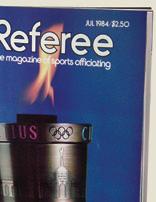
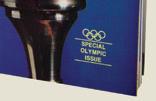
40 YEARS AGO … 1984
• Peter Buehning and Bernie Iwasczyszyn become the first American referees to officiate the team handball competition in the Olympics. Christer Ahl, chairman of the Rules and Referee Committee for the U.S. Team Handball Federation, admitted finding referees for the obscure sport was a “difficult task.”

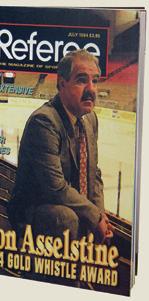
SOFTBALL
1 — All – d (NFHS 2-29; NCAA 11.16 Note 5; USA Softball 1-Infield Fly; USSSA 8-17H Eff.)
2 — All – c (NFHS 5-1-1a Note, 7-2g, 8-5-4, 5.1.1B; NCAA 11.3.3.6 Eff.,11.13.3.3; USA Softball 7-4H Eff., 7-6A-1; USSSA 7-5C, 8-4D Exc. 1)
3 — All – b (NFHS 5-1-1f-1, 5-1-1g-5, 5-1-1h, 5-1-2c; NCAA 9.6 Note; USA Softball R/S 33G; USSSA 8-16G)
4 — NFHS, NCAA, USSSA – a (NFHS 2-8-2; NCAA 11.7.2.1; USSSA 3-Bunt, Attempted); USA Softball – b (R/S 10)
VOLLEYBALL
1 — All – b (NFHS 9-5-6b; NCAA 12.1.2.4; USAV 19.3.1.4)
2 — All – d (NFHS 10-4-4a Pen. 1; NCAA 6.3.2.10, 12.2.1.2; USAV 19.3.2.9)
3 — All – a, b, c (NFHS 11-4-1; NCAA 11.3.5; USAV 17.1.1)

30 YEARS AGO … 1994
•Three NCAA men's basketball officials are sanctioned for not using video replay during an Arkansas-Georgetown second-round Division I tournament matchup. Tim Higgins, Tom Lopes and Dick Paparo did not work the rest of the tournament after a brawl broke out and they opted not to use video replay to gather fight-related information. NCAA coordinator of men’s basketball officials Hank Nichols said the officials “should have used replay.”
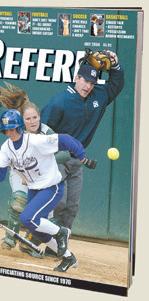
20 YEARS AGO … 2004
•MLB umpire Mark Hirschbeck retires due to a chronic hip issue. The 15-year veteran’s career was highlighted by postseason assignments including four Division Series, two Championship Series and two World Series (1998 and 2001). He also worked the 1993 and 2000 All-Star Games. Mark and his brother John were the first pair of brothers to umpire in MLB at the same time.
MISSION
Referee is a magazine written from an officiating perspective, blending editorial credibility and business viability. It educates, challenges and inspires officials at the youth, recreational, high school, collegiate and professional levels in all sports, with an emphasis on baseball, basketball, football, soccer, softball and volleyball. Referee is the journal of record for officiating and takes informed positions on selected issues. The magazine provides a forum for its readers, facilitates the flow of information, raises public consciousness about officials’ roles and serves as a catalyst for improved officiating worldwide.


10 YEARS AGO …
2014
•Former NFL official Gerald Hart, 83, dies of natural causes. Hart officiated in the NFL from 1968-77 and retired only because his job required international travel. He later returned to officiate in the USFL.
REFEREE July 2024 | 89
Light’s Out
My knees made me start thinking about retiring as a Pennsylvania Interscholastic Athletic Association (PIAA) soccer official. After 24 years and over 900 games, it seemed like the right time to step aside. I had walked away from officiating club soccer games a few years ago, and now it was time to 100% retire.
From the beginning, I approached my role as a soccer official differently than many of my colleagues. I had all the challenges and stress I needed in my professional career as a lobbyist, so I didn’t aspire to top-level game
gotten considerably more difficult to arrive at a school on time because of traffic, that has been frustrating but really just a personal annoyance. These factors did influence my decision:
Coaches don’t keep up with the annual rule changes, and they can’t keep track of the differences when they move from coaching a club team to a high school team. Officials must demonstrate a level of knowledge through testing and then maintain that knowledge to receive game assignments. Coaches just wing it on the rules/laws of the game.
A soccer czar at some level should declare a multiple-year pause in rule changes. We’re “professionals” (we are paid) but we are not full-time professionals. Officials work hard to assimilate the annual changes into their knowledge base. That’s not true of coaches, players or parents. The constant confusion about handling and offside violations are prime examples.
Too many assignments morph into games worked without a partner. I have the experience to handle those games but not the physical ability to competently cover a large high school field. I can “anticipate” but that is really not good enough.
be willing partners in a PR campaign to recruit officials. They need a pool of players and they need games for those players. An adequate number of officials in the community is a win for them. But as I sit in an MLS stadium for a game, there is not a sign, video or promotion about recruiting officials.
While my experience has been coaches and parents have somewhat improved their decorum and attitude toward officials (they know there is a crisis and they’re glad when we show up, although that often changes after the first whistle), I believe players have regressed. It is obvious nobody is explaining to them the fouls and dissenting behavior they see at the professional level are not acceptable at their level of play.
Failure to pass a state law establishing penalties for harassment of sports officials in all states.
Finally, and most importantly, I assume every game now is being recorded, either by parents with their smart phones or by the school. I realize the intent may not be to dissect the actions or decisions of the game officials, but I also know this presents a significant liability exposure. I’m not comfortable with that.
I think I met my intent of giving something back.
assignments. There were other factors — my fitness and work schedule among them — but I was satisfied to work junior varsity and middle school-level games. Being a longtime soccer fan and coach when our son and daughter started playing, I saw it as a way to give something back to the game.
I recognize I am leaving the game at a time when there is a serious shortage of officials. To a small degree, my decision will impact that situation. For me, a growing number of factors, in addition to the pain in my knees, were significant reasons for my retirement decision. And while it has
Schools still rightly expect the contracted official to fulfill a commitment to the game day and game time. But some schools take multiple weeks to pay the official’s fee. Even schools using online programs to make electronic deposits delay their payment. It needs to work both ways.
Despite the obvious crisis that exists in the declining number of officials across all sports at all levels, organizations that control sports and officiating at the national and state levels have not addressed the issue with comprehensive, viable and visible plans that are aggressive and resource-intensive to recruit and retain officials. One priority should be making resources available to local chapters of officials, to the people who interact with individuals in the community.
Professional sports teams should
My 24 years as a PIAA soccer official covered exactly a third of my life as I decided to retire. It defined how I chose to spend a great deal of my personal time. I don’t regret my decision to sit for the written examination and then find my way to the pitch. I met and remain good friends with so many individuals associated with the game.
My calculation is I made it possible for over 27,000 student-athletes (900 games x two teams x 15 players per team) to play the beautiful game. I will always be proud of that. I think I met my intent of giving something back. Larry Light, Harrisburg, Pa., was a 24-year soccer official for the PIAA. He recently retired as the senior vice president advocacy after a 34-year career with a statewide healthcare provider association.
Do you have a personal officiating story to tell?
Send your story or queries to lastcall@referee.com
A PERSONAL STORY BY XXX 90 | REFEREE July 2024 SHUTTERSTOCK A PERSONAL STORY BY LARRY LIGHT
LAST CALL
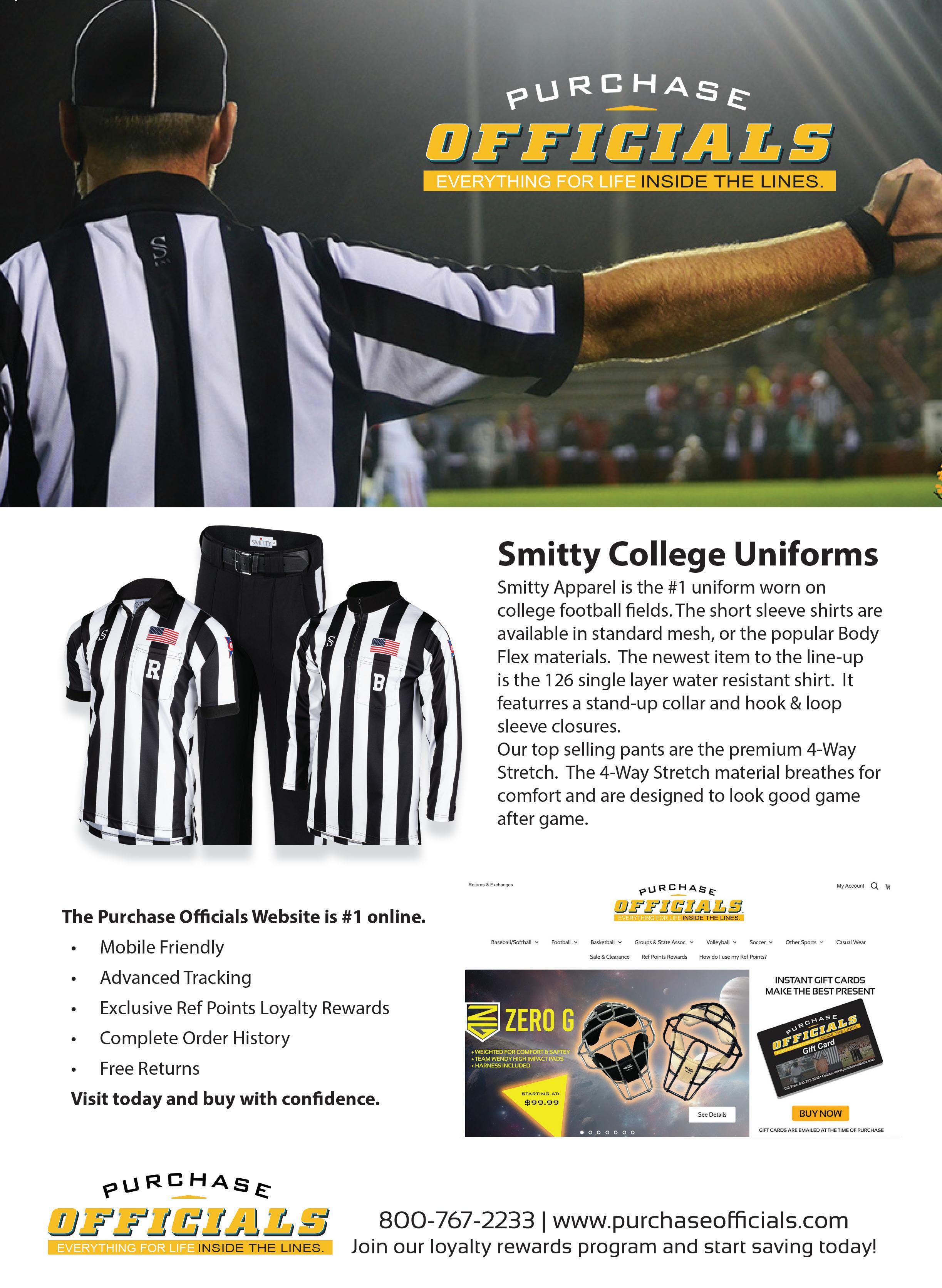













IT’S OFFICIAL






july 2024

NFL Down Judge Sarah Thomas to Receive 2024 Inspire Award
Sarah Thomas has been a pioneer, not only in the NFL, but for women across the officiating landscape and around the world.
In 2009, she became the first woman to officiate a major college football bowl game onfield and in 2015, Thomas became the first woman hired full-time to officiate onfield in the NFL. Following the 2018 season she became the NFL’s first onfield female official in playoff history. And on Feb. 7, 2021, Thomas became the first woman to officiate a Super Bowl.
Her impact on the officiating community and her position as a role model for so many female officials has led to her selection as the 2024 Inspire Award recipient, presented by the NASO board of directors. The award is presented to those, who by their actions, bring about inspiration, pride and a confirmation of the values cherished by the officiating community. Candidates confirm the values of the highest ethical standards, integrity, fairness and impartiality.
The award will be presented in Atlanta on Tuesday, July 30, during the Celebrate Officiating Gala, sponsored by Fox 40 International. The Gala caps

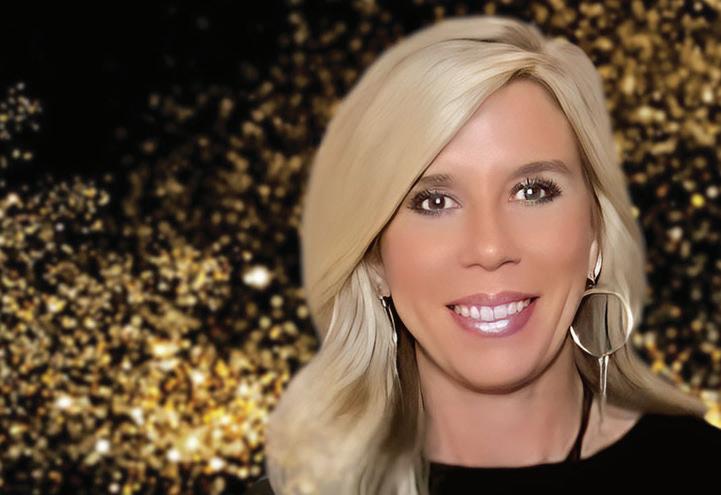

off the 2024 Sports Officiating Summit.
NASO President Bill Topp said, “Through her work and professionalism, Sarah Thomas has inspired countless officials to begin their journey. Among the most recognizable names in all officiating, Sarah has used her platform to open doors for others and support women and other underrepresented groups.”
Thomas was an Academic All-American college basketball player and began her football officiating career in 1996. She was hired onto the Conference USA football officiating staff in 2006 and, from there, continued
her rise to the NFL with her hiring in 2015.
“I am completely honored and humbled to be the recipient of this year’s Inspire Award,” Thomas said. “To even be considered, and now in the company of the previous incredible recipients, is a huge reason I will continue to inspire others. These previous recipients are inspiring me to continue their legacy in always being there for other sports officials across the globe. Thank you to NASO for all you do for all sports officials, and allowing me to receive this amazing award.”
NATIONAL ASSOCIATION OF SPORTS OFFICIALS
1












NASO Board Meets to Discuss Business
The NASO Board of Directors gathered April 30-May 1 in suburban Chicago for its annual business meeting and to discuss several additional items including logistics for this summer’s NASO Sports Officiating Summit in Atlanta.



Outgoing treasurer Bill Carollo, making his final report before being succeeded in the role by fellow board member Mark Uyl, painted a picture of financial health for NASO while discussing the group’s annual audit and membership numbers.
“We thank Bill for his 20-plus years as a board member and treasurer, for his business acumen and insights guiding our
Editor: Julie Sternberg
Sports Editor: Brent Killackey
Graphic Designer: Dustin Brown
Contributors: Don Collins, George Demetriou, Alan Goldberger, Joe Jarosz, Patrick Rosenow, Tim Sloan, Brad Star, Jeffrey Stern, Brad Tittrington, Scott Tittrington, Bill Topp
NASO BOARD OF DIRECTORS
Robert Smith, Waterloo, Iowa, Chair
Lisa Jones, Chandler, Ariz., Vice Chair
Bill Topp, Racine, Wis., President
Dana Pappas, Lebanon, Ind., Secretary
*Bill Carollo, Shorewood, Wis., Treasurer
*Ron Foxcroft, Hamilton, Ontario, Special Adviser
*Barry Mano, Racine, Wis., Special Adviser
Dean Blandino, Santa Monica, Calif.
Paul LaRosa, Hendersonville, N.C.
Pati Rolf, Pewaukee, Wis.
Sandra Serafini, Yachats, Ore.
Ron Torbert, Hanover, Md.
Mark Uyl, DeWitt, Mich.
Rob Wigod, Los Alamitos, Calif.
*Non-voting members
NASO MISSION STATEMENT
The mission of NASO is to:
• Serve members by providing benefits and services.
• Improve officiating performance through educational programs.
• Advocate opportunities for officials and engage in programs to recruit and retain officials.
• Create alliances with organizations that benefit from healthy officiating programs.
• Enhance the image of officials.
© 2024 NASO/Referee Enterprises, Inc. All rights reserved. It’s Official is published by the National Association of Sports Officials and Referee Enterprises, Inc.
Find NASO @ facebook.com/NASOofficiating
association,” said NASO President Bill Topp. “The association has come out of the (COVID-19) pandemic financially, has turned the corner and financially is in a much-better position than we were a few years ago. That is related to membership growth and managing expenses to the best of our ability.”
The list of additional discussion items included:
• Plans for the three major award recipients at this year’s Summit the Gold Whistle Award, the Mel Narol Medallion and the Inspire Award;
• An update on the developing program for Officiate Georgia Day that will take place July 27 in conjunction with the Summit;
• Looking ahead at future Summit dates and sites;
• The positive impacts of the 2023 National Officiating Survey powered by Referee.com;

• The robustness of NASO’s MICP program and how it is a hallmark of what NASO provides to its membership; and,
• The increase in legislative activity throughout the country in an effort to provide additional protection to sports officials, and the growth/increase of media inquiries regarding gameday decisions made by officials.

There was also discussion about the growth of NASO group memberships, which continue to be the most significant driver of NASO membership; new board member candidates; and a report on the latest meeting of the Officiating Development Alliance, which took place Feb. 19-20 in New York.
The next NASO board meeting will be held the morning of Sunday, July 28, prior to the opening of the 2024 Summit later that day in Atlanta.
MICP: Are You Stage Ready?
No matter what stage you are in or what role you have in officiating, you can benefit from NASO’s Member Information & Consultation Program (MICP).
Rookie on up. Whether you’re a new official or not, it’s only natural to have questions. If you need guidance on game management, crew dynamics or the business side of officiating, NASO can offer articles to help. Crew chief. Leading a crew is a big job. While you probably have experience to address many issues, there are likely some trouble situations you could benefit from talking to an expert about. NASO may have the
article you need or recommend a general information consultation. Association leader. Association leadership isn’t for the faint of heart. Issues arise regularly. NASO maintains an extensive legal library, covering model bylaws, codes of conduct, sample contracts and more to cover your needs.
Assigner. Assigning can get messy quickly when an official becomes disgruntled or makes a mistake that leads to a lawsuit. The NASO staff can help determine what information or consultation would be beneficial. Contact NASO with your MICP inquiry at 262-632-5448 or naso@naso.org.
2 IT’S OFFICIAL - july 2024 NATIONAL ASSOCIATION











BSports Officiating Summit to Feature Bob Delaney
uckle up. Bob Delaney, retired undercover New Jersey state trooper and retired NBA referee and vice president-director of officiating, who is the industry’s foremost leader in mental toughness, post-traumatic stress and perseverance, is scheduled to present at the 2024 Sports Officiating Summit.
Resiliency in Officiating is making its debut July 28-30 in Atlanta.
“I have been involved with officiating for decades and have served on the NASO board of directors, including as chair in 2019-20,” Delaney said. “NASO leads the way addressing issues for the officiating community and it is my honor to be presenting at the 2024 Summit in Atlanta.”
Among the topics to be included in his session is leadership, which far too often focuses on one’s efforts among a group without acknowledging the foundation of leading — one’s self. Delaney reminds us that self-care is not selfish. He has taken his message to law enforcement, firefighters, military, first responders and their families, as well as many groups in officiating. Now, he brings his important message to the officiating industry event of the year.
With a bachelor’s degree in criminology and a master’s degree in leadership, along with professional experiences in law enforcement and on the basketball court, Delaney is uniquely positioned to bring some of the most insightful advice to the sports officiating

community at a time that it is desperately needed. Delaney spent years of his professional career — beginning at age 23 — working for the New Jersey State Police and infiltrating the mob. The task force eventually gathered enough evidence to convict more than 30 Mafia criminals of the Genovese and Bruno crime families.





We came to fully appreciate how fitness levels impacted decision making and how call accuracy may be impacted due to physical exhaustion.”
Delaney then spent a quarter century officiating in the NBA and was assigned to the NBA Finals seven times. He transitioned from the court and worked in a supervisory role in
Similar strategizing, training and development can be implemented in the mental health arena for officials and Delaney will spell it out clearly for attendees in Atlanta. The session is positioned as the perfect mix of neuroscience, interpersonal development advice and leadership trends for officiating leaders and working officials themselves.
Resiliency in Officiating is making its debut July 28-30 in Atlanta.
the NBA office, and now works in a professional development and performance role for the SEC basketball officiating staffs.
“Twenty-first century officiating calls for a deeper understanding of personal emotional awareness, mind health, mental conditioning, mental rehearsal and how neuroscience impacts it all,” Delaney said. “I would add proper authority behavior as another officiating element that will benefit as well with the aforementioned. During the early years of my career, the officiating community had a focus on high-level physical fitness because we understood the need to be ‘in shape,’ not get in shape as the season began.
In addition to making countless appearances for various groups and writing dozens of scholarly articles on the topic, Delaney has co-authored Covert: My Years Infiltrating the Mob, Surviving the Shadows: A Journey of Hope into Post-Traumatic Stress, and Heroes are Human: Lessons in Resilience, Courage and Wisdom From the COVID Front Lines
“The past four decades I have been working in the areas of leadership, resilience, self-care and trauma awareness within the military, law enforcement, first responders and healthcare communities,” Delaney said. “I look forward to bringing those life skill conversations to the NASO Summit.”
3 OF SPORTS OFFICIALS












Sports Officials Legislative

Has your state passed laws related to assault and/or harassment of sports officials, officials’ liability and independent contractor status? State laws criminalizing attacks and harassment of officials serve as a deterrent and tell prosecutors, judges and juries that such acts are to be taken seriously. Limited liability laws are an added protection to exempt officials (sometimes only volunteer officials) from liability for injuries unless they are grossly negligent. Independent contractor laws classify officials as such — at least for the purposes of workers’ compensation.
While the scope of state legislation varies, sports officials should be able to perform their duties without threat of personal injury, administrative hearings or litigation because of game calls. State legislators can show support for officials by passing laws to protect them.
NASO has been bringing attention to assault/harassment, liability and independent contractor issues for years. The map, updated for 2024, displays the states that have passed laws dealing with those issues. There are currently 22 states that have officiating assault and/or harassment laws (including 20 with criminal laws and two with civil statutes), 17 with limited liability legislation and 15 states with independent contractor laws. In addition, three states — Idaho, Washington and Missouri — have supportive resolutions for officials.
Pass Legislation in Your State
Since 1984, when NASO first submitted model legislation regarding assaults against officials, legislators have used such models to construct their own legislative bills.
There is no fool-proof plan to get the job done. Each state handles legislation differently. Before you move forward, do some research. Request an NASO Assault Legislation Packet and visit naso.org.




Legislation Updates
Many states have pursued or are pursuing officiating legislation in 2024. Here are the highlights:
New Hampshire Bill Moves Forward — Senate Bill 327, which would create penalties for those who assault or harass sports officials in the state, passed the New Hampshire Senate in early March. On March 10, the House Judiciary Committee also unanimously voted 20-0 to recommend the bill ought to
pass. In addition, the committee approved an amendment that would add stalking and criminal mischief as criminal activities that would be punished under this bill. If passed, New Hampshire would become the 23rd state to have legislation protecting officials.
Iowa — SF 521 makes assaulting a sports official a Class D felony, just like assaulting a fire fighter, peace officer, jailer, health care provider, etc. The Iowa State Senate judiciary committee recommended Feb. 14 that the bill pass. HF 2078,
4 IT’S OFFICIAL - july 2024 NATIONAL ASSOCIATION











Legislative Scorecard




which also provides criminal penalties for assaulting a sports official, was recommended to pass Jan. 25 by the House judiciary subcommittee. No further action took place for either bill as of press time.
Kansas — HB 2808, which was introduced Feb. 19, as amended, creates the crime of causing harm to a sports official and provides criminal penalties. On March 21, the Committee on Federal and State Affairs recommended the passage of the bill.
Massachusetts — HB 1407, HB 1427, HB 1475 and HB 1753 were introduced and referred to the Joint Committee on the Judiciary Feb. 16, 2023. The bills call for enhanced penalties for assault and/ or harassment of sports officials. The reporting date for the bills was extended to April 30.
Minnesota — HF 3352 and companion bill SF 3919 were introduced Feb. 12 and 19 and referred to the Judiciary and Public Safety Committee. The bills call for a civil penalty imposed on those

who disrupt or interfere with youth athletic activity.

Missouri — HB 1441 and HB 1847 were first read in January. The bills expand the definition of special victim to include sports officials at a sporting event. As of press time, no hearings were scheduled for the bills.
New Jersey — S2993 and A4176 were introduced in March and April. The identical bills, which upgrade certain types of assault against sports officials to aggravated assault, were referred to the judiciary committees. No other action was taken.
New York — AB 2510 and SB 234 call for specific penalties for assault on sports officials and aggravated harassment of a sports official. Both bills were referred to c odes c ommittees in January.
Ohio — HB 139, which increases assault penalties if the victim is a sports official, was introduced March 28, 2023. It passed in the House Nov. 29, 2023 and is currently in the Senate Judiciary Committee. Bills in Ohio introduced the previous year can carry over to the next legislative session.
Pennsylvania — SB 842, known as Respect the Whistle Act, was passed in the Senate Oct. 25, 2023, and then referred to the House Judiciary Committee for consideration. It provides for the offense of harassment of a sports official. HB 297, a comparable bill, was also introduced last year and remains in the judiciary committee.
Washington — HB 2079 called for protecting officials through improving school safety by extending and increasing penalties for interference by, or intimidation by threat of, force or violence at schools and athletic activities. The bill passed the House but the Early Learning & K-12 Education Senate Committee refused to have a hearing on the bill.
Go to naso.org for the latest legislation information and to download a PDF of this year’s map.
5 OF SPORTS OFFICIALS






Officially Speaking






Jina Doyle, ASI Senior Vice President, Client Services, on Insurance for Assigners


Like it or not, sports officials operate in a world ripe for litigious behavior. The same holds true for the individuals who assign the games, and their responsibilities, from a legal standpoint, may not end once the first whistle is blown or the first pitch is thrown.
Jina Doyle, senior vice president of client services for American Specialty Insurance, discusses what types of insurance are provided by NASO for assigners and why it’s never a good idea to believe there is only one option that suits every assigner’s needs.
The examples and coverage summary provided herein are for illustrative purposes only. The terms and conditions outlined in the policy(s) take

precedence over this summary.

NASO: What type of insurance does NASO provide specifically for assigners?
DOYLE: The NASO insurance program provides protection to assigners for (1) third-party liability claims of bodily injury, property damage liability and personal and advertising injury, for example, a player is injured during a game and the assigner is named in a lawsuit because she assigned the official to the game in which the player was injured; (2) the NASO general liability policy has been amended to include a unique “errors and omissions” coverage for assigners, for example, a highly recruited player claims that he missed out on opportunities because of an alleged missed call by an official — this protection not only applies to NASO member officials, but also to the assigner in the event that the assigner is named in a lawsuit as a result of the alleged missed call resulting in the alleged missed opportunity; (3) the NASO general liability policy also includes coverage for an LLC that is designed solely for handling payments from assigning activities.
NASO: How are the insurance needs different for someone who assigns games just for their local officiating association compared to someone whose assigning duties are, in practicality, a large business?
DOYLE: This is a great question. Insurance is certainly not a one size fits all; each

situation requires a tailored approach. American Specialty is happy to work with you to help evaluate if the coverage for an LLC provided under the NASO general liability policy is sufficient or if additional insurance coverages are recommended for your assigning business.

NASO: When should an assigner consider getting their own business insurance to supplement the coverage offered by NASO?
DOYLE: Reviewing your individual business operations with a legal representative and/ or a licensed insurance agent is going to provide the best path forward for determining the need for any additional coverages.
NASO: Are there any other elements of assigner insurance that you would specifically like to address and which you feel is important for assigners to understand?
DOYLE: Laying the groundwork for success at the time of assignment can help reduce the likeliness of a claim against the assigner and the official(s). A few examples include ensuring that the official is qualified for the level of competition he or she is officiating, that the official is empowered to make decisions to ensure their own safety and also the safety of the players and what steps the official needs to take after a competition to ensure that an overview of the competition is available in the event of a future claim arising from the competition.
6 IT’S OFFICIAL - july 2024 NATIONAL ASSOCIATION
DO YOU ‘LIKE’ US? www.facebook.com/nasoofficiating
Jina Doyle










The Status Quo Doesn’t Cut It
By Tim Sloan
Officiating is a dynamic business. When we apply that notion to calling games, most of us will accept that sport has been continually evolving. More recently that change has been exponential and what’s expected of us changes every season. We have to embrace change and react accordingly — often quickly.


among members, since they are still responsible for their product. This means leaders are being compelled to select, promote and assign officials differently. The “defaults” to the most experienced officials that once existed are giving way to officials who best deal with change and protect the group from liability.





Back in the 20th century, officials associations were the local oasis from which schools and clubs recruited who they needed to play games. The association put effort into training and recruitment and the schools employed the product of that effort. If officials from one group weren’t adequate in the schools’ view, they could be attracted from a neighboring association, if there was one; otherwise they just had to make the most of it. In this dance of supply-and-demand, the associations trained and assigned officials with an objective of keeping their business and officials were attracted to the association affording them the most benefit: better fees, meatier assignments or more respect. A big factor in how well an association implemented any change to that relationship was how members responded. Today, change is more about the survival of the sport. Regulatory bodies are often the driver of change with the result that teams and officials are the implementer. Changes in procedures, protocols and rule application require changes in officiating behavior that associations must bring about
Here’s the rub: The members who are most important to lead when implementing change are often those who least understand they need leadership. There are still officials who say they’re not going to follow state or association policy in dealing with certain rulings. Their reasoning: 1) they know better and, 2) they don’t believe they’ll be called out for it. Association leaders must take steps to make sure members who don’t get it are kept away from opportunities to wish they had.
When a player breaks his or her neck, flakes from heat stroke or faceplants into a bench, the money required for their treatment will come from somewhere and the objective will be to assign blame.
ASSOCIATION ADVANTAGE
Running a local officials association is demanding. You volunteer your time and effort to make it the best you can. But there’s no reason you have to do it alone. NASO Association Advantage exists to help you face any challenge and elevate your association in the process. Whatever challenges you have — training, insurance, legal issues, meeting help, bylaws and organization, membership issues and more — WE HAVE A SOLUTION TO MEET YOUR NEEDS.
PLATINUM & PLATINUM SHIELD
Association Advantage Platinum is the premier resource for maximizing the performance of your group, providing leadership and administrative resources to help you elevate your organization with a focus on training,
Somewhere in that treasure hunt will be the official(s), with attention to their competence and/or the depth of finances. Either way, if they’re your members, it can come back to your group and its insurance policy. It will be too late to wish you’d acted more affirmatively with members who didn’t take required change seriously. Remind members of the legal ramifications of their work so you’re all protected from liability and members prevent negligence. Also, assure new and would-be members your group will support them among the litigious shoals we face.
If we’re committed to sport, we’ll do what it takes to make our officials part of the solution. Give officials clear expectations of how to behave. Reinforce and reward those who respond, correct them when they err and deal with them when they defy. It benefits everyone.
Tim Sloan, Davenport, Iowa, is a high school football, basketball and volleyball official, and a former college football and soccer official
assigning, legal issues and best practices specific to local officials association management.
TITANIUM & TITANIUM SHIELD
The Titanium solution is ideal for officials associations that want to maximize their organization’s performance while fully protecting both their organization and individual members.
DIAMOND
The most comprehensive solution for officials associations that want to fully protect both their organization and individual members, as well as provide full training and testing solutions with an emphasis on video. Association Advantage Diamond is the ultimate answer to every challenge your association faces.
To learn more, go to NASO.org/Advantage or call us at 262-632-5448
7 OF SPORTS OFFICIALS
FROM OUR DATABASE











West VIRGINIA official recruiting high school, college students


The nationwide officiating shortage likely can’t be solved by a single individual, but one official in the Ohio Valley has implemented a recruiting strategy that he hopes will spread elsewhere.
Basketball and volleyball official Doug Patterson has recently been using his lunch hours to visit high schools and colleges in his local Wheeling, W.Va., area and educate students on officiating. He hopes speaking to students in person as opposed to relying on online recruiting efforts will generate more interest in officiating.
“I go to the schools, I have a little sign made up, put it on a

little tripod stand, and sit at a table during lunch,” Patterson said. He started the initiative in January; as of mid-April, he had 36 students who had expressed interest.




there and do this,” Patterson said. He used high school football boards in West Virginia as an example.
Patterson has refereed basketball for 18 years and volleyball for nine. He works both sports at the high school and college levels in Ohio, Pennsylvania and West Virginia. Patterson is a graduate of Glenville State College (now Glenville State University) in West Virginia; he took an officiating class there, which he said put him on the path toward becoming a sports official.
He thinks officiating organizations need to put more of an emphasis on going out and recruiting in person.
“I think that every board, every local board, needs to designate somebody to go out
National Survey Says … Officials Remove Fans Who Cross the Line
Sixty-seven percent of respondents to NASO’s 2023 National Officiating Survey powered by Referee.com have removed a spectator for poor behavior. Working through a game administrator is the best way to take care of a fan who crosses the line. By not ignoring the problem, officials are doing their part to curb poor sportsmanship.
Conducted during the spring and summer of 2023, the National Officiating Survey was completed by more than 35,000 sports officials from all levels and all sports. The data is available for research, study and analysis to anyone interested in the sports officiating industry at naso.org/survey
“There’s 12 or 13 football boards in West Virginia,” he said. “If each one of those had one person go to the high schools they service and go there and hang out at lunch and just talk to kids — if you pick up one or two (officials), that’s going to be huge.”
Even if only one student from each high school follows through and becomes an official, it’s a way to slowly but surely add to the officiating pool.
“Don’t just rely on social media or putting out an ad on social media,” Patterson said. “Let (the kids) talk to someone who’s actually (officiated). The kids ask good questions, and just give them honest straightforward answers. We need to be out there doing this.”

8 IT’S OFFICIAL - july 2024 NATIONAL ASSOCIATION
Doug Patterson
















sports section Get Better Day by Day
By the Referee editors
Getting better at anything — officiating included — takes time. Sure there are things you can do to get better at officiating by tomorrow, but some things will take a week, a month or a year to see results.
But if you can stay dedicated to improvement, you will see good things over time. Apply the following ideas and you’ll get better — and that could lead to bigger and better assignments.
Get Better Tomorrow
► Knowledge is power! Take 20 minutes out of your day to better your officiating knowledge. Often an official will review a particular situation or rule only to have that very thing play out in their game the next day. Keep it fresh and fun by using a variety of educational and teaching materials.
► We all have an idea of how we look when we officiate. However, when we actually watch game video of ourselves working, it isn’t always as we thought. Bottom line, no tool is more useful than video in helping to improve your game. Sure, take a close look at your judgment calls, but also pay attention to the way you carry yourself on the field. We are in the perception business, and as
they say, perception is reality!
► Practice makes perfect, right? Not necessarily. If you are doing something over and over again, but it isn’t correct, you’re just wasting precious time. Whether you’re just starting out or trying out a brand-new signal or mechanic, take a few minutes and practice the right way in front of the mirror. See how you really look. Do your mechanics look strong? Use the mirror to help you project the image you

within the next week, notify the assigners that give you games of your availability dates beyond the day(s) the forecasted storm strikes. Even if there isn’t a storm brewing and you would like to fill an open date or two, email or text the assigner(s) with your availability. Assigners want to know your open dates, especially if you are a quality official. If other officials sustain injuries or become ill, you will likely be at the top of that
Bottom line, no tool is more useful than video in helping to improve your game.
want when it matters.
► Take a few minutes and test your rules knowledge. None of us want to misapply a key rule during crunch time. Staying current on rule changes, new mechanics and the latest officiating philosophies often make the difference between good and great officials. And the difference between the postseason and “waiting ’til next year.”
Get Better Next Week
► If you know ahead that there is a potential for games to be postponed due to weather
assigner’s list to step in, and he or she will appreciate it.
► If the season is near and there is a call-out for officials to work a scrimmage, do it, even if you’ve worked a couple of scrimmages already. It’s a great way to get into the mindset of that sport and sharpen your skills. That will make you better, and that’s the most important ingredient to prepare yourself for the big games on your upcoming schedule. Take a scrimmage opportunity as a chance to exhibit the three Rs: renew, refresh and rejuvenate. It’s a time to give whatever it
OF SPORTS OFFICIALS NATIONAL ASSOCIATION OF SPORTS OFFICIALS
9



may be — whistle, flag, card — and your mind some exercise.


► Be prepared to not only attend but to participate fully at meetings. Physical presence alone won’t help you improve skills or increase your schedule. Write down questions in advance to ask at the upcoming meeting. Did something unusual happen during a game? A play or ruling? Bring it up at the right time at a meeting. Is there a philosophical issue you’ve been wondering about? There are plenty of seasoned officials who will gladly share their advice.




officiating buddies in your sport is both fun and good for your mental health. Your friends are your network and they can help you advance with a good word to the right person.






► The most successful officials are usually those who truly believe there’s always something to learn and sometimes that comes by reviewing rules. Read one chapter of the rulebook within the next week, and chances are you will learn something that you did not know prior to the review.
► Find ways to get recent video of yourself officiating. Take full advantage of the video and don’t just view the footage for call validation. Compare your positioning in each game during the week. Determine the cause for why you got something wrong or what may have caused you to miss something happening. Note your presence and body language and figure out ways to improve.
► Attending local association meetings allows you to connect with other officials and experts. Try to either form a group of officials or become part of a group, so that you can make them your “go to” people regarding any questions about specific plays, rules, assignments and whatever it might be related to your sport. They, in turn, will likely come to you for help as well. Having a group of
► Watching officials is an often forgotten way for improvement. There are at least one or two things, if not more, you can pick up from every official you watch work. Find those things that other officials do well and incorporate them into your game. Talk about the situations that occur in the games you watch and think about ways you may handle them. How would you apply a play you see at a different level to the games and levels you work?
Get Better By Next Month
► It’s one thing to go to the gym and do 30-60 minutes of cardio and then head for the showers. You probably won’t see a difference short-term, but if you can get into a daily routine for several weeks, it will make all the difference. Incorporate weights, classes, a good diet and even sessions with a trainer, if affordable, and make it a regular part of your week, every week. You will be a healthier, slimmer official sooner than you think.
• It’s not uncommon for a group of officials to get together before the preseason test and review the questions and use a little “groupthink” to improve everyone’s score. What about during the season? Do you forget about getting together for rules or video review? Find willing participants and meet regularly.
► Whether you receive evaluations from your supervisors or write down the notes and feedback from partners during your postgame
reviews, you can take a collection of those and review them to improve. Look back and if there are trends, work with your mentors and co-officials and make those a point of emphasis in your games.

► If you’ve never been to a camp, you’ve missed a golden opportunity. Beyond learning the latest rules, mechanics, techniques and philosophies, camps provide an opportunity to network with other officials and industry influentials. If you’re one who complains that the only people who move up are those who “know somebody,” camps are a chance to “meet somebody.”

If you don’t have time to improve, make time. A few minutes here and long-term dedication there are possible, if that is what you want.
Ready, set, go make a difference in your game.
FOOTBALL
How Video Has Changed Officiating
By Jeffrey Stern
One of my favorite books is Instant Replay. The author, Jerry Kramer, was an All-Pro guard for the Green Bay Packers. In 1968, he kept a diary of what turned out to be a championship season. It was a breakthrough book for its time, full of behind the scenes information that let fans know what life as a pro football player was really like.
A recurring theme throughout the book involves the use of film to review players’ performance and as scouting material for upcoming opponents. In fact, Kramer’s observation that Dallas defensive lineman Jethro Pugh
10 NATIONAL ASSOCIATION
IT’S OFFICIAL - july 2024




could be moved off the line of scrimmage in a short-yardage situation was a key element in the Packers’ victory in the famed Ice Bowl game that propelled Green Bay to Super Bowl II.


But most of the anecdotes involving movies were centered on the players’ apprehension about whether a mistake would be visible when coaches examined the tape after the game. “How’s that going to look on film?” was a common question.
The modern official likely asks him or herself that same question during the course of a season. That’s because advances in technology have drastically altered the way we go about our jobs.
Although “Make it be there” is still a valid pregame admonition, it might be more correct to urge crewmates to “Make it so big it shows up on film.”
After the game, when Kramer saw his block on Pugh for the winning touchdown on television several times, his thought was, “Thank God for instant replay.” It propelled his already stellar reputation into the stratosphere (and no doubt boosted the sales of his book the next year).
By the same token, officials often feel a great sense of relief when a call they make is as obvious on the game film as it was on the court or field. I know I did.
One of the concerns pro supervisors and major college coordinators have regarding the use of instant replay as an officiating tool is officials sometimes adopt the attitude, “It doesn’t matter what I call because replay will straighten it out either way.” Another drawback to the explosion of





technology is what is known as “officiating to the video.” Contact or violations that would (or should) be called are being no-called because officials fear the video won’t support them. Whether or not that is a valid concern is debatable. It may vary from official to official, coordinator to coordinator and level to level.

What is not in dispute is the glut of video available to us. When once we had to beg a coach to send a copy of a game tape (including providing the tape or disc and a self-addressed stamped envelope), we are now able to view many of our games online. In some cases, the video is posted before we return home. Talk about instant gratification.
I have long been a fan of video as a review and training tool. I’ll admit my first look at the tape of my own game involved finding the fouls I called and any close or controversial plays in which I was involved, just to see if I was correct. Call it vanity if you wish; I prefer to think it of as self-evaluation. I went through it a second time in its entirety and looked for things I may have missed during the game. It’s rare that I didn’t look at a play multiple times to check my positioning and mechanics.
As a longtime educational chair for our local association, I used video as a major part of our meetings for many years. Feedback from members indicated the video was the members’ favorite part of the meetings and certainly the portion from which they felt they got the most benefit.
Video can also be used as a preparation tool. Find video of other games involving the teams you’re about to work to get a flavor of their strategies



















Atlanta will be the center of the officiating universe as nearly 500 of the brightest officiating administrators, supervisors, leaders and officials come together to share ideas, network and explore solutions to the critical issues facing the industry.
11 OF SPORTS OFFICIALS
sportsofficiatingsummit.com atlanta georgia
2024 REGISTer now!
07/28-07/30
TO LEARN MORE GO TO

IT’S OFFICIAL - july 2024




and tendencies. A little time on the front end can save you from being surprised on the back end. I have no idea what the next big thing in officiating will be. I doubt we have reached the zenith of technological or other advances. But I do know this: Video made me a betterinformed, better-educated and overall happier official.

Jeffrey Stern is Referee’s senior editor. He officiated high school and collegiate football.
SOFTBALL
Think Before You Act
By the Referee editors
With each batter and before every pitch, umpires must prepare for a list of responsibilities. Where do I go on a hit to the outfield? A hit to the infield? What if my partner chases a ball to the outfield? Who will I go to on a checked swing?
Those basic umpire responsibilities also include knowing the game situation. Umpires should know the basics, like the number of outs, count and score. But it is also good to be aware of strategies most likely to be used by the offense and defense. Is it a sacrifice bunt situation or a hit-and-run situation? What are the batter’s tendencies? How are the fielders positioned for each batter? Umpires should know the game situation as much as, if not better than, the players.
Pre-pitch planning will help you react to a play much quicker because you have mentally rehearsed that situation in advance. You will instinctively know your plan of action instead of thinking for a moment and then reacting. That kind of



exercise benefits all levels of umpires, but is especially helpful to newer umpires who generally have a tough time slowing the game down.



Be sure to review the following list of points to be focused, alert and ready for each play before it occurs.
1. Number of outs. There are different situations for the number of outs. Each field doesn’t always have a scoreboard, so it is important that you and your partner(s) stay on the same page. If there are two outs, all play after the third out is dead. With fewer than two outs, there could be a tag-up or infield fly situation that umpires don’t need to be concerned about with two outs.
2. The count. Depending on the count, baserunners are likely to take certain actions. With two strikes and two outs, they will take off upon the release of the pitch. Players or coaches will often ask a base umpire the count or number of outs. Knowing it improves credibility and creates a positive perception. If you don’t know the count, don’t hesitate to ask your partner. Also know with a full count and two outs, runners will be off on the pitch, which means most ground balls on the infield, the play will go to first.
3. Who’s on first? Know which baserunners you need to watch and where the next play will likely take place. Will it be a force play or tag play? Tag-up situation or not? If a runner is on third late in a close game, will the defense likely make a play on that runner instead of a force out at first? Is the infield playing back or playing in to cut off the run at the plate?
4. Batter’s objective. With a runner on first and fewer than two outs, the batter may attempt a sacrifice bunt to




advance the runner to second. A speedy slap hitter may try to do the same. There are certain situations where a steal may be more likely, especially with a fast runner on base and a good hitter at the plate. The offense may also try a hit-and-run in that kind of situation. And if you sense that runner will attempt to steal or leave as part of a hitand-run, it’s possible that the runner may be more likely to leave the base before the pitch is released.

5. The score. Is the score tied, lopsided or are both teams within a run or two of each other? The inning and score may determine if an offense will attempt to squeeze a runner from third across the plate or ask the batter to swing away. Is it 9-0 in a 10-run rule game that is in the fifth inning? The team that is trailing will often do everything possible to score a run to keep the game going.
6. Batter history. Is the batter a power hitter or contact hitter? Tracking batter tendencies will help you know what to expect. Is the batter a long-ball hitter or will the batter be lucky to hit it past the infielders?
7. Position of defenders. Take a peek at the infielders and outfielders with each batter. Where are they set up? Is the infield in, anticipating a bunt? Are the outfielders also positioned closer to the infield? Has the defense shifted in a certain direction?
8. How is the defense pitching to the batter? With two outs, a runner on second and a good hitter at the plate, the defense may try to “pitch around” that batter with pitches out of the strike zone. If they walk that batter, so be it. That sets up a force play situation at first, second and third for the next batter. Perhaps the batter
12 NATIONAL ASSOCIATION



often pulls the ball. If that’s the case, the defense may feed that batter with a steady diet of outside pitches.



Take a moment before each pitch to not only pre-pitch plan but also get a handle on the game situation to put yourself in the proper mind-set. You will be a step ahead mentally and likely be in a good position to make a call. This way, you can read and react as opposed to having to think too much. Those extra split seconds can make the difference between being in the right spot to make the right call or being out of position and having to guess.
VOLLEYBALL
A Winning Work Crew
By the Referee editors
During the high school and collegiate seasons, each match provides referees with a new, different and sometimes varied work crew (line judges and scorers). The goal in each match is to engage and utilize the work crew to provide the best coverage and get each call correct. Ultimately, it is the first referee’s responsibility to take control of the match and make a final decision on any ruling. But at the end of the day, it is best to have an engaged work crew that is trustworthy in order to make the match go smoothly and effectively. In order to do that, the first referee must identify the strengths and weaknesses of the work crew and work to make the crew one cohesive unit. Here are some ways to ensure the crew is ready once the first whistle blows. First, get the crew on the same page. Start by showing the work crew a little respect. Learn their names and call them




by their names. In prepping the team, talk with them, not at them. Don’t simply run through a predetermined set of instructions. Remember, that crew is there to help you and ultimately they want to get calls right. No one wants to embarrass themselves. Make them feel a part of the team and set expectations for them. It is rare at the high school level to get a certified person as a line judge or scorer, except later in the postseason tournament. The same is true at lower-level college matches. A simple tutorial is not enough to build camaraderie and set expectations. Take a few minutes, engage the crew, and show the crew you are excited to have them be involved, and start building trust.








The level of detail in the pregame meeting can be adjusted based on the crew members’ experience. Start out by asking them questions about their duties. Find out what they know. Then, gauge their experience, enthusiasm, knowledge, etc. Be prepared to provide a one- or two-sentence explanation when a clarification is needed or when the answer to a question isn’t quite right. It is better to spend a couple of extra minutes before the match making sure they understand the job responsibilities than to gloss over something and then have to try to fix it at a key moment during the match.
Treat the work crew as a member of the officiating crew throughout the match. During timeouts, assure the crew they are doing a good job. If something needs to be addressed during those timeouts, give a gentle reminder and keep the crew engaged. Remember to stay on point and avoid venturing into inane conversation or war







13 OF SPORTS OFFICIALS
• Pre-Built Presentations • Turnkey Marketing & Social Media Kits • How-To Guides • Free Downloads morefindofficials • Mentoring Plans • Inspirational Presentations & Video • Case Studies of What Works keep the officials you have SAYYESTOOFFICIATING.COM GET ALL THESE FREE RESOURCES AND MORE @ The free resource for recruitment & retention



stories. They will not help those crew members during this particular match and may dissuade them from getting further involved in officiating.



Once play has started, make sure you adhere to proper mechanics. Whistle and gather information from the line judges and then center on the second referee. Award the point and show the fault signal. While awarding the point, make eye contact with the line judges and the scoring crew. Obvious calls don’t require you to make eye contact with the line judges prior to beginning the signal sequence. Instead, make eye contact as you award the point. Perhaps add a slight head nod acknowledging their call or their work. During a timeout, you might offer some kudos without being too overt — maybe a quick thumbs-up.
If you have to make a ruling that goes against what a line judge indicates, remind the line judge after the set that it isn’t personal, but you saw the play differently from a different angle. Try not to do this during a timeout as that will bring added attention and could embarrass the line judge. And try to end that conversation on a positive note, perhaps by recalling a great call that line judge made earlier in the set.
After the match is the time to praise the crew, especially if it performed well during a challenging situation. Let them know you appreciate their work and service. Offer some constructive feedback and keep it positive. Extend a handshake and thank them. Those are just a few tips to help you get more out of your work crew. If the crew feels involved and appreciated, it will reward you with better attention and work.



ASK US




BASKETBALL
Fouls by Opponents During Dead Ball

Play: B2 commits a nonshooting foul against A1, and B2 ends up on the floor. Following the whistle for B2’s foul, A1 is standing over the top of B2, stares down at B2 and doesn’t move from over the top of the player. The nearest official blows a whistle and assesses a technical foul to A1 for taunting B2. Shortly after the whistle, B2 takes offense and shoves A1. The official blows the whistle and assesses a foul to B2 for that dead-ball contact. Team A is not in the bonus. What is the result? Ruling: B2’s original foul during the live ball is a common (NCAAW: personal) foul. After the official blows the whistle for that foul, the ball becomes dead. A1’s action of standing over and staring at B2 while not moving results in a player (NFHS), Class A (NCAAM) or player/substitute (NCAAW) technical foul. B2 shoving A1 during the dead ball results in a player (NFHS) or dead-ball (NCAAM) technical foul, or intentional foul (NCAAW) on B2. In NFHS, while A1’s and B2’s technical fouls occurred during the same dead-ball period and were committed against each other, this is a false double foul. All of the free throws must be shot in the order in which the fouls were committed. Play is resumed with a division-line throw-in opposite the table for team A. In NCAA, since A1’s and B2’s fouls occurred during the same dead-ball period, and the fouls are of equal gravity (NCAAW), the fouls offset and

no free throws result. Play is resumed with a throw-in to team A as a result of B2’s original personal foul (NCAAW), and as a result of the dead-ball technical foul in NCAAM (NFHS 4-19-8b, 4-36, 6-7-5, 10-4-6c, 10-4-7, 10-7; NCAAM 6-5.1.d, 7-4.10, 10-1, 10-1 Pen. h, 10-3.1.b, 10-3.1.e; NCAAW 6-5.1.d, 7-4.10, 10-10, 10-12.4.a.2, 10-13.1.e).


BASEBALL
No White Flag
Play: With R2 on second base, B2 bunts to F3, who fields the ball a few steps in fair ground in front of first base. B2 stops his advance and retreats toward home. B2 does not leave the base path nor does he touch or go beyond home plate. F3 throws to third base, but R2 is safe. The return throw to first is after B2 has touched first base. Ruling: B2 is safe. His retreat is legal as long as he does not pass home plate (NFHS 8-1-1, 8.1.1A; NCAA 8-5n; pro 5.09b10).
Wall Interferes
Play: B1 hits a fly ball deep into the left-center field gap. F8 secures the ball in his glove and takes two steps before crashing into the wall causing F8 to drop the ball. Ruling: No catch; a catch cannot be made until the continuing action is complete. The wall caused an involuntary release of the ball (NFHS 2-9-1; NCAA 2-16; pro Catch Definition).
Bloody Knee
Play: After B1 slides into second on a double, the umpire notices a small amount of blood on his pants at his knee. Ruling: In NFHS, the pants must be cleaned or changed before he participates again. In NCAA, his team is given 10 minutes to have the wound treated and
14 NATIONAL ASSOCIATION IT’S OFFICIAL - july 2024





the pants cleaned. In pro, he may continue to participate and the injury attended to between innings (NFHS 3-1-6; NCAA 3-9, pro MiLB 9.17).
FOOTBALL

Team K Touches Kick
Play: K1’s free kick is touched by K2 at team R’s 48 yardline. R3 recovers, backtracks and is downed at team R’s 40 yardline. Ruling: Team R has no options. K2’s touching is not first touching because it occurred more than 10 yards from team K’s free-kick line (NFHS) or restraining line (NCAA). Team R will start a new series from its own 40 yardline (NFHS 6-1-5; NCAA 6-1-3a, AR 2-11-5 I).
Pass Follows Fumble
Play: Second and four from team A’s 24 yardline. A1 carries to team A’s 26 yardline, where he fumbles. The ball bounces back to team A’s 23 yardline, where A2 recovers and passes to eligible A3 at team A’s 40 yardline. Ruling: In NFHS, that’s a legal play. Even though the ball was at one time beyond the neutral zone, A2’s pass was from behind the neutral zone. In NCAA, that is an illegal pass. A forward pass may not be thrown after a runner’s entire body and the ball have been beyond the neutral zone. The penalty is five yards from the spot of the pass and a loss of down. That yields third and 10 from team A’s 18 yardline (NFHS 7-5-1; NCAA 7-3-2e Pen.)
SOFTBALL
Extra-Inning Substitute
Play: In a game using the Tiebreaker Rule, the score is tied, 2-2, after regulation. The visiting team places Adams on second base to start the eighth inning.





After the first pitch, the home coach tells the plate umpire that Jones should be the runner on second base. Adams is an eligible substitute, but the visiting coach never reported her into the game. Ruling: In NFHS, play stands and the umpire shall issue a team warning to the visiting team head coach and the next offender on that team and the head coach shall be restricted to the dugout/bench for the remainder of the game for a second violation (2-57-2, 3-3-4, 3-6-7 Pen., 4-2-6). In NCAA, “no pitch” is declared, the unreported substitute (Adams) shall be called out and declared officially in the game (6.16, 8.3.3.4.1 Eff.). In USA Softball, there is no penalty and the runner is officially in the game (4-6C-6 Eff., 5-11). In USSSA, a team warning shall be issued to the visiting team and play stands. A second offense will result in the head coach being ejected from the game (4-5, 5-5 Pen.).
Wild Pitch





for another full revolution in an effort to fool the batter. The batter swings and misses the pitch. Ruling: In all codes, this is an illegal pitch. The pitcher may not continue her motion once the ball is released. Dead ball is called after the playing action is over, a ball is awarded to the batter and the count will be 2-2 (NFHS 6-1-4e Pen.; NCAA 10.6.5 Eff.; USA Softball 6A-3M Eff.; USSSA 6-1G-5 Eff.).
SOCCER
Fair Challenge

Play: R2 is on second base and attempts to steal third. The pitched ball hits the plate and bounces up over the backstop and goes out of play. The plate umpire awards R2 home. Ruling: Incorrect in all codes. The ball is dead when it goes out of play and R2 is awarded third base only. Runners are only awarded one base from the base legally occupied at the time of the pitch on a pitched ball that goes out of play (NFHS 8-4-3c Pen.; NCAA 12.12.7.2 Eff.; USA Softball 8-5C Eff.; USSSA 8-14D-1).
Legal Delivery?
Play: B1 is up to bat with a 1-2 count. F1 throws a changeup on the next pitch. F1, in delivering the pitch, released the ball on her first pass through the hip. After releasing the ball, she continues her motion
Play: A1 has the ball and is being challenged by B2. A1 is in a running position and has the right foot on the ground and the left foot in the air. At that moment, B2 nudges A1’s left shoulder which causes A1 to lose balance and control of the ball. B2 takes possession of the ball. Ruling: This is a legal play since it is a fair charge. B2 merely nudged A1 and the ball was within playing distance (NFHS 12-5-1; NCAA 12.1.10.1; IFAB 12.1).
Quick Kick
Play: A1 is attacking approximately 35 yards from the goal. B2 non-violently trips A1 and the referee stops play for the foul. A1 recognizes an advantage for a quick free kick and immediately puts the ball back into play. B2 is retreating from the foul and is about 4 yards from the kick. The ball strikes B2 and changes direction. Ruling: Play continues. B2 did not have an opportunity to retreat 10 yards prior to the quick kick (NFHS 13-3-1B; NCAA 13.2.1; IFAB 13.2).
In the Way
Play: A1 takes a shot on goal which the goalkeeper deflects. The ball’s spin causes it to head back toward the goal. B2 is on the goalline to prevent the ball
15 OF SPORTS OFFICIALS

IT’S OFFICIAL - july 2024




from entering the goal. A3 backs into B2 into the goal and now the ball has a clear opportunity of crossing the goalline for a goal. Ruling: A3 is impeding/ obstructing B2. The referee awards an indirect free kick to team B taken from anywhere inside the goal area (NFHS 12-61; NCAA 12.2.13; IFAB 12.2).

VOLLEYBALL
Substitution?
Play: As the second referee checks the lineup prior to the start of the first set, it is discovered team A has listed No. 1 to be in the right-front position, but No. 2 is currently on the court in that position. The second referee informs team A’s coach of the error. Team A’s coach explains it was a mistake as it should be No. 2, that no player on the team





wears No. 1. The second referee allows the coach to make a change without charging a substitution or any other penalty. Ruling: Incorrect procedure in NFHS and NCAA. The team must make a substitution to replace the incorrectly listed player. No. 2 is allowed to replace No. 1 to make the lineup legal, however team A is charged a substitution. No other penalty is assessed (NFHS 7-1-4a-1; NCAA 10.1.1.9). In USAV, correct procedure (7.3.5.1).
Libero Not Listed





that set but may designate a libero for remaining sets (7-1-2b). In NCAA and USAV, a coach may, without delay, indicate who the libero is prior to the set beginning and it will be corrected on the lineup sheet, without penalty (NCAA 10.1.1.3; USAV 19.1). In (b), in NFHS and USAV, the team may correct the error prior to the set beginning without penalty (NFHS 7-1-4a-2, 7.1.4C; USAV 7.3.5.1). In NCAA, the team must play that set without a libero (10.1.1.7).

Warmups During Timeouts
Play: Team A turns in the lineup sheet for the first set. While checking the lineup prior to the start of the set, the second referee notices the coach (a) forgot to list a libero or (b) listed a number not on the roster. Ruling: In (a), in NFHS, the team must play without a libero for
Play: During a timeout, team A’s substitutes warm up with practice balls in the area of their court beyond the endline. Ruling: Illegal in NFHS and USAV; players may not use volleyballs during timeouts (NFHS 11-2-4, 11.2.4; USAV 4.2.3.2). In NCAA, this is legal (9.2.3.3).
The National Association of Sports Officials (NASO) is a nonprofit, educational association providing services and benefits for sports officials. It is run by officials, for officials. If you know a good candidate for membership, please send us his or her name and address. We will forward an invitation to join. For more information contact 262-632-5448 or www.naso.org/membership
Your Company Can Help Improve the Quality of Officiating
NASO EDUCATION PARTNER PROGRAM MEMBERS:
Alabama High School Athletic Association
American Specialty Insurance
ArbiterSports
Atlantic Coast Conference
Arizona Interscholastic Association
Big East Conference
Big Sky Conference
Big Ten Conference
California Basketball Officials Association
California Interscholastic Federation
CIF-Southern Section
Canadian Football League
Chief Zebra Enterprises
Cliff Keen
College Football Officiating, LLC
Collegiate Officiating Consortium
Court Club Elite
D-II — Collegiate Commissioners Association
DVSport Software Inc.
Eagle Tax Res
Fox 40 International
Fox40Shop.com
Gamekeepers
Georgia Athletic Officials Association
Georgia High School Association
Honig’s
Hudl
Illinois High School Association
Indiana High School Athletic Association
IAABO
Iowa High School Athletic Association
Kansas State High School Activities Association
Kentucky High School Athletic Association
Louisiana High School Athletic Association
Louisiana High School Officials Association
Major League Baseball
MIBT Media
Michigan High School Athletic Association
Mid-American Conference
Minnesota State High School League
Missouri State High School Activities Association
Missouri Valley Football Conference
National Association of Intercollegiate Athletics
NASO
NFHS
NBA
NCAA
NFL Officiating Department
NFL Referee Association
NHL
NHL Officials Association
Neat Tucks
New Mexico Activities Association
NY State Public High School Athletic Association
Officiating Collective
Ohio High School Athletic Association
Oklahoma Secondary School Activities
Association
Oregon Athletic Officials Association
Oregon School Activities Association
Precision Time Systems
Professional Association of Volleyball Officials
Professional Referees Organization
Purchase Officials Supplies
QwikRef Inc.
Referee Magazine
RefReps
Refr Sports
Reveal Media
RF Audio
South Dakota High School Activities Association
Southeastern Conference
Sports Officials Care
Summit Wellbeing Anonymous Team
Sun Belt Conference
Texas Association of Sports Officials
Texas High School Basketball Officials Association
Ultimate Fighting Championship
Umps Care Charities
Ump-Attire.com
United States Polo Association
United States Tennis Association
University Interscholastic League
USA Cheer/STUNT the Sport
USA Hockey
USA Pickleball
USA Softball
USA Volleyball
US Youth Soccer
VantageSportz
Vokkero/VOGO
Washington Interscholastic Activities Association
Washington Officials Association
West Coast Conference
Wisconsin Interscholastic Athletic Association
Yapalong
16
Become an NASO
Today!
Education Partner

























































































































































 BY scott tittrington
BY scott tittrington








































 By Dan Ronan
By Dan Ronan

































































































































































 By Tim Sloan
By Tim Sloan




































































































 By the Referee editors
By the Referee editors



































































































